Early Views of Glendale
| Historical Photos of Early Glendale |
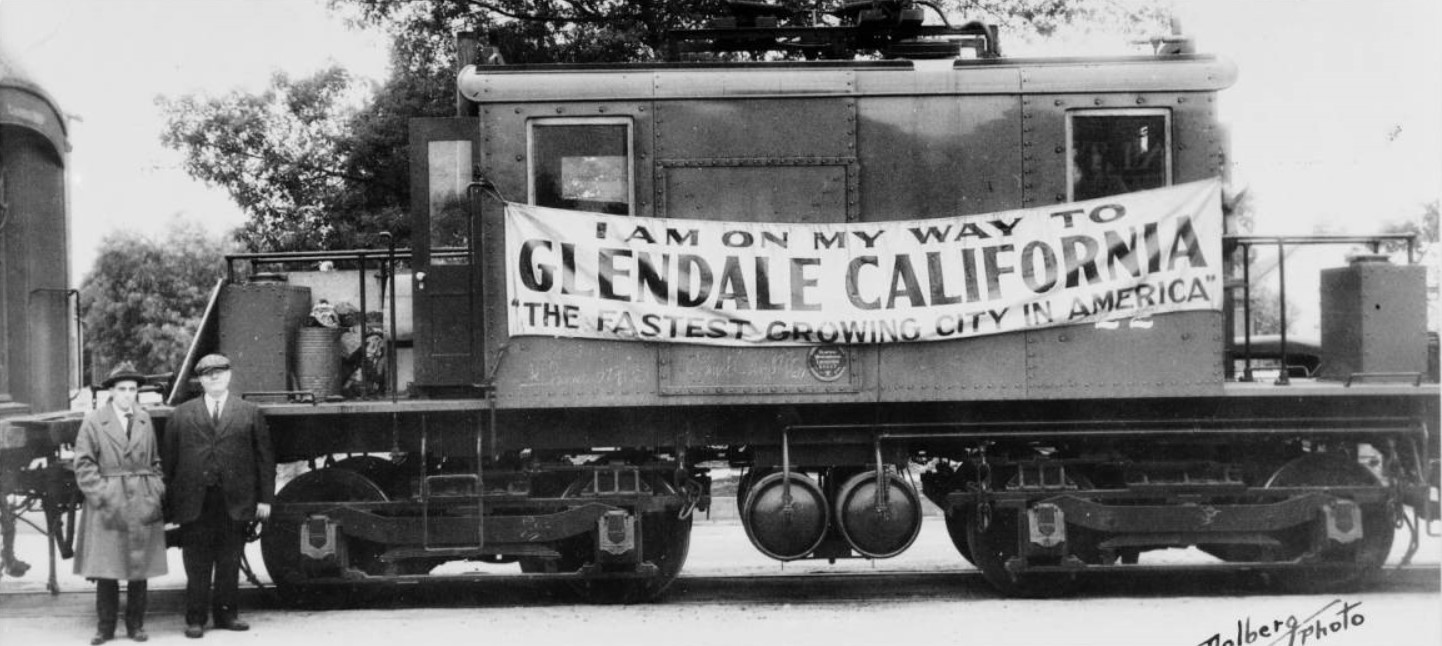 |
|
| (1920s)^^ - View showing two men standing in front of an electric locomotive bearing a sign promoting the city of Glendale. The rail car is parked on the tracks, and bears a banner that reads “I am on my way to Glendale, California. The Fastest Growing City in America”. |
Historical Notes By 1920, Glendale had grown through nine annexations to over 7,000 acres. From 1920 to 1930, ten annexations brought the total area to 12,294 acres. The population would keep growing. It rose from 13,756 in 1920 to 62,736 in 1930. |
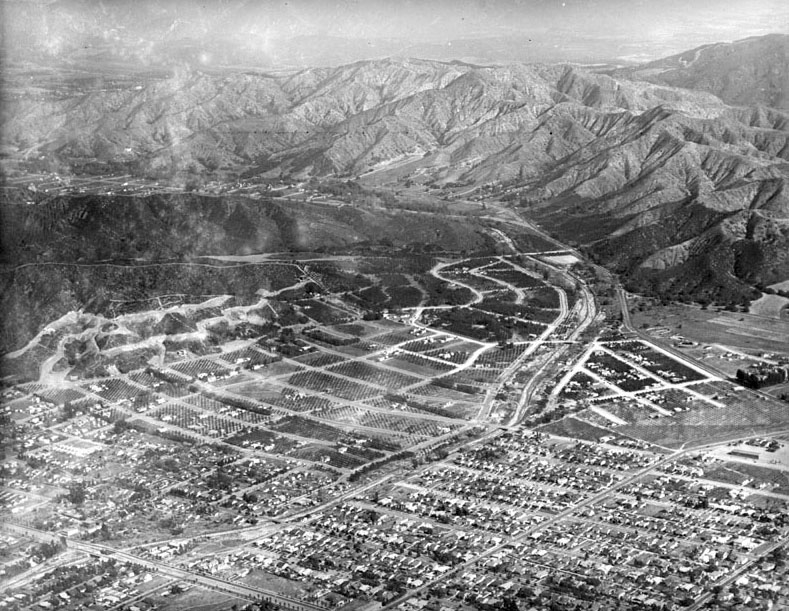 |
|
| (1920s)^ - Aerial view of Glendale at the foot of the Verdugo Mountains with Verdugo Canyon and the San Rafael Hills on the right. Housing development is encroaching on the citrus groves to the north. |
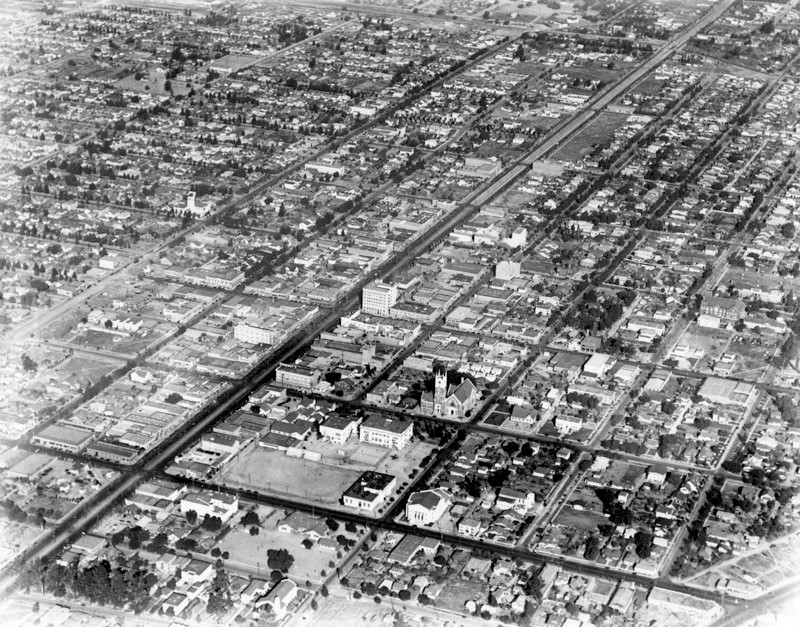 |
|
| (ca. 1927)^ - Aerial view of Glendale looking northwest toward the Verdugo Mountains. The intersection of Brand Boulevard and Broadway is in the center. The spires of the Glendale Presbyterian Church are visible to the right of Brand. |
.jpg) |
|
| (ca. 1927)^ - Aerial shot over Brand Boulevard looking north toward the Verdugo Mountains. The two tallest buildings in view are the Security-First National Bank (NE corner of Brand and Broadway) and Glendale Presbyterian Church at center-right (NW corner of Louise and Harvard streets). |
Brand Boulevard (1920 +)
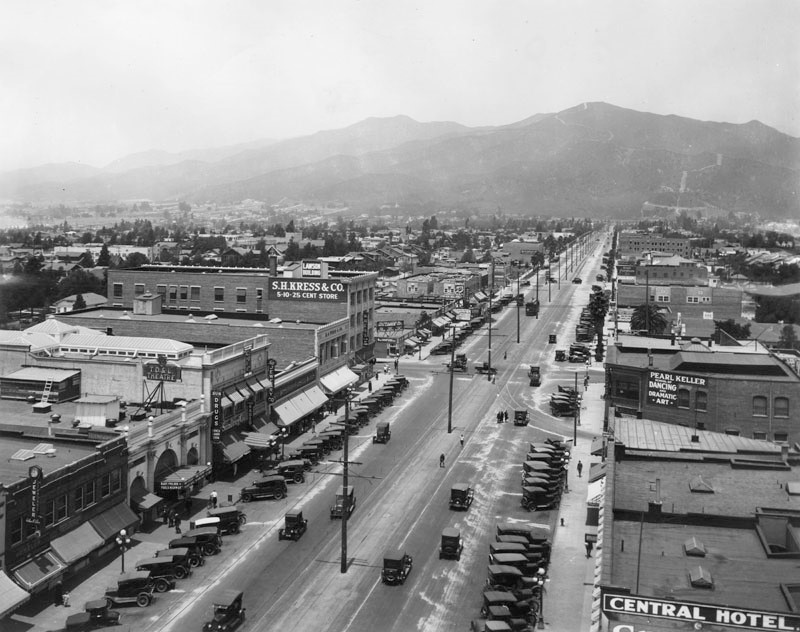 |
|
| (1925)^ - View looking north on Glendale's Brand Boulevard, when power poles were still located in the middle of the street. An electric car is seen descending the street. Palm trees line the boulevard in the upper portion of the photo. |
Historical Notes During the 'teens and 'twenties Brand Boulevard grew into a lively, modern, commercial and entertainment street with banks, department stores, movie theaters and automobile showrooms, becoming the city's "Main Street". |
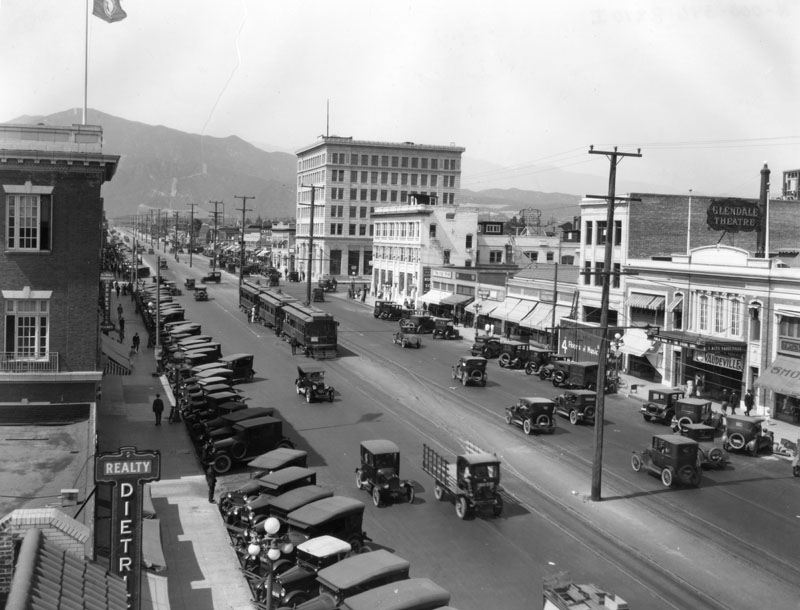 |
|
| (1926)* - View shows several automobiles travelling up and down the business section of Brand Boulevard, in Glendale. Note train stopped in the middle of the road to pick up and drop of passengers. The 6-story building in the distance is on the northeast corner of Brand and Broadway. It was constructed by Security Trust and Savings Bank in 1923. Glendale Theater can be seen on the right. |
Historical Notes Security Trust & Savings Bank was founded in 1888 by J.F. Sartori and associates; the bank grew through the development of business and mergers and became Security-First National Bank of Los Angeles (ca. 1931).^ |
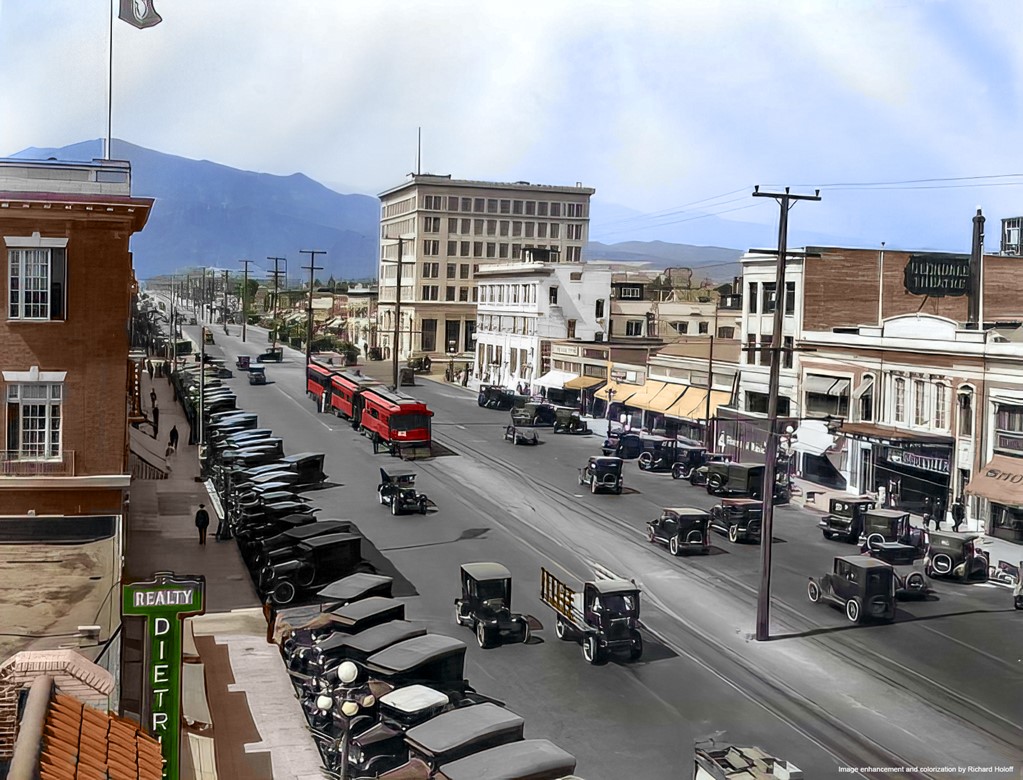 |
|
| (1926)* - View shows several automobiles travelling up and down the business section of Brand Boulevard, in Glendale. Note train stopped in the middle of the road to pick up and drop of passengers. The 6-story building in the distance is on the northeast corner of Brand and Broadway. It was constructed by Security Trust and Savings Bank in 1923. Glendale Theater can be seen on the right. Image enhancement and colorization by Richard Holoff |
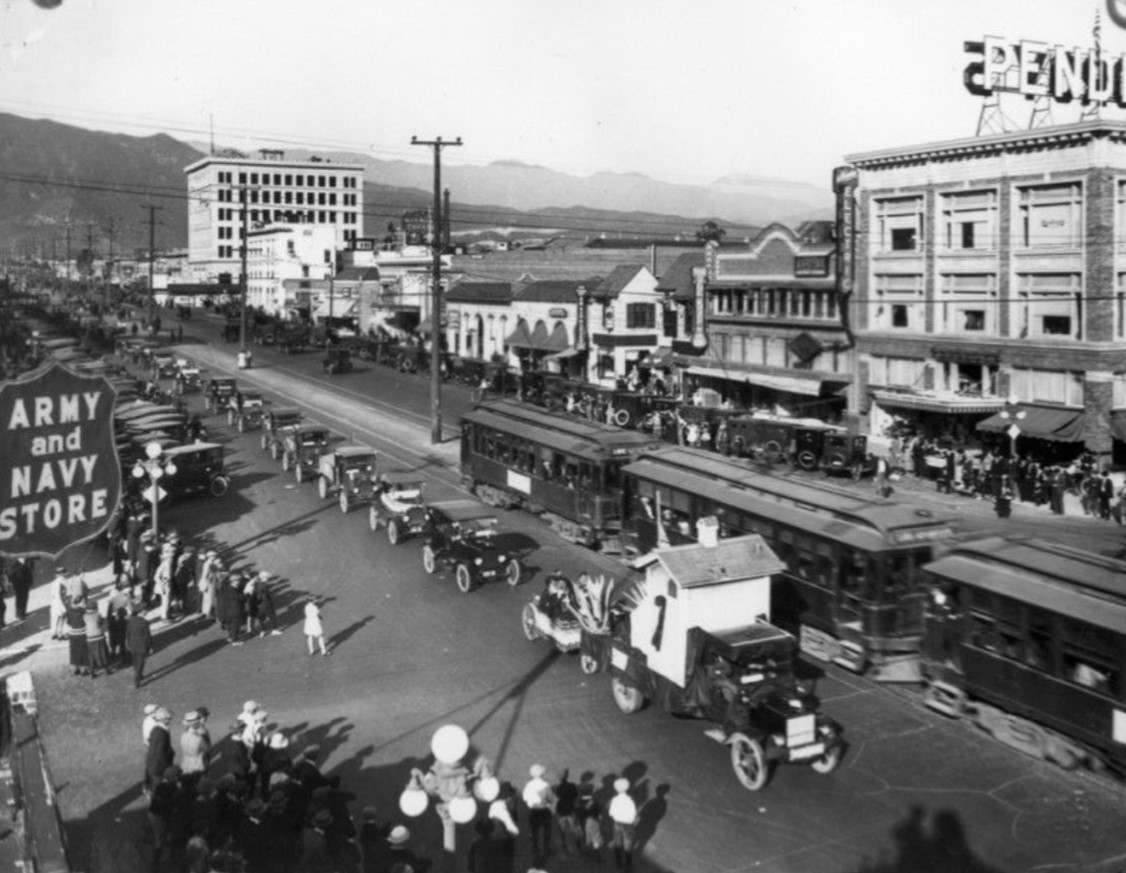 |
|
| (1923)* - Spectators gather on both sides of Brand Boulevard to watch the long line of automobiles participating in the Industrial Parade. |
Historical Notes The Industrial Parade in Glendale in the 1920s was part of the city's vibrant growth and development during that period. Glendale experienced significant expansion through annexations, growing from over 7,000 acres in 1920 to 12,294 acres by 1930. The population also saw a substantial increase from 13,756 in 1920 to 62,736 in 1930. This growth was marked by the city's transformation into a lively commercial and entertainment hub with modern amenities like banks, department stores, movie theaters, and automobile showrooms along Brand Boulevard. |
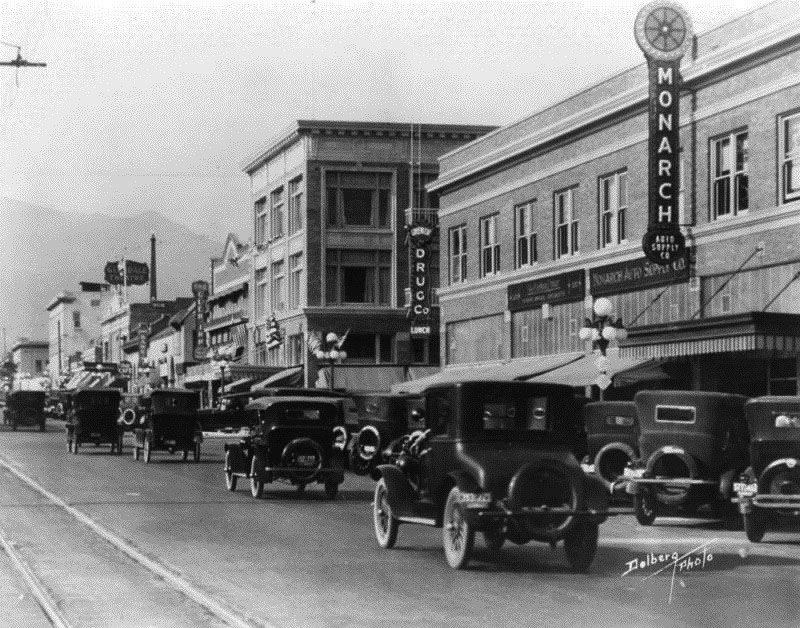 |
|
| (ca. 1924)^.^ – Street view looking north on Brand Boulevard. Monarch Auto Supply Co. and a drug store occupy the building on SE corner of S. Brand Blvd and E. Harvard St. seen on the right. The Glendale Theater can be seen in the distance. |
Historical Notes Today, the building on the SE corner of Brand and Harvard is occupied by a BevMo! Click HERE for contemporary view. |
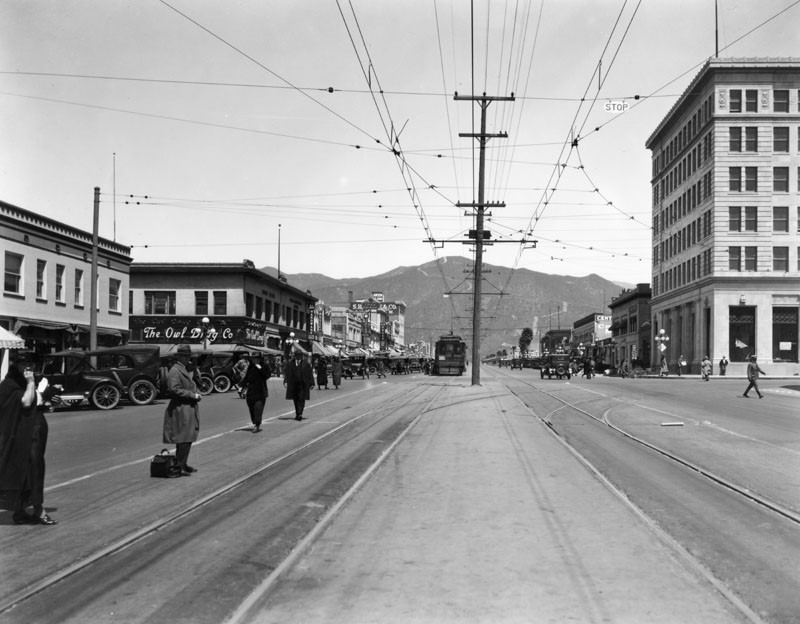 |
|
| (1924)^ - View from the middle of Brand Blvd. looking north. Pedestrians waiting just left of the train tracks for the Pacific Electric street car #566 to Los Angeles which is stopped at Broadway. Some of the businesses that can be seen include: "The Owl Drug Co.", "D.L. Gregg Hardware", "Glendale Music" and "Sun Drugs". |
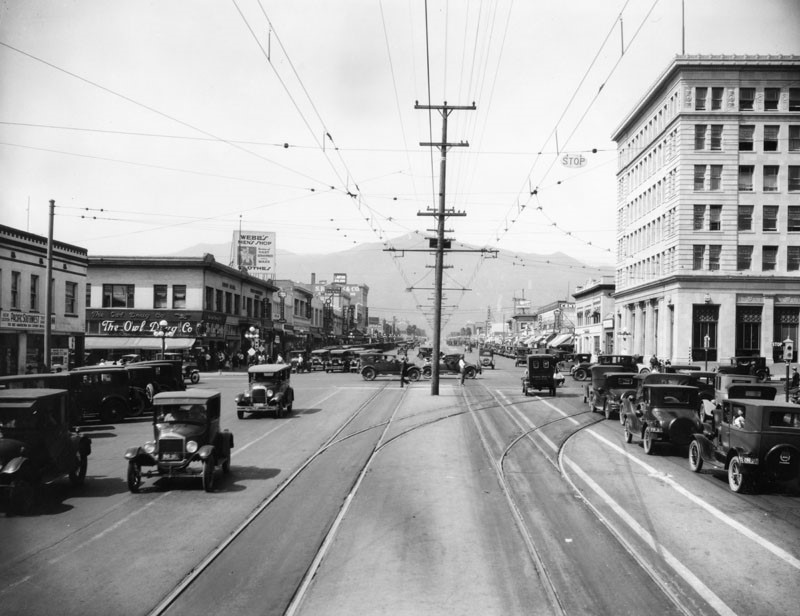 |
|
| (ca. 1924)^ - View looking north down the center of Brand Boulevard. The electric streetcar tracks are running north to south with a pair of tracks going off to the right toward Broadway. There are several businesses and stores that run along both sides of the street including "The Owl Drug Co." (N/W corner of Brand and Broadway). On the right in the distance, the Alexander Theatre with its original facade is visible. |
Historical Notes With population growing from 13,756 in 1920 to 62,736 in 1930, Glendale called itself "The Fastest Growing City in America". |
 |
|
| (1924)^ - View of the NE corner of Brand and Broadway in Glendale where the 1923-built Security Trust and Savings Bank stands. Note there are no street traffic lights as pedestrians and automobiles cross the streets. Many businesses may be seen on both sides of the street including railroad tracks which run down the middle of this wide street. |
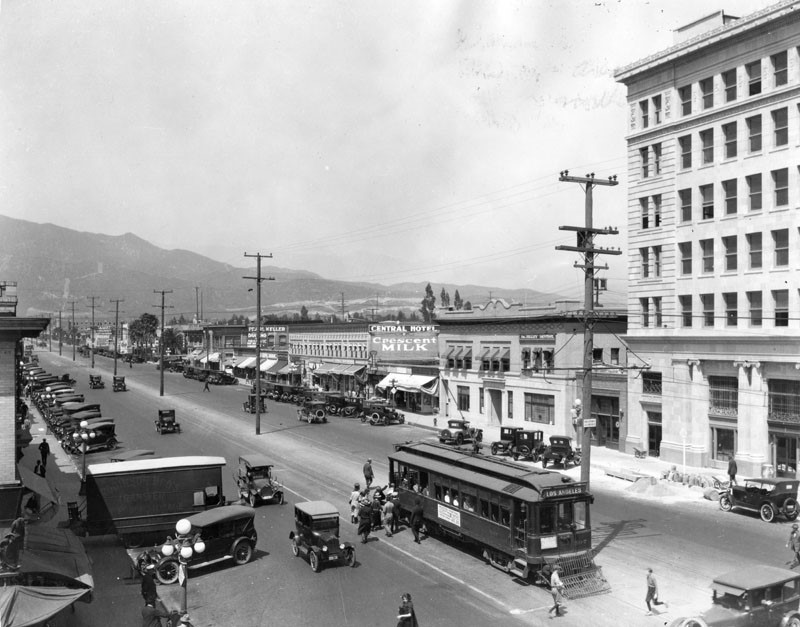 |
|
| (1924)^ - View looking north on Brand Boulevard from Broadway showing passengers boarding a Pacific Electric streetcar heading toward downtown Los Angeles. |
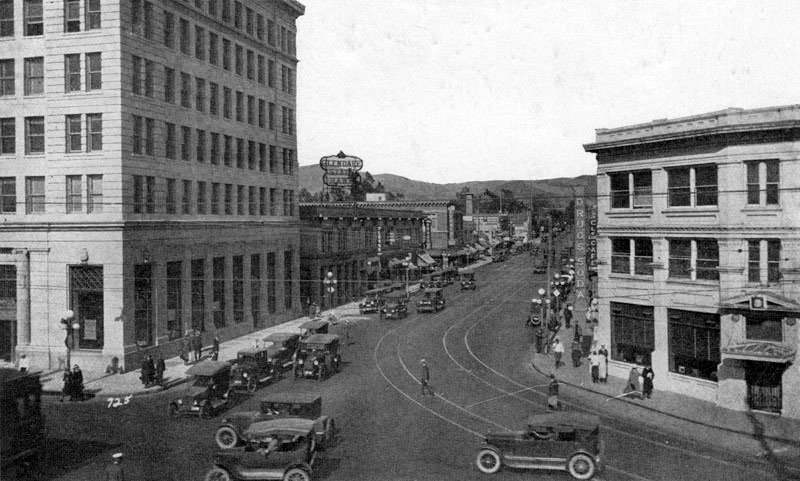 |
|
| (ca. 1924)^ – Postcard view looking east on Broadway at Brand Boulevard. |
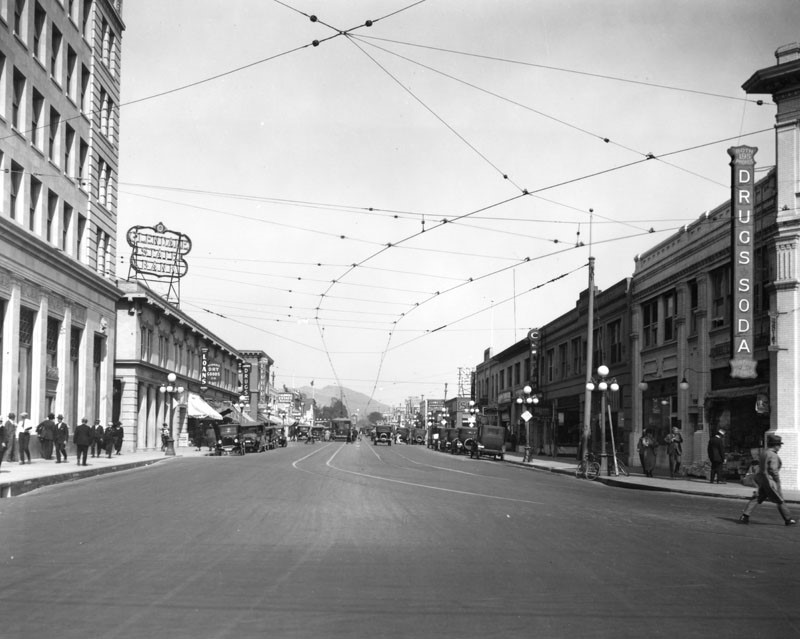 |
|
| (ca. 1924)^ - View looking east on Broadway from Brand Blvd. Streetcar wires are overhead, with tracks beneath. A Glendale State Bank sign is seen on the north, and a drugstore on the south. |
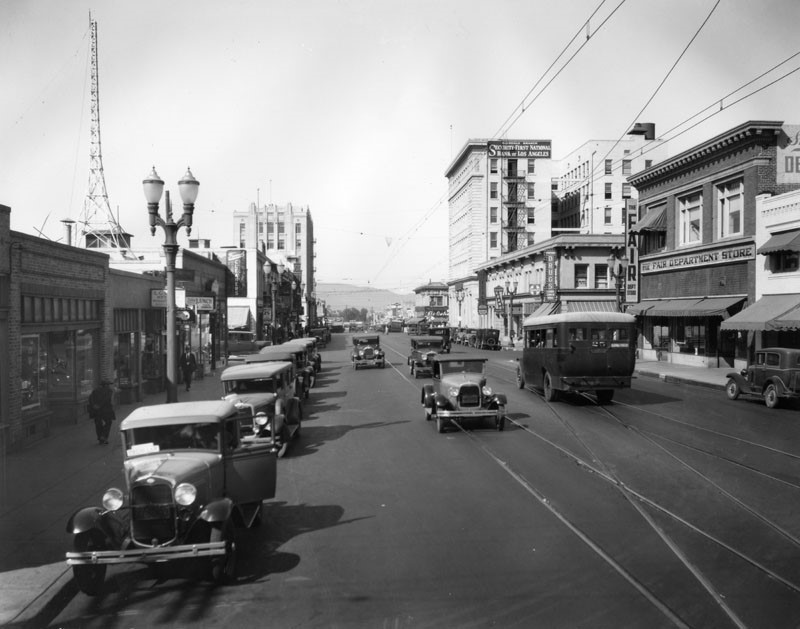 |
|
| (1930)^ - View looking west on Broadway toward Brand Boulevard where the Security-First National Bank stands (previously Security Trust and Savings Bank) . The Fair Department Store is seen on the right. |
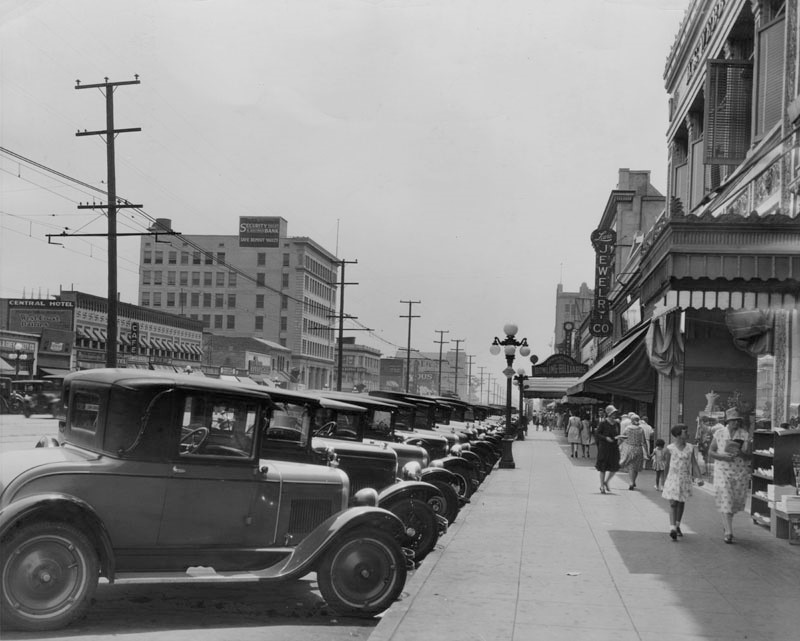 |
|
| (ca. 1929)^ - View looking south on Brand Boulevard at Wilson Ave. Cars parked diagonally line the street as pedestrians browse the shops. On the right, Lewis Jewelry Co. is visible mid-street, and on the opposite side of the road, the Central Hotel is seen on the corner and behind that, Security Trust & Savings Bank which would become Security-First National Bank circa 1930. |
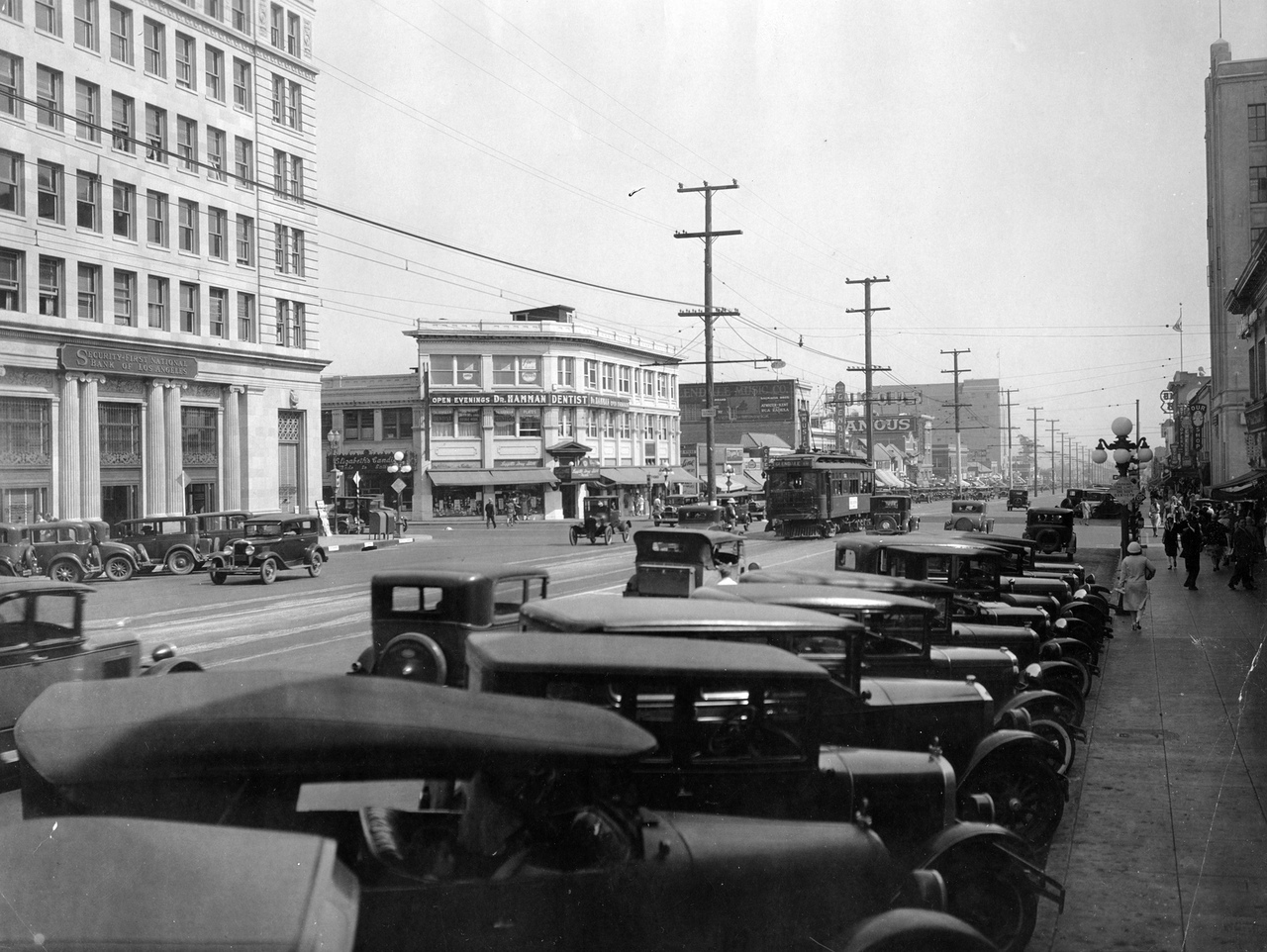 |
|
| (ca. 1931)^##- Downtown Glendale, looking south on Brand Boulevard toward Broadway. Security-First National Bank is on the left (originally the Security Trust and Savings Bank). |
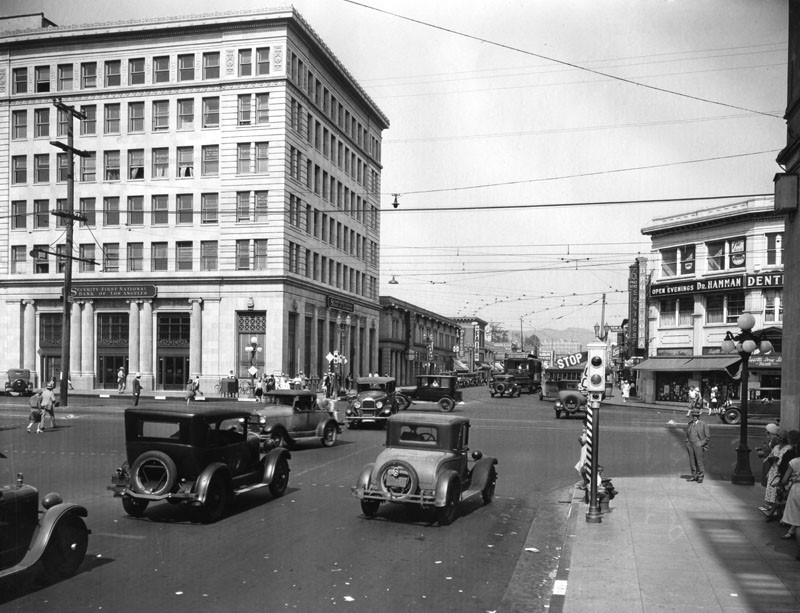 |
|
| (ca. 1931)^ - View looking east on Broadway at Brand Bloulevard with the Security-First National Bank building seen on the northeast corner. On the southeast corner is Dr. Hamman, Dentist. Note the STOP/GO semaphore traffic signal at lower-right. Click HERE for contemporary view. |
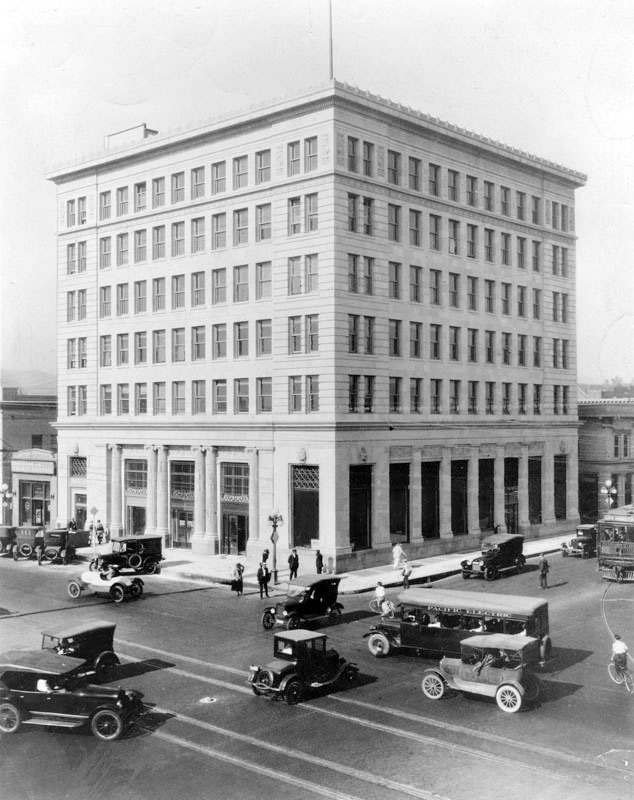 |
|
| (1931)^ - View looking at the very busy intersection of Brand and Broadway with the Glendale branch of Security-First National Bank standing on the northeast corner. This was the site of the old electric railroad station. Photo date: January 9, 1931. |
Historical Notes The NE corner of Brand and Broadway was the site of the Glendale depot of the Los Angeles Interurban railway, 1904-1923. The first six-story building in the city was constructed there by Security Trust and Savings Bank in 1923. Originally, the property was occupied by First National Bank of Glendale. |
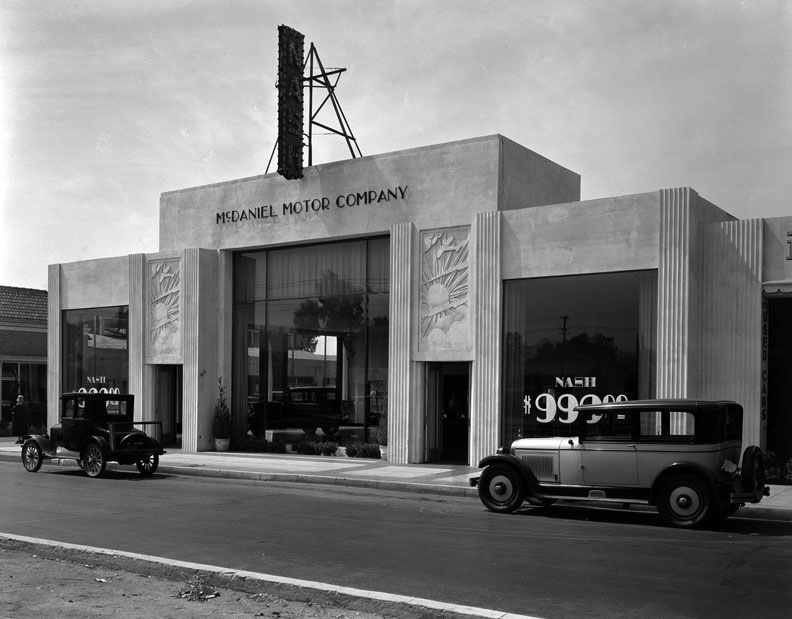 |
|
| (1926)^*# – View showing the McDaniel Motor Company Builidng located at 819 Brand Boulevard, Glendale. The Art-Deco building features a showroom with large display windows and decorative facade. Architect: C. Roderick Spencer. |
Historical Notes In the years between World War I and World War II, the country entered the age of the automobile, and this Art-Deco style worked particularly well in the expanding California automotive market where dealers competed fiercely for attention and for sales. |
.jpg) |
|
| (1926)^*# - View of the McDaniel Motor Co. car dealership showing the main showroom and the attached garage bay-style Used Car Department. Advertisement for a Nash Automobile for $999.00. |
Historical Notes Nash Motors was founded in 1916 by former General Motors president Charles W. Nash who acquired the Thomas B. Jeffery Company. Jeffery's best-known automobile was the Rambler whose mass production from a plant in Kenosha, Wisconsin began in 1902. The 1917 Nash Model 671 was the first vehicle produced to bear the name of the new company's founder. Nash enjoyed decades of success by focusing its efforts to build cars "embodying honest worth ... [at] a price level which held out possibilities of a very wide market." Charles Nash convinced the chief engineer of GM's Oakland Division, Finnish-born Nils Eric Wahlberg, to move to Nash's new company. The first Nash engine introduced in 1917 by Wahlberg had overhead valves, which Nash had learned about while working for Buick. Wahlberg is also credited with helping to design flow-through ventilation that is used today in nearly every motor vehicle.*^ |
Palace Grand Theatre
.jpg) |
|
| (1920s)^ - View of the Business Block on Brand Boulevard, in Glendale. The Palace Grand Theatre is seen on the right at 131 N. Brand Blvd. |
Historical Notes The Palace Grand Theatre was originally built and owned by Henry C. Jensen, who would later build the more palatial Raymond Theatre in Pasadena. The neo-classical building was designed by architect Robert G. Kitts. Construction on the Palace Grand began in August, 1914.^ |
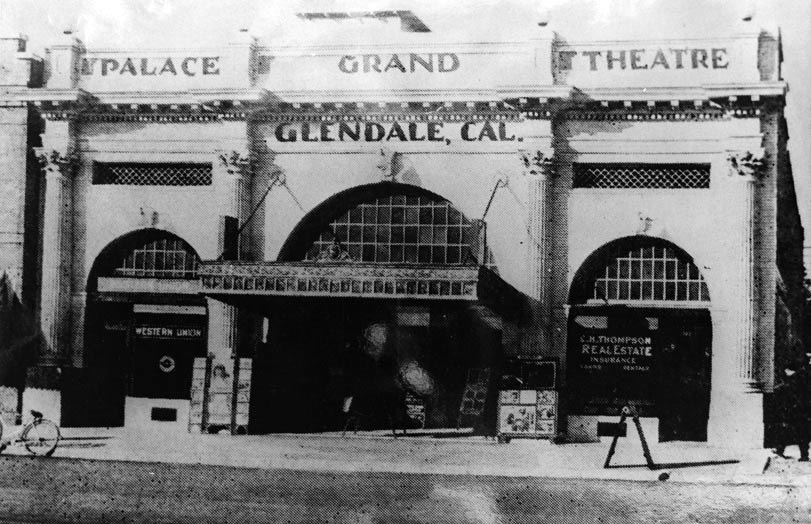 |
|
| (ca. 1920)^ - View showing the Palace Grand Theatre located at 131 N. Brand Boulevard with a bicycle parked at the curb. |
Historical Notes The Palace Grand Theatre was operated by Henry C. Jensen for several years. By 1923, though, it had been renamed the T D & L Theatre, operated by the Turner, Dahnken and Langley Company, which became the basis of the Fox-West Coast circuit. After T D & L it became the Lincoln Theatre. The entire block on which it stood has long since been redeveloped. It may have closed as early as the 1930’s. ^^* |
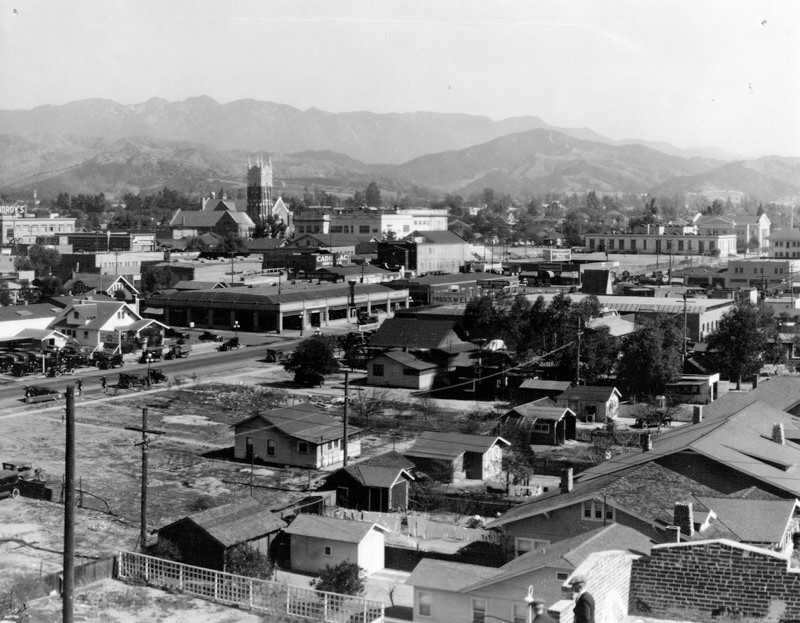 |
|
| (ca. 1925)^ - Panoramic view of Glendale looking northeast from the Lyons Storage building near Central Avenue and Colorado Boulevard. The Glendale Presbyterian Church with its distinctive bell-clock tower can be seen in the distance. |
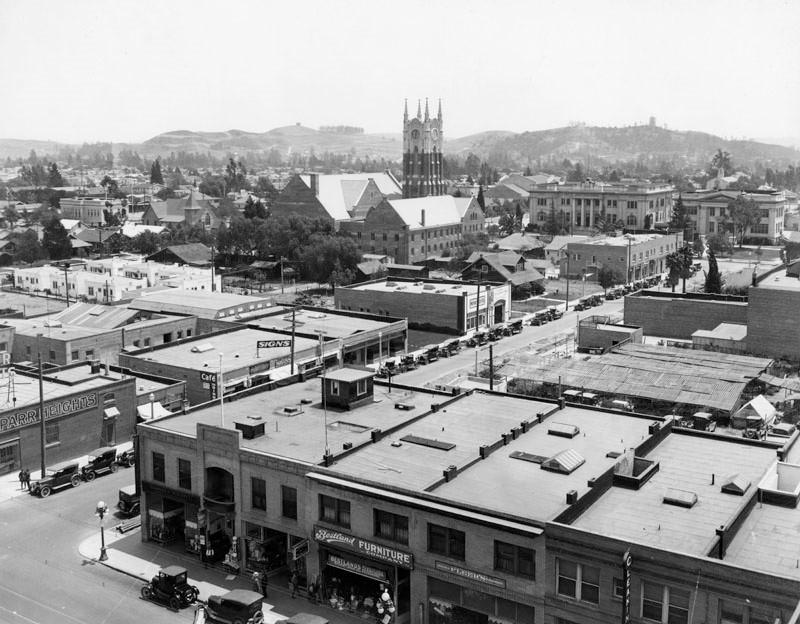 |
|
| (1925)^ - Panoramic view of Glendale from Broadway and Maryland, looking southeast to Forest Lawn Cemetery with a closer view of the Glendale Presbyterian Church. To the right of the Church can be seen Glendale Union High School (built in 1908). |
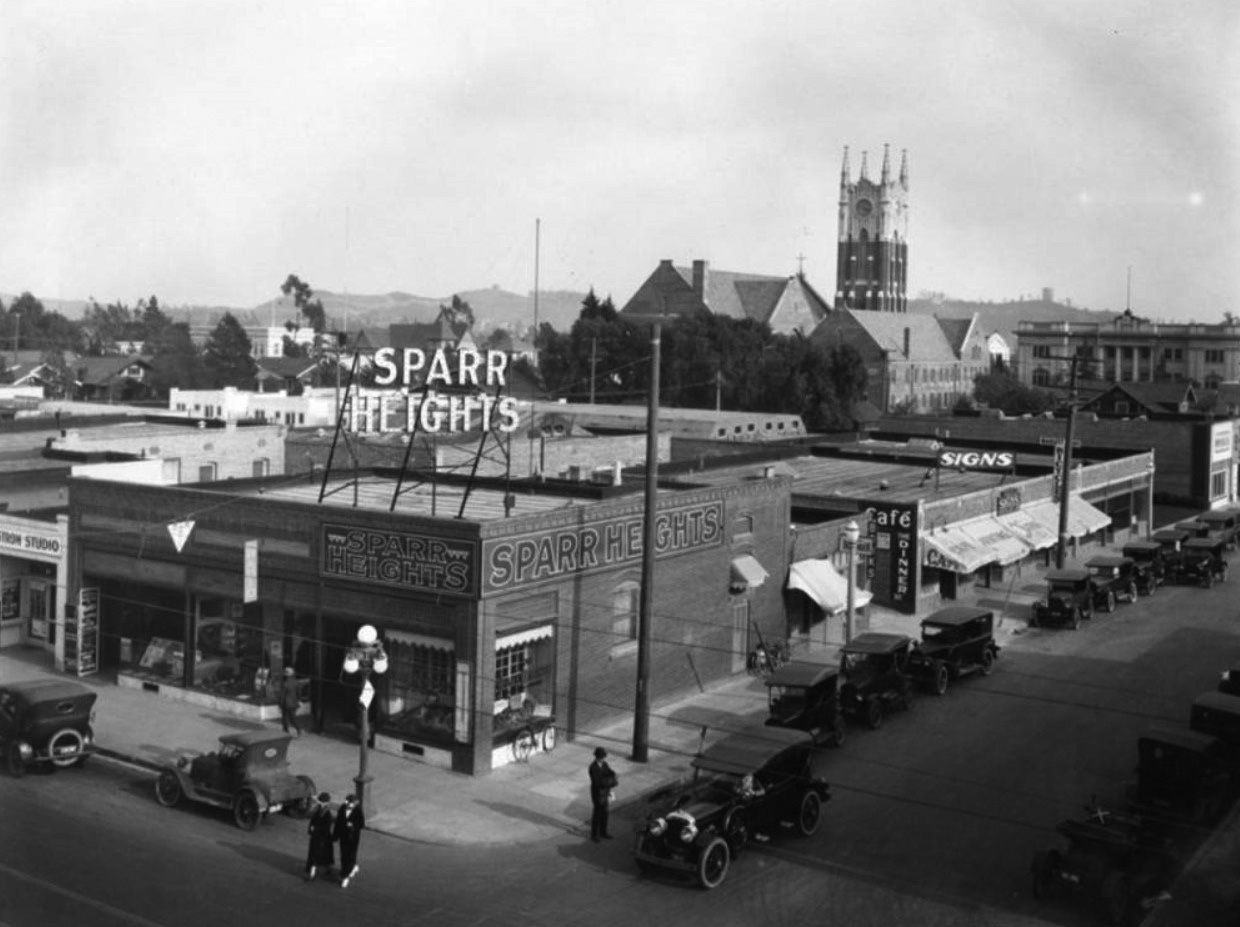 |
|
| (1920s)* - View looking southeast showing the Sparr Heights real estate office at the intersection of Broadway and Maryland, located next to Ostrom Studio. Glendale Presbyterian Church and Glendale Union High School can both be seen in the background. |
Historical Notes The area just south of Montrose was mostly orchards and vineyards owned by William Sparr. When he saw what was happening north of Honolulu Avenue in the 1920s, he decided to rip out his fruit trees and grapevines and divide his land into residential lots. He named the new area “Sparr Heights.” |
Glendale Presbyterian Church
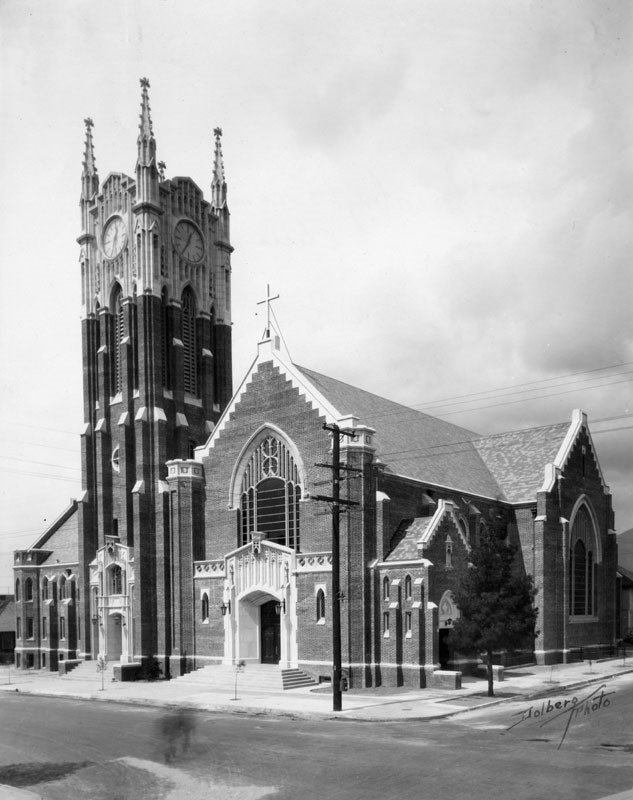 |
|
| (ca. 1924)^ - View of the bell tower with its clock and entrance to the Glendale Presbyterian Church located on the NW corner of Louise and Harvard streets. The church was built in 1923 in an English Gothic Revival style. |
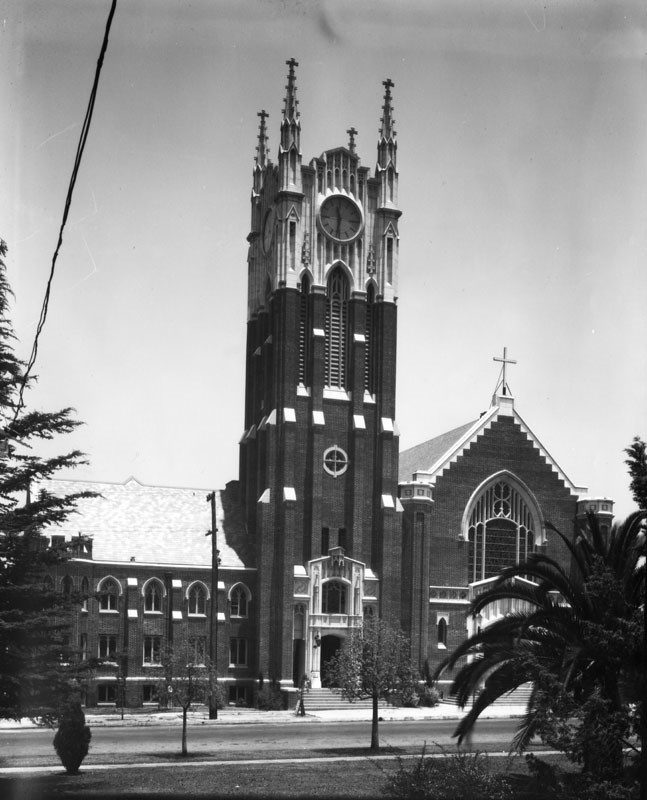 |
|
| (ca. 1920s)^ - Looking across Harvard Street showing the Glendale Presbyterian Church with its spires and clock tower. This church building no longer exists, however, the corner lot is still occupied by the Glendale Presbyterian Church. Click HERE for contemporary view. |
Glendale YMCA
 |
|
| (1920s)^ - Aerial view of Glendale at the foot of the Verdugo Mountains with Verdugo Canyon and the San Rafael Hills on the right. Housing development is encroaching on the citrus groves to the north. |
 |
|
| (ca. 1927)^ - Aerial view of Glendale looking northwest toward the Verdugo Mountains. The intersection of Brand Boulevard and Broadway is in the center. The spires of the Glendale Presbyterian Church are visible to the right of Brand. |
.jpg) |
|
| (ca. 1927)^ - Aerial shot over Brand Boulevard looking north toward the Verdugo Mountains. The two tallest buildings in view are the Security-First National Bank (NE corner of Brand and Broadway) and Glendale Presbyterian Church at center-right (NW corner of Louise and Harvard streets). |
Brand Boulevard (1920 +)
 |
|
| (1925)^ - View looking north on Glendale's Brand Boulevard, when power poles were still located in the middle of the street. An electric car is seen descending the street. Palm trees line the boulevard in the upper portion of the photo. |
Historical Notes During the 'teens and 'twenties Brand Boulevard grew into a lively, modern, commercial and entertainment street with banks, department stores, movie theaters and automobile showrooms, becoming the city's "Main Street". |
 |
|
| (1926)* - View shows several automobiles travelling up and down the business section of Brand Boulevard, in Glendale. Note train stopped in the middle of the road to pick up and drop of passengers. The 6-story building in the distance is on the northeast corner of Brand and Broadway. It was constructed by Security Trust and Savings Bank in 1923. Glendale Theater can be seen on the right. |
Historical Notes Security Trust & Savings Bank was founded in 1888 by J.F. Sartori and associates; the bank grew through the development of business and mergers and became Security-First National Bank of Los Angeles (ca. 1931).^ |
 |
|
| (1926)* - View shows several automobiles travelling up and down the business section of Brand Boulevard, in Glendale. Note train stopped in the middle of the road to pick up and drop of passengers. The 6-story building in the distance is on the northeast corner of Brand and Broadway. It was constructed by Security Trust and Savings Bank in 1923. Glendale Theater can be seen on the right. Image enhancement and colorization by Richard Holoff |
 |
|
| (1923)* - Spectators gather on both sides of Brand Boulevard to watch the long line of automobiles participating in the Industrial Parade. |
Historical Notes The Industrial Parade in Glendale in the 1920s was part of the city's vibrant growth and development during that period. Glendale experienced significant expansion through annexations, growing from over 7,000 acres in 1920 to 12,294 acres by 1930. The population also saw a substantial increase from 13,756 in 1920 to 62,736 in 1930. This growth was marked by the city's transformation into a lively commercial and entertainment hub with modern amenities like banks, department stores, movie theaters, and automobile showrooms along Brand Boulevard. |
 |
|
| (ca. 1924)^.^ – Street view looking north on Brand Boulevard. Monarch Auto Supply Co. and a drug store occupy the building on SE corner of S. Brand Blvd and E. Harvard St. seen on the right. The Glendale Theater can be seen in the distance. |
Historical Notes Today, the building on the SE corner of Brand and Harvard is occupied by a BevMo! Click HERE for contemporary view. |
 |
|
| (1924)^ - View from the middle of Brand Blvd. looking north. Pedestrians waiting just left of the train tracks for the Pacific Electric street car #566 to Los Angeles which is stopped at Broadway. Some of the businesses that can be seen include: "The Owl Drug Co.", "D.L. Gregg Hardware", "Glendale Music" and "Sun Drugs". |
 |
|
| (ca. 1924)^ - View looking north down the center of Brand Boulevard. The electric streetcar tracks are running north to south with a pair of tracks going off to the right toward Broadway. There are several businesses and stores that run along both sides of the street including "The Owl Drug Co." (N/W corner of Brand and Broadway). On the right in the distance, the Alexander Theatre with its original facade is visible. |
Historical Notes With population growing from 13,756 in 1920 to 62,736 in 1930, Glendale called itself "The Fastest Growing City in America". |
 |
|
| (1924)^ - View of the NE corner of Brand and Broadway in Glendale where the 1923-built Security Trust and Savings Bank stands. Note there are no street traffic lights as pedestrians and automobiles cross the streets. Many businesses may be seen on both sides of the street including railroad tracks which run down the middle of this wide street. |
 |
|
| (1924)^ - View looking north on Brand Boulevard from Broadway showing passengers boarding a Pacific Electric streetcar heading toward downtown Los Angeles. |
 |
|
| (ca. 1924)^ – Postcard view looking east on Broadway at Brand Boulevard. |
 |
|
| (ca. 1924)^ - View looking east on Broadway from Brand Blvd. Streetcar wires are overhead, with tracks beneath. A Glendale State Bank sign is seen on the north, and a drugstore on the south. |
 |
|
| (1930)^ - View looking west on Broadway toward Brand Boulevard where the Security-First National Bank stands (previously Security Trust and Savings Bank) . The Fair Department Store is seen on the right. |
 |
|
| (ca. 1929)^ - View looking south on Brand Boulevard at Wilson Ave. Cars parked diagonally line the street as pedestrians browse the shops. On the right, Lewis Jewelry Co. is visible mid-street, and on the opposite side of the road, the Central Hotel is seen on the corner and behind that, Security Trust & Savings Bank which would become Security-First National Bank circa 1930. |
 |
|
| (ca. 1931)^##- Downtown Glendale, looking south on Brand Boulevard toward Broadway. Security-First National Bank is on the left (originally the Security Trust and Savings Bank). |
 |
|
| (ca. 1931)^ - View looking east on Broadway at Brand Bloulevard with the Security-First National Bank building seen on the northeast corner. On the southeast corner is Dr. Hamman, Dentist. Note the STOP/GO semaphore traffic signal at lower-right. Click HERE for contemporary view. |
 |
|
| (1931)^ - View looking at the very busy intersection of Brand and Broadway with the Glendale branch of Security-First National Bank standing on the northeast corner. This was the site of the old electric railroad station. Photo date: January 9, 1931. |
Historical Notes The NE corner of Brand and Broadway was the site of the Glendale depot of the Los Angeles Interurban railway, 1904-1923. The first six-story building in the city was constructed there by Security Trust and Savings Bank in 1923. Originally, the property was occupied by First National Bank of Glendale. |
 |
|
| (1926)^*# – View showing the McDaniel Motor Company Builidng located at 819 Brand Boulevard, Glendale. The Art-Deco building features a showroom with large display windows and decorative facade. Architect: C. Roderick Spencer. |
Historical Notes In the years between World War I and World War II, the country entered the age of the automobile, and this Art-Deco style worked particularly well in the expanding California automotive market where dealers competed fiercely for attention and for sales. |
.jpg) |
|
| (1926)^*# - View of the McDaniel Motor Co. car dealership showing the main showroom and the attached garage bay-style Used Car Department. Advertisement for a Nash Automobile for $999.00. |
Historical Notes Nash Motors was founded in 1916 by former General Motors president Charles W. Nash who acquired the Thomas B. Jeffery Company. Jeffery's best-known automobile was the Rambler whose mass production from a plant in Kenosha, Wisconsin began in 1902. The 1917 Nash Model 671 was the first vehicle produced to bear the name of the new company's founder. Nash enjoyed decades of success by focusing its efforts to build cars "embodying honest worth ... [at] a price level which held out possibilities of a very wide market." Charles Nash convinced the chief engineer of GM's Oakland Division, Finnish-born Nils Eric Wahlberg, to move to Nash's new company. The first Nash engine introduced in 1917 by Wahlberg had overhead valves, which Nash had learned about while working for Buick. Wahlberg is also credited with helping to design flow-through ventilation that is used today in nearly every motor vehicle.*^ |
Palace Grand Theatre
.jpg) |
|
| (1920s)^ - View of the Business Block on Brand Boulevard, in Glendale. The Palace Grand Theatre is seen on the right at 131 N. Brand Blvd. |
Historical Notes The Palace Grand Theatre was originally built and owned by Henry C. Jensen, who would later build the more palatial Raymond Theatre in Pasadena. The neo-classical building was designed by architect Robert G. Kitts. Construction on the Palace Grand began in August, 1914.^ |
 |
|
| (ca. 1920)^ - View showing the Palace Grand Theatre located at 131 N. Brand Boulevard with a bicycle parked at the curb. |
Historical Notes The Palace Grand Theatre was operated by Henry C. Jensen for several years. By 1923, though, it had been renamed the T D & L Theatre, operated by the Turner, Dahnken and Langley Company, which became the basis of the Fox-West Coast circuit. After T D & L it became the Lincoln Theatre. The entire block on which it stood has long since been redeveloped. It may have closed as early as the 1930’s. ^^* |
 |
|
| (ca. 1925)^ - Panoramic view of Glendale looking northeast from the Lyons Storage building near Central Avenue and Colorado Boulevard. The Glendale Presbyterian Church with its distinctive bell-clock tower can be seen in the distance. |
 |
|
| (1925)^ - Panoramic view of Glendale from Broadway and Maryland, looking southeast to Forest Lawn Cemetery with a closer view of the Glendale Presbyterian Church. To the right of the Church can be seen Glendale Union High School (built in 1908). |
 |
|
| (1920s)* - View looking southeast showing the Sparr Heights real estate office at the intersection of Broadway and Maryland, located next to Ostrom Studio. Glendale Presbyterian Church and Glendale Union High School can both be seen in the background. |
Historical Notes The area just south of Montrose was mostly orchards and vineyards owned by William Sparr. When he saw what was happening north of Honolulu Avenue in the 1920s, he decided to rip out his fruit trees and grapevines and divide his land into residential lots. He named the new area “Sparr Heights.” |
Glendale Presbyterian Church
 |
|
| (ca. 1924)^ - View of the bell tower with its clock and entrance to the Glendale Presbyterian Church located on the NW corner of Louise and Harvard streets. The church was built in 1923 in an English Gothic Revival style. |
 |
|
| (ca. 1920s)^ - Looking across Harvard Street showing the Glendale Presbyterian Church with its spires and clock tower. This church building no longer exists, however, the corner lot is still occupied by the Glendale Presbyterian Church. Click HERE for contemporary view. |
Glendale YMCA
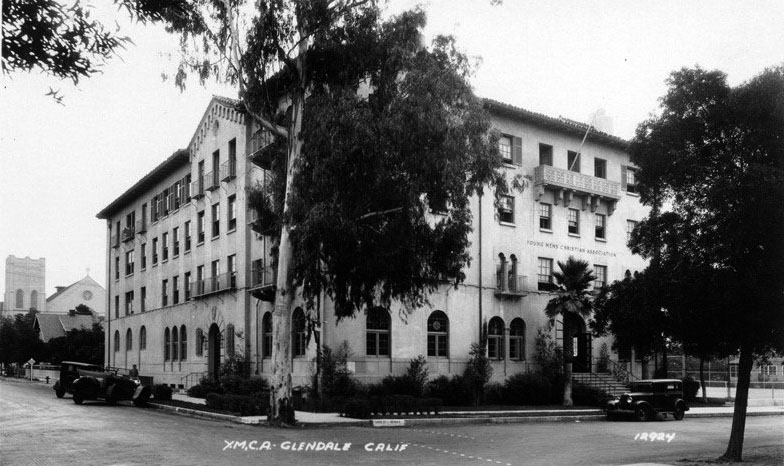 |
|
| (ca. 1926)^*# – Postcard view looking at the SE corner of Wilson Avenue and Louise Street showing the newly constructed Glendale YMCA. |
Historical Notes The Glendale YMCA was founded in 1919. A massive fundraising drive brought in enough money in 1926 to construct one of the most successful establishments of Glendale. Located at Wilson Avenue and Louise Street the building is an excellent example of Spanish Colonial Revival architecture and was originally designed with an open-air courtyard in the center and an underground swimming pool. Upper rooms were constructed for housing.^ |
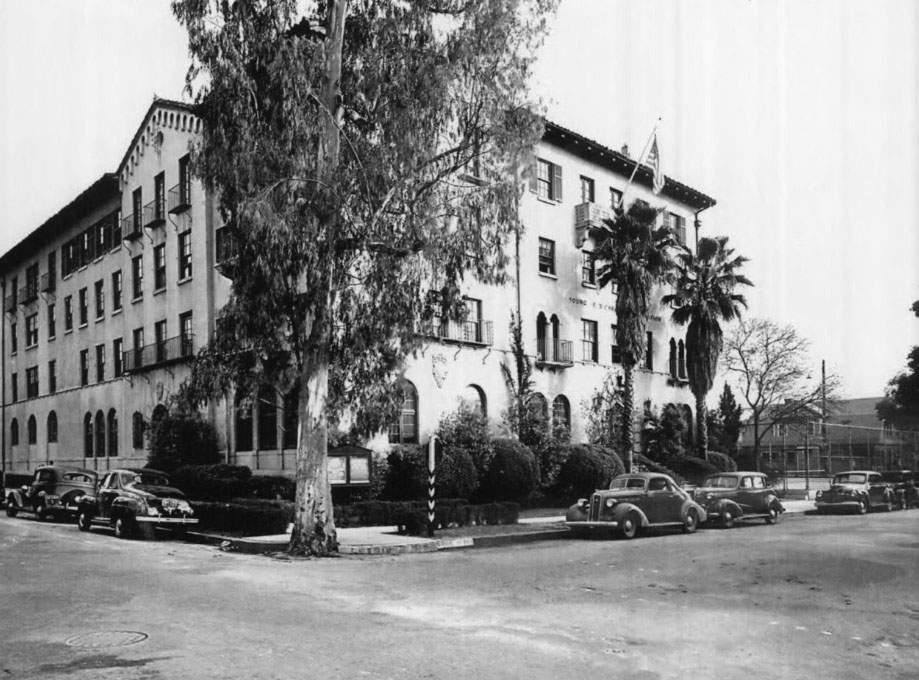 |
|
| (1938)#* – View showing a large Eucalyptus tree on the corner in front of the Glendale YMCA building. The building still houses YMCA today, but the Eucalyptus tree is no longer standing. Click HERE for contemporary view. |
Glendale Masonic Temple
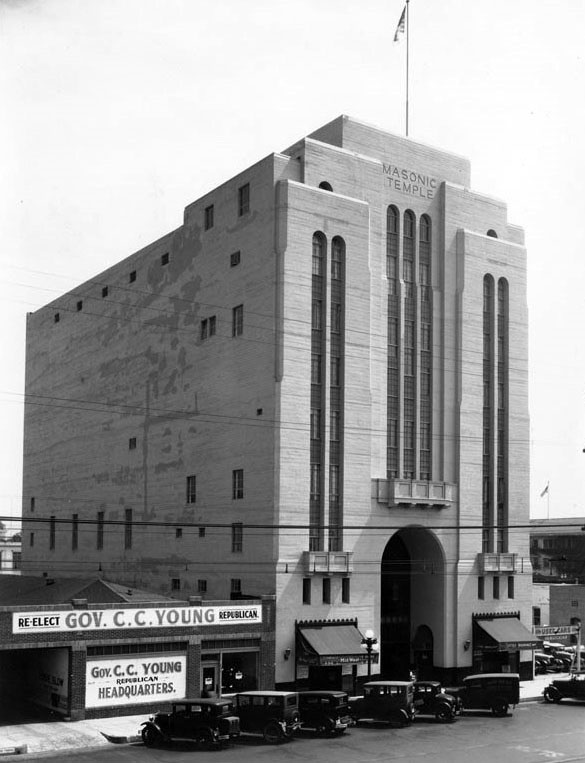 |
|
| (1931)^*# – View showing the Glendale Masonic Temple, located at 232 S. Brand Blvd. The ‘Re-elect Gov. C.C. Young Headquarters’ is seen on the left. |
Historical Notes The 1920s-building was designed by Arthur Lindley, whose firm Lindley & Selkirk designed the Alex Theatre a few blocks north of the temple. California Governor C.C. Young ran for a second term but lost to Frank Merriam, and left office on January 6, 1931. He retired from politics and returned to his business in real estate development.*^ |
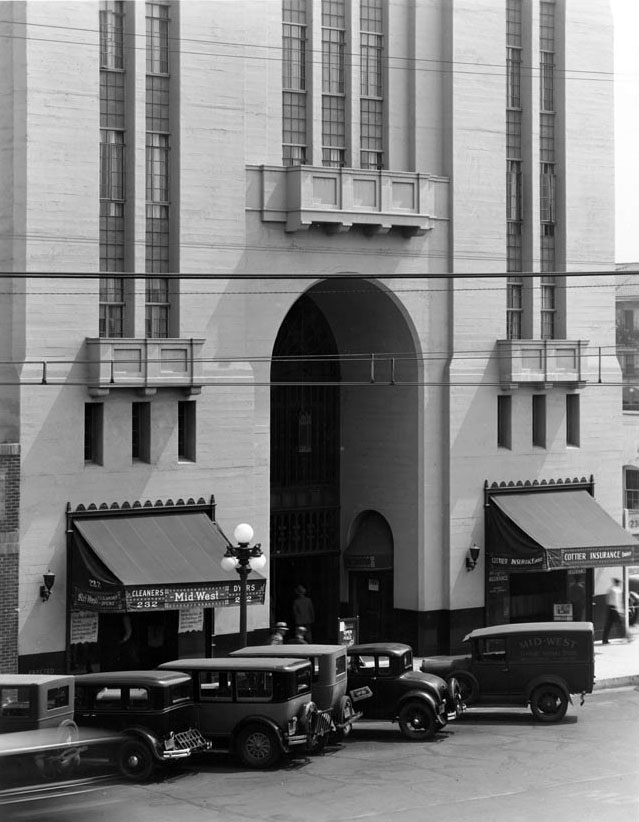 |
|
| (1931)^*# - Closer view showing the entrance to the Masonic Temple on Brand. |
Historical Notes Americana at Brand owner Rick Caruso and his company, Caruso Affiliated, bought the 1920s-era Masonic temple right across the street from the Americana and renovated the building. The repurposed Art Deco building now houses the commercial real estate firm CBRE. Click HERE to see contemporary view. |
* * * * * |
Glendale News-Press
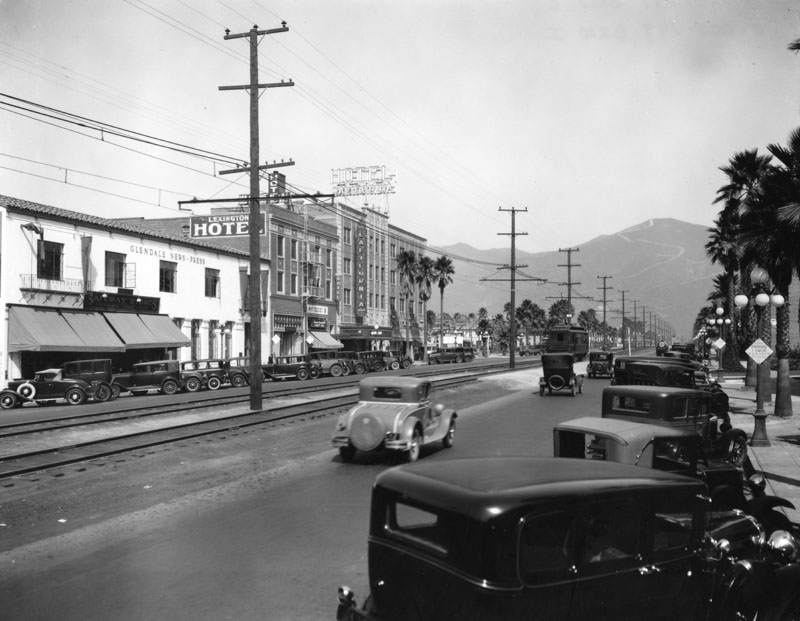 |
|
| (ca. 1931)^ - View looking down Brand Boulevard, in Glendale. The Lexington Hotel and Hotel California are the two large buildings across the street. The white building on the left belongs to the Glendale News-Press. |
Historical Notes The Glendale News-Press was formed when Ira Clifton Copley's Copley Press bought and combined the Glendale Daily Press and the Glendale Evening News in 1905. Copley sold the News Press and the Burbank Daily Review to Morris Newspapers in 1974; however Morris sold off the papers two years later. Ingersoll Publications bought the papers in 1980. Page Group Publishing, who had just bought the Orange Coast Daily Pilot and the Huntington Beach Independent, acquired the paper from Ingersoll in 1989. Times Mirror bought the newspaper group in 1993. The Glendale News-Press covers local news, entertainment and sports in Glendale and La Crescenta-Montrose. With a readership of more than 10,000, it is now published twice-weekly, instead of daily.*^ |
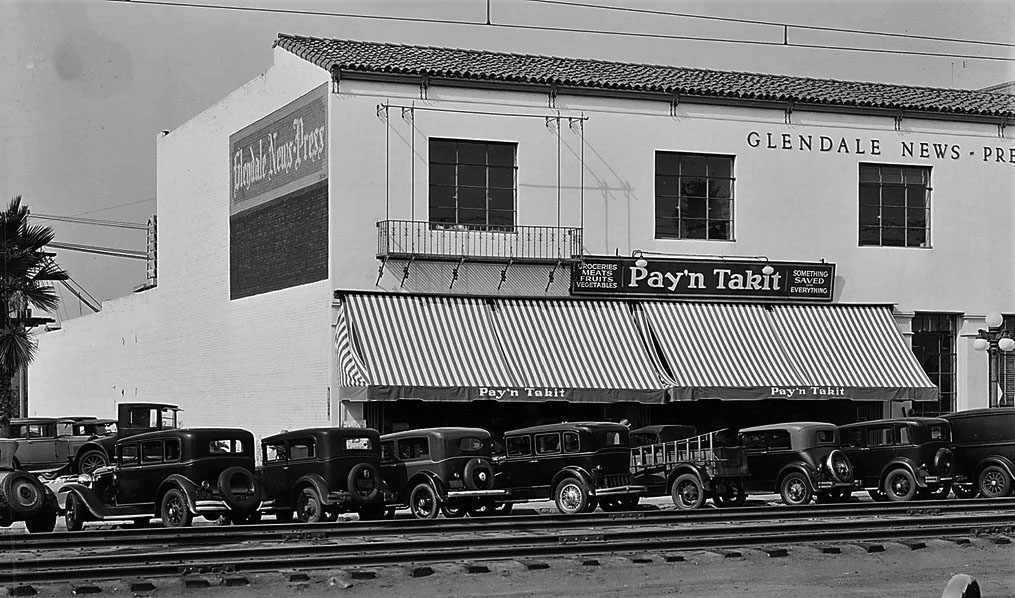 |
|
| (1931)^^ – View looking at west across the tracks showing the Pay'n Takit Store located at 329 North Brand Boulevard. The grocery store shared the building with Glendale News-Press. |
Glendale Avenue (1920s)
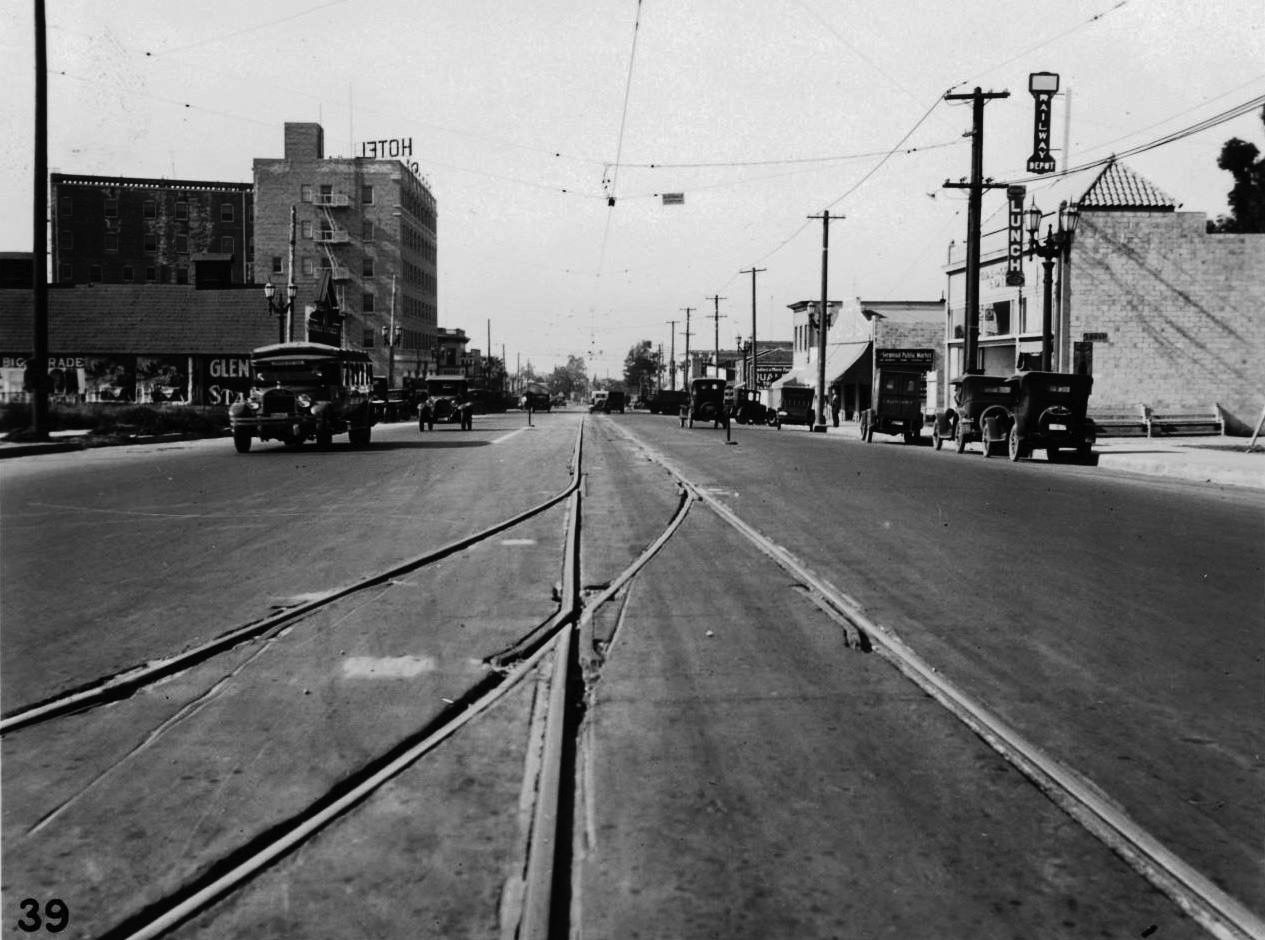 |
|
| (1926)++# - View looking south on Glendale Avenue from just below Wilson Avenue. Note the Glendale & Montrose depot at right, the surviving Glendale Hotel at left and the rails curving off to the left to run in Wilson and thence to Eagle Rock. |
 |
|
| (1920s)++# – View showing the Glendale & Montrose (G&M) car No. 12 at the G&M depot on Glendale Ave. |
Historical Notes G&M No. 12 was one of four cars, nos. 10-13, built for the G&M by the American Car Company in 1920. ++# |
Brand Boulevard (1940s)
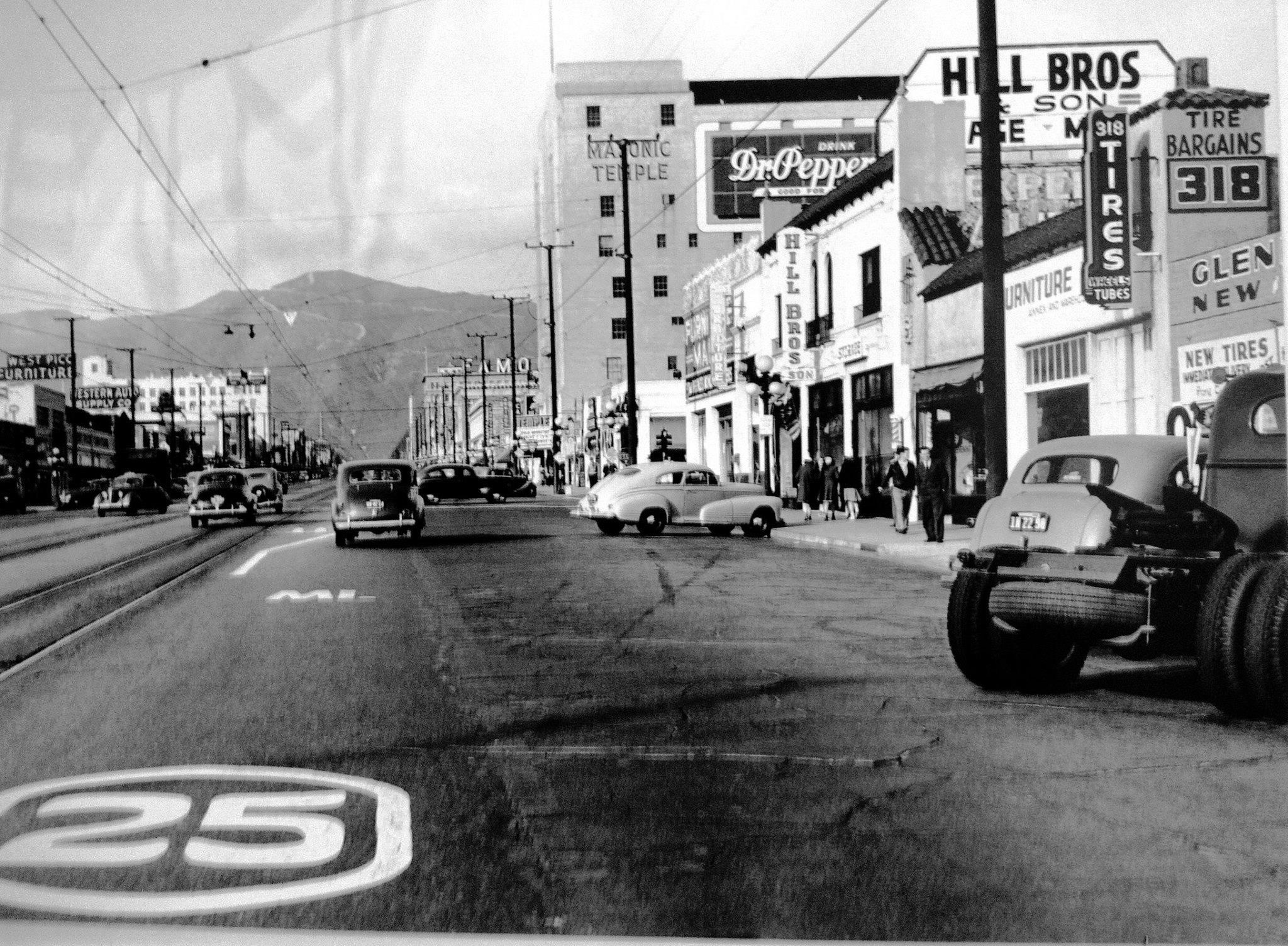 |
|
| (1940)* – Brand Blvd looking north from Colorado Blvd. Streetcar tracks seen on the left. The tallest building in the distance is the Masonic Temple. |
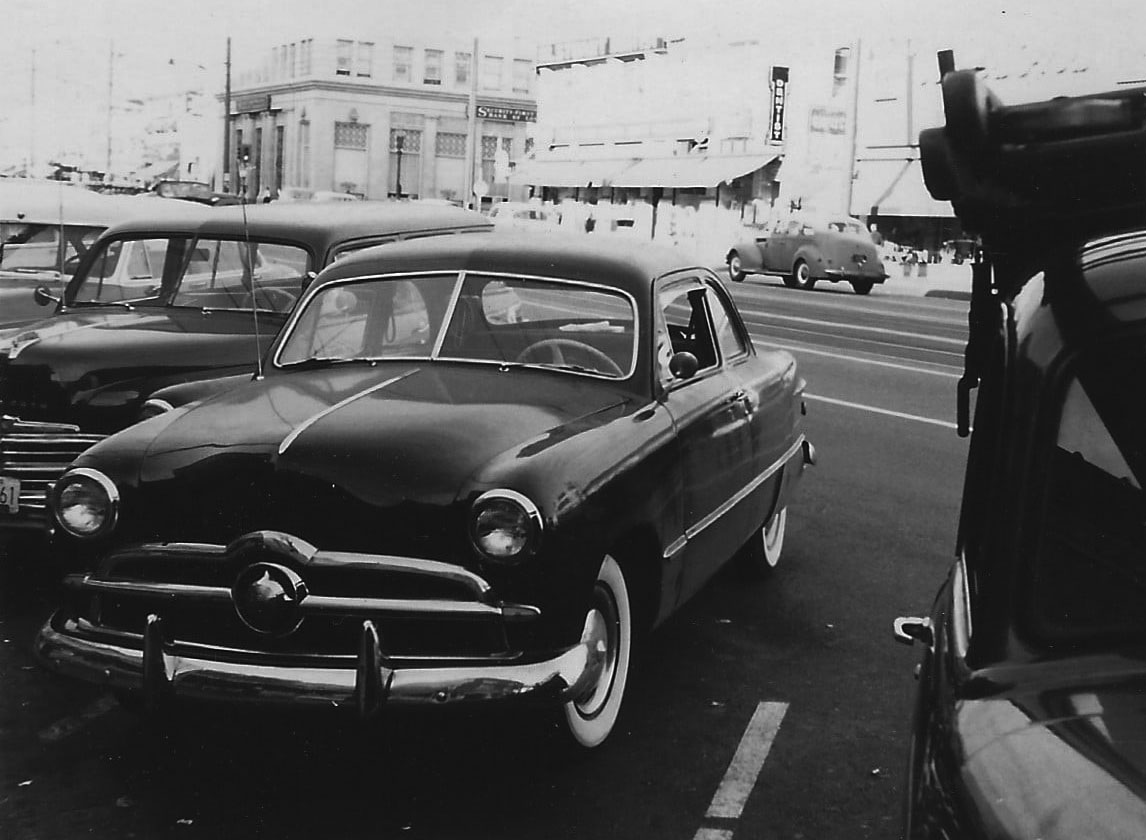 |
|
| (1949)* – Ford Coupe parked on Brand s/o Broadway with streetcar tracks running down the center of Brand Boulevard. |
Historical Notes Popularly called the "Shoebox Ford" for its slab-sided, "ponton" design, the 1949 Ford is credited both with saving Ford and ushering in modern streamlined car design with changes such as integrated fenders and more. This design would continue through the 1951 model year, with an updated design offered in 1952. The crest was designed by Frank L. Engle.^ |
* * * * * |
Brand Blvd Red Car
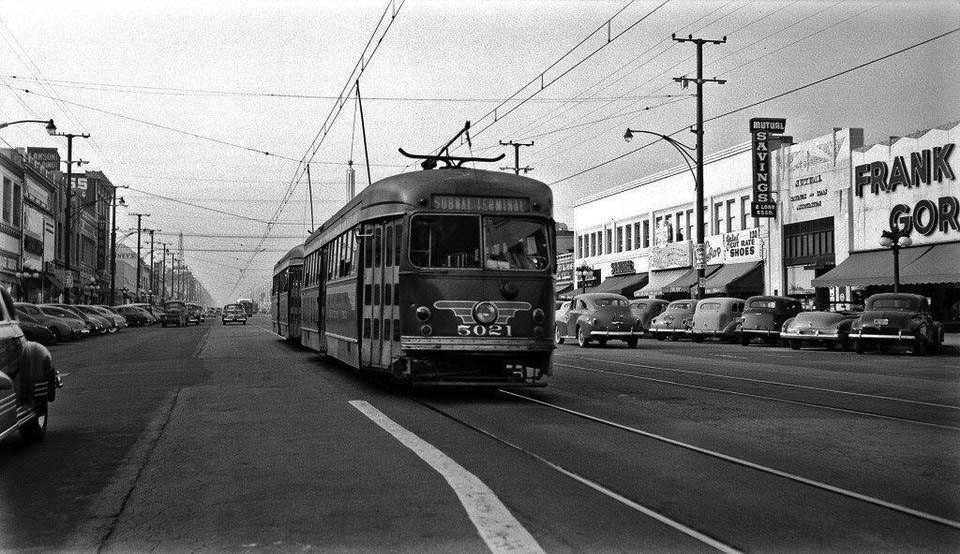 |
|
| (1949)* – View showing Pacific Electric PCC no. 5021 rolling to a stop on Brand Boulevard at Broadway. On the right is the east side of the 100 block of N. Brand. At 114 N. Brand is "Frank Gordon" clothes. At 118 N. Brand is "Mutual Savings & Loan". |
Historical Notes The Red Car on Brand Boulevard in Glendale was a significant part of Southern California's public transportation history, operating from the early 1900s to the mid-1950s. The story began in 1903 when L.C. Brand's Los Angeles & Glendale Electric Railway started construction on a local train line. However, in 1904, Brand sold his company to Henry E. Huntington's Los Angeles Inter-Urban Railway (LAIU). The line, initially known as "The Glendale Line," began service between Glendale and Downtown Los Angeles on April 10, 1904. |
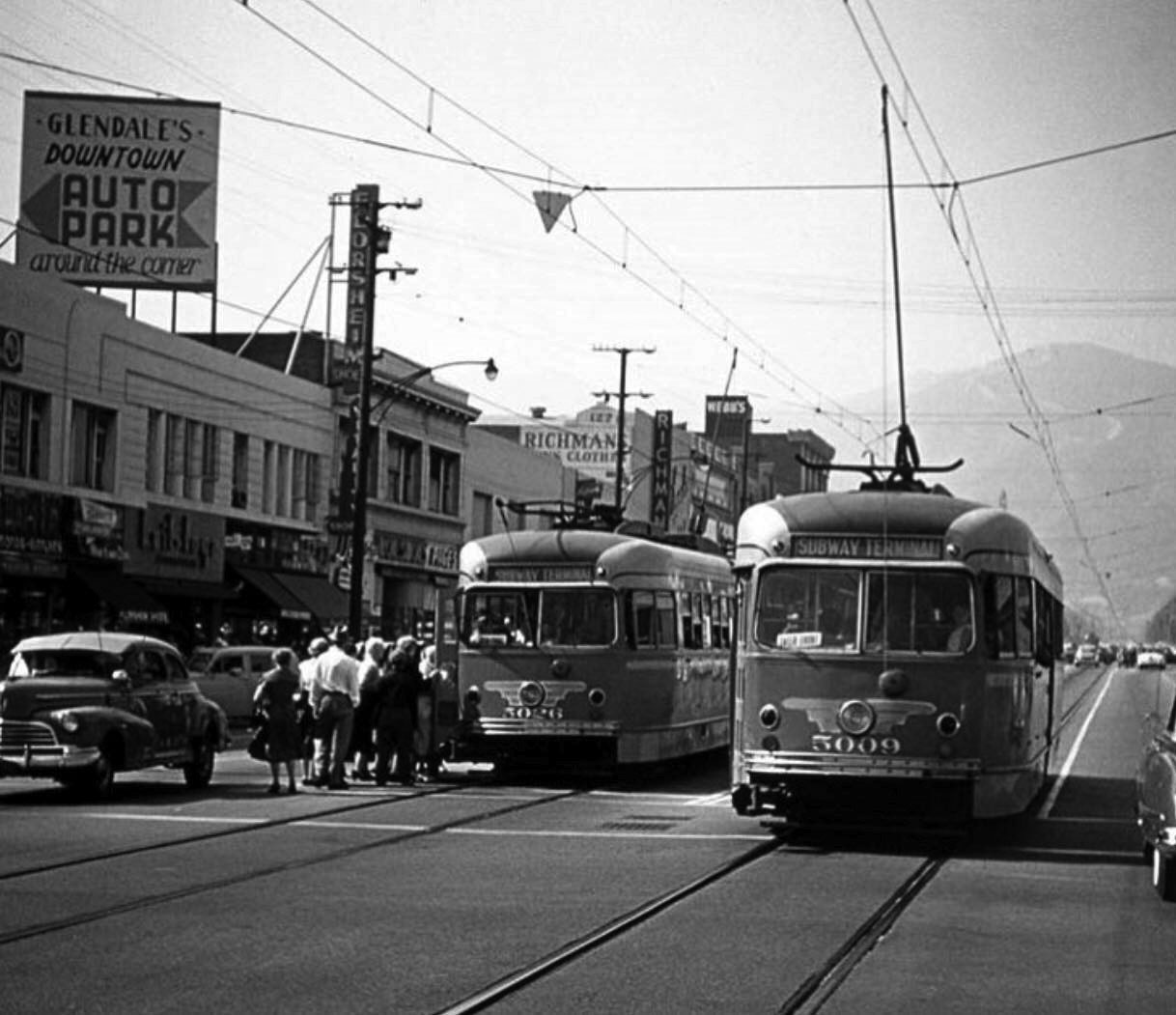 |
|
| (ca. 1949)* – Passengers are seen boarding Pacific Electric PCC no. 5026 heading to Subway Terminal in downtown Los Angeles with a second streetcar on adjacent tracks. |
Historical Notes In 1908, the Pacific Electric Railway, also owned by Huntington, assumed control of the line and extended it to Burbank, renaming it "The Glendale-Burbank Line." The Red Car ran along Brand Boulevard, which became Glendale's bustling "Main Street" during the 1920s. The line played a crucial role in Glendale's rapid growth, with the city's population increasing significantly during this period. |
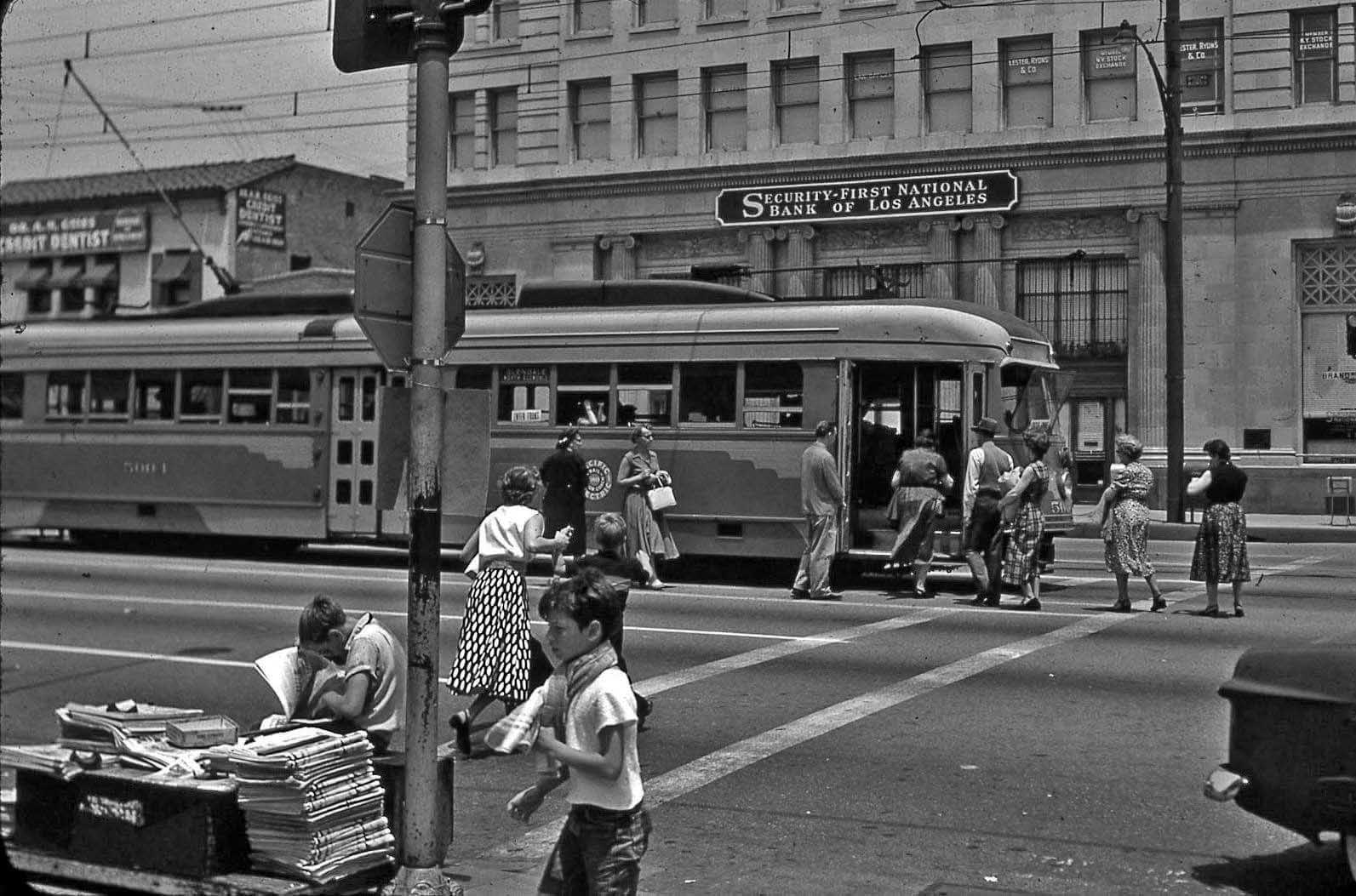 |
|
| (ca. 1950s)* - View looking east from behind a newstand at the NW corner of Brand Boulevard and Broadway showing passengers boarding the Pacific Electric PCC with the Security-First National Bank in the background. |
Historical Notes The Red Car system was extensive, with more than 1,000 miles of track throughout Southern California. It was not only a means of transportation but also a driver of the region's economy, allowing working-class Angelenos to commute to their jobs daily. The Brand Boulevard/Broadway station in downtown Glendale served as the main depot for Red Car riders visiting the city during the height of its use. |
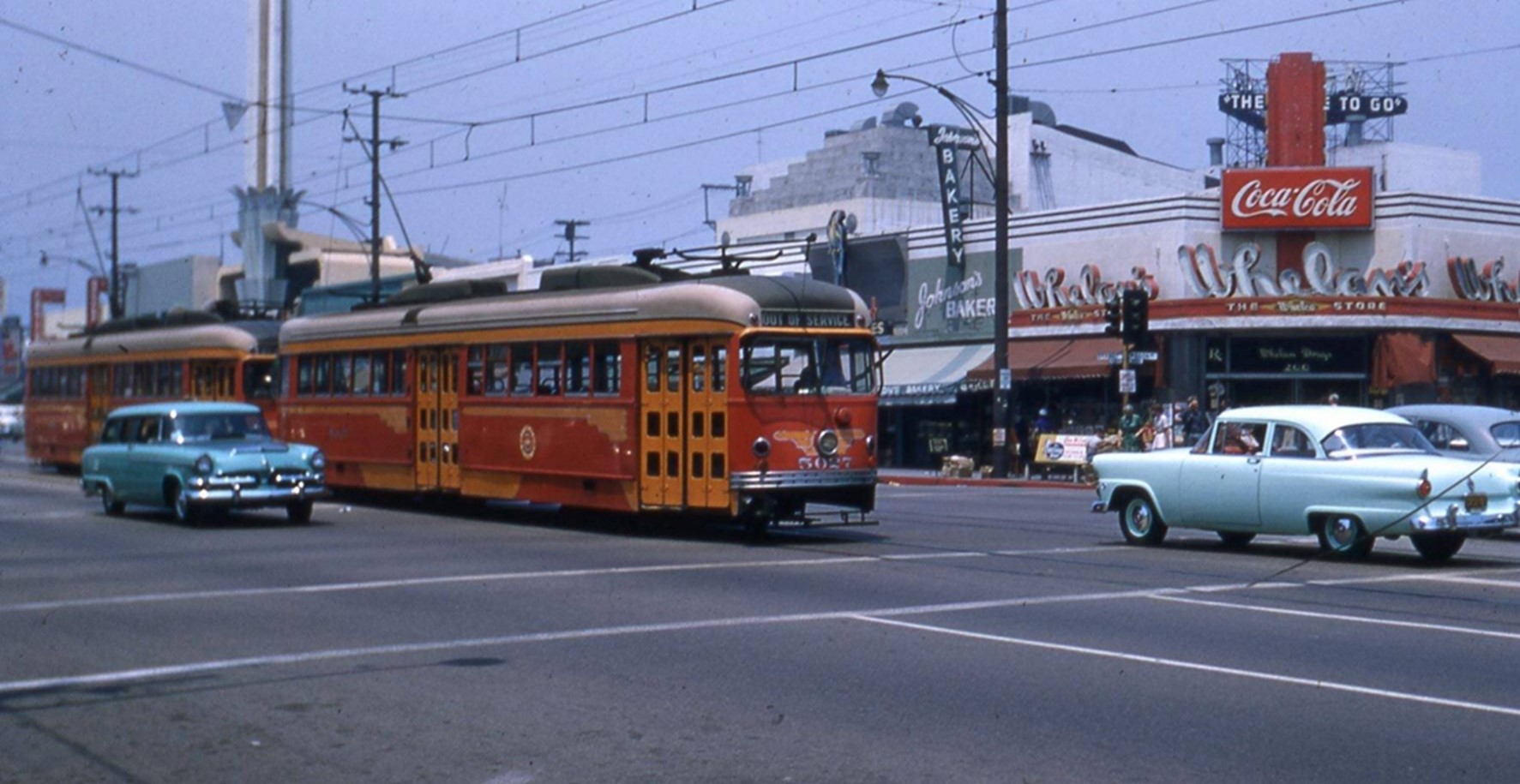 |
|
| (1955)* - View looking northeast at the corner of Brand Boulevard and Wilson Avenue showing two streetcars inbound to LA on the next to the last day of PE service to Glendale, 6/18/1955. The tower and roof of the Alex Theater rise in the background. |
Historical Notes The Red Car's prominence began to decline in the post-World War II era. Several factors contributed to this decline, including rising operational costs, the growth of automobile ownership, and the development of suburbs beyond the reach of the existing rail lines. The system's infrastructure, much of which dated back to the early 1900s, also required significant rehabilitation. |
 |
|
| (1955)* - View of Pacific Electric PCC and Hollywood cars at North Glendale Avenue (end of Brand) on the last day of service on the Glendale line. Photo by Loren Ayers, 6/19/1955 |
Historical Notes The end of the Red Car era came gradually. Rail service to North Glendale ceased on June 18, 1955, and the final day of service on the Glendale-Burbank line was in June 1955. Despite its relatively short lifespan, the Red Car had a significant impact on Glendale's development, shaping the city's growth and urban layout. Today, remnants of the Red Car era can still be found, serving as reminders of Los Angeles's once extensive rail network. |
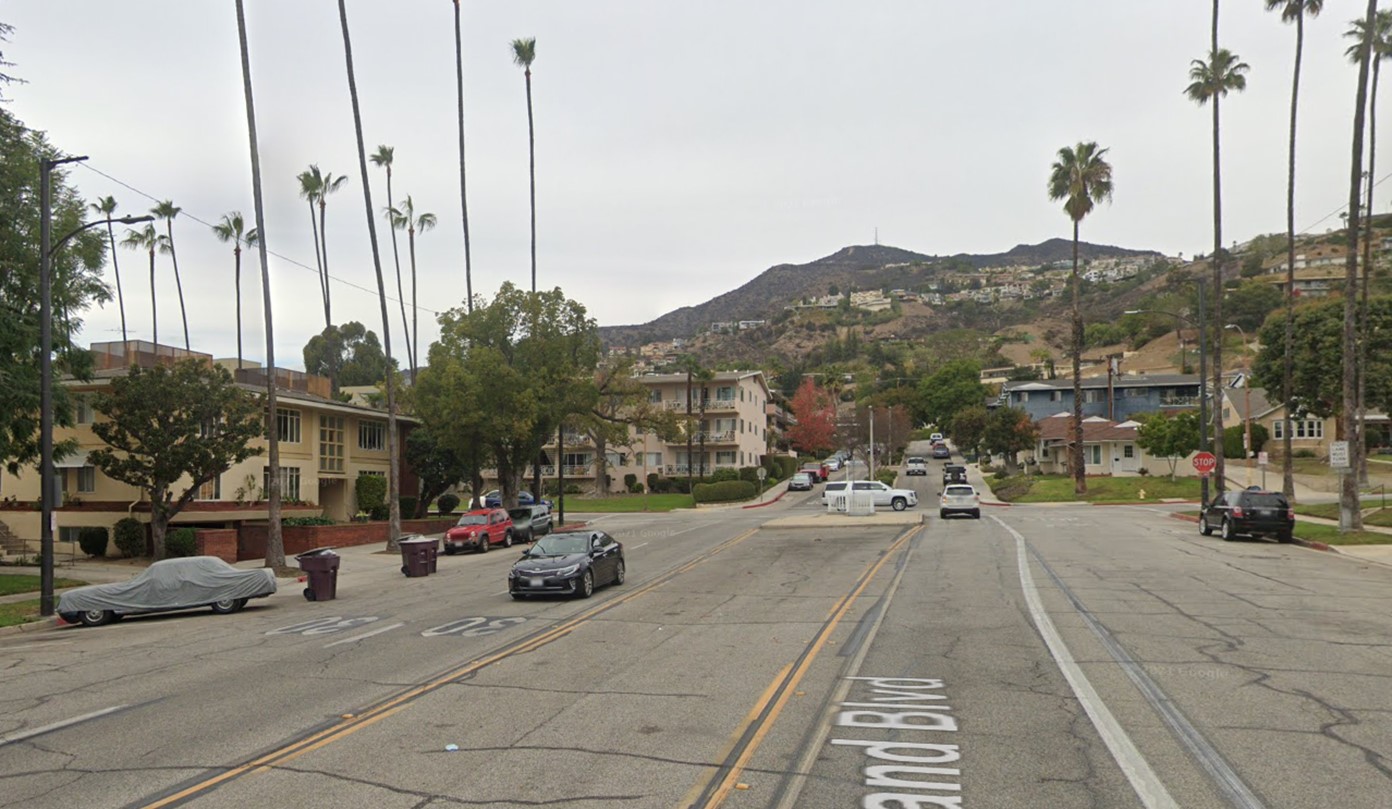 |
|
| (2021)* – A view looking north on Brand Boulevard toward Mountain Street, marking the former terminus of the Red Car line in Glendale. |
Then and Now
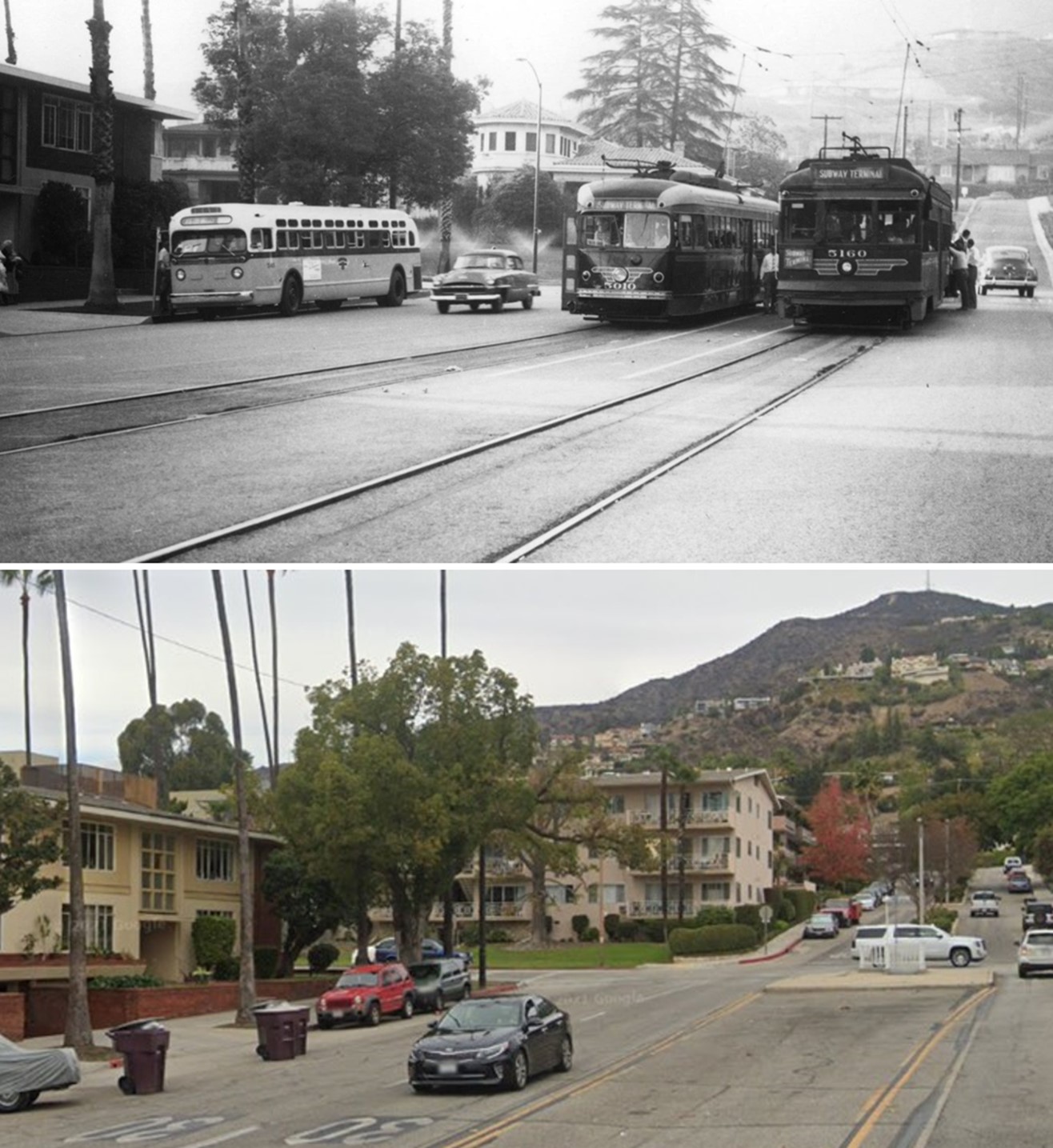 |
|
| (1955 vs 2021)* - Looking north on Brand Boulevard toward Mountain Street, the former terminus of the Red Car line in Glendale. The 1955 photo captures the final day of Red Car service through the city. |
Then and Now
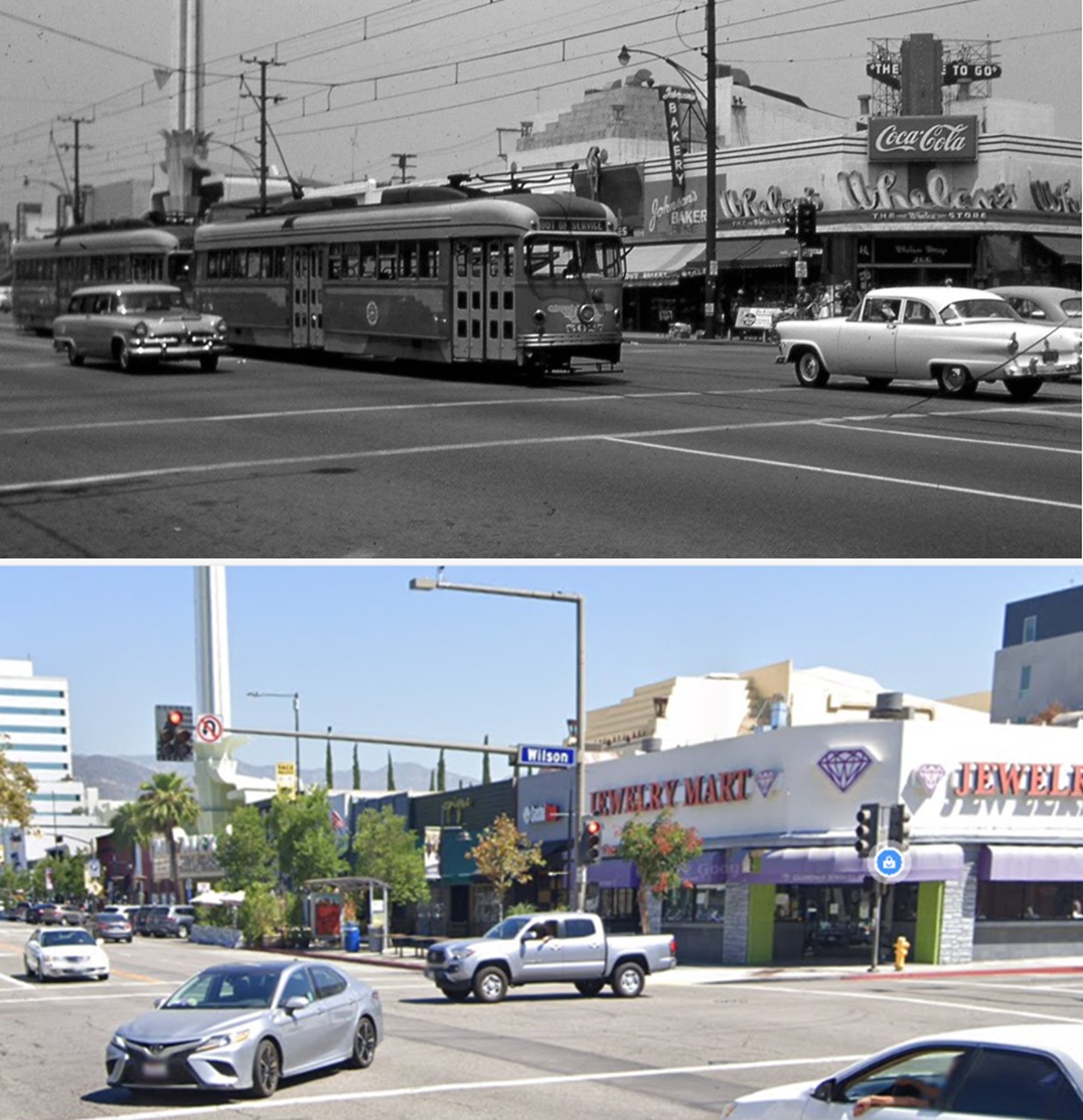 |
|
| (1955 vs. 2022)* - The intersection of Brand Boulevard and Wilson Avenue with the tower of the Alex Theatre seen in the background. |
* * * * * |
.jpg) |
|
| (1927)* - View looking north from the southeast corner of Western Ave and W. Glenoaks Blvd, Glendale. A morning three-car train of PE 500-class interurbans stands ready to whisk its riders to the Subway Terminal, downtown LA. The Verdugo Mountains can be seen at right. Click HERE for contemporary view. |
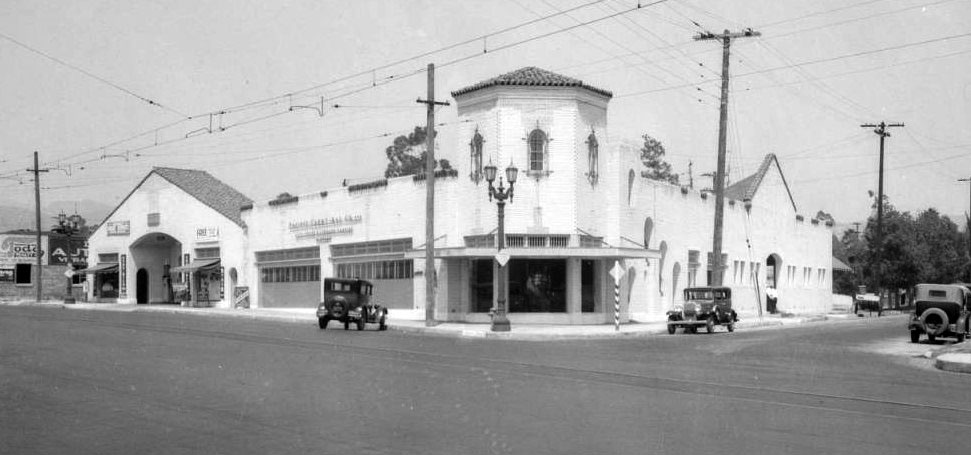 |
|
| (1931)* – Panoramic view showing the NE corner of Harvard Street and S. Glendale Ave. The above building is still standing today and is occupied by a Honda Dealership. Click HERE for contemporary view. |
* * * * * |
Hoover High School
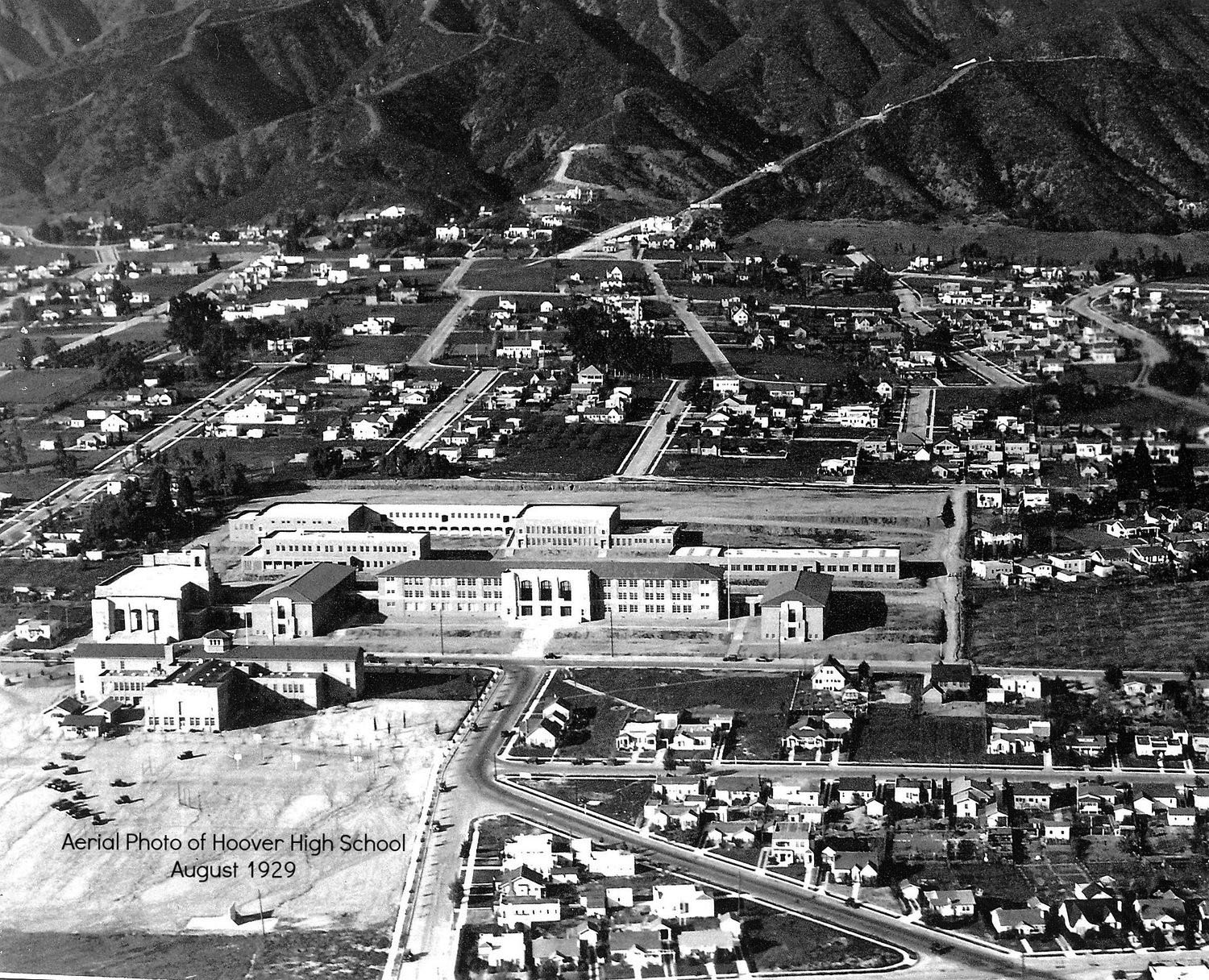 |
|
| (1929)^.^ – Aerial view showing a newly constructed Hoover High School located in the northern part of Glendale at the intersection of Glenwood Road and Concord Street. |
Historical Notes The school's original campus, on Glenwood Road, opened in 1929. Named after Herbert Hoover, the school was built to serve the northern foothill area of Glendale, which had experienced a lot of development in the 1920s. The first issue of the school yearbook, Scroll, included copies of letters written by Hoover and his wife, Lou. The school dedicated that issue to Hoover. The school has been the setting for several television programs and movies, most notably "Because They're Young", which was filmed at the campus during the summer recess in 1959. The original campus, with the exception of the auditorium and physical education facilities, was demolished in 1966 being replaced by a new facility which was completed in 1969. In 1990, due to continual and anticipated growth in the number of students entering Hoover, a 33-classroom facility was built and completed in 1992.^ |
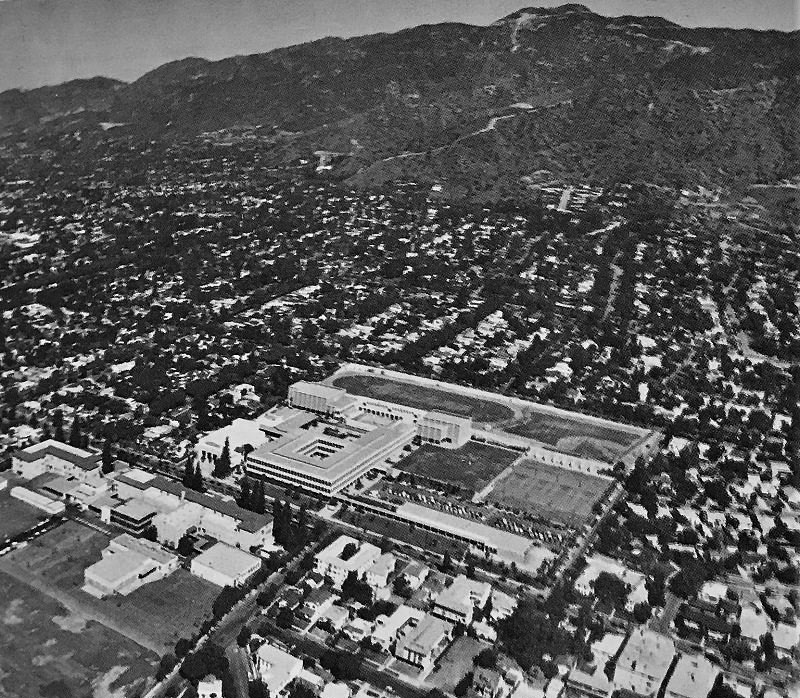 |
|
| (1974)^.^ - Hoover High School aerial shot with the Verdugo Mountains in the background. Click HERE for contemporary view. |
* * * * * |
Glendale Airport (Grand Central Airport)
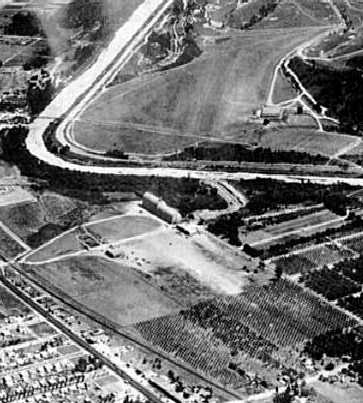 |
(1927)*# – Aerial view looking southeast showing the Glendale Airport field in an early configuration with a smaller border (bottom of photo). Note the peach orchard forming the northern border at lower-right. The Slate Aircraft Corporation dirigible hangar is visible on the south side of the field (center) and Griffith Park Airport is visible across the river.
|
Historical Notes In 1922—with prompting from the Aero Club of California, returning World War I pilots and local aviation enthusiasts who wanted to get in on the exciting new world of flying—the Glendale Chamber of Commerce purchased 33 acres adjacent to the Southern Pacific Railroad tracks, directly across the river from the Griffith Airdrome. They cleared a 1,200-ft. runway for the Glendale Municipal Airport. It opened in March 1923. Soon after clearing the field, objections were raised for the City’s plans, and a bond issue was unsuccessful, so citizen supporters, led by Dr. Thomas Young, got together to form the Glendale Airport Association. This group bought the City out, and Glendale finally had an official airport. The first hangar built at Glendale Airport was for the Kinner Airplane & Motor Corporation. Bert Kinner built Amelia Earhart’s first airplane, the Kinner Airster, in 1923. He also manufactured the first government-certified aircraft engine in 1928. +## |
.jpg) |
|
| (1927)*# – View showing three biplanes and one monoplane in front of the Wilson Aero Corporation hangar, with the Slate Aircraft Corporation dirigible hangar also visible on the left. |
Historical Notes The concept for this airport probably began with Leslie Coombs Brand (1859–1925), a major figure in the settlement and economic growth of the Glendale area. He had purchased land on the lower slopes of Mount Verdugo overlooking the city, and in 1904 built an imposing residence that became known as Brand Castle (which today houses the Brand Library). Just across the mostly dry Los Angeles River he could see the Griffith Park Aerodrome's grass field, built in 1912. Just three years later he decided to build his own grass airstrip below his mansion (Brand Field). He built his first hangar in 1916 and put together a fleet of planes, and held fly-in parties. The only requirement was that guests had to arrive in their own planes and bring passengers.*^ |
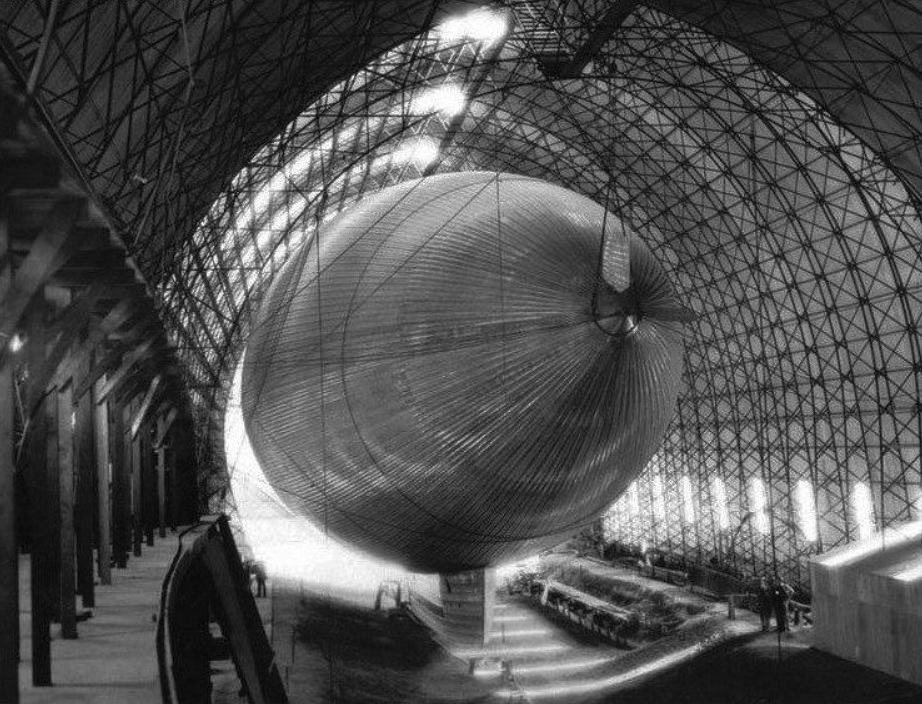 |
|
| (1928)* - The Slate Dirigible is docked in its hanagar at Glendale Airport. At the time, this was the largest built metal hangar in the United States. |
Historical Notes In 1925, Thomas Slate leased space adjacent to the south side of the Glendale Airport for the construction of an all-metal dirigible, a very novel (but ultimately unsuccessful) design. The dirigible was made out of duralumin & was filled with hydrogen. It was forecast to have a cruising speed of 80 mph and would accommodate 40 passengers and 5 crew. The dirigible was to be powered by oil and driven by steam-turbine, using one rotary blower, which would create a vacuum, instead of traditional propellers. Slate also constructed a metal hangar, the largest built in the United States at the time.* |
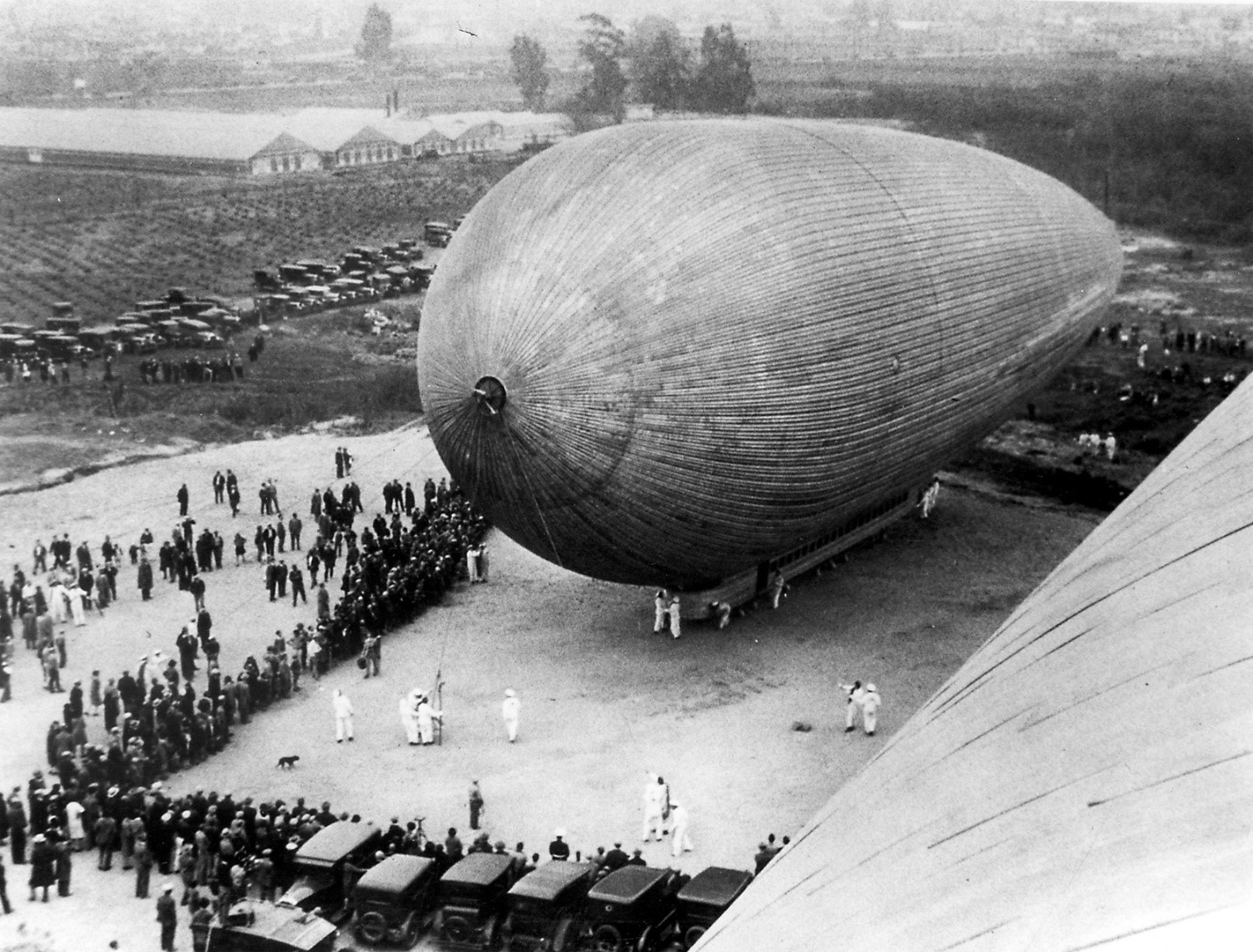 |
|
| (1929)*– Large crowd surrounds a Slate Dirigible at Glendale Airport. |
Historical Notes Dec. 19, 1929- Thomas Benton-Slate was an entrepreneur who invented dry-ice. This day in the suburb of Glendale, he attempted to fly the first all metal dirigible, the City of Glendale. He brought it out two days ago and it immediately began to pop rivets in the heat and fall apart. So he brought it in for repairs. This day he tried one more time, but the sun’s heat expanded the shell, causing rivets to pop again, followed by a metallic explosion and escaping gas. He had it dragged back into the hanger and forgot about it. * |
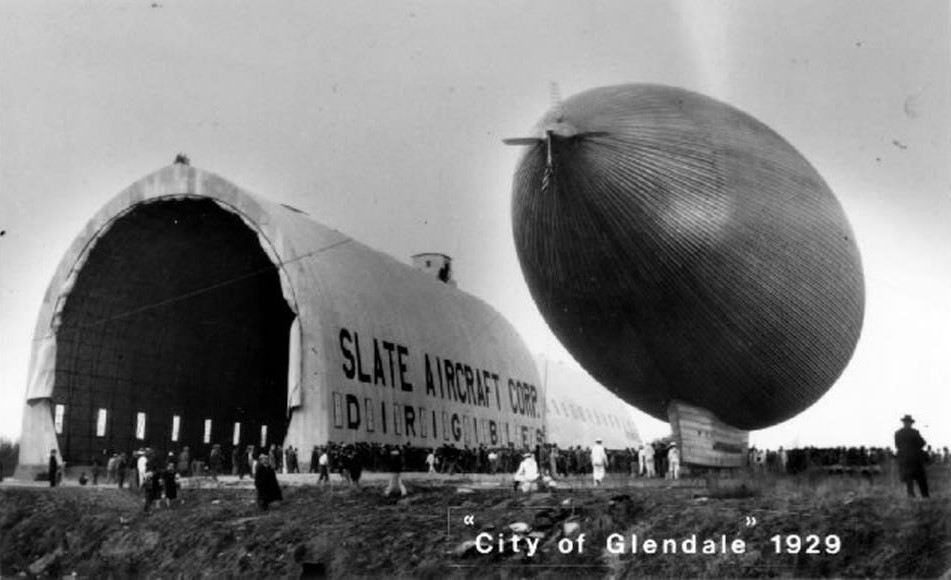 |
|
| (1929)* - Thomas Benton-Slate’s dirigible outside its hangar. |
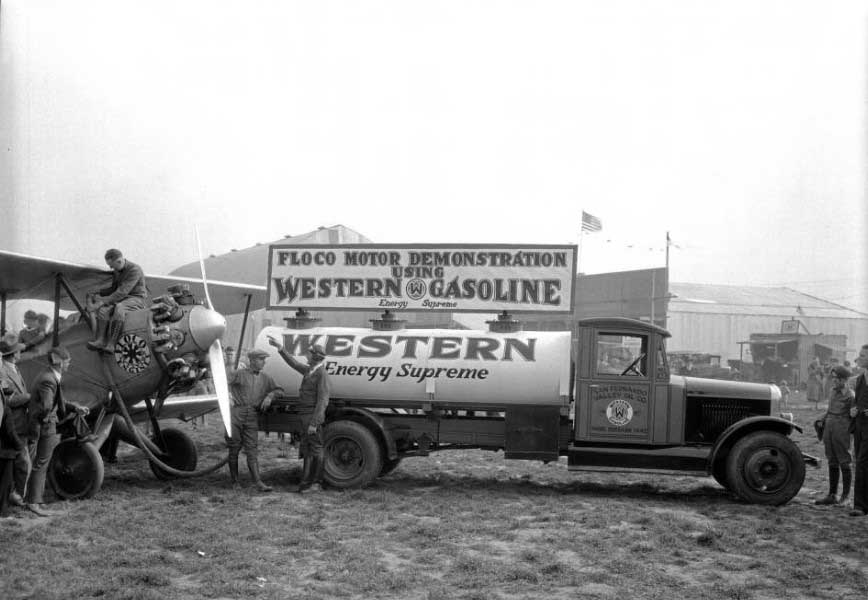 |
|
| (1928)#* - Men refuel a biplane at the Glendale Airport. A sign on the top of the fuel truck reads "Floco motor demonstration using Western Gasoline : energy supreme". The truck has the business's name, San Fernando Valley Oil Co., painted on the side of the cab. Photo by "Dick" Whittington |
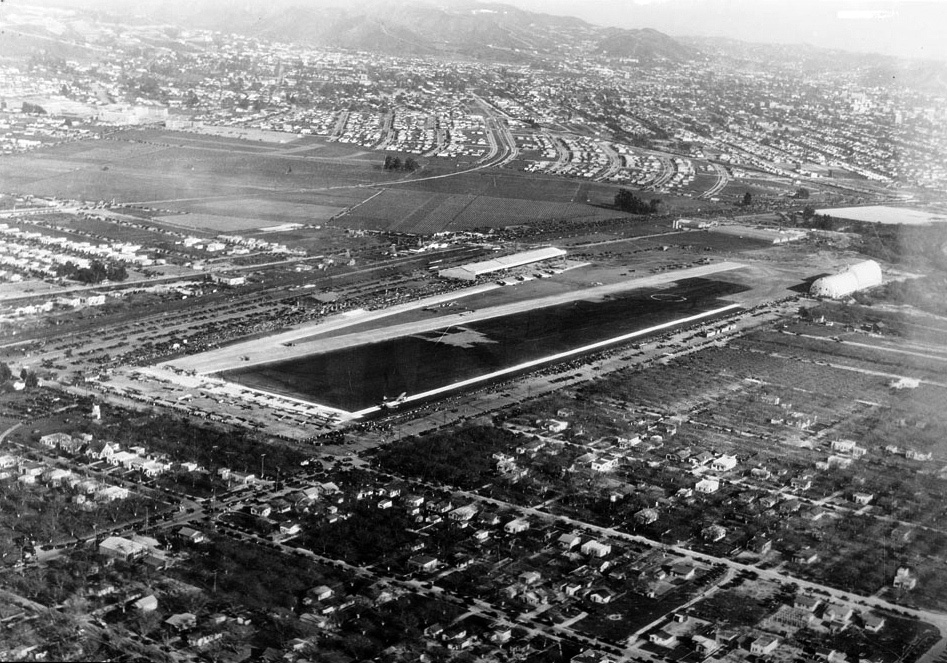 |
|
| (1929)^* - Aerial view of Grand Central Air Terminal, Glendale, 1929. The airfield can be seen at center and a single runway is visible. Hundreds of cars can be seen parked near the runway at left, and planes are visible on the taxiways. Closely spaced houses can be seen in the foreground and in the background. |
Historical Notes The Glendale Municipal Airport was renamed "Grand Central Air Terminal" (GCAT) when it was purchased by other venture capitalists, who expanded it to 175 acres. On February 22, 1929 a terminal with a control tower had been built, and was opened to much fanfare. Designed by Henry L. Gogerty, the intention was to construct an air terminal along the lines of a classic railroad terminal. It combined a style consisting of Spanish Colonial Revival with Zig-zag Moderne influences (Art Deco). GCAT became a major airport of entry to Los Angeles and provided the first paved runway west of the Rocky Mountains. Within a year, the entire enterprise was sold to a group calling itself the Curtiss-Wright Flying Service, managed by Major Corliss C. Moseley, a co-founder of the future Western Airlines. It became the city's largest employer.*^ |
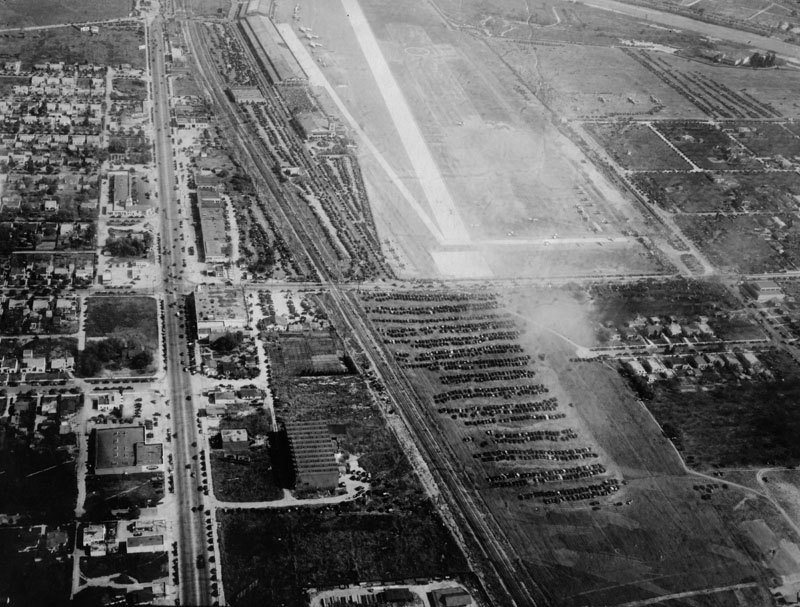 |
|
| (ca. 1929)* - Aerial view of Grand Central Aiport in Glendale on U.S. Army Air Force Day. Planes are parked in front of hangers and on the field. A large number of cars are parked on a field below the airport. A crowd stands between the Grand Central Air Terminal building and the hangars. |
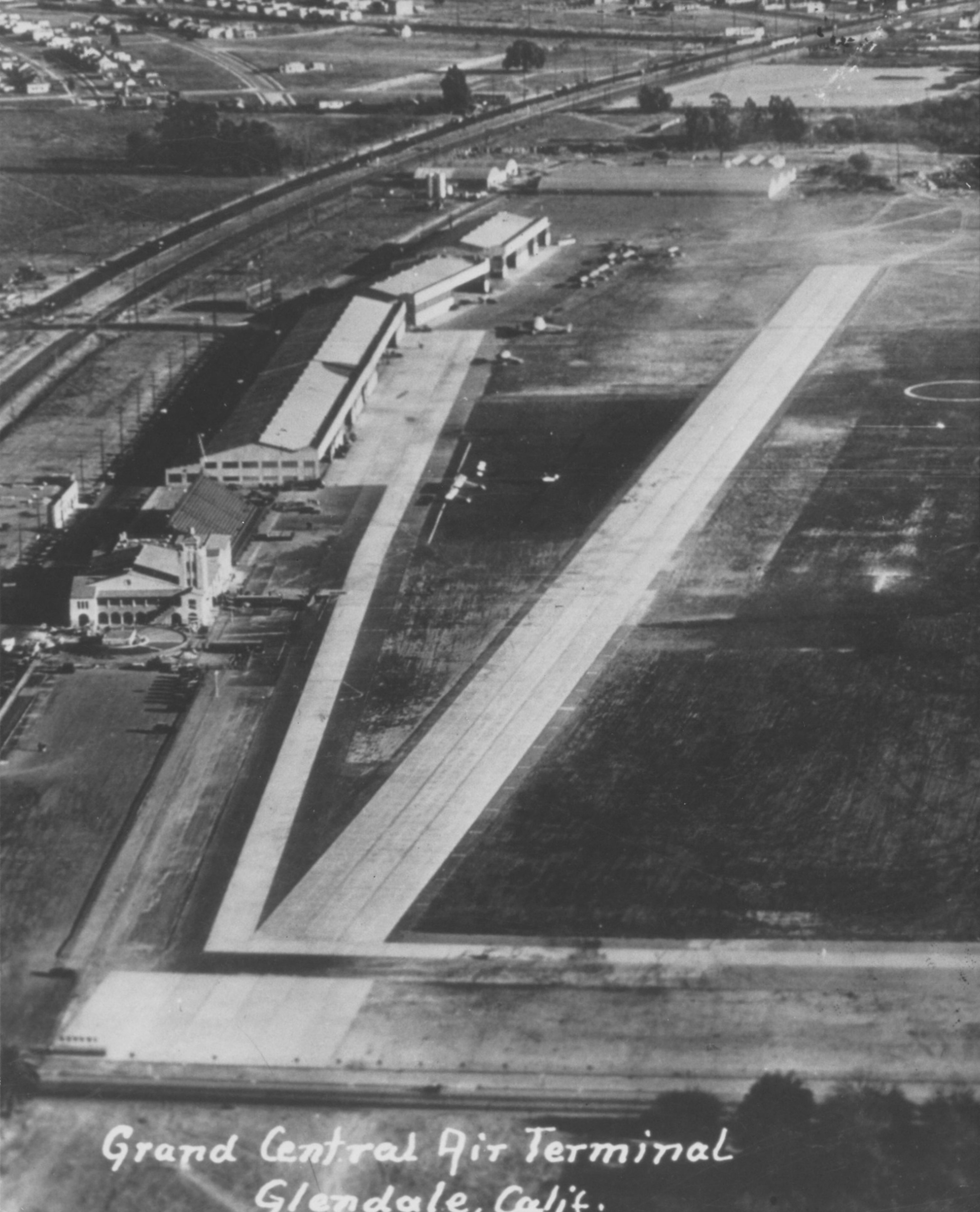 |
|
| (ca. 1930)* - Close-up arial showing Grand Central Aiport and Terminal. |
.jpg) |
|
| (ca. 1930s)^* - Birdseye view of a crowd along the runway at the Grand Central Air Terminal in Glendale. The runway goes from the foreground at right to the background at left. A large crowd of people can be seen around the entire periphery of the runway. It appears that they're waiting to see an air show. |
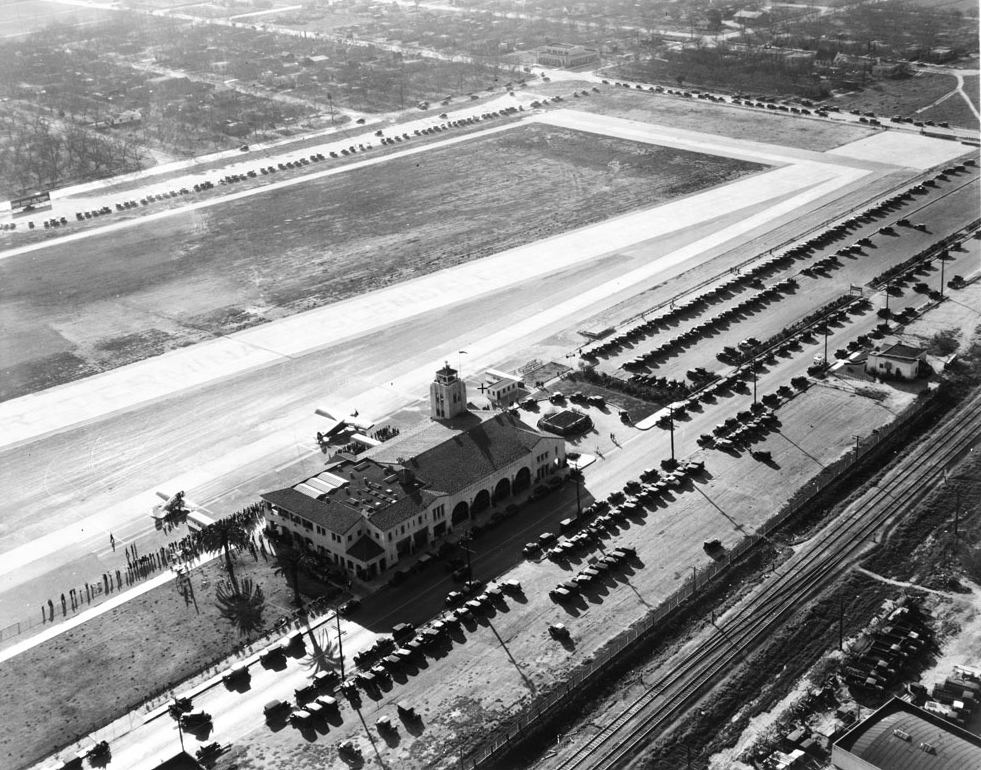 |
|
| (1932)^* - Aerial view of Grand Central Airport in Glendale, February 28, 1932. The terminal is at center and is a large, rectangular, mission-style structure. A tall control tower sticks up from the upper right corner. Two small aircraft are parked directly in front of the terminal, and hundreds of automobiles are parked in a lot behind the terminal. Many people are lined up near the aircraft. The runway is at center and borders a large dirt field. In the distance at left, a neatly arranged neighborhood is visible, while railroad tracks can be seen in the foreground at right. |
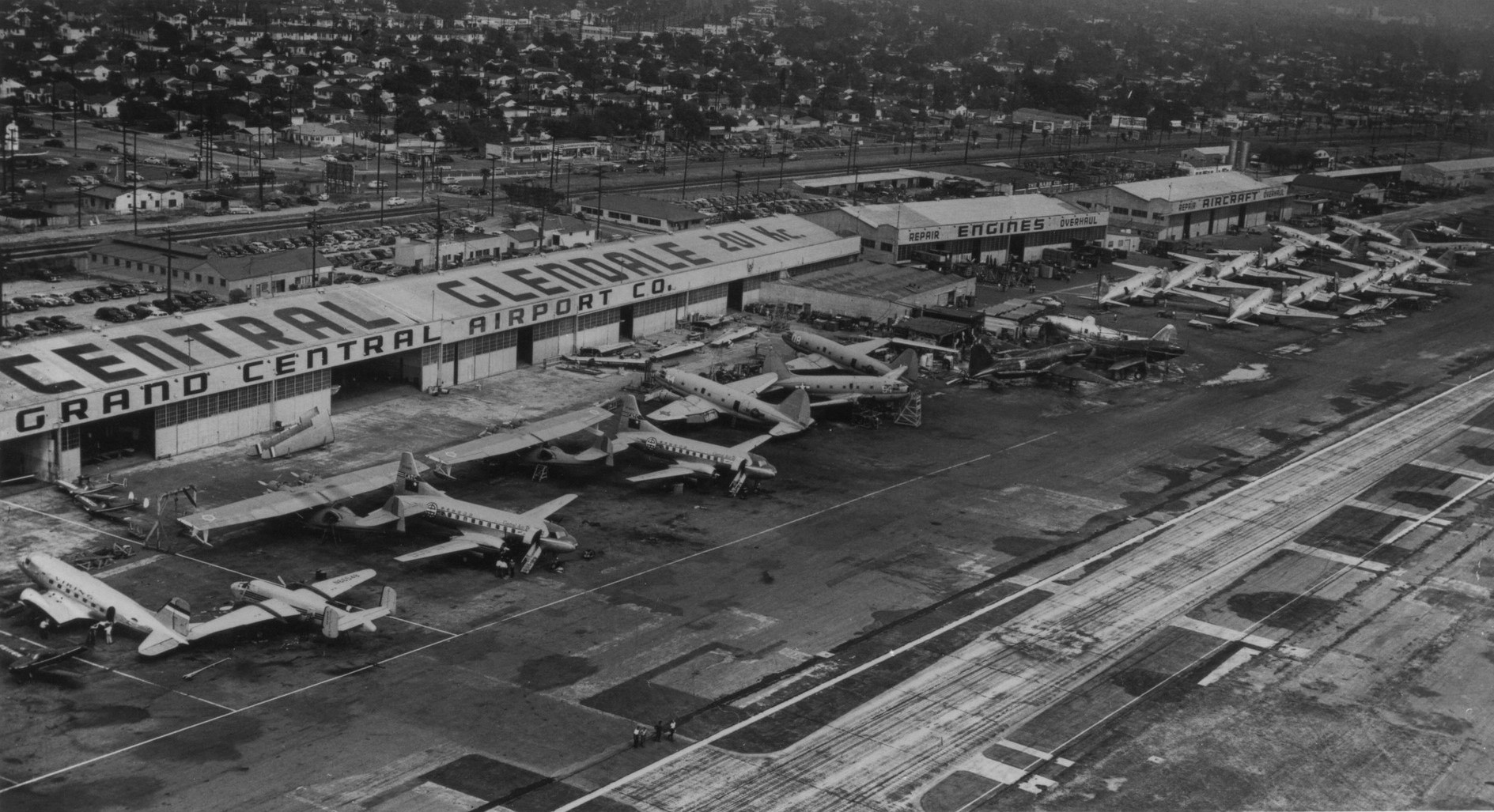 |
|
| (ca. 1940s)* - Glendale Central Air Terminal with passenger planes |
Historical Notes In 1947 the runway was cut back to 3,800' (southeast of Sonora Ave) due to pressure from local government. The airport was returned to private use, renamed Grand Central Airport, ceased to be profitable, and was closed in 1959 to make way for the development of the Grand Central Business Park, which today houses corporate offices of the Walt Disney Company as well as the headquarters for Walt Disney Imagineering. For a number of years the Southwest corner was used as a commercial helicopter base. That space is now occupied by the DreamWorks Animation SKG production company. The city of Glendale retains some interest in aviation, for it is part owner of the Bob Hope Airport (formerly "Burbank-Glendale-Pasadena Airport").*^ |
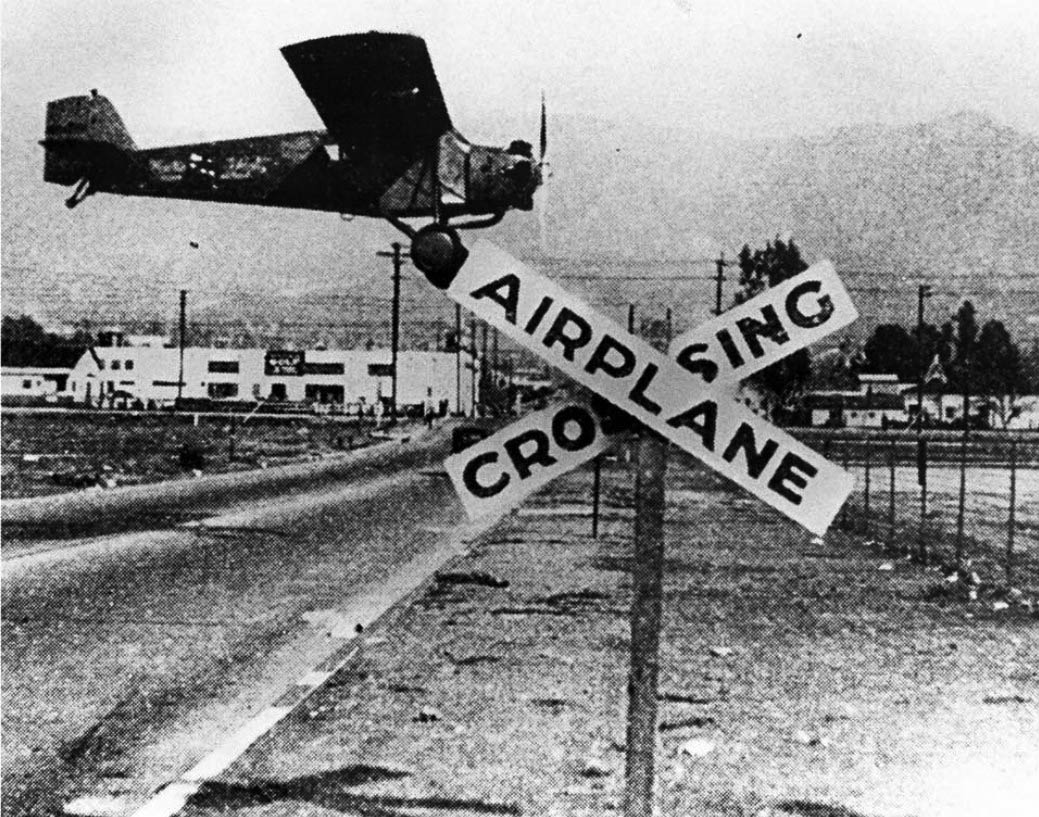 |
|
| (1930)+## - Airplane Crossing sign at Grand Central Airport in Glendale. |
Grand Central Terminal
 |
|
| (ca. 1930)^.^ – Postcard view showing the Administration Building at the Grand Central Airport in Glendale. A small airplane numbered NC-8413 is in front of the building. |
Historical Notes The Grand Central Airport Terminal was designed by Henry L. Gogerty in 1928 blending the Spanish Colonial Revival style with Art Deco influences. The Airport first began its service between Los Angeles and New York, and it played a vital role as the premier airport in Southern California. The building represents the simple concept of early airport terminal design, and it is listed on the Glendale Register of Historic Resources. The airplane shown in this image was a Ford 4-AT Tri-motor owned by the Maddux Air Lines, which carried 12 passengers from San Diego to Los Angeles during its inaugural flight in California.** |
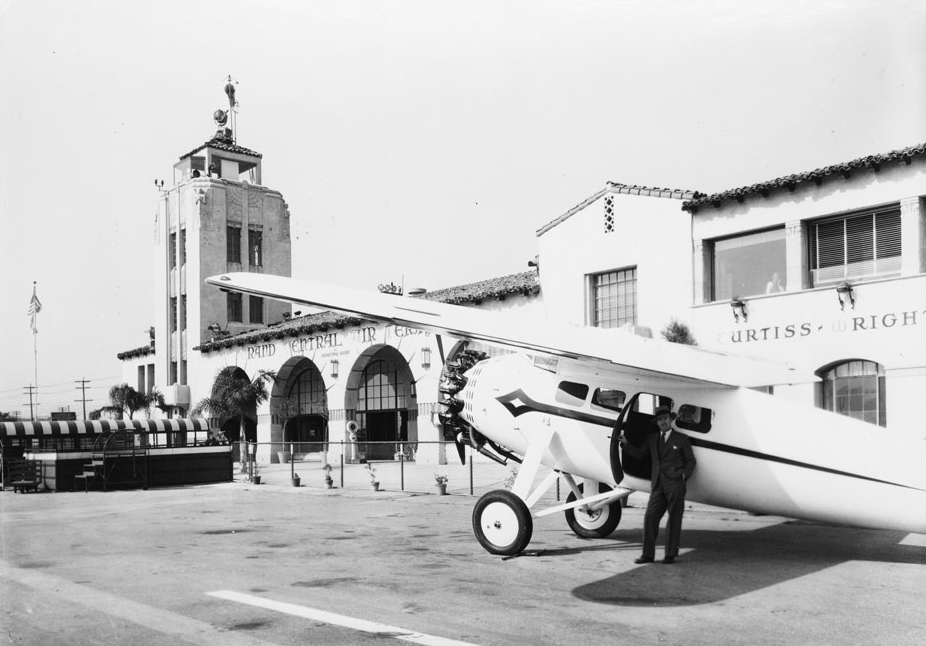 |
|
| (ca. 1930s)^* - Photograph of a radial-engine airplane outside the Grand Central Airport. The high-wing monoplane can be seen in the foreground at right, and a man in a suit is visible near an open door under the wing. The Spanish-style air terminal can be seen in the background. It is a two-story structure with a terracotta tile roof. In the background at left, a tall rectangular control tower is visible. Legible signs include "Grand Central Air Terminal" and "Curtiss-Wright". |
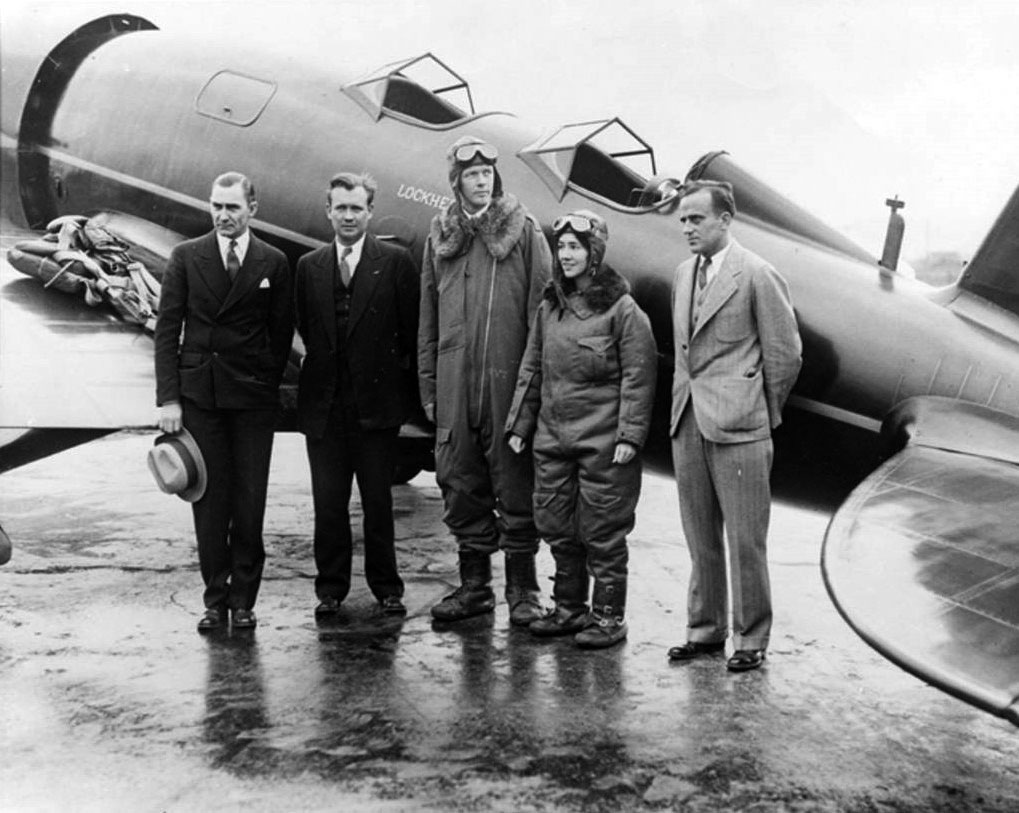 |
|
| (1930)^ – View of Charles A. Lindbergh and his co-pilot/navigator, Anne Lindbergh beside their Sirius, built according to the specifications of Lindbergh, by Lockheed. |
Historical Notes On Easter, 1930, Colonel Lindbergh and his wife, Anne, took off from Glendale (Calif.), bundled up in their bulky, electrically heated flying suits, to test the advantages of weather at high altitudes, and to set new transcontinental records. The sliding canopies, covering both formerly open cockpits, were suggested by Mrs. Lindbergh, who set a women's record for coast to coast flights on this first Lockheed Sirius. The sliding canopies were later put into common use. While the ship was being built, Lindbergh, shy of publicity, was secluded from hero-worshippers in the Hamilton Propeller Shop at the Burbank Field. He seemed happy and relaxed working quietly along with the mechanics. Some who were there have left stories of their admiration for this warm, friendly man, a perfectionist, interested in everything concerning his plane. They fondly told how he politely by-passed invitations from Very Important People, and went to lunch day after day with the crew. On occasions, Mrs. Lindbergh waited for her husband to finish his work in their car, parked in the shade of the hangar. The working crew would bring her sandwiches and cold drinks from the lunchroom nearby. The photograph was probably taken in Glendale, but it is a Lockheed plane, made in Burbank.^ |
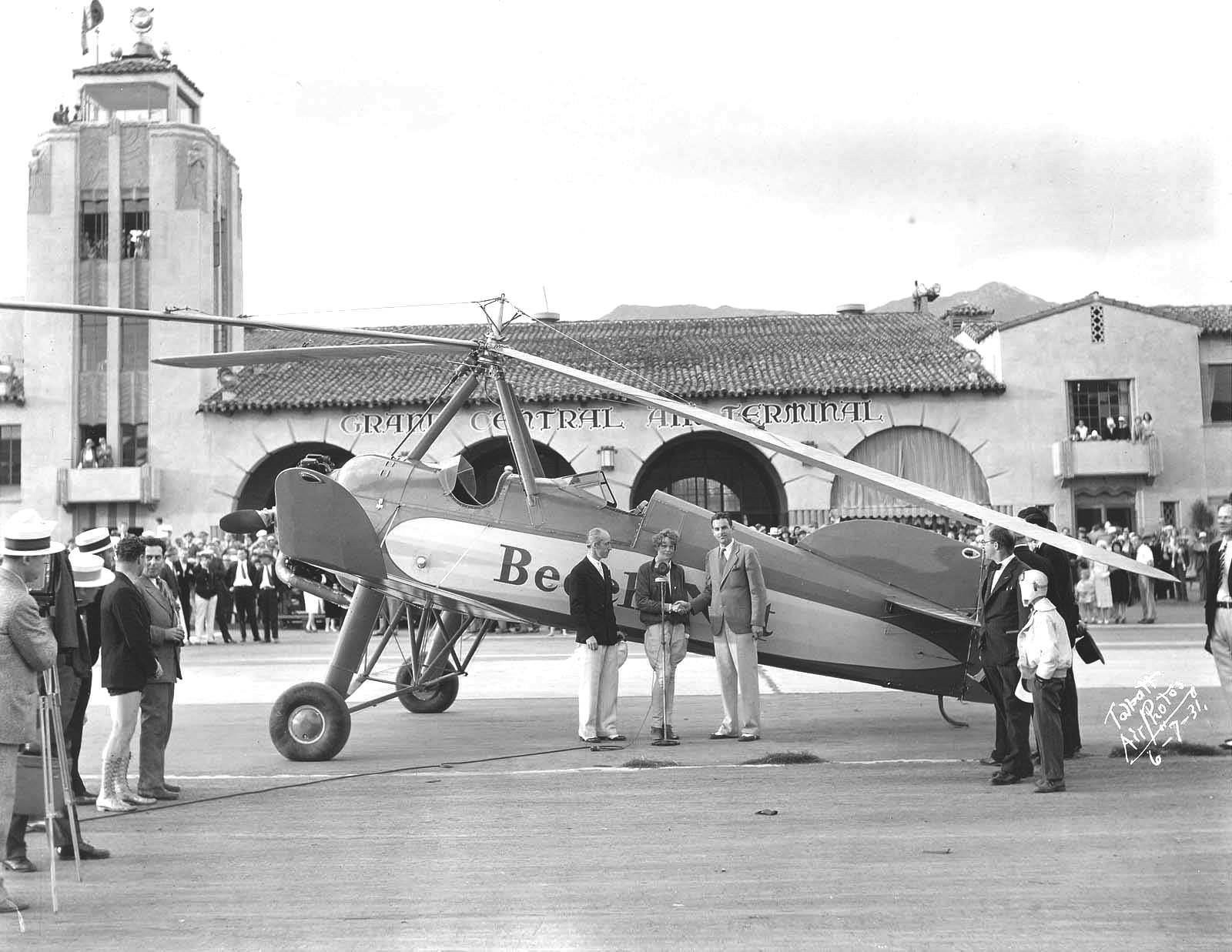 |
|
| (1931)** - Amelia Earhart with the Beech-Nut Pitcairn PCA-2 Autogiro at Glendale Grand Central Air Terminal on June 7, 1931. Earhart arrived from PA on what she thought was the first transcontinental Autogiro flight only to discover that John M. "Johnny" Miller had beaten her by 9 days. |
Historical Notes The PCA-2 was the first rotary-wing aircraft to achieve type certification in the United States and was used in a number of high-profile activities including a landing on the White House lawn and the first flight across the United States in a rotorcraft. This latter feat was attempted by Amelia Earhart, flying for the Beech-Nut food company, but was actually accomplished by John M Miller who completed his flight nine days before Earhart on 28 May 1931, in his PCA-2 named Missing Link. Learning of Miller's achievement upon her arrival in California, Earhart set out to turn her flight into a round-trip record by flying east again, but abandoned the attempt after three crashes. Earhart set an altitude record in a PCA-2 on 8 April 1931 with a height of 18,415 ft. This record was broken in another PCA-2 by Lewis Yancey who flew to 21,500 ft on 25 September 1932. ^ |
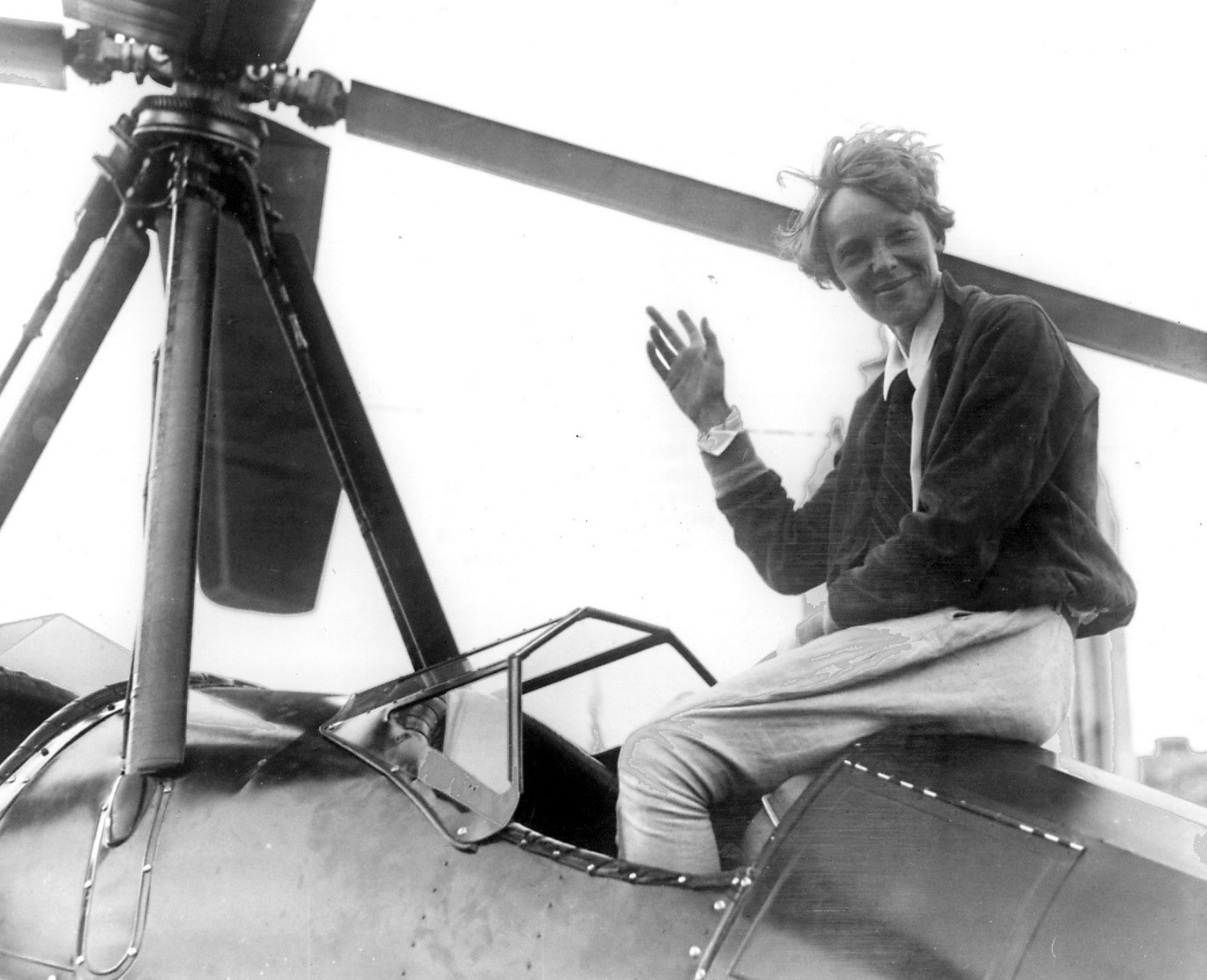 |
|
| (1931)+## - Amelia Earhart is seen sitting on plane mounted with a horizontal propeller (Pitcairn PCA-2 Autogiro) at Grand Central Airport. |
Historical Notes Amelia Earhart became famous when she was the first female aviator to fly solo across the Atlantic Ocean in 1928, so it was newsworthy when she landed an autogiro (which is kind of like a helicopter) at Grand Central Air Terminal, Glendale on June 7, 1931. At the time she was attempting the first transcontinental autogiro flight from Newark, NJ to Los Angeles, and landed at about 5 p.m. to replenish her gas supply. At the time, Grand Central was a busy and important airport, and due to its eye-pleasing design and proximity to the movie studios, was often used in the movies. |
 |
|
| (ca. 1931)^*# - Plane being refueled by a tank truck labeled Union Motor Oil, at Grand Central Airport. |
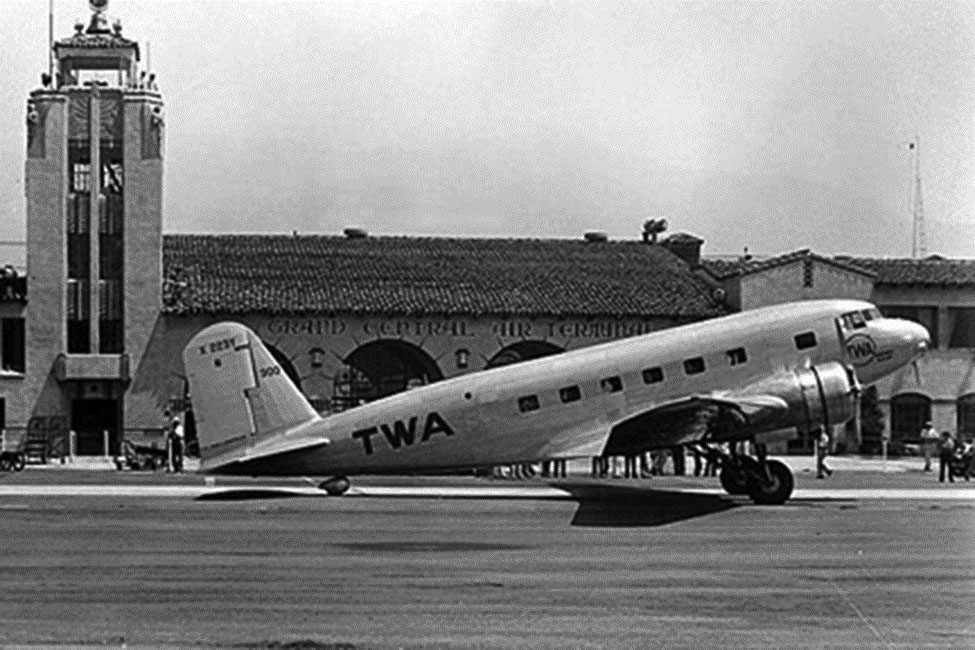 |
|
| (1933)^.^ – View showing the 12-passenger DC-1, Douglas Commercial Model No. 1, at Grand Central Air Terminal. |
Historical Notes The DC-1 was specifically designed for TWA. Its inaugural flight was on July 1, 1933, but it was nearly the last when both engines quit during the climb out. After modifications, the new plane met all of TWA’s requirements, most importantly of which was to be able to fly with only one of the two engines. TWA placed an immediate order for 25 Douglas airliners, but with more refinements as the DC-2. |
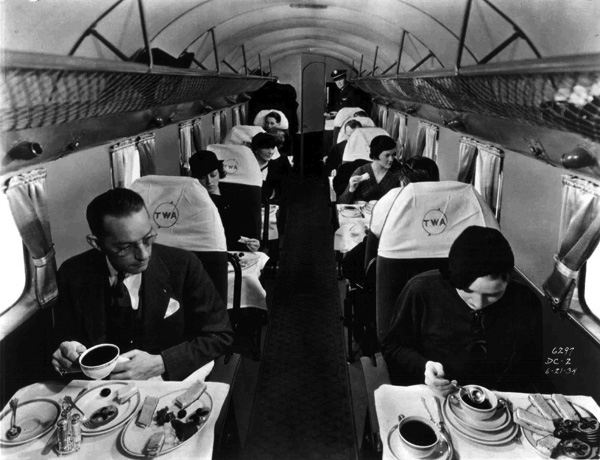 |
|
| (1933)* – View showing showing passengers dining in a TWA DC-2, (refined DC-1). |
Historical Notes The DC-2 was increased in size with a wider diameter fuselage to allow for the taller passengers to stand in the cabin. Its length was increased by two feet to allow for an extra row of seats that increased total seating to 14. There were other improvements as well. The payload was increased, the service ceiling was increased, the speed was increased and even in-flight movies were introduced. The DC-2 was now the most luxurious airliner in the world. Only four months after the Model 247 entered service, the first DC-2 was handed over to TWA. It flew in record time between Los Angeles and New York. TWA advertised Coast-to-Coast service in a 200 mph luxury airliner called the Sky Chief. Transcontinental flights consisted of four legs from New York (Newark) to Chicago, Kansas City, Albuquerque and Los Angeles. Flights left at 4:00 p.m. and arrived at 7:00 a.m. the next day. |
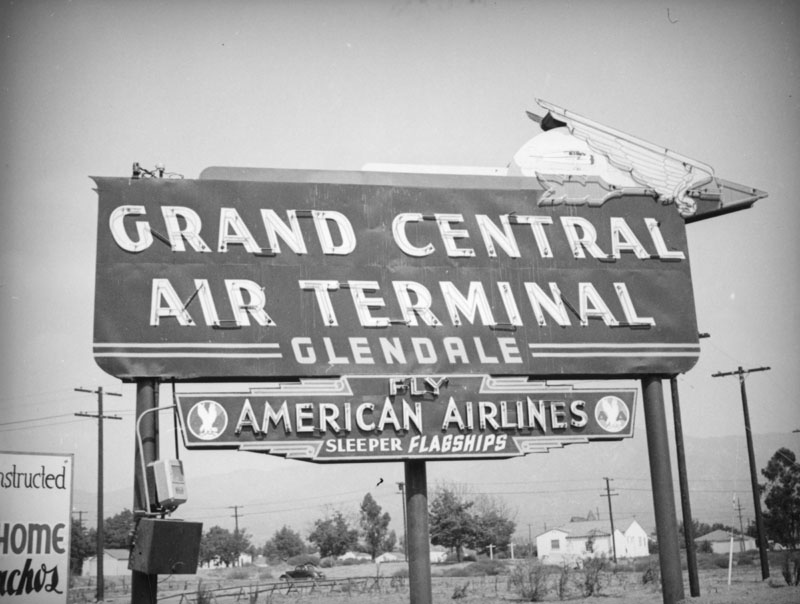 |
|
| (ca. 1937)* - A wing and arrow top this neon sign for the Grand Central Air Terminal, located at 1310 Air Way in Glendale. A smaller sign hangs below encouraging one to fly the American Airlines Sleeper Flagships. A log fence and telephone lines separate the neighboring Spanish style ranch houses from the field surrounding the sign. A painted sign advertising the new development of "Ranchos" is cut off in the foreground. |
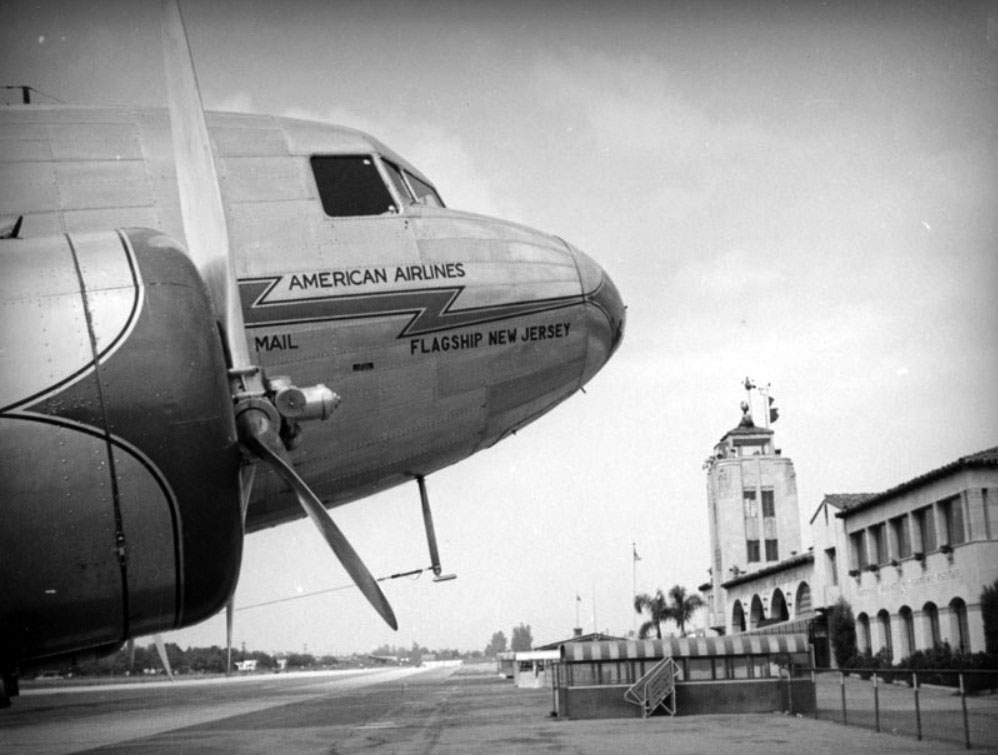 |
|
| (1937)* - View of an American Airlines DST (Douglas Sleeper Transport - an early version of a DC-3) prop plane carrying mail on the landing at the Grand Central Air Terminal, located at 1310 Air Way in Glendale. |
Historical Notes The Grand Central Air Terminal was designed by Henry L. Gogerty in 1928 in the Spanish Colonial Revival style with zig-zag moderne elements. The terminal is a City of Glendale registered landmark.* |
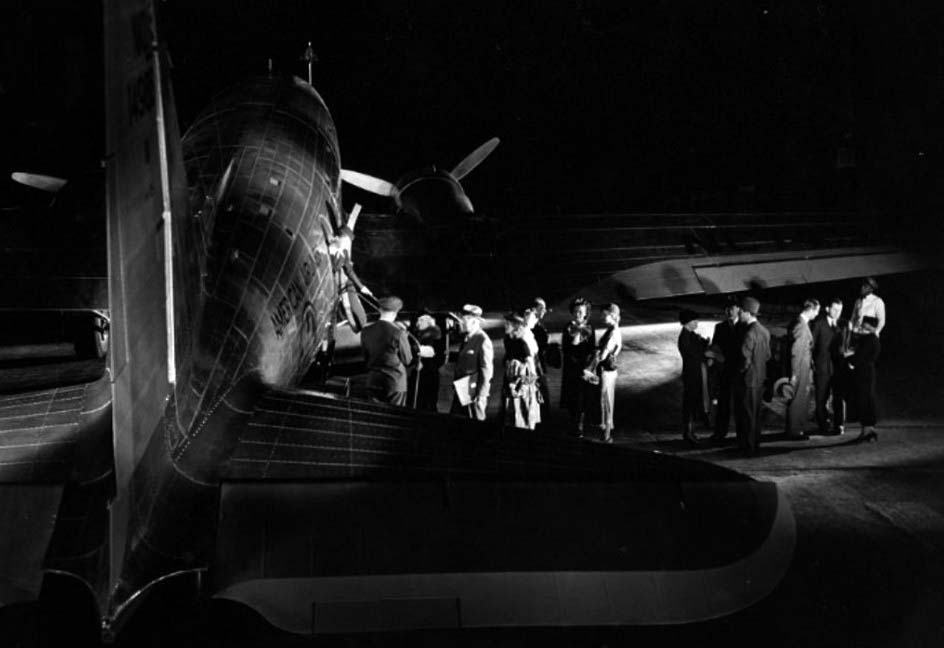 |
|
| (ca. 1940)#^ - Night departure of a DC-3, Grand Central Air Terminal, Glendale. Hagley Digital Archives |
Historical Notes The DC-3 was a twin-engine metal monoplane, developed as a larger, improved 14 bed sleeper version of the Douglas DC-2. It had many exceptional qualities compared to previous aircraft. It was fast, had a good range and could operate from short runways. Its construction was all-metal. It was reliable, easy to maintain and carried passengers in greater comfort. Before the war it pioneered many air travel routes. It was able to cross the continental United States, making transcontinental flights and worldwide flights possible, and is considered to be the first airliner that could make money by carrying passengers alone.*^ |
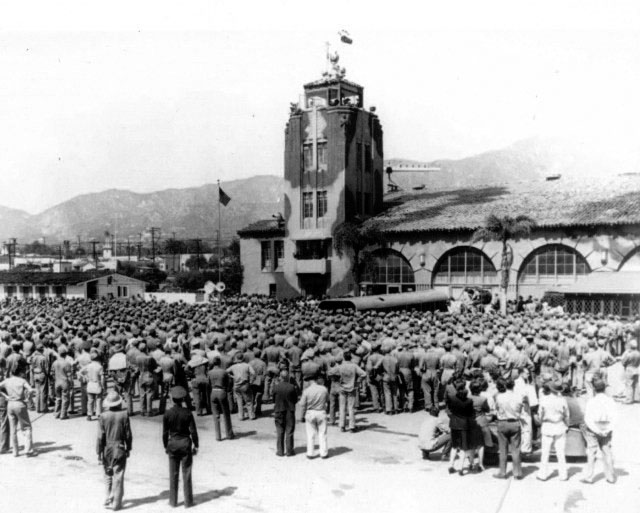 |
|
| (1942)^.^ – View showing hundreds of recruits gathered to hear Air Marshall W. A. Bishop speak in front of the Grand Central Air Terminal during WWII. Note that the tower has already been painted with camouflage. |
Historical Notes When Pearl Harbor was attacked on December 7, 1941, Grand Central Airport (like all other west coast airports) was immediately closed to private aviation. (The remaining airlines had already moved to Burbank.) The government moved in, heavily camouflaged the place, and converted it into an important defense base for Los Angeles. In 1942 the runway, which originally ended at Sonora Avenue, was extended North to Western Avenue, giving it a 5,000' length to accommodate large airplanes and future jet aircraft. After the war, geographic constraints hindered the airport’s ability to accommodate new—and larger—commercial aircraft. |
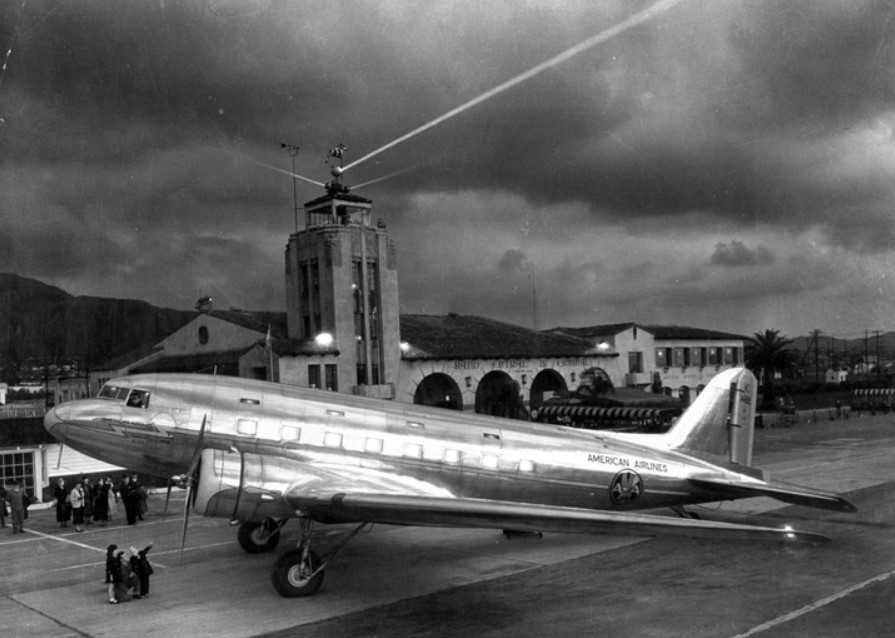 |
|
| (1940s)^*^ - A shining DC-3 parked in front of the Grand Central Airport terminal as night falls. |
Historical Notes In 1947 the runway was cut back to 3,800' (southeast of Sonora Ave) due to pressure from local government. The airport was returned to private use, renamed Grand Central Airport, ceased to be profitable, and would eventually be closed in 1959. The closed airport was then used as a private heliport for the Los Angeles Police Department's fleet of police helicopters, some Bell 47's ("recips") and some Bell 206's ("Jet Rangers"), until the hew LAPD Hooper Heliport opened on top of the Piper Tech Building in downtown Los Angeles in 1983. The runways were torn out and replaced by a street named Grand Central Avenue. Over 70 new “tilt up” manufacturing buildings were constructed under the direction of the Grand Central Industrial Centre. The redeveloped airport property was eventually purchased by the Prudential Insurance Company and leased out as an investment. When Walt Disney was developing Disneyland in the early 1950s, he wanted a place away from the main studio where he could work on new ideas undisturbed. He rented an industrial building at 1401 Flower St. on the old airport property. WED (Walter E. Disney) Enterprises also rented the old terminal building during the busy years of Epcot and Disney World development. Dreamworks was created in 1994, and their new buildings soon appeared on part of the old airport land just down the street from Disney’s leased building. The Disney Corporation soon purchased the remaining land from the airport and have announced a 15-year plan to turn it into a corporate “creative campus” behind security gates. Disney has stated their intention to rework the old terminal by the year 2015 to its original look. Much of the original metal work, railings and lights have been stripped away over the years, but the Disney representative feels that their company can easily reproduce replacement pieces. There are also two original hangars left—one very modified into a cold storage facility and the other is now used by Disney Imagineering for special effects mock-ups.+## |
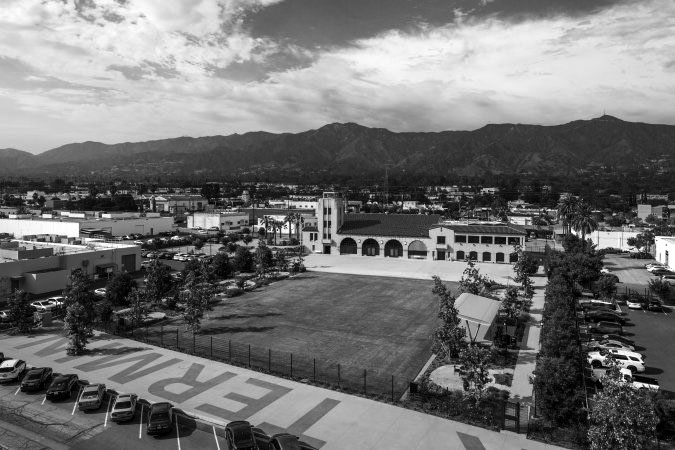 |
|
| (2017)^ - View showing the Grand Central Air Terminal as it appears today. Photo by Paul Turang, Los Angeles Conservancy |
Historical Notes The Grand Central Air Terminal remained untouched until 2012, when its current owner embarked on a project to transform the airport for new uses. The project team rehabilitated the entire property, including the airport concourse, runway, and taxiway. They completely restored the building’s exterior and significant interior spaces. The team thoroughly researched and meticulously restored, or recreated, missing or degraded character-defining features, such as light fixtures and decorative tile.* |
* * * * * |
Glendale Southern Pacific Railroad Depot (today Glendale Amtrak/Metrolink Station)
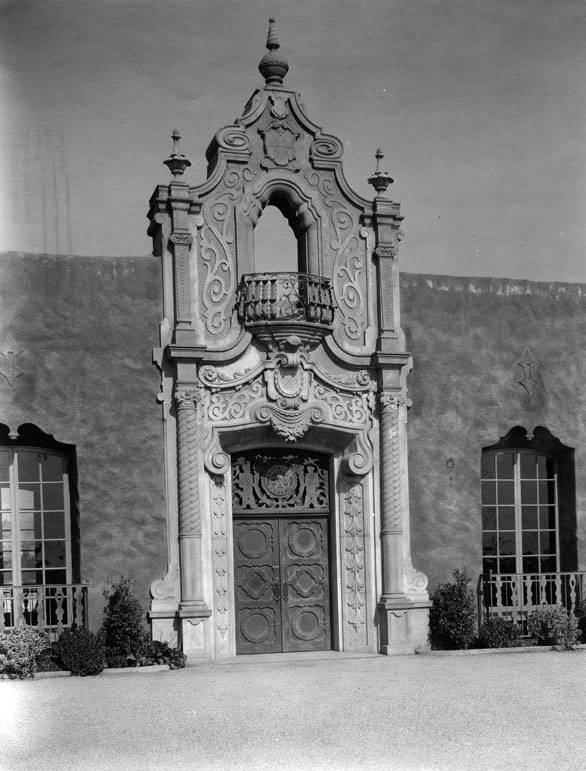 |
|
| (ca. 1923)^*# - Close-up view of the Mission Revival Style entrance to the Glendale Train Station. Beautiful wrought iron grills, railings, lanterns and magnificent Churrigueresque cast stone entry portals guarded by fanciful mermen figures hold up the railroad's herald above each waiting room door. |
Historical Notes The Glendale Southern Pacific Railroad Depot (now known as Glendale Amtrak/Metrolink Station) was designed in the Mission Revival Style by architects Maurice Couchot and Kenneth MacDonald, Jr. and built by the Southern Pacific Railroad in 1923; replacing an older one that dated as far back as 1883.^ |
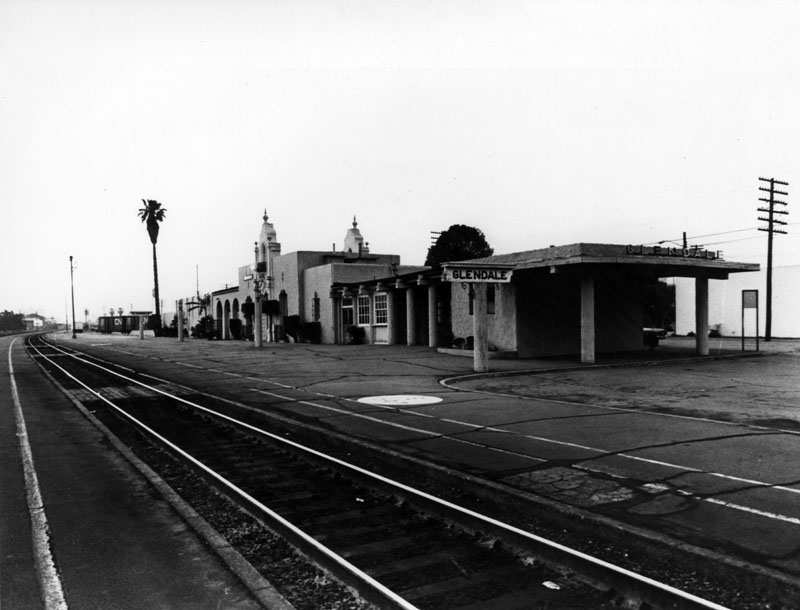 |
|
| (ca. 1940s)^ - Exterior view of the surprisingly empty railroad station at Glendale. This is the "back" portion of the station, where travelers wait for their trains to arrive and/or depart. Two stationary freight cars can be seen at the rear of the building. |
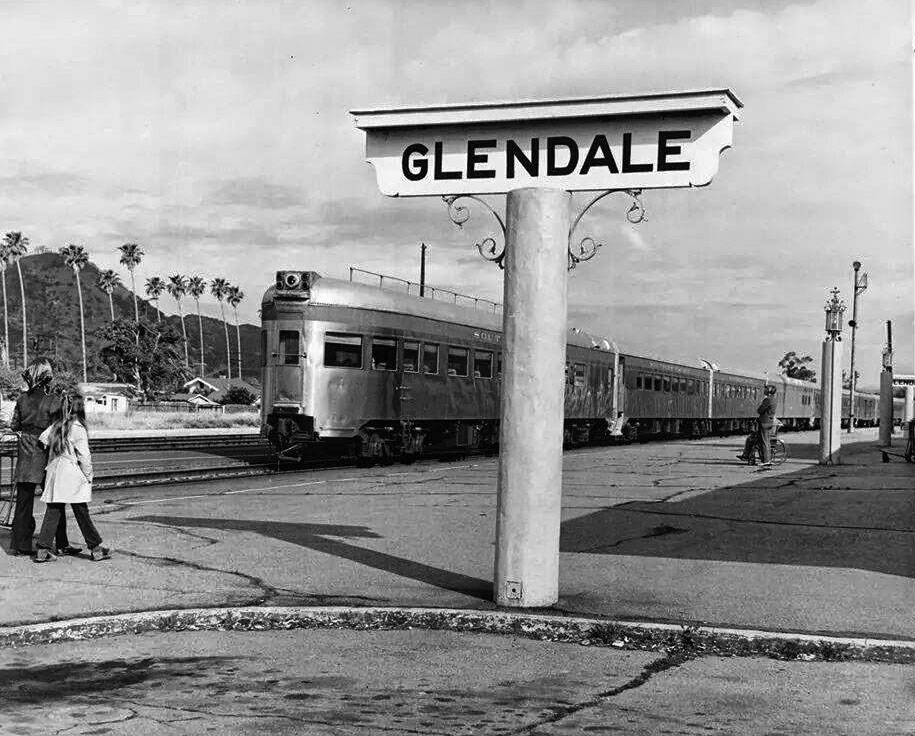 |
|
| (n.d.)^ – A woman and a young girl walk toward a stopped train at the Glendale Southern Pacific Railroad Depot with palm trees seen in the background. |
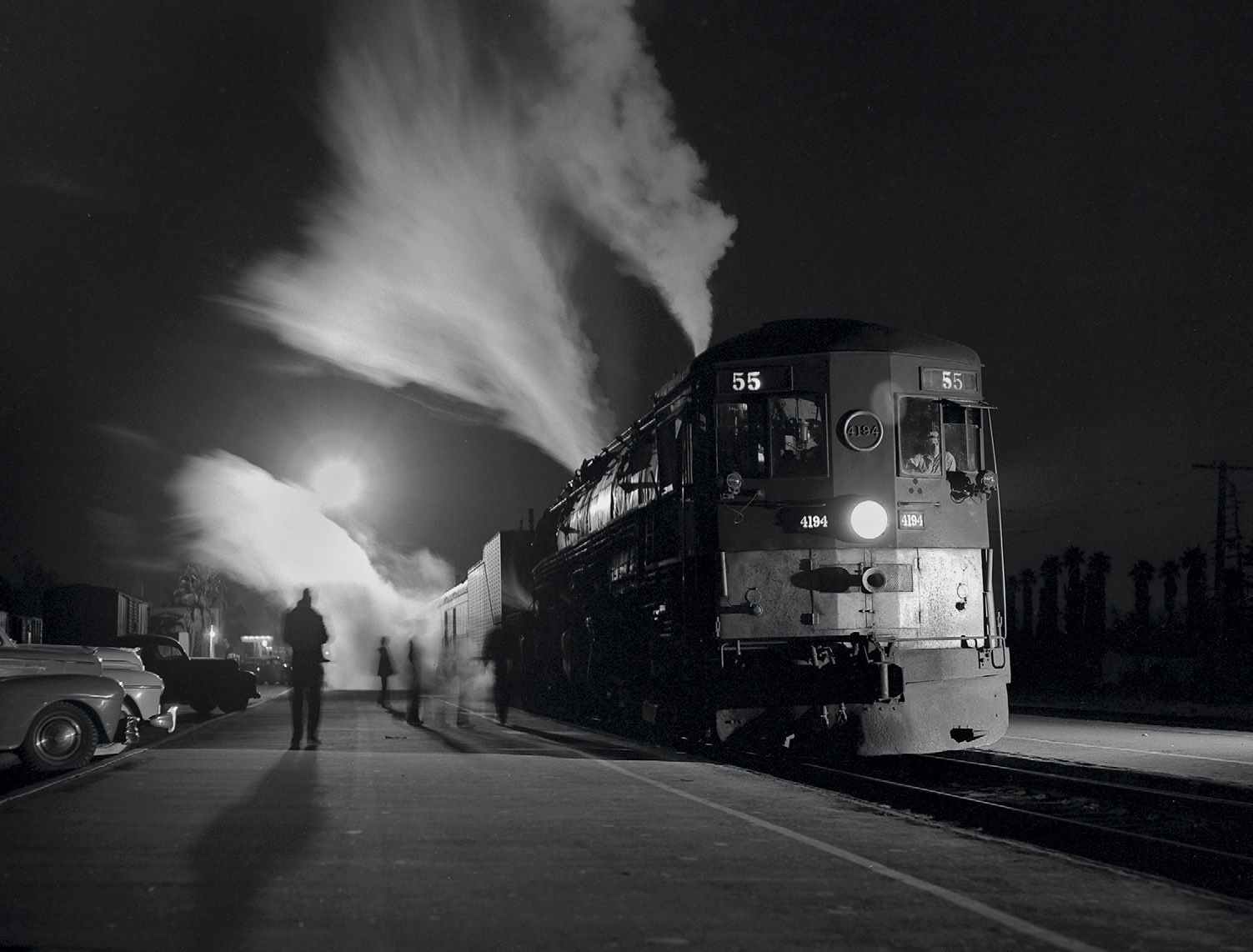 |
|
| (ca. 1950)^^^ - Southern Pacific #4194 ‘Tehachapi’ Night Train 55 at the Glendale Station. Photo by Richard Steinheimer. |
Historical Notes Because of the depot's proximity to the film industry in Los Angeles and Hollywood, many movies have been shot there. In the 1930s Buster Keaton filmed "College" at depot, "Horse Shoes" was another. The most well know film with the depot as a background was by director Billy Wilder, "Double Indemnity" in 1944 starring Fred MacMurray and Barbara Stanwyck.* |
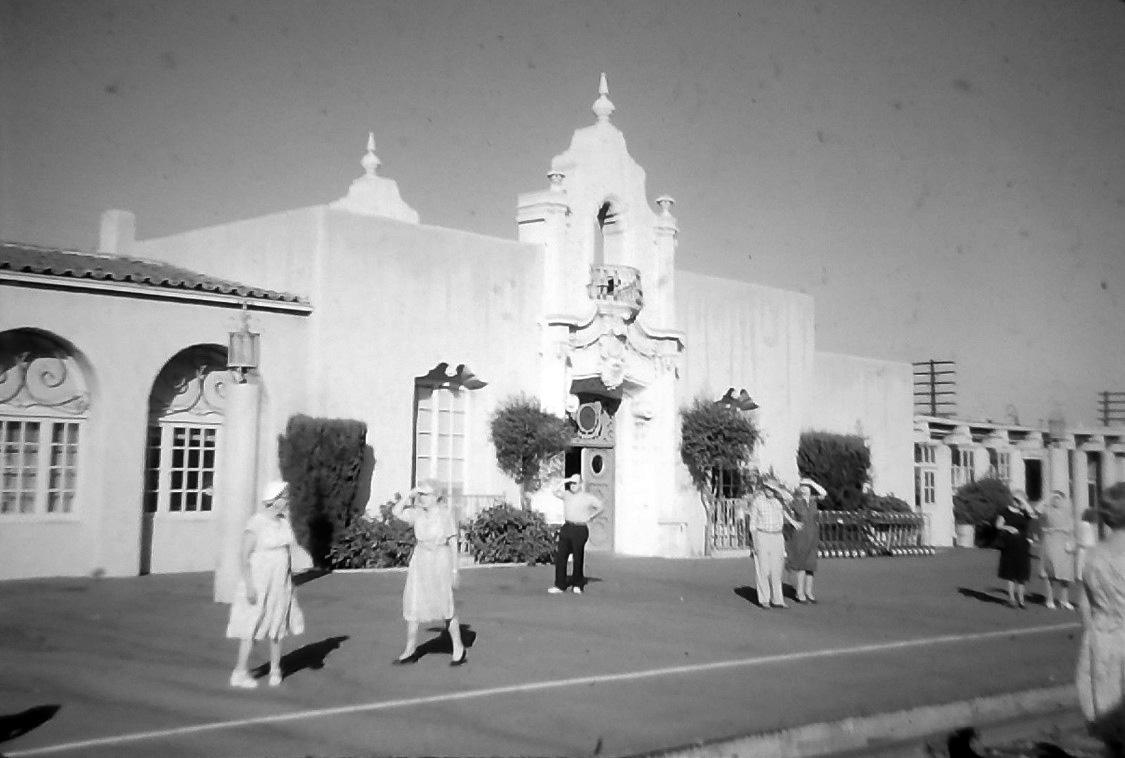 |
|
| (1962)^ – Passengers shield their eyes from a bright sun as they await an incoming train. |
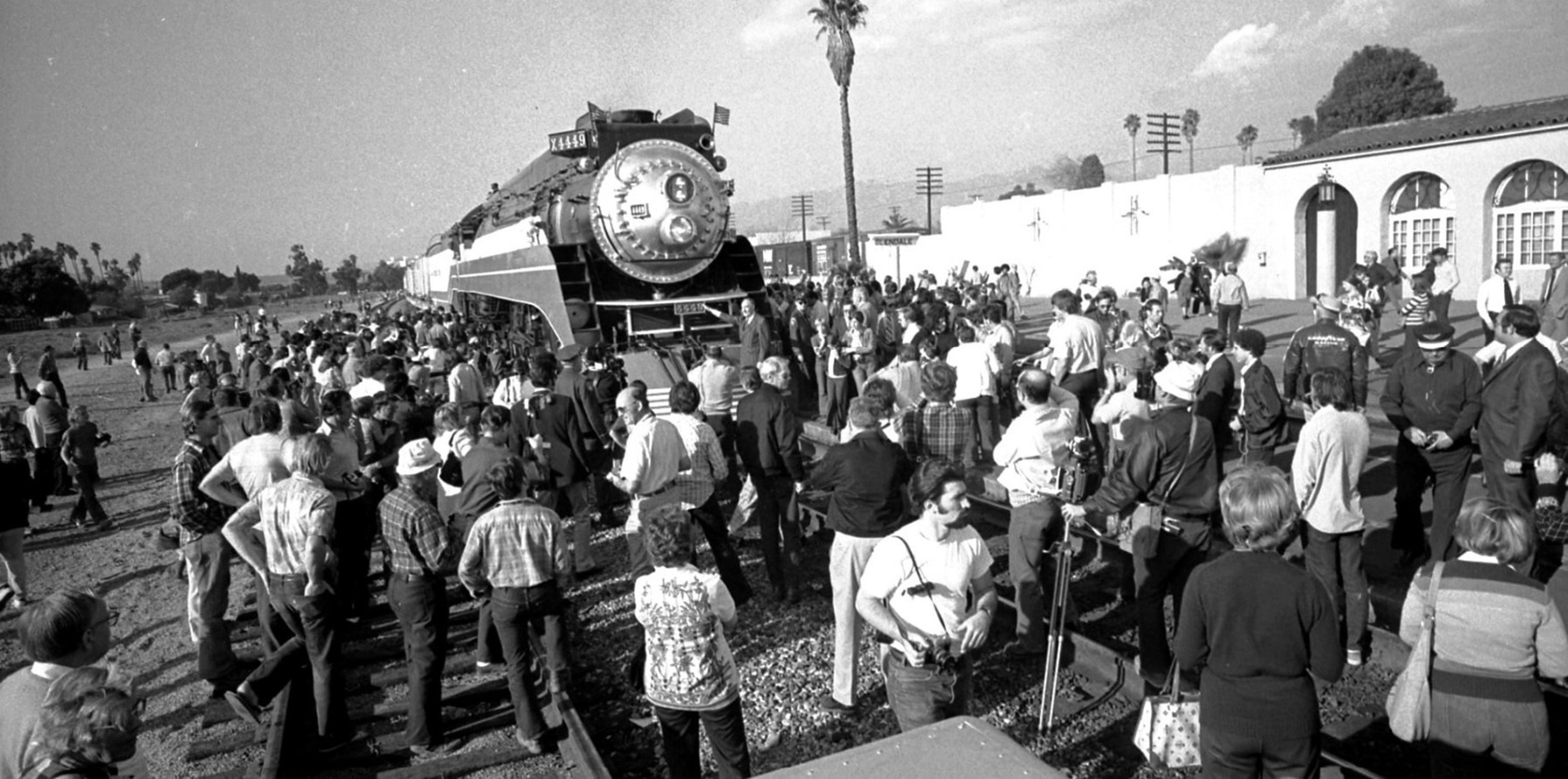 |
|
| (1975)* - The Freedom Train arrives in Glendale. Photo by Bill Varie for the LA Times, December 23, 1975. |
Historical Notes The Freedom Train toured the country in 1975–76 to commemorate the United States Bicentennial. This 26-car train was powered by three newly restored steam locomotives. The first to pull the train was the former Reading Company T-1 class 4-8-4 #2101. The second was the former Southern Pacific 4449, a large 4-8-4 steam locomotive that is still operating in special excursion service today. The tour covered all 48 contiguous states and lasted from April 1, 1975, until December 31, 1976. More than 7 million Americans visited the train during its tour, while millions more stood trackside to see it go by.^ |
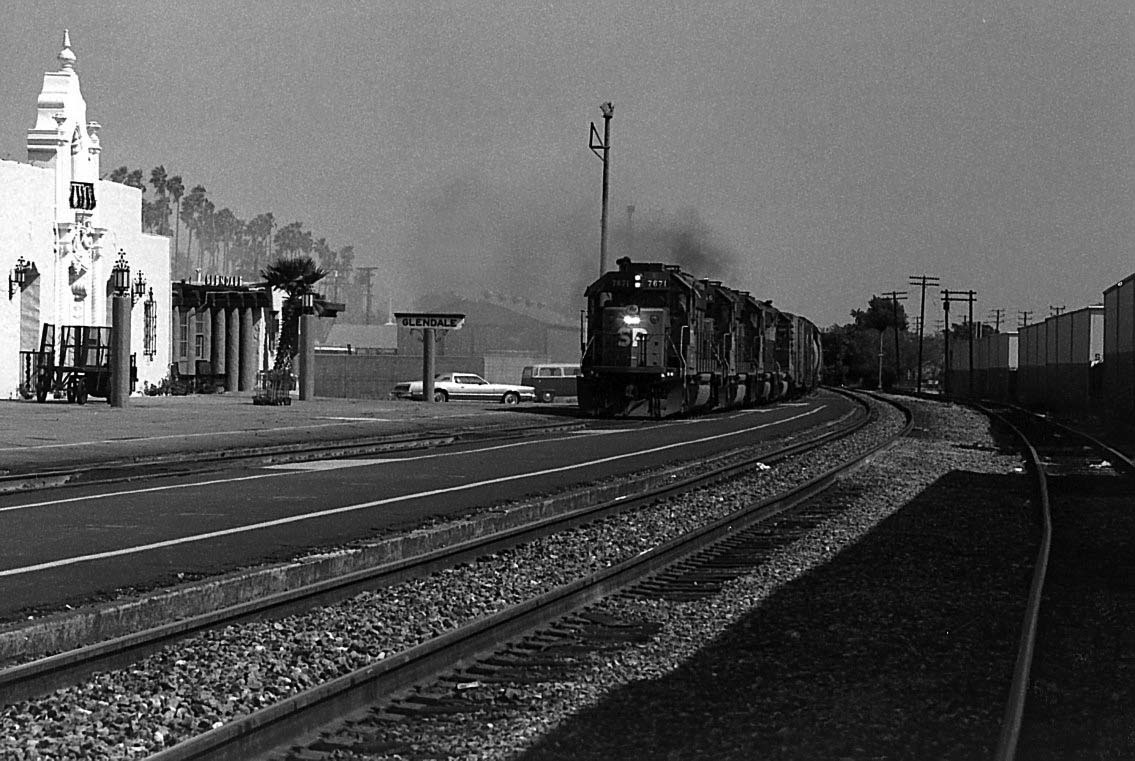 |
|
| (ca. 1980s)*** – View showing a train coming into the Glendale Southern Pacific Railroad Depot. |
Historical Notes The depot has undergone minor remodels in 1943, 1954 and restored in 1999 and 2012. In 2015, the unstaffed depot served 10 Pacific Surfliners, 54 Metrolinks trains weekdays, and 12 Antelope Valley Line trains Weekends and was the 37th busiest Amtrak station in the state with 100 passengers daily*. |
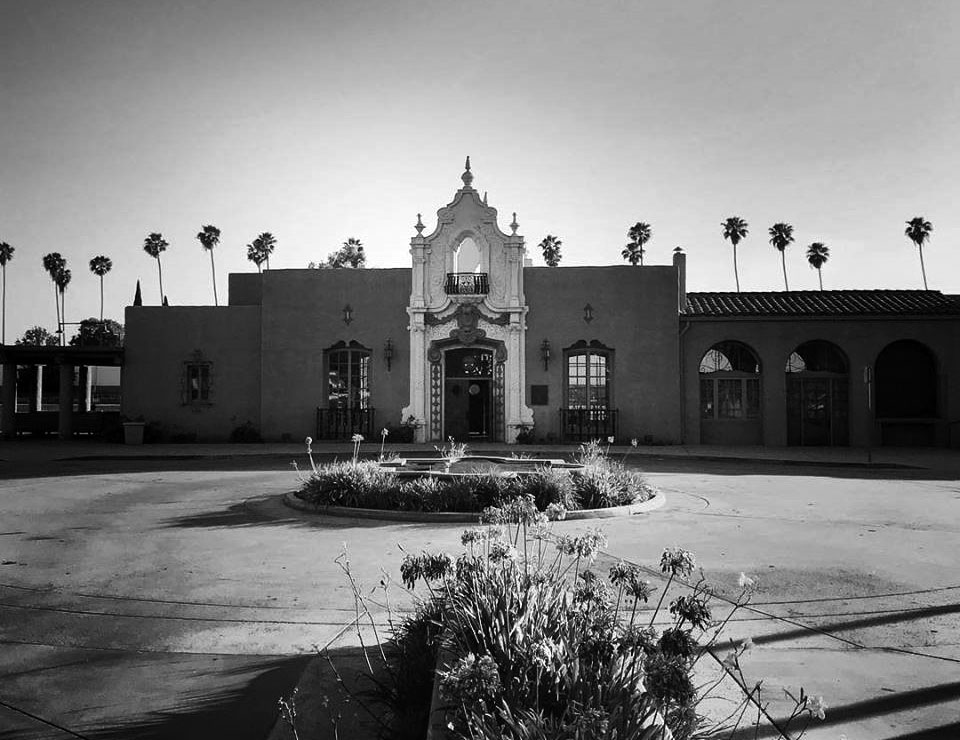 |
|
| (2018)^ – View showing the Glendale Southern Pacific Railroad Depot (today Glendale Amtrak/Metrolink Station) as it appears today. Photo courtesy of Shawn Morales |
Historical Notes The City of Glendale bought the depot from Southern Pacific in 1989 and acquired adjacent properties to create an intermodal center. Restoration of the historic building and the construction of other elements of the intermodal center cost approximately $6 million.^ |
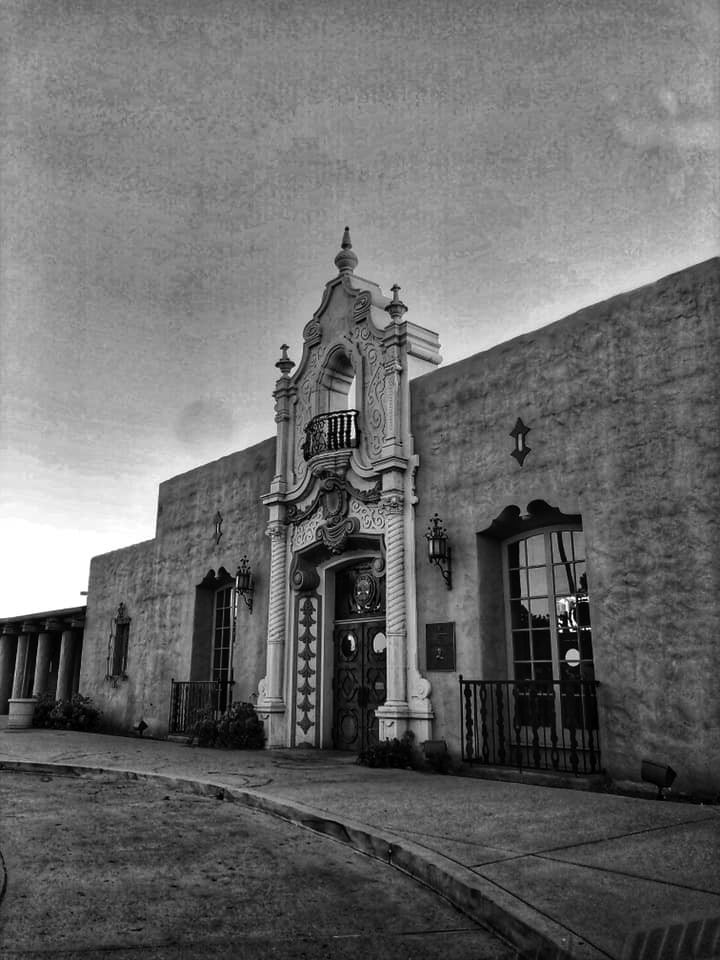 |
|
| (2020)^ – Close-up view of the Mission Revival Style entrance to the Glendale Amtrak/Metrolink Station. Photo by Carlos G. Lucero |
Historical Notes The depot (now known as Glendale Amtrak/Metrolink Station) was added to the National Register of Historic Places on May 2, 1997 - #97000376, and has undergone an extensive renovation since then. The Glendale train station is located at 400 Cerritos Avenue.^ |
Slate Dirigible (Glendale Airport)
 |
|
| (1929)+## – Large crowd surrounds a Slate Dirigible which has just landed at Glendale Airport. |
Historical Notes In 1925, Thomas Slate leased space adjacent to the south side of the Glendale Airport for the construction of an all-metal dirigible, a very novel (but ultimately unsuccessful) design. The dirigible was made out of duralumin & was filled with hydrogen. It was forecast to have a cruising speed of 80 mph and would accommodate 40 passengers and 5 crew. The dirigible was to be powered by oil and driven by steam-turbine, using one rotary blower, which would create a vacuum, instead of traditional propellers. Slate also constructed a metal hangar, the largest built in the United States at the time.* |
 |
|
| (1928)^.^ - The Slate Dirigible is docked in its hanagar at Glendale Airport. At the time, this was the largest built metal hangar in the United States. |
Verdugo Wash
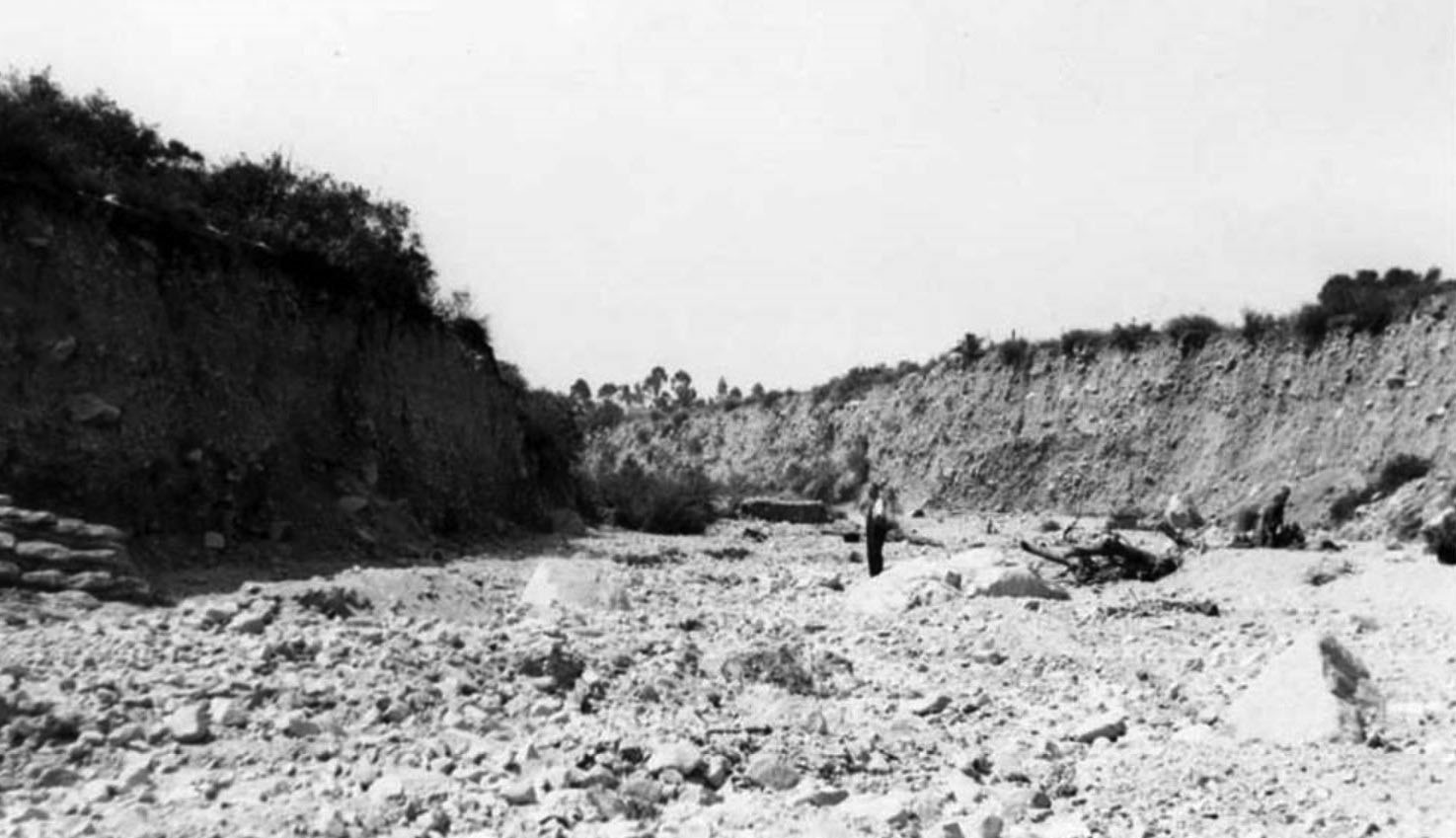 |
|
| (1934)##^ - A man is seen standing in the Verdugo Wash after the 1934 flood. |
Historical Notes The most severe flood recorded in Glendale occurred in 1934. Intense precipitation on New Year’s Eve, 1933 occurred locally in the La Canada Flintridge area, causing the Verdugo Wash to swell and overflow its then natural channel. Extensive areas of the drainage basin had burned earlier, in November 1933, causing large amounts of debris. The debris was carried by the storm waters down the mountains, and into the alluvial valleys, where several roads were choked. Damage was not confined to Verdugo Wash, but extended to several of the canyons draining the eastern and southern flanks of the Verdugo Mountains, and also in Sycamore and Scholl Canyons. Several people died, several bridges were washed out, and erosion and sedimentation damaged property.^ |
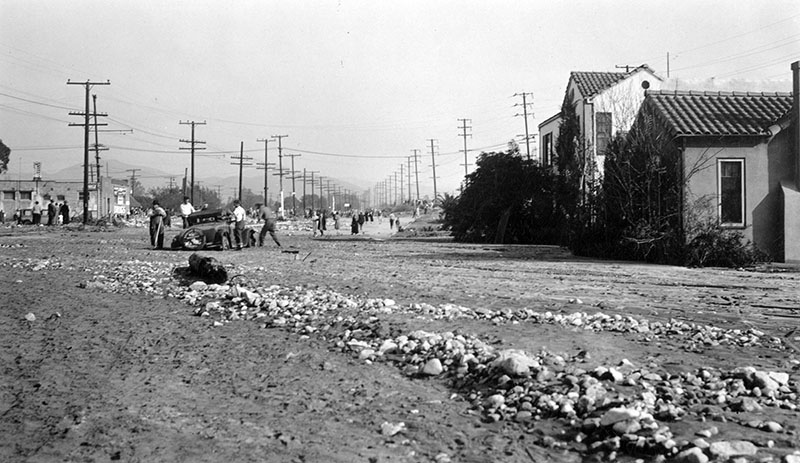 |
|
| (1934)^ - An unidentified and mud-covered street in Glendale, captured after the flood of January 1, 1934. Men look at a severely damaged car, not far from homes (right), while other people are seen assessing other damage further down the street. |
Historical Notes Wildfires above the Crescenta Valley in November 1933 and subsequent heavy rain in December 1933 produced the perfect conditions for a massive flood. Just after midnight on January 1, 1934, millions of tons of mud and debris traveled from the mountains down to the Verdugo Wash, killing many people and destroying about 400 homes in the communities of La Cañada, La Crescenta, Montrose and Tujunga. Woody Guthrie's song, "Los Angeles New Year's Flood," commemorates the natural disaster.* |
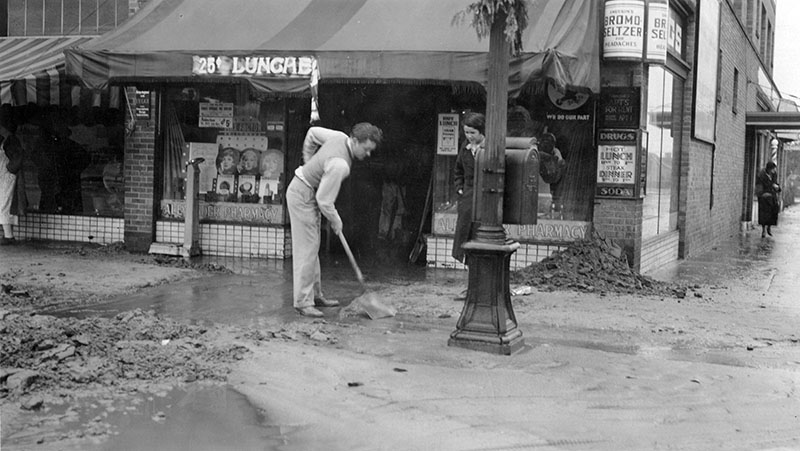 |
|
| (1934)^ - A young woman watches a man shovel mud off the sidewalk outside of Alexander Pharmacy, located at 251 N. Brand Boulevard in Glendale, after the flood on January 1, 1934. This commercial building is still standing, but its façade has been greatly modified. Click HERE for contemporary view. |
Historical Notes E.C. Eaton, the County Flood Control District’s chief engineer at the time, estimated that 600,000 cubic yards of debris came down in just 20 minutes. He called for the completion of a flood-control system. A federal Flood Control Act was signed in 1936, and the Verdugo Flood Control Project came into being. |
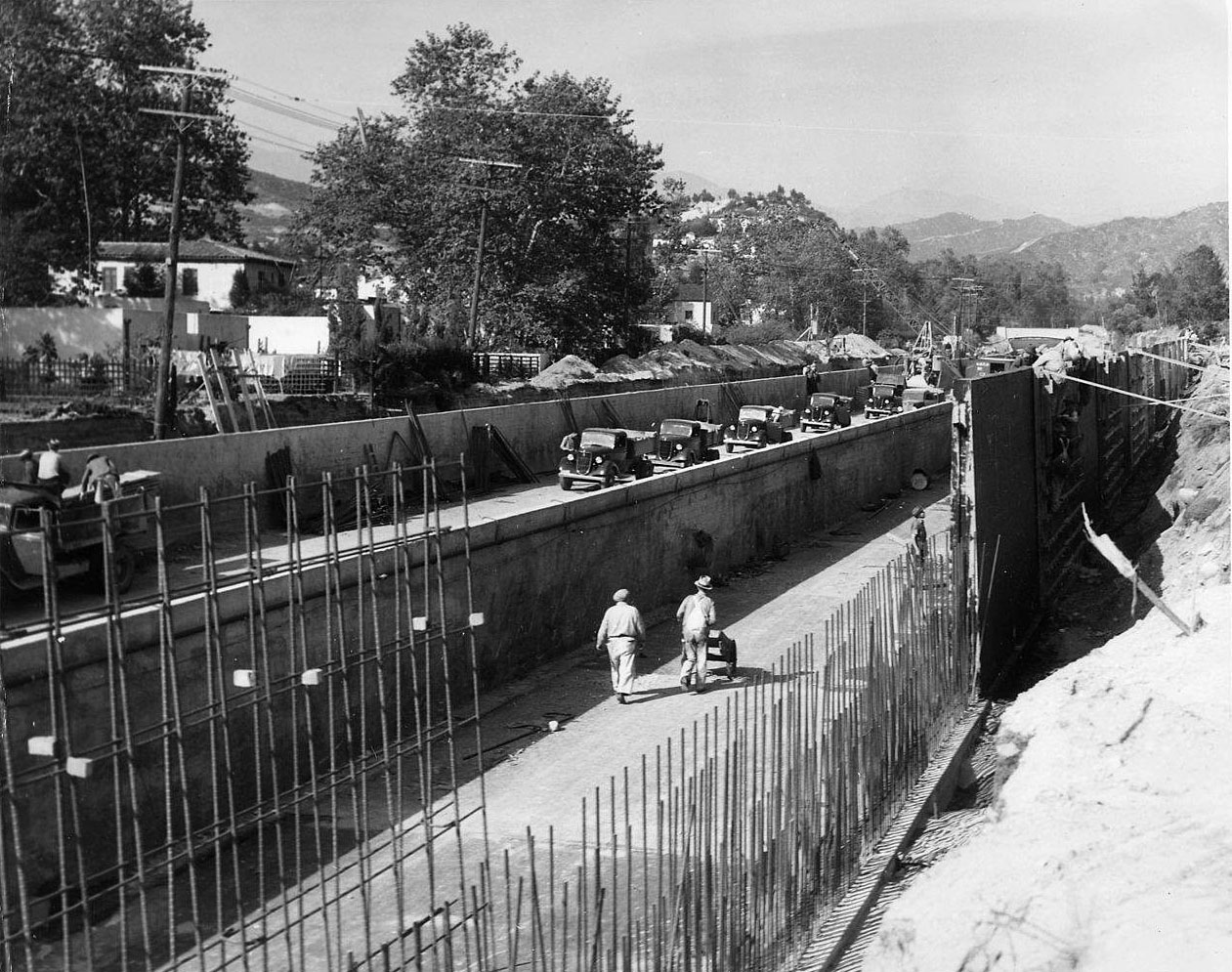 |
|
| (1936)*^ - View showing the construction of the new concrete-lined Verdugo Wash storm drain looking north between Glenoaks Blvd. and Royal Blvd. |
Historical Notes Verdugo Wash is a 9.4-mile-long tributary of the Los Angeles River in the Glendale area. The stream begins just south of Interstate 210 in the Crescenta Valley. It flows southeast along the eastern edge of the Verdugo Mountains, then south through a pass between those mountains and the San Rafael Hills, and finally west to ultimately join the Los Angeles River just northeast of Griffith Park. Its entire path is located within the city of Glendale.*^ |
.jpg) |
|
| (1936)*^ - View looking up the channel from the section between Glenoaks Blvd. and Royal Blvd. showing concrete mixer placing floor of storm drain for one side channel. |
Historical Notes Today, the Verdugo Wash is entirely encased in a concrete flood control channel with the exception of the free-flowing stream inside the Verdugo Wash Debris Basin Dam.*^ |
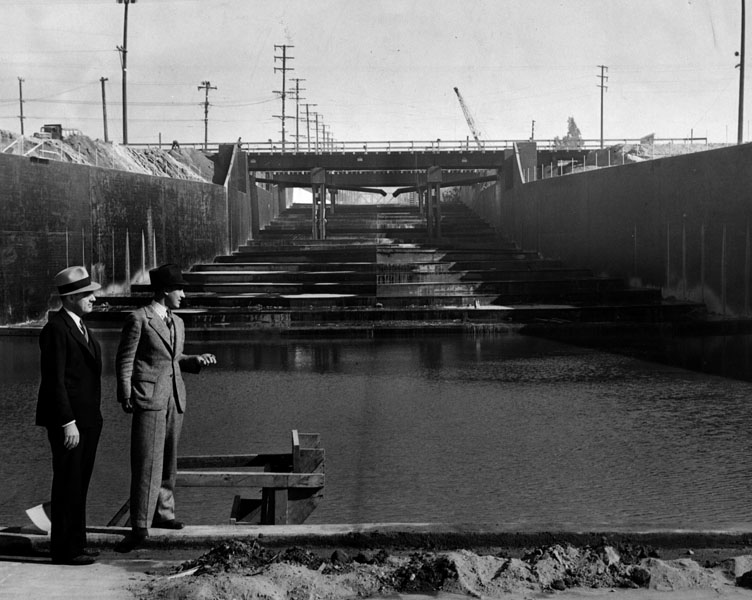 |
|
| (1938)^ - View showing two men inspecting the spilling basin of the new Verdugo Wash. |
Historical Notes Photo caption reads: “Capt. Lyle Rosenberg (left), and Lieut. F. E. Ressegieu inspecting the completed basin. Waters from the wash will spill down the concrete and steel stairs (background), and then into the basin in the foreground. A 10-foot concrete wall will cut the water's speed before it goes into the riverbed, lessening the flood hazards.” Photo dated: December 2, 1938. |
The Great Flood of 1938
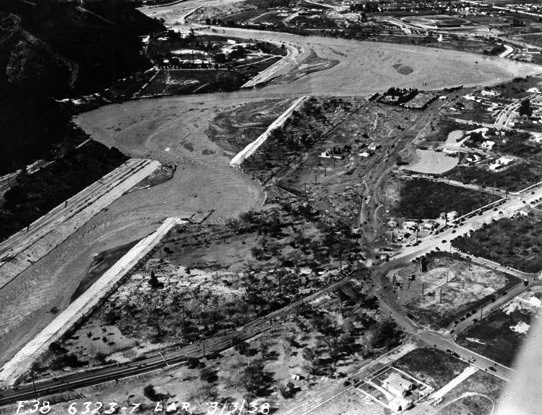 |
|
| (1938)*^ – Aerial View above Victory Boulevard near Riverside Drive in Glendale showing breaches in paved levees of the Los Angeles River. |
Historical Notes Between February 27 and 28, 1938, a storm from the Pacific Ocean moved inland into the Los Angeles Basin, running eastward into the San Gabriel Mountains. The area received almost constant rain totaling 4.4 inches from February 27-March 1. This caused minor flooding that affected only a few buildings in isolated canyons and some low-lying areas along rivers. Fifteen hours later on March 1, at approximately 8:45 PM, a second storm hit the area, creating gale-force winds along the coast and pouring down even more rain. The storm brought rainfall totals to 10 inches in the lowlands and upwards of 32 inches in the mountains. When the storm ended on March 3, the resulting damage was huge -- 115 lives were lost. |
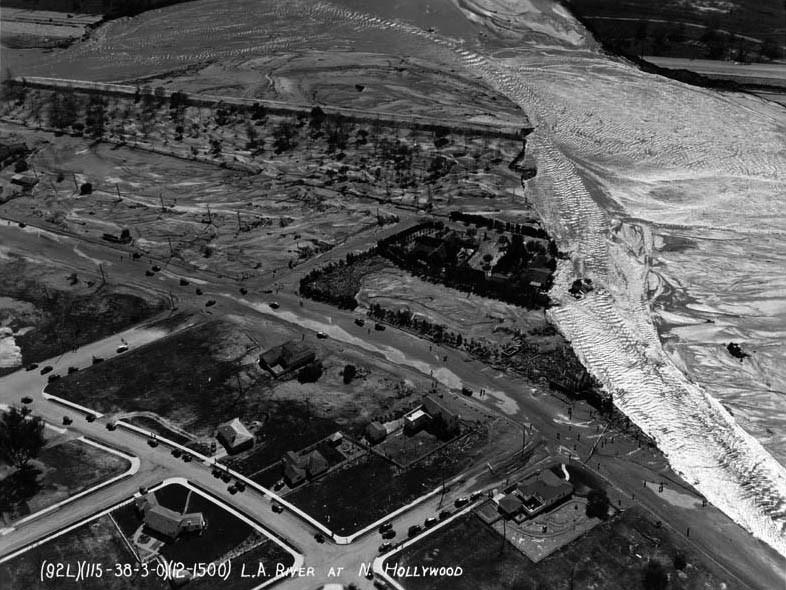 |
|
| (1938)^*# - Aerial view showing the devastation when the LA River overflowed its banks. The above photo is labeled “North Hollywood,” but the area shown is actually the southwestern portion of Glendale. This is the area where Glendale, Burbank, and the City of Los Angeles all come together. Riverside Drive runs from center-left to lower-right corner. The street that ends at the river is Western Avenue. The large estate surrounded by trees (center of photo) was the Betty Davis “country” estate (she did not live there but she did keep her horses there, entertained, etc.); her house and many of the trees are still in place today. Click HERE for contemporary aerial view. |
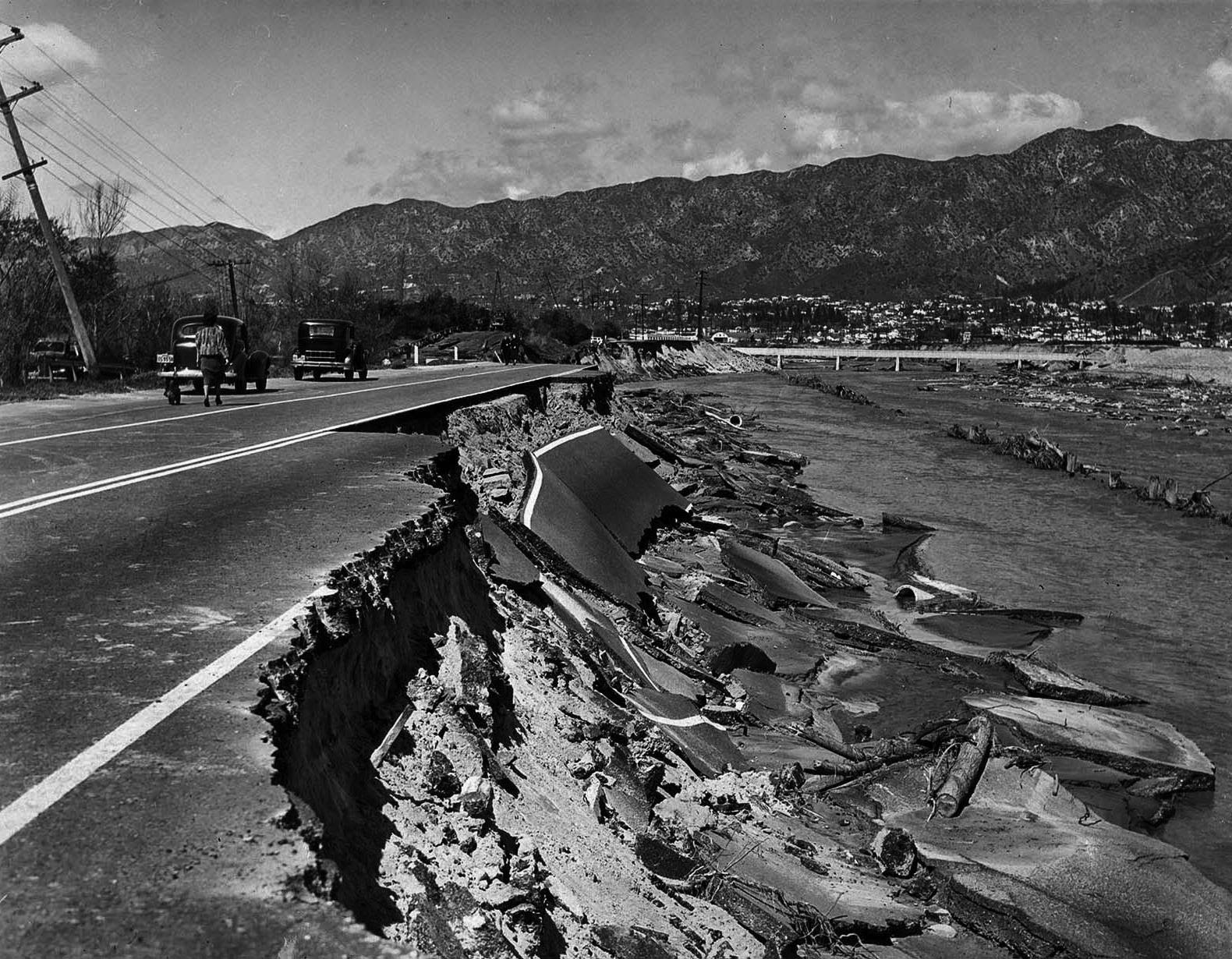 |
|
| (1938)#+ - Heavily traveled Riverside Drive in Glendale was undermined by the torrent of the Los Angeles River. This damaged section was near the former Grand Central Airport. Photo date: March 5, 1938. |
Historical Notes Click HERE to see more in 'Los Angeles River The Unpredictable' |
Glendale Police Department
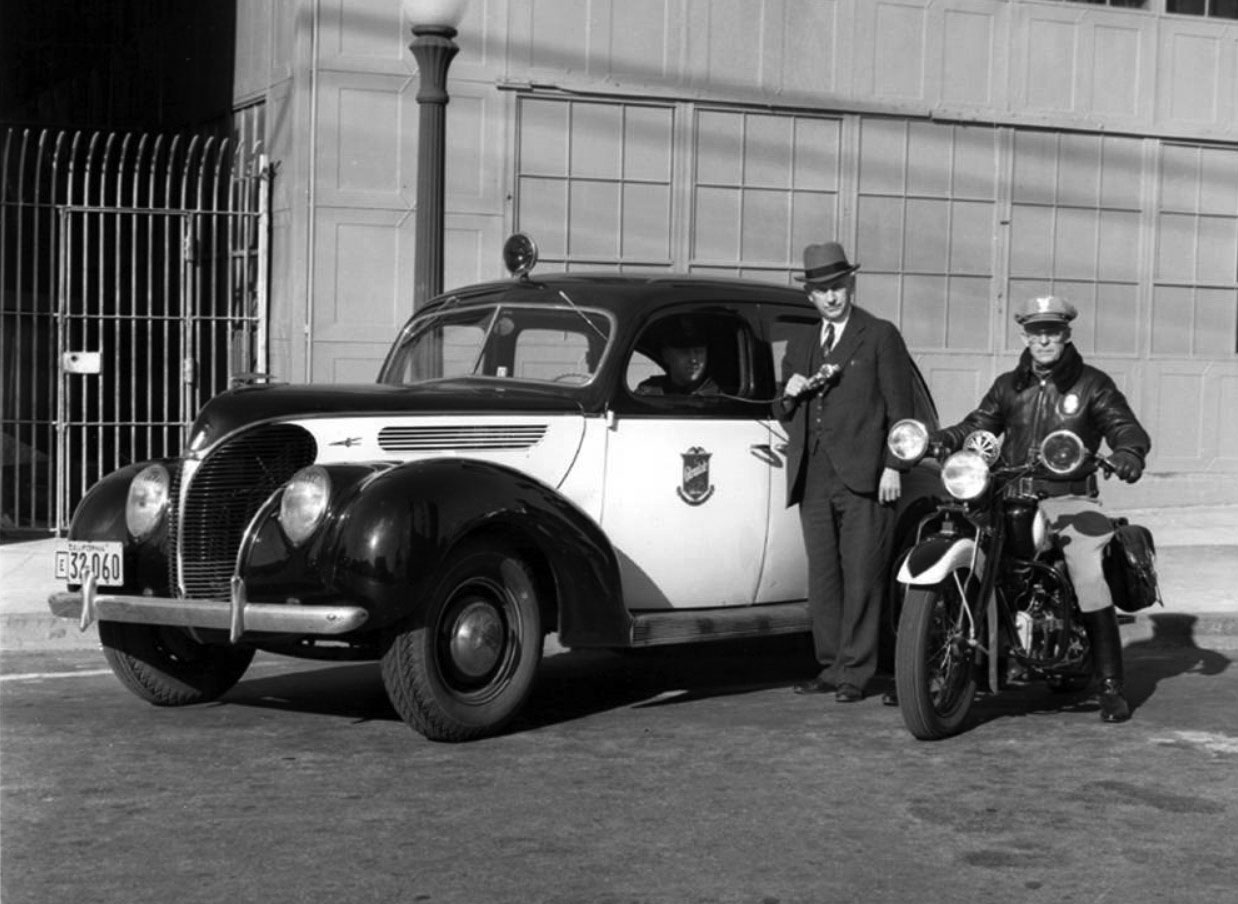 |
|
| (1938)##^ - Radio telephone in patrol cars. Chief V. B. Brown gives a demonstration of the first two-way radio telephone in the Glendale Police Department's patrol cars. The motorcycle officer is Wes Owen. The call letters KQCI became the identifier of the Glendale Police Department radio telephone. |
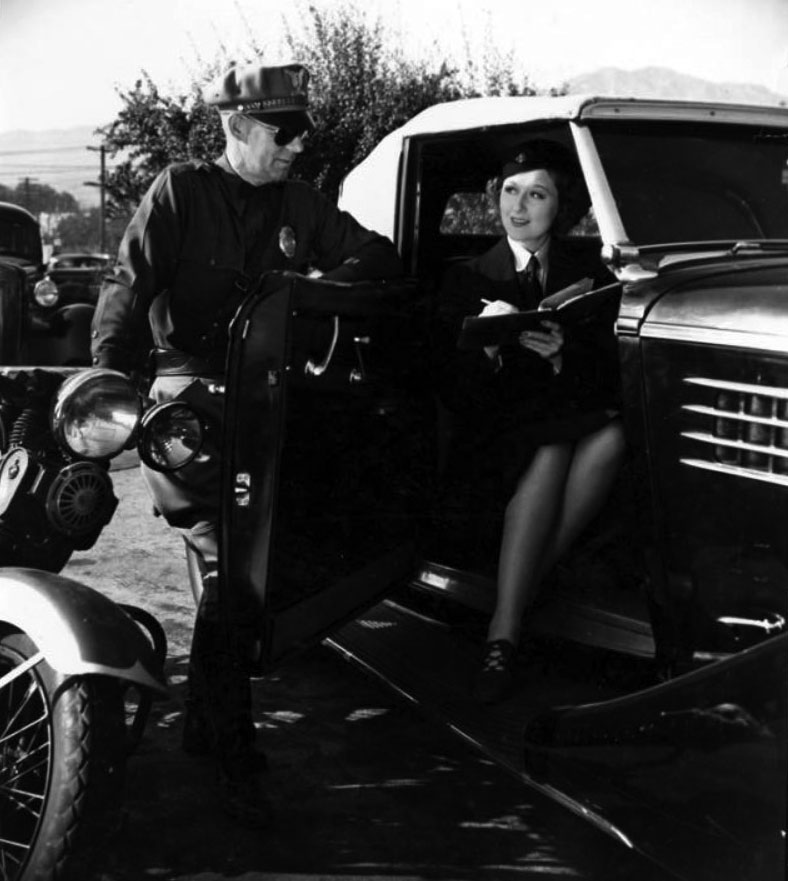 |
|
| (1930s)* - A meter maid and a motorcycle officer for the Glendale Police Department. |
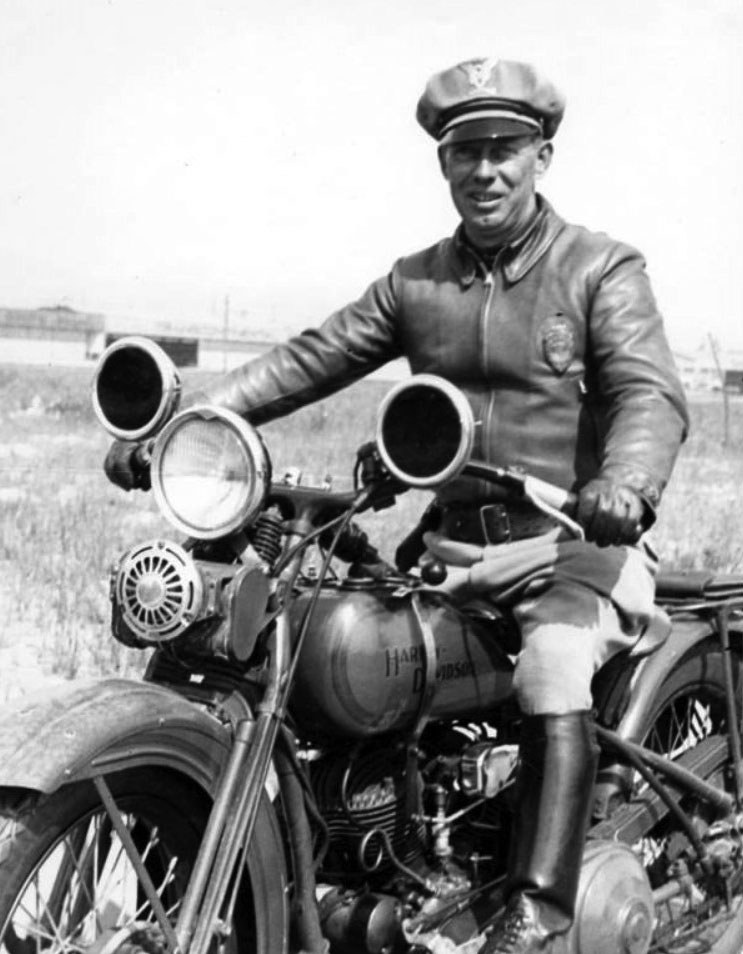 |
|
| (ca. 1940)* - Glendale Police Department Officer I. A. Robinson on an official-issue Harley Davidson motorcycle. |
Historical Notes Click HERE to see more Early Views of the Glendale Police Department (1919 +) |
* * * * * |
Carpenter's Drive-in Restaurant
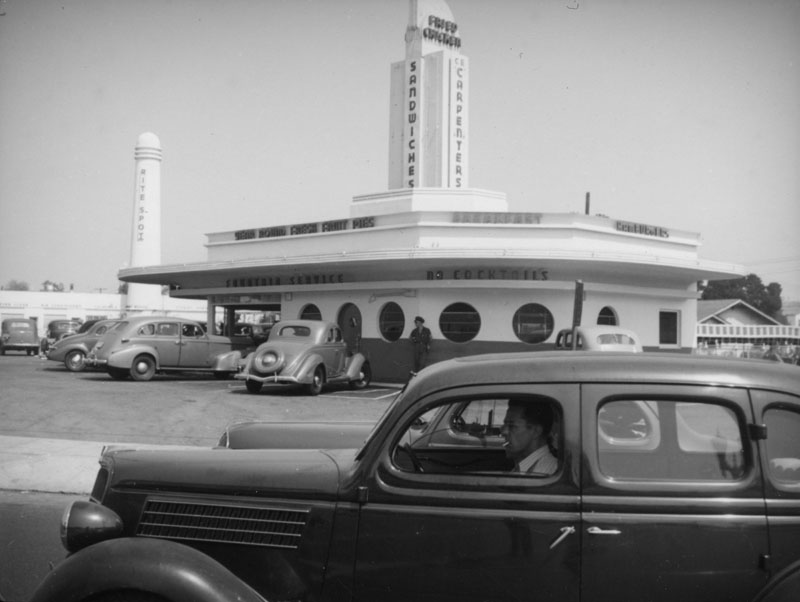 |
|
| (ca. 1938)^ - View showing Carpenter's Drive-in Restaurant located at 606 E. Colorado St. in Glendale. The drive-in featured fried chicken, sandwiches, year round fresh fruit pies, breakfast, hamburgers and fountain service. The Rite Spot Cafe pylon is seen in the background. |
Historical Notes In 1936, after separating from his brother, Charles E. Carpenter opened three Carpenter's Cafes. A transitional project Carpenter's Village (606 E. Colorado) combined a Rite Spot Cafe and Carpenter's Drive-in (seen above). Next he opened the Rite Spot Cafe in Pasadena, located at 1500 West Colorado Street (now considered Eagle Rock) and the Santa Anita Cafe at Huntington and Colorado. Click HERE to see more Early LA Drive-in Restaurants. |
* * * * * |
Sears Building
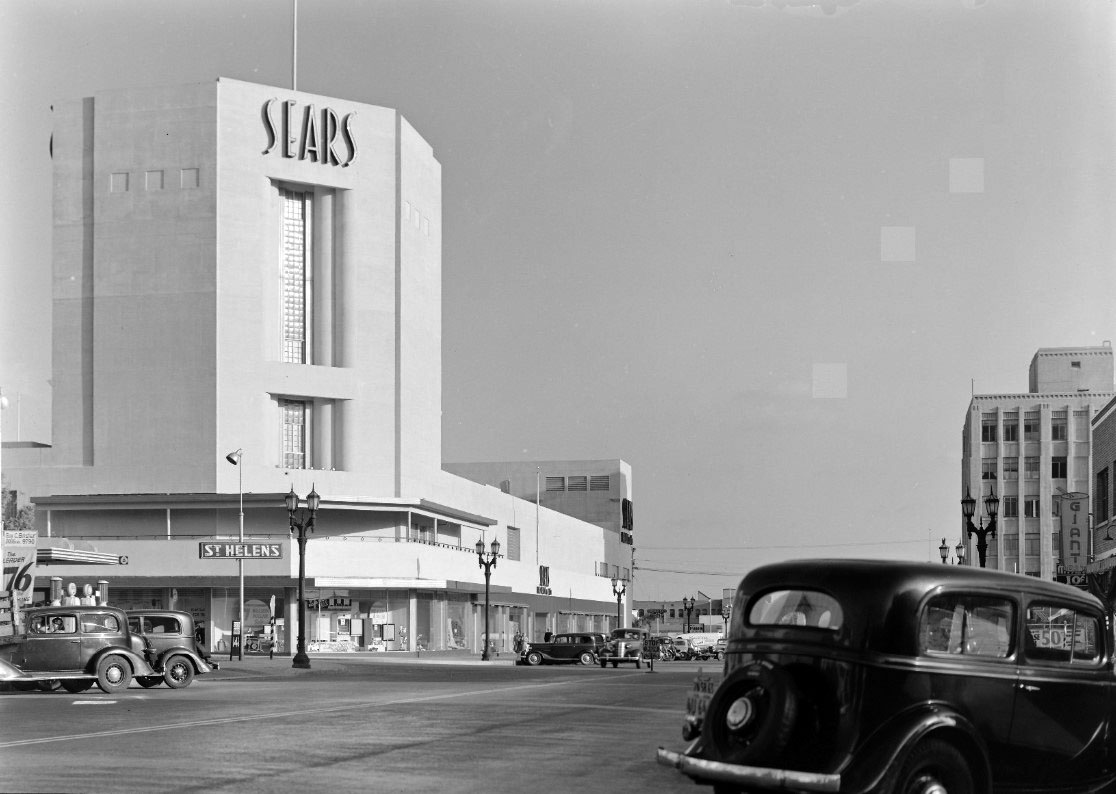 |
|
| (1930s)* - View looking south showing the Sears Building located on the southeast corner of Central and California avenues in Glendale. |
Historical Notes The old Sears advertising slogan “Come to Sears Brand Central” has a special meaning in Glendale, as this Sears is situated between Brand Blvd. and Central Ave. Completed in 1935, this was the first Sears store in the world to be custom-built as such. Up until that point, Sears-Roebuck had taken over existing structures. |
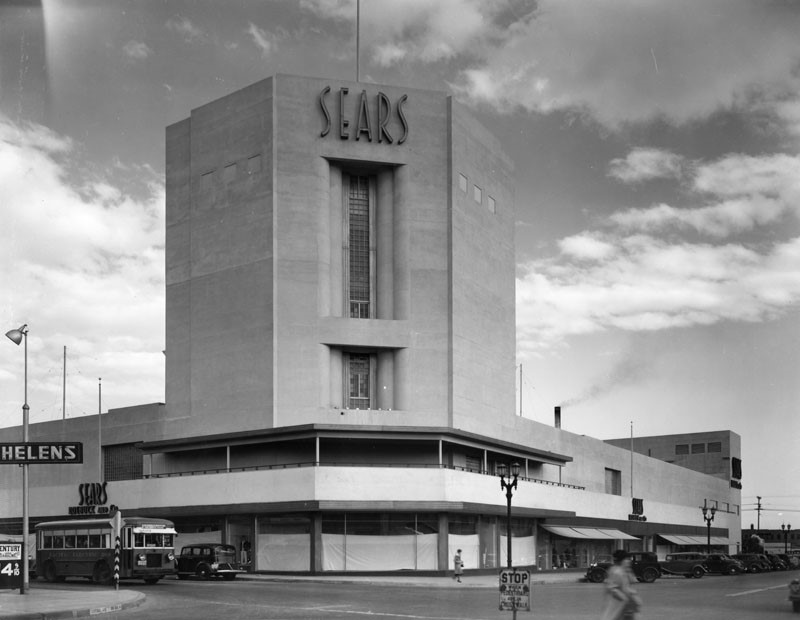 |
|
| (1930s)* – Close-up corner view showing the Sears Roebuck and Co. tower. |
Historical Notes Between 1937 and 1938 the architectural firm of Nimmons, Carr and Wright designed similar Late Moderne style Sears Roebuck and Company Department Stores in Illinois, Maryland, Michigan and Glendale California. The Glendale Sears features large sign towers, glass brick window panels and a long series of display windows covered by an awning along the street. The Glendale store, located at 236 North Central Avenue, is still standing today although it has been remodeled. |
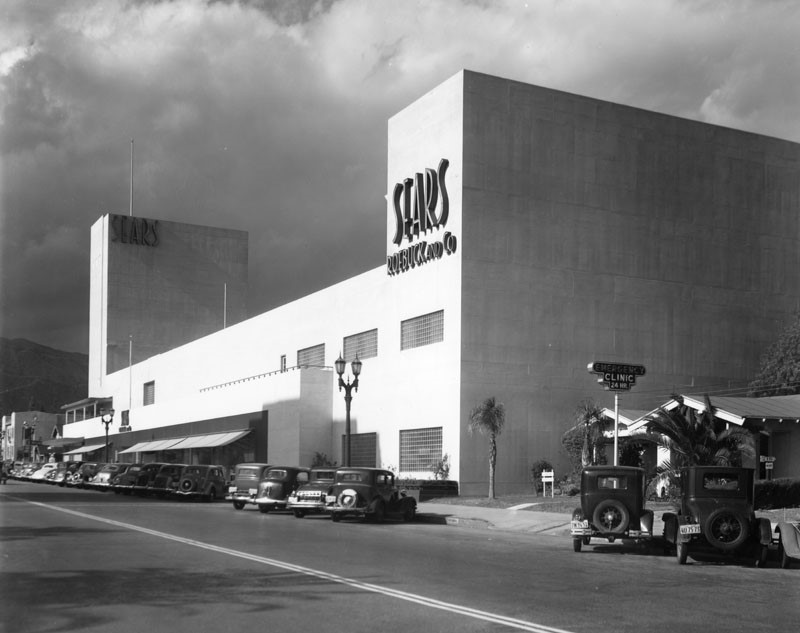 |
|
| (1930s)* – View looking north showing Sears Roebuck and Co. located at 236 N. Central Ave. Notice how the house on the right had been repurposed as a clinic. Though the structure is long gone, a medical clinic still occupies the lot just south of the Sears today. Click HERE to see contemporary view. |
* * * * * |
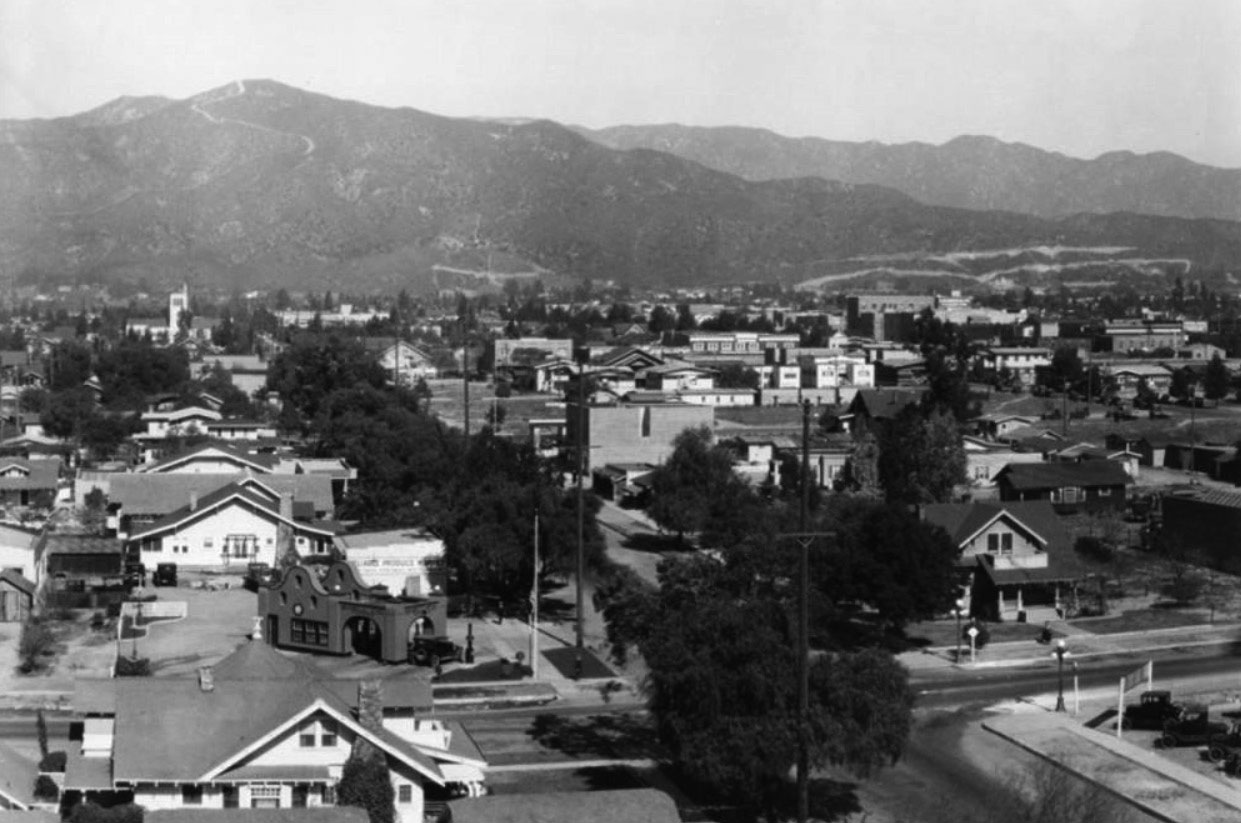 |
|
| (ca. 1925)* - Panoramic view of Glendale along Central Avenue looking north from Colorado Blvd. |
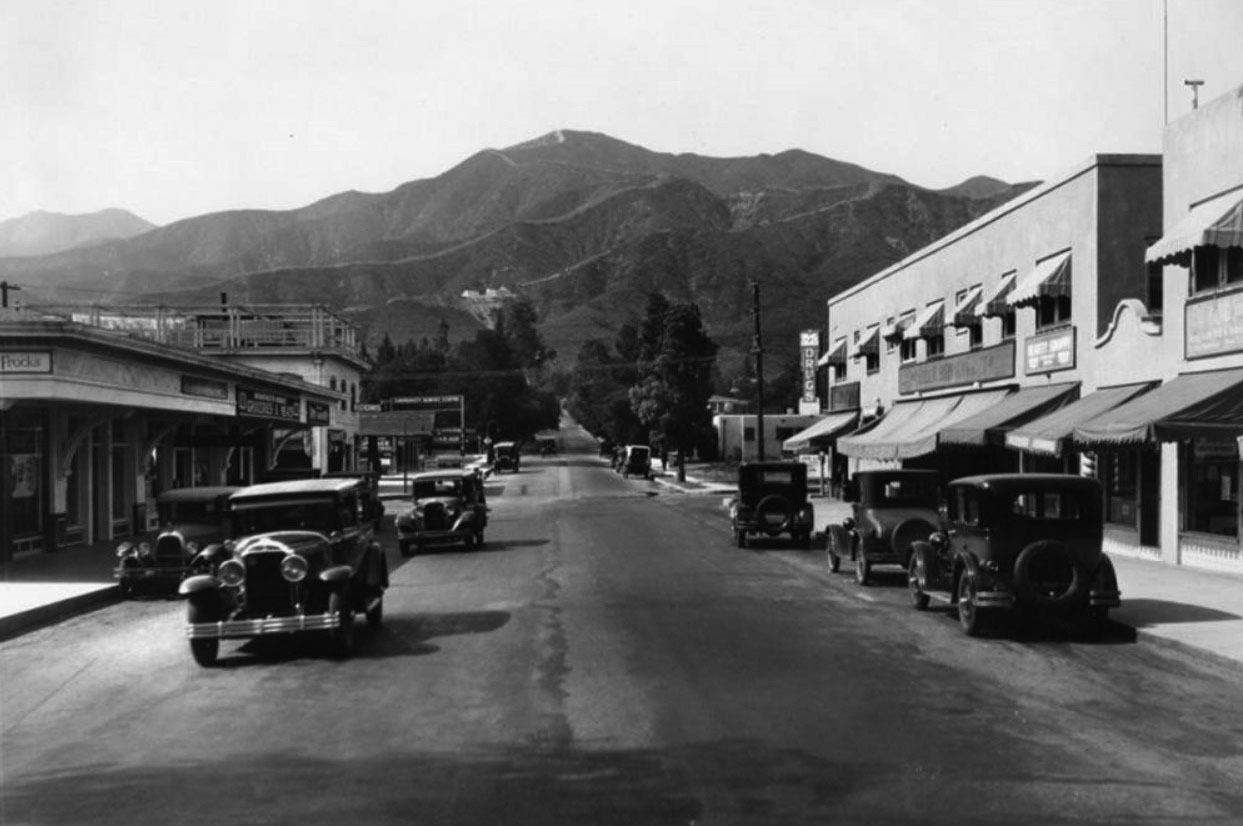 |
|
| (1930)* - View showing North Central Avenue in Glendale. The building on the right has a Radio service shop, Beauty Shoppe, "Billie Bird Market" and a drug store. The building on the left has "Bradstreet Market Groceries & Meats" and a dry goods shop. In the center left there is a building with rooms for rent and a Community service station with tire repairing. |
* * * * * |
Brand Boulevard (1930+)
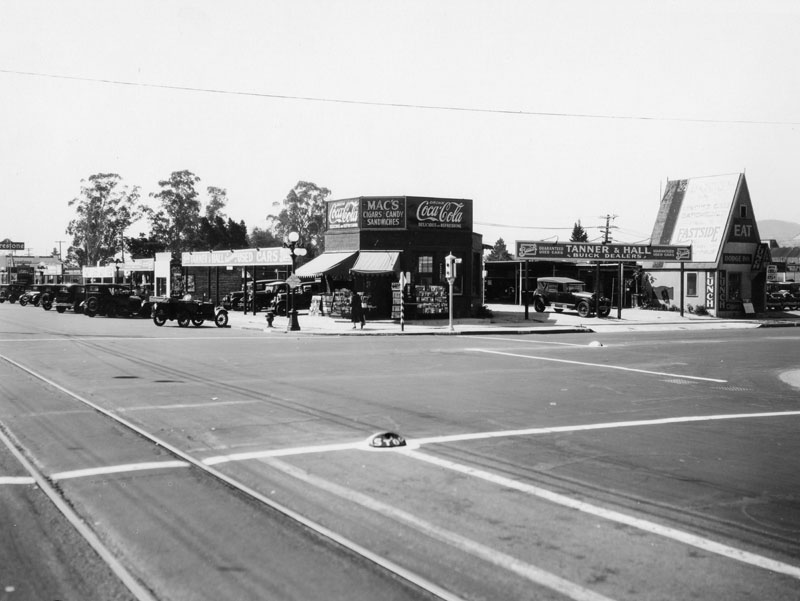 |
|
| (1930)^ - View of the southwest corner of Brand and Colorado, in Glendale. Several businesses are seen in the area, including "Mac's", a cigar, candy and sandwiches store located at the corner. Click HERE to see contemporary view. |
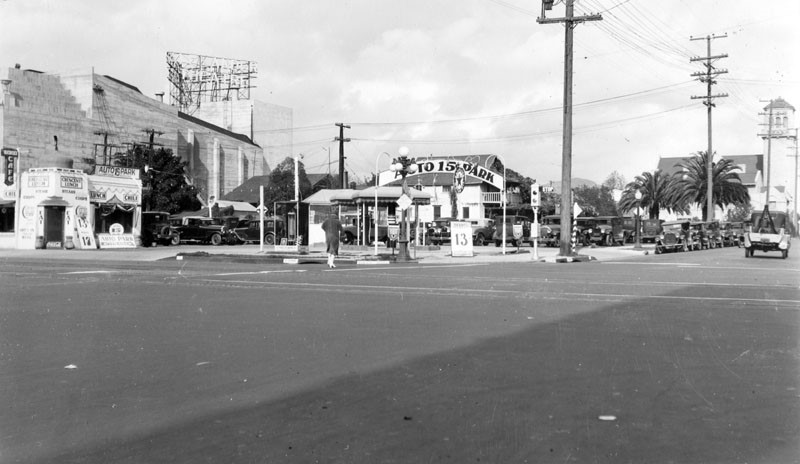 |
|
| (1930)^ - View of the northeast corner of Brand Boulevard and Wilson Avenue. A small Texaco service station can be seen at the corner of the intersection. On the left (east side of Brand) is Weber's Cafe and a side profile of the Alex Theatre building. Click HERE for contemporary view. |
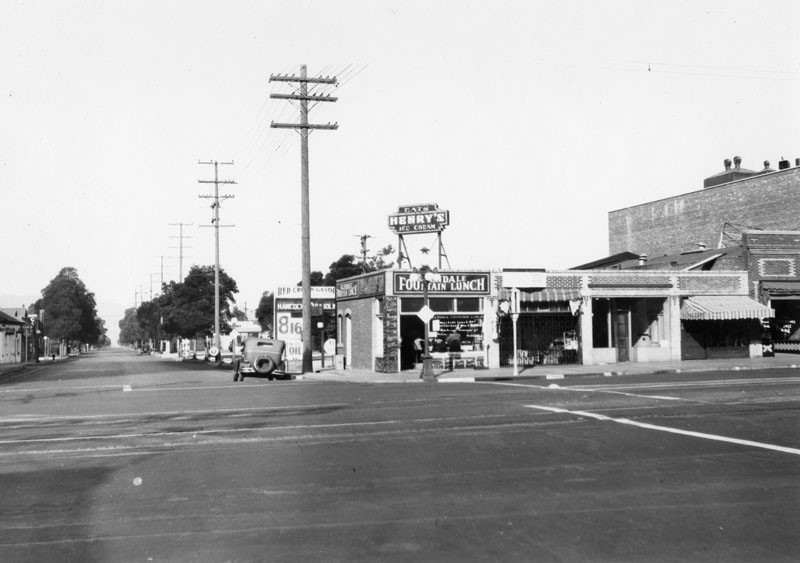 |
|
| (1930)* - View is west on Wilson Avenue from Brand Boulevard. At the corner is Henry's Ice Cream which also serves lunch. Residential homes may be seen further down the block. Click HERE for contemporary view. |
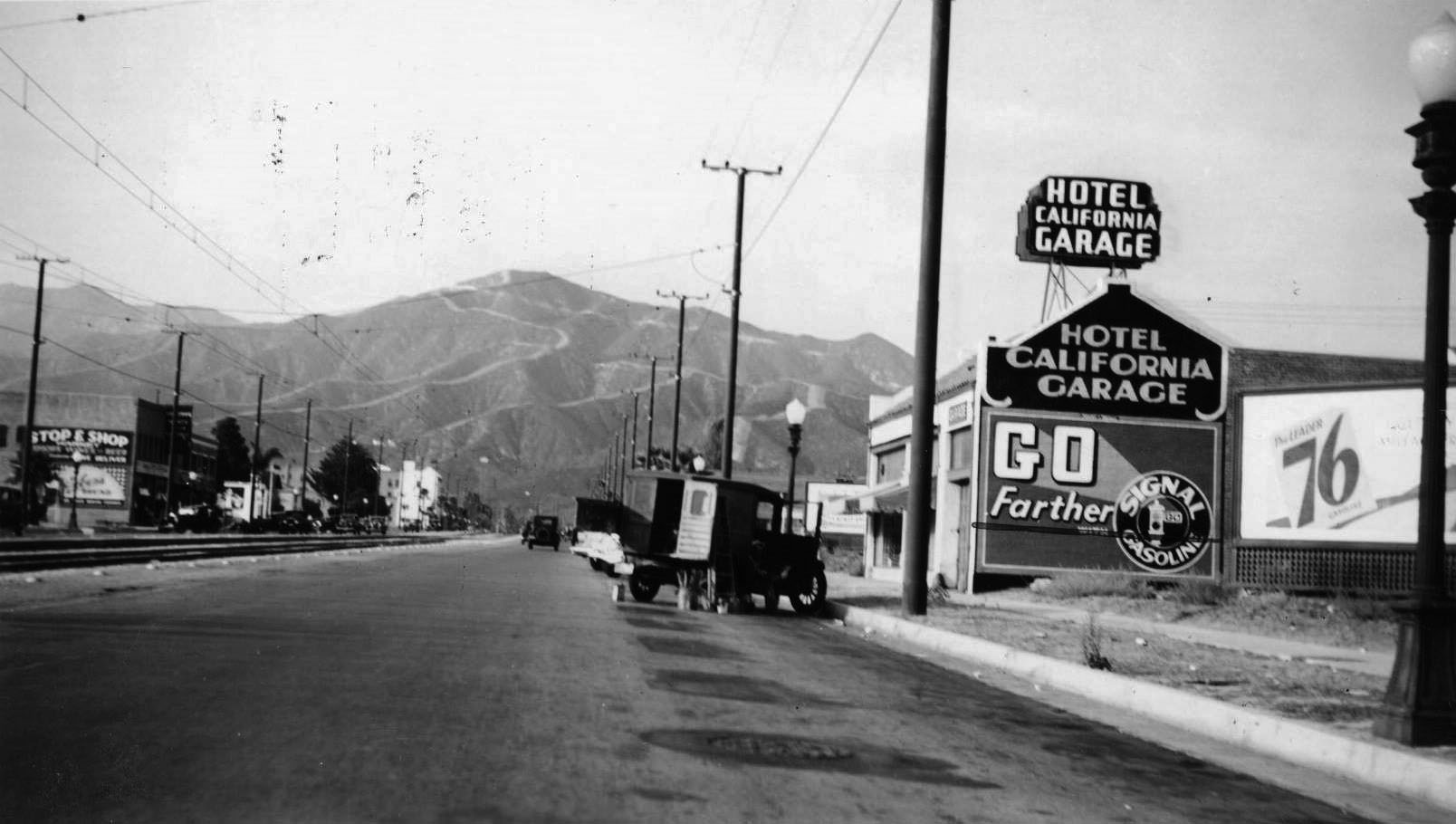 |
|
| (1936)* - View looking north from the 500 block of N. Brand Blvd., Glendale. Sign at right reads: HOTEL CALIFORNIA GARAGE |
Christmas
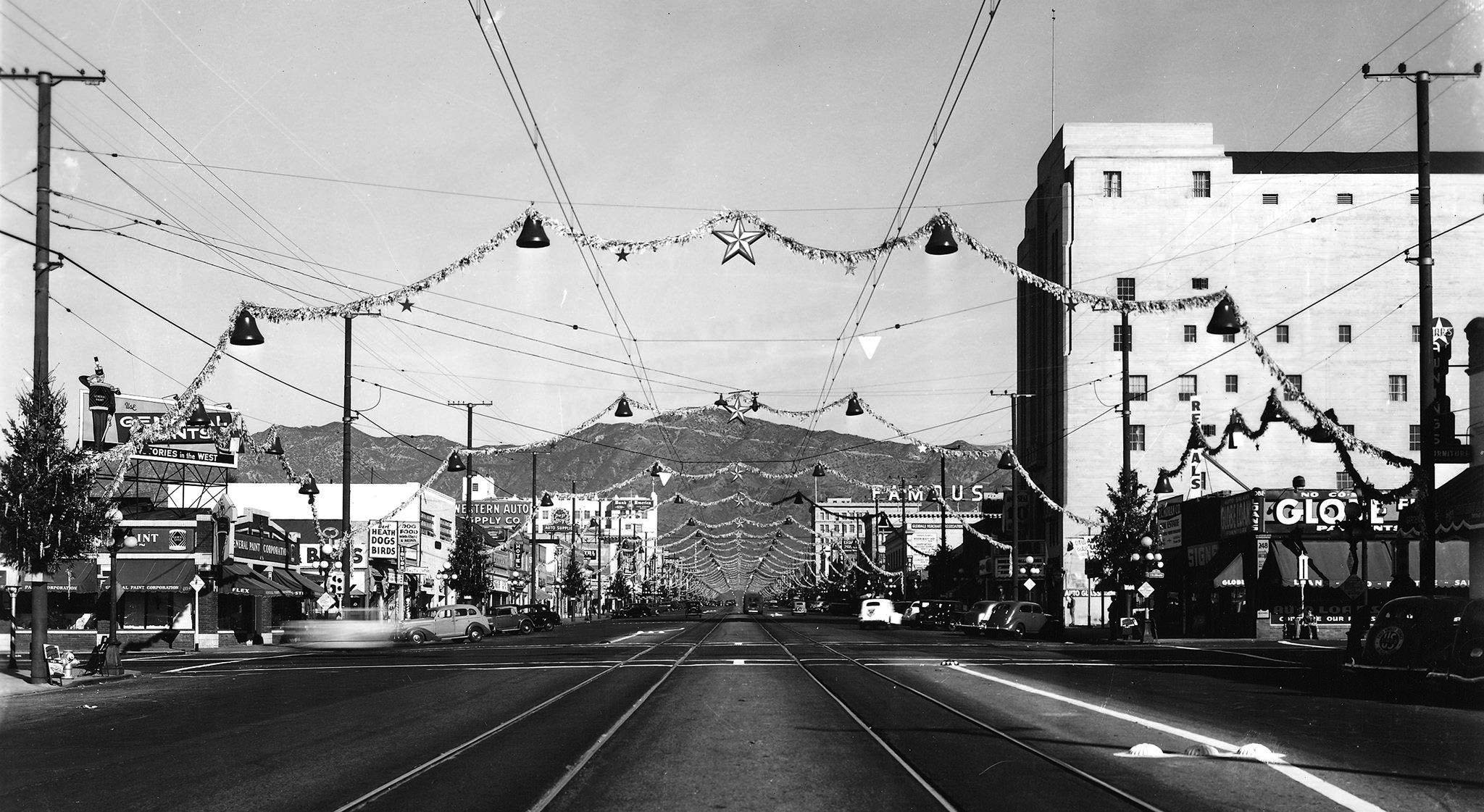 |
|
| (1938)* – Day time view looking north on Brand during Christmas. |
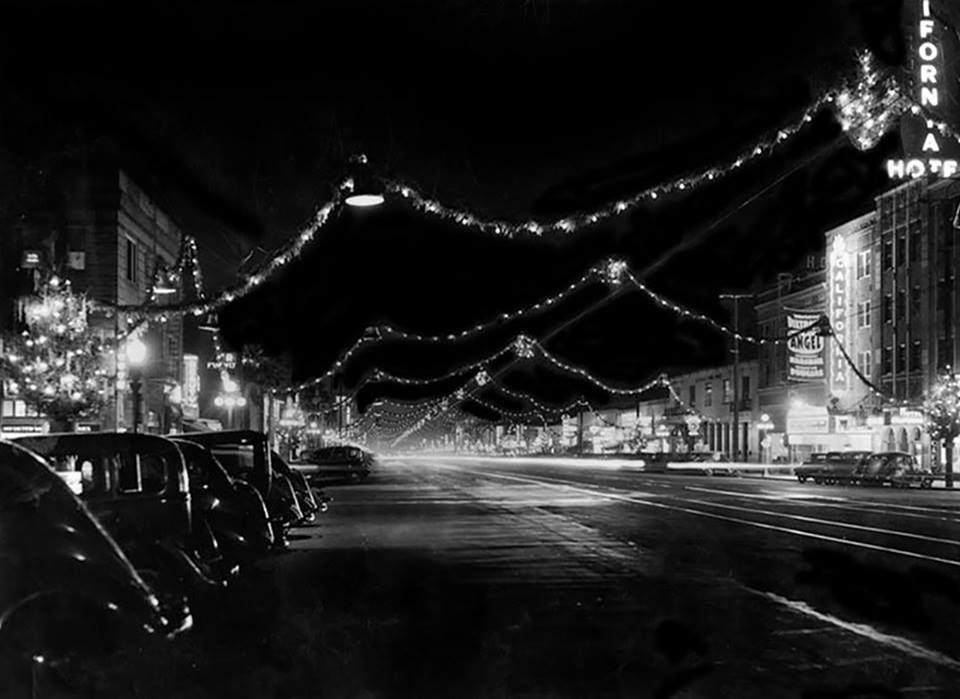 |
|
| (1937)* – Night view looking south on Brand Boulevard during the Holiday Season with the Hotel California seen on the right. |
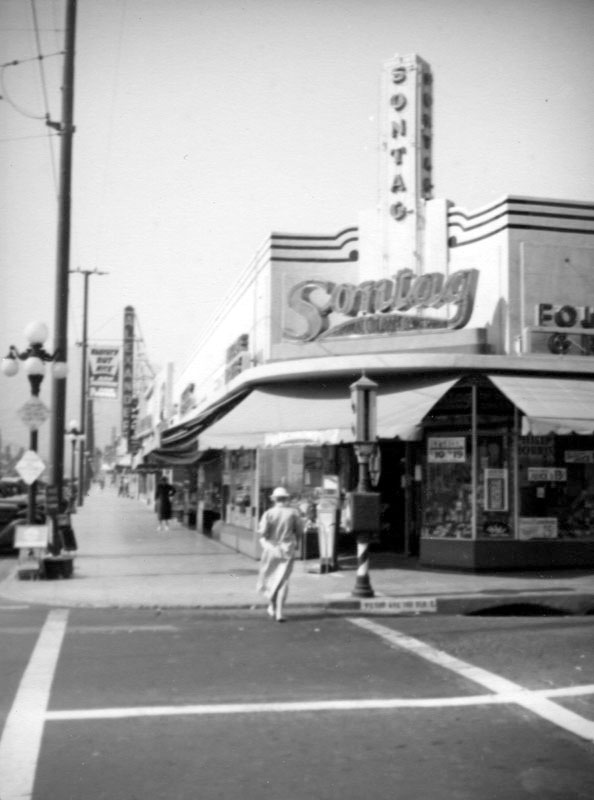 |
|
| (ca. 1938)^ - This view looking north on Brand at Wilson captures the Sontag, located at 200 North Brand. Just north of the drugstore is the Alexander Theatre (later the Alex Theatre) before the S. Charles Lee remodel (1940) and the addition of a 100 foot Art Deco tower. |
Historical Notes Sontag Drug Stores was one of the largest drug store chains in the U.S. in the 1930’s & 1940’s. It was also one of the first to allow customers to browse and choose their own products rather than requesting them from a clerk behind a counter. All in all, there were 16 Sontag Drugs located in Los Angeles, and another 32 in other locations – for a total of 48 stores. Their Los Angeles headquarters was located at the corner of Wilshire Blvd. and La Cienega Blvd. (torn down and replaced at one time with the Flynt Building). |
* * * * * |
Glendale Theater
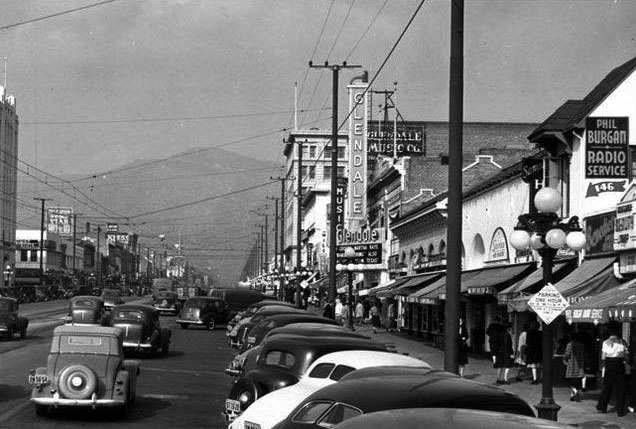 |
|
| (1940s)* – View looking north on Brand Blvd from near Harvard Street with the Glendale Theatre seen at center of the block. Paul Burgan’s Radio Service is on the right behind the ornate 5-bulb streetlight. |
Historical Notes The Glendale Theatre opened on October 28, 1920. In February 1940 it became a district 2 Fox West Coast Theatre. |
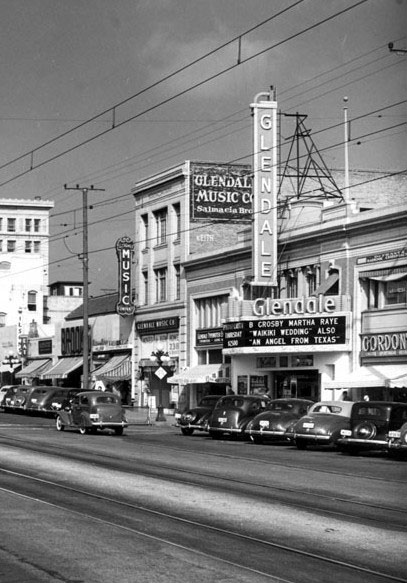 |
(1940s)* – View looking northeast showing the Glendale Theater located at 122 S. Brand Blvd. The Glendale Music Co. is seen just to the north of the theater. |
|
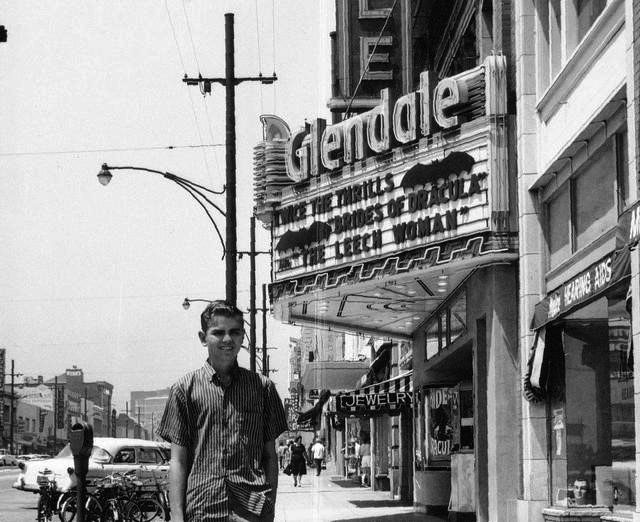 |
|
| (1970)* – A boy poses in front of the Glendale Theatre. Note all the bikes parked in front of the theater against the curb. The marquee reads: TWICE THE THRILLS: “Brides of Dracula” and “The Leech Woman”. Photo courtesy of Joel Sandell. |
 |
|
| (1979)* – Front view of the Glendale Theatre located at 122 S. Brand Boulevard. Photo courtesy of Stacie Inkel |
Historical Notes The Glendale Theatre was twinned on June 13, 1980 and later closed, last operated by Mann Theatres. It was demolished in 1995-1996. A DSW Shoes is now located where the Glendale Theatre once stood. Click HERE for contemporary view. |
* * * * * |
Hotel California (aka California Hotel)
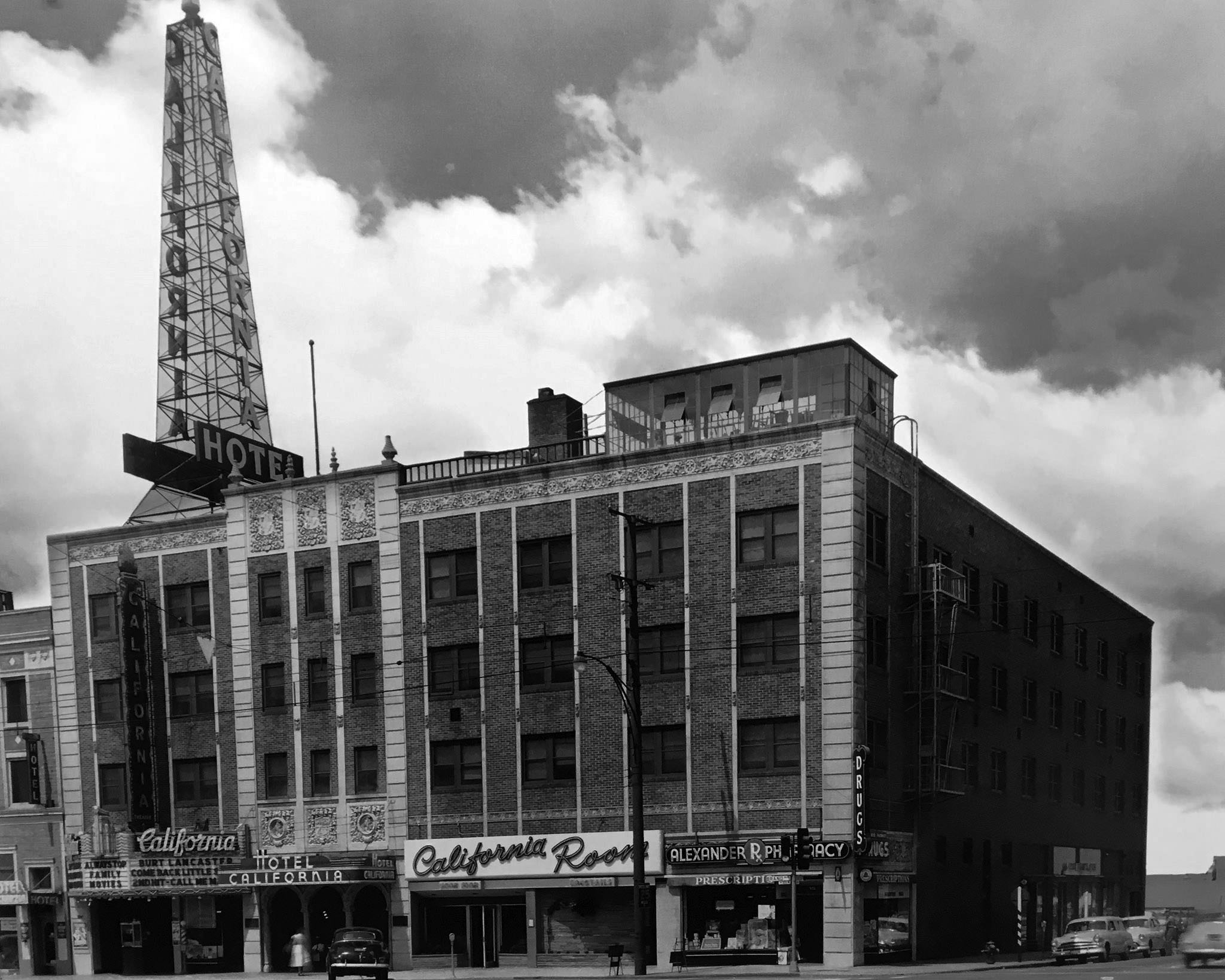 |
|
| (ca. 1952)* – View showing the Hotel California and California Theatre, located on the southwest corner Lexington Dr. and Brand Blvd. |
Historical Notes Built in 1927 and occupied in 1928, the California Hotel, along with the Glendale Hotel (Broadway and Glendale Ave), were the city’s “nicest places” for visitors to stay in the 1930s and 1940s. The California was among only a few hotels in greater Los Angeles that included a full-sized theater. |
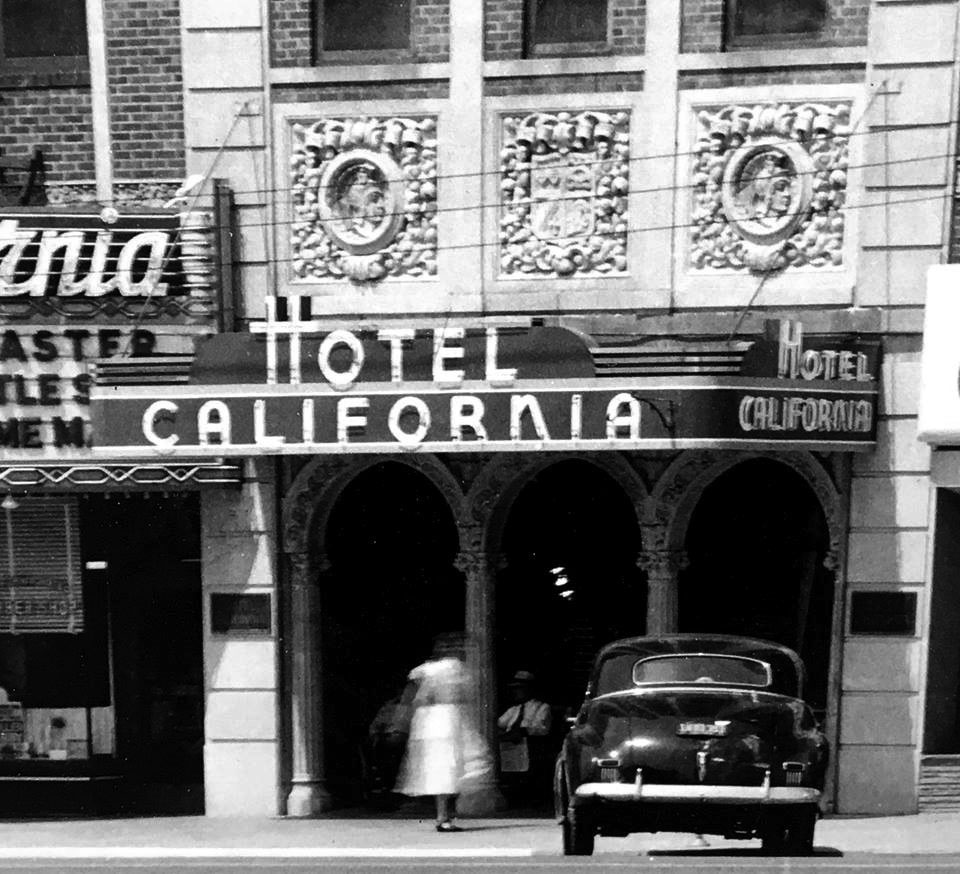 |
|
| (ca. 1952)* – Close-up view showing the entrance to the Hotel California aka California Hotel (1927-1966). |
Historical Notes When motels became popular in the late 40s and thereafter, popularity of the California Hotel began to fade. The hotel was demolished in 1966 and replaced with a Bank of America building. Click HERE to see contemporary view. |
California Theatre
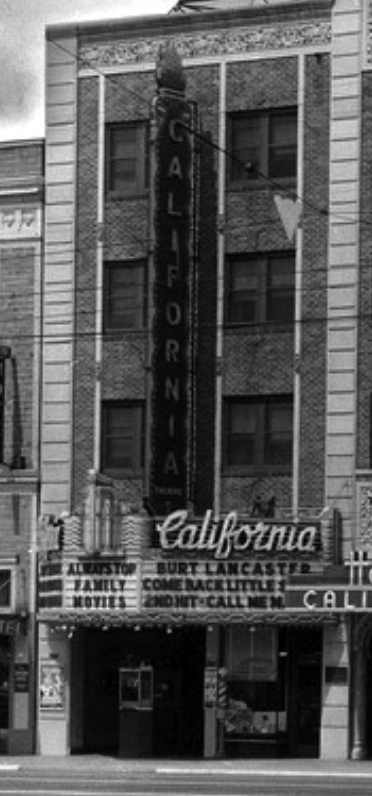 |
|
| (1952)* - View showing the California Theatre, 341 N. Brand Blvd. Marquis reads: Always Top Family Movies – Now Playing: Come Back Little Sheiba w/Burt Lancaster. |
Historical Notes The California Theatre was opened on December 25, 1928. In February 1940 the California Theatre was taken over by Fox West Coast Theatres as a District 2 house. It was still open in 1956, but had closed by 1957. By 1959 the theatre was converted into a furniture store, Scott's Furniture. |
* * * * * |
Alex Theatre (originally known as the Alexander Theatre)
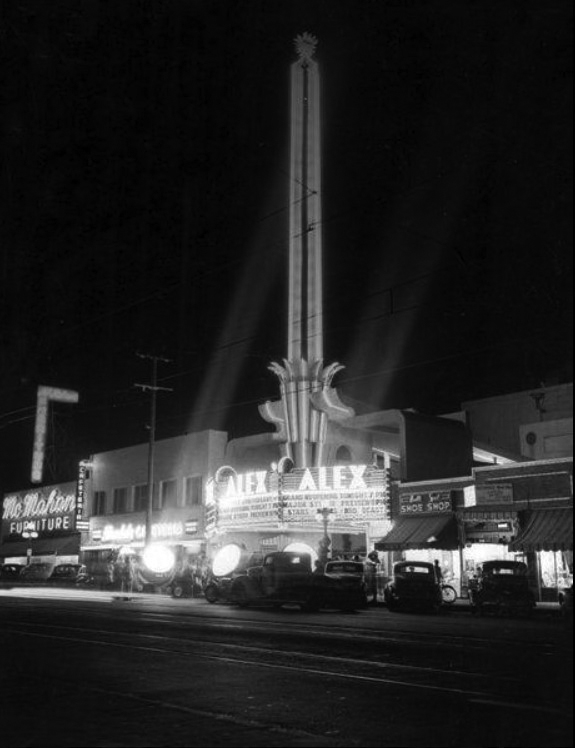 |
|
| (1940s)* - Spotlights draw attention to what appears to be a film premiere at the Alex Theatre, located at 216 N. Brand Boulevard. |
Historical Notes Designed by architects Charles R. Selkirk and Arthur G. Lindley with an emphasis on Greek and Egyptian themes, the Alex Theatre (originally known as the Alexander) opened its doors as a Vaudeville and motion picture house in 1925. In 1940 by S. Charles Lee added the 100 foot tall Art Deco tower. Included in Lee's design were the three-sided marquee, outdoor ticketing kiosk, and the decorative terrazzo floor crested in bright tropical colors. |
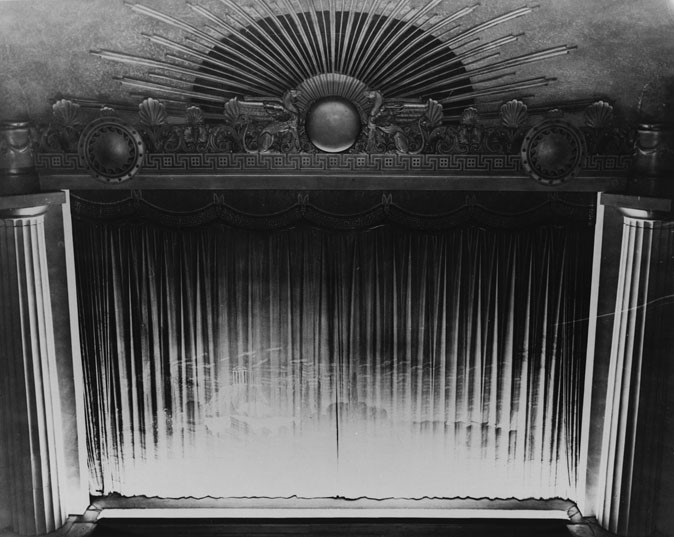 |
|
| (ca. 1937)^ - Interior view of the Alex Theatre showing the decorative stage curtain, done in a Grecian motif, and enclosed by column on both sides of the stage. |
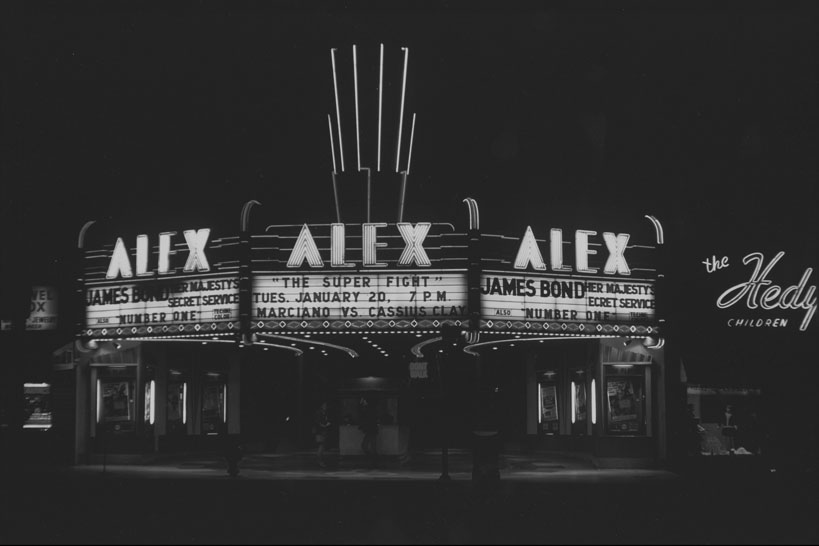 |
|
| (ca. 1969)^ - Close-up night view of the Alex Theatre (originally known as the Alexander Theatre) located on Brand Avenue in Glendale. The James Bond film "Her Majesty's Secret Service" and "The Super Fight" of Marciano versus Cassius Clay are advertised on the marquee. |
Historical Notes The Alexander officially opened its doors on September 4, 1925. It was operated by the West Coast-Langley Theatre Circuit and featured vaudeville performances, plays and silent movies on a single screen. It was named after Alexander Langley, the son of C.L. Langley, owner of the West Coast chain that included the Raymond Theater in Pasadena, and the Orange Theatre in the city of Orange. |
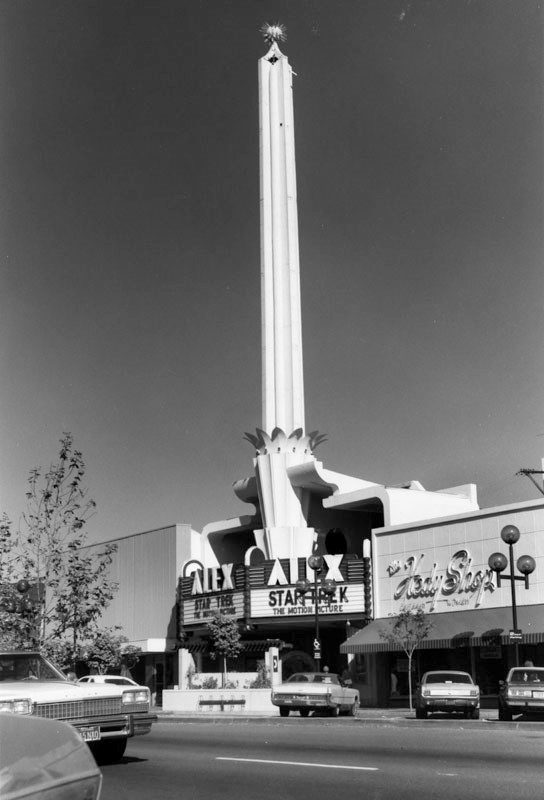 |
|
| (ca. 1979)^ - Exterior view of the Alex Theatre located on Brand Boulevard. The film "Star Trek" is advertised on the sign. The exterior of The Hedy Shop, a clothing store for women and children, is visible on the right. Click HERE for contemporary view. |
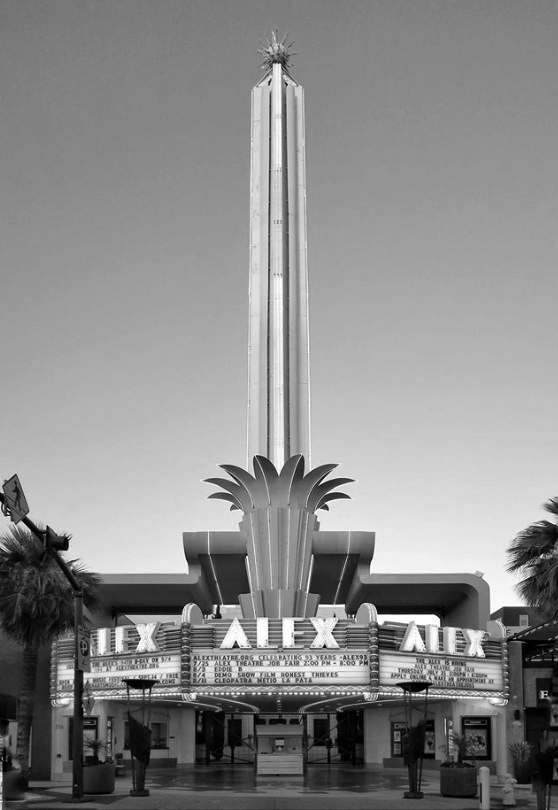 |
|
| (2019)* - The Alex Theater as it appears today. Photo courtesy of John Vincenti |
Historical Notes The Alex Theatre Performing Arts and Entertainment Center has been the centerpiece of the Glendale's arts, culture and community events since it originally opened. It is managed by Glendale Arts, a non-profit organization. The theater's diverse schedule boasts roughly 250 events per year and attracts more than 100,000 patrons annually. Programs range from classical and contemporary concerts, theatre, dance, comedy, fundraising and special events as well as TV and film productions and industry related award presentations. Resident companies include the Alex Film Society, Glendale Youth Orchestra, Musical Theatre Guild, and the Los Angeles Chamber Orchestra. The Alex Film Society regularly schedules classic films, often accompanied with special guests (e.g., the annual Thanksgiving weekend tradition "Three Stooges Big Screen Event," which children, grandchildren, and other relatives of the Stooges often attend), live musical performances of the film's soundtrack and vintage photos. |
* * * * * |
Brand and Wilson
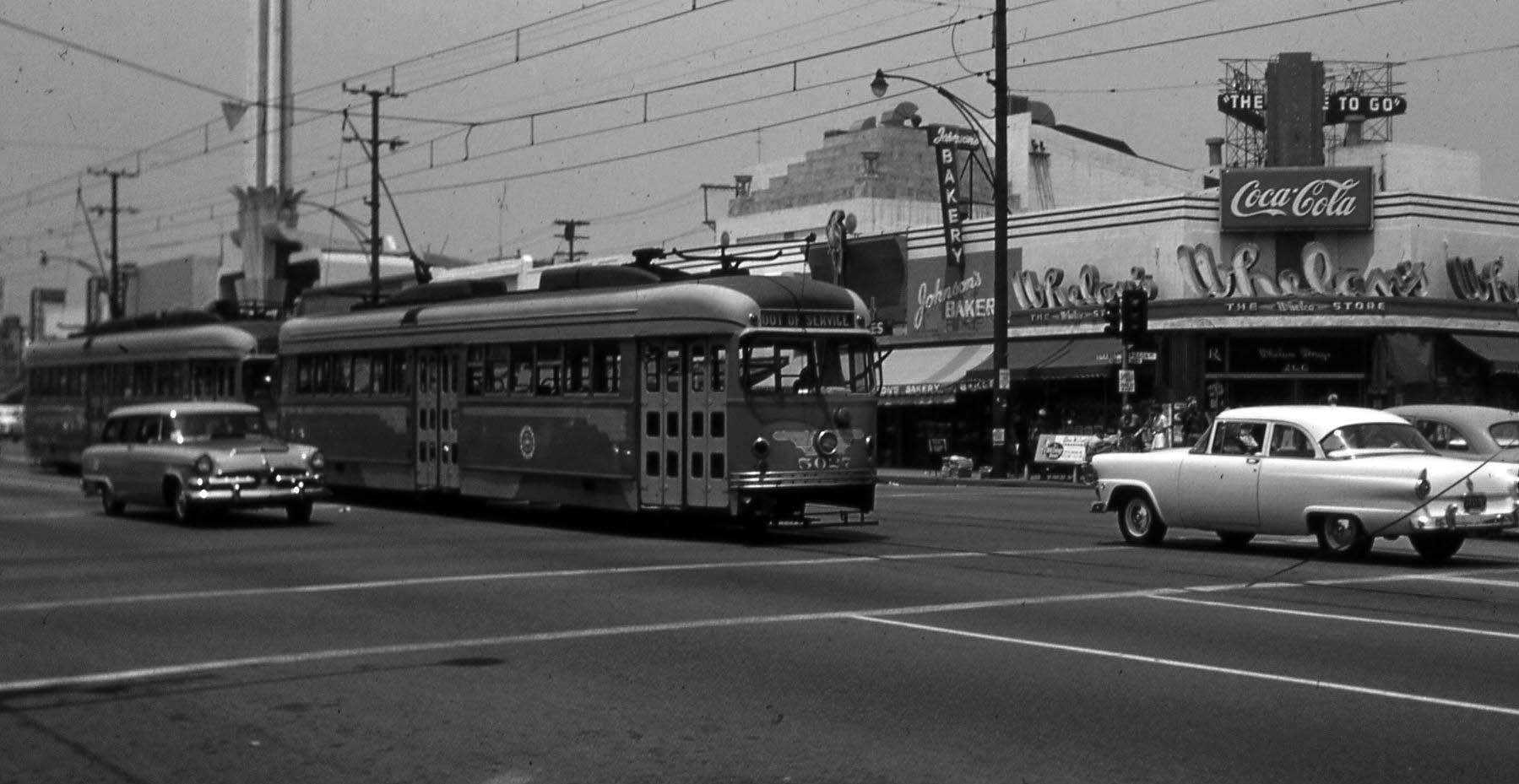 |
|
| (1955)* - View looking northeast at the corner of Brand Boulevard and Wilson Avenue showing two streetcars inbound to LA on the next to the last day of PE service to Glendale, 6/18/1955. The tower and roof of the Alex Theater rise in the background. |
 |
|
| (1955)* - View looking northeast at the corner of Brand Boulevard and Wilson Avenue showing two streetcars inbound to LA on the next to the last day of PE service to Glendale, 6/18/1955. The tower and roof of the Alex Theater rise in the background. Photo courtesy of Paul Ayers. |
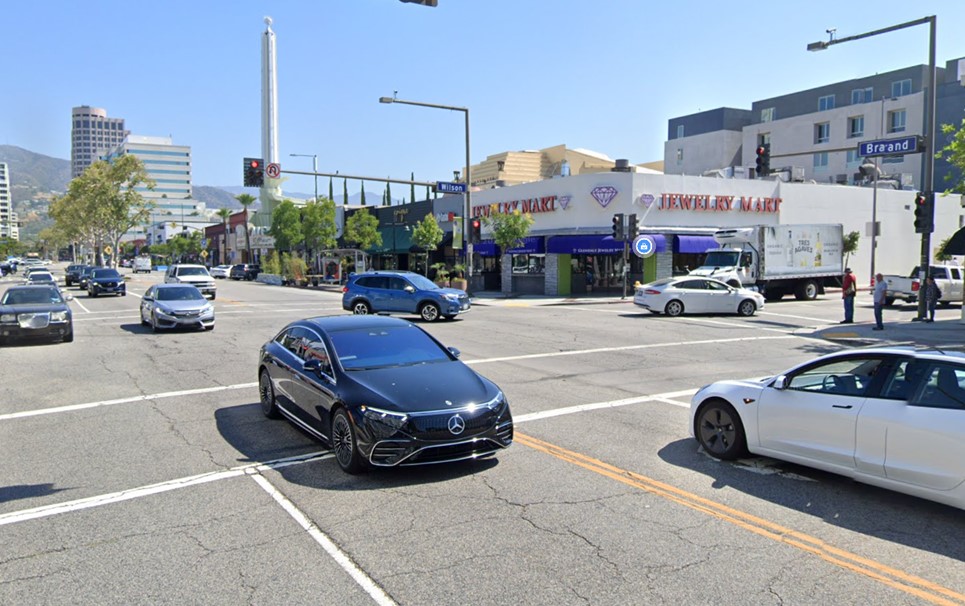 |
|
| (2024)* – Contemporary view of the intersection of Brand and Wilson showing the tower of the Alex Theatre in the background. |
Then and Now
 |
|
| (1955 vs. 2022)* - The intersection of Brand Boulevard and Wilson Avenue with the tower of the Alex Theatre seen in the background. |
* * * * * |
Webb's Department Store
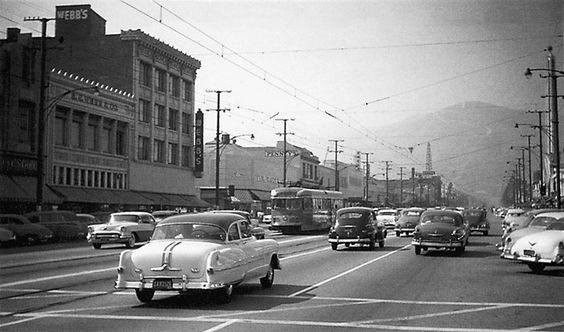 |
|
| (ca. 1955)* – View looking north on Brand Boulevard with Webb’s Department Store is seen at left on the southwest corner of Brand Boulevard and Wilson Avenue. |
Historical Notes Webb’s department store was the cornerstone of shopping for the Glendale community. It was locally owned and operated and expanded to several other buildings nearby. Harry S. Webb came to Glendale in 1916 from Chicago, convinced that California offered a great opportunity for a department-store business. His first Webb’s store was near the corner of Brand Boulevard and Broadway. |
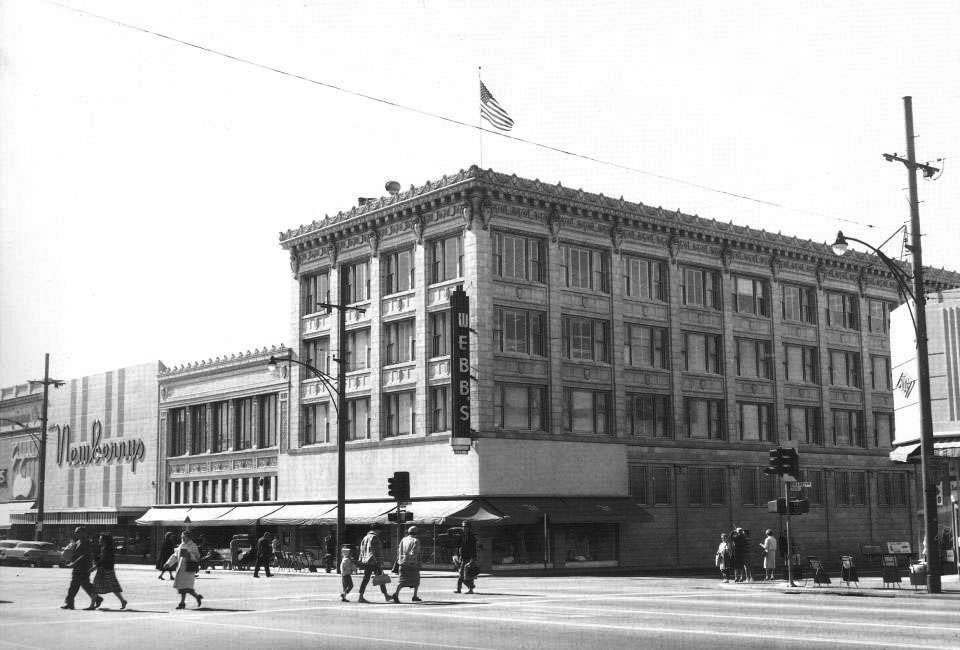 |
|
| (1962)* – View looking at the intersection of Brand Boulevard and Wilson Avenue, showing Webb's Department Store standing on the southwest corner. Newberry's Department Store is seen further south on the left. |
Historical Notes For nearly 50 years after its founding, Webb's was the only major department store in Glendale. But it began to get competition--first from Robinson's when it opened at the Fashion Center in 1966 and later from stores in the Galleria, which opened in two phases, in 1976 and 1982. With the Galleria's completion, shoppers in Glendale could choose from among such department stores as The Broadway, Buffum's, J. C. Penney, Mervyn's and Nordstrom's. |
* * * * * |
Bruce's Fun House
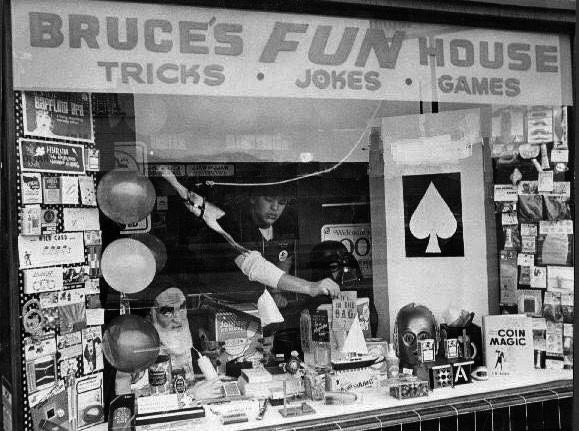 |
|
| (n.d.)* - View looking through the display window of Bruce’s Fun House located on Wilson Ave between Brand Blvd and Orange St. |
* * * * * |
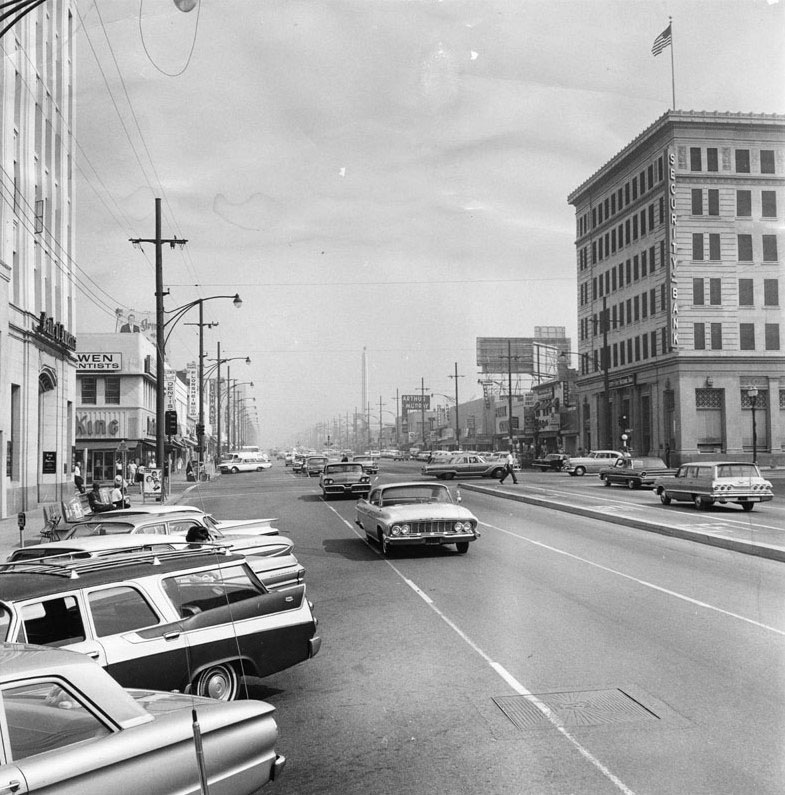 |
|
| (1963)^ – View looking north on Brand Boulevard at Broadway. Click HERE for contemporary view. |
 |
.jpg) |
|
| (ca. 1924)^ - View looking north on Brand Boulevard at Broadway. | (1963)^ – View looking north on Brand Boulevard at Broadway. |
* * * * * |
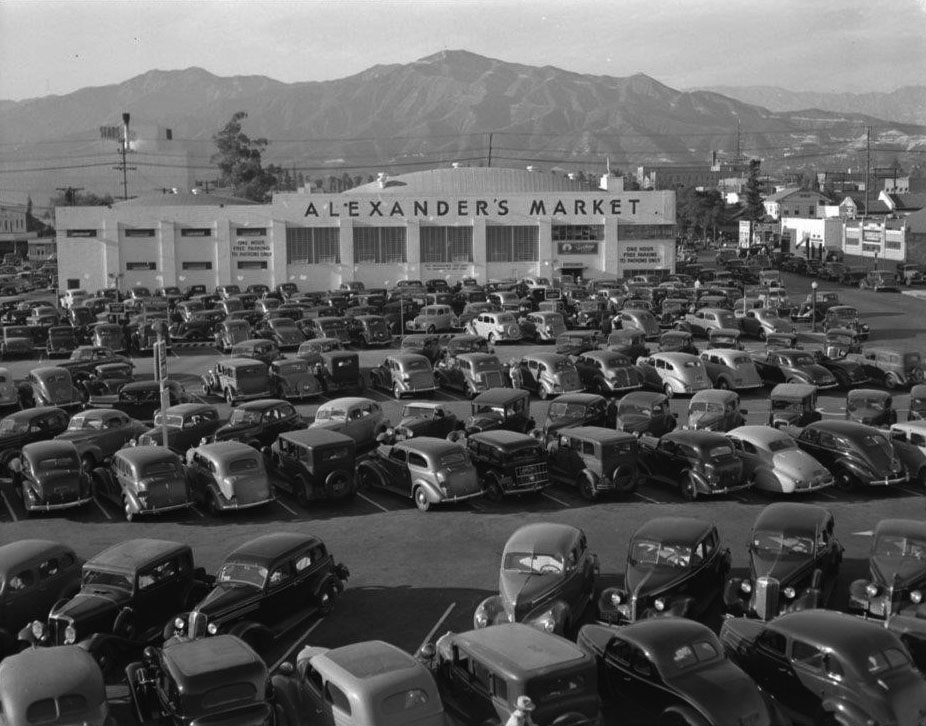 |
|
| (ca. 1940)* – View looking north showing a full parking lot in front of Alexander’s Market on Orange Street. |
Historical Notes In the 80s it was House of Fabrics, and then Joann's fabrics after that. |
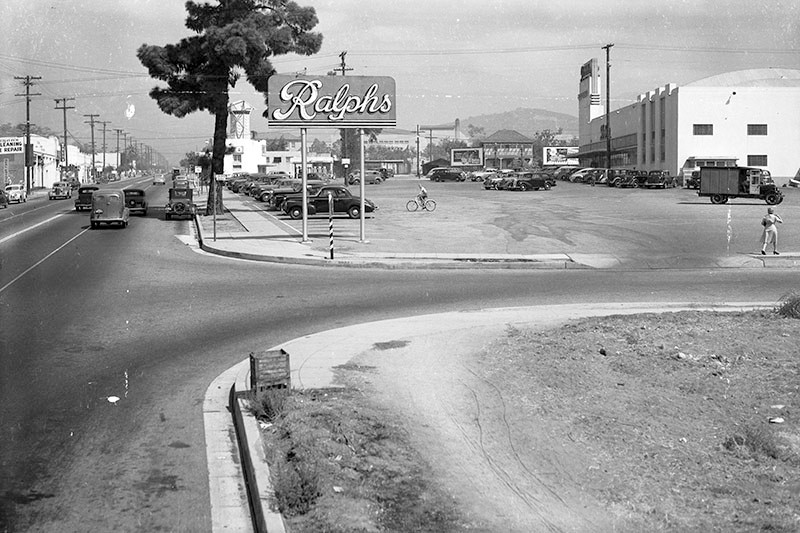 |
|
| (1946)^ – View looking north on Verdugo Road at Dixon Street in Glendale, showing various businesses on the left and a large Ralphs supermarket (right). At the northern end of the parking lot is a Van De Kamp's windmill-shaped bakery (upper left) and a Shell service station. |
Historical Notes This corner is still occupied by a Ralphs supermarket, but the Art Deco structure, designed by Stiles Clements, has since been demolished and replaced with a larger store. Click HERE for contemporary view. |
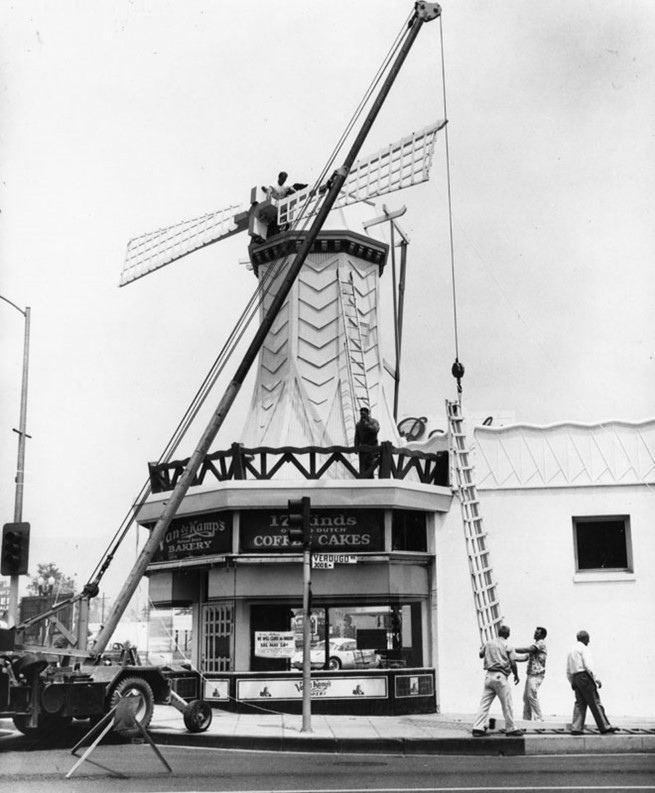 |
|
| (n.d.)* - Van de Kamp's Bakery on the SE corner of Verdugo Road and Colorado Street. Workers are assembling the windmill on top. A sign in the window says the bakery will be closed Saturday, May 28. |
* * * * * |
Snowbird Ice Cream (later Baskin-Robbins)
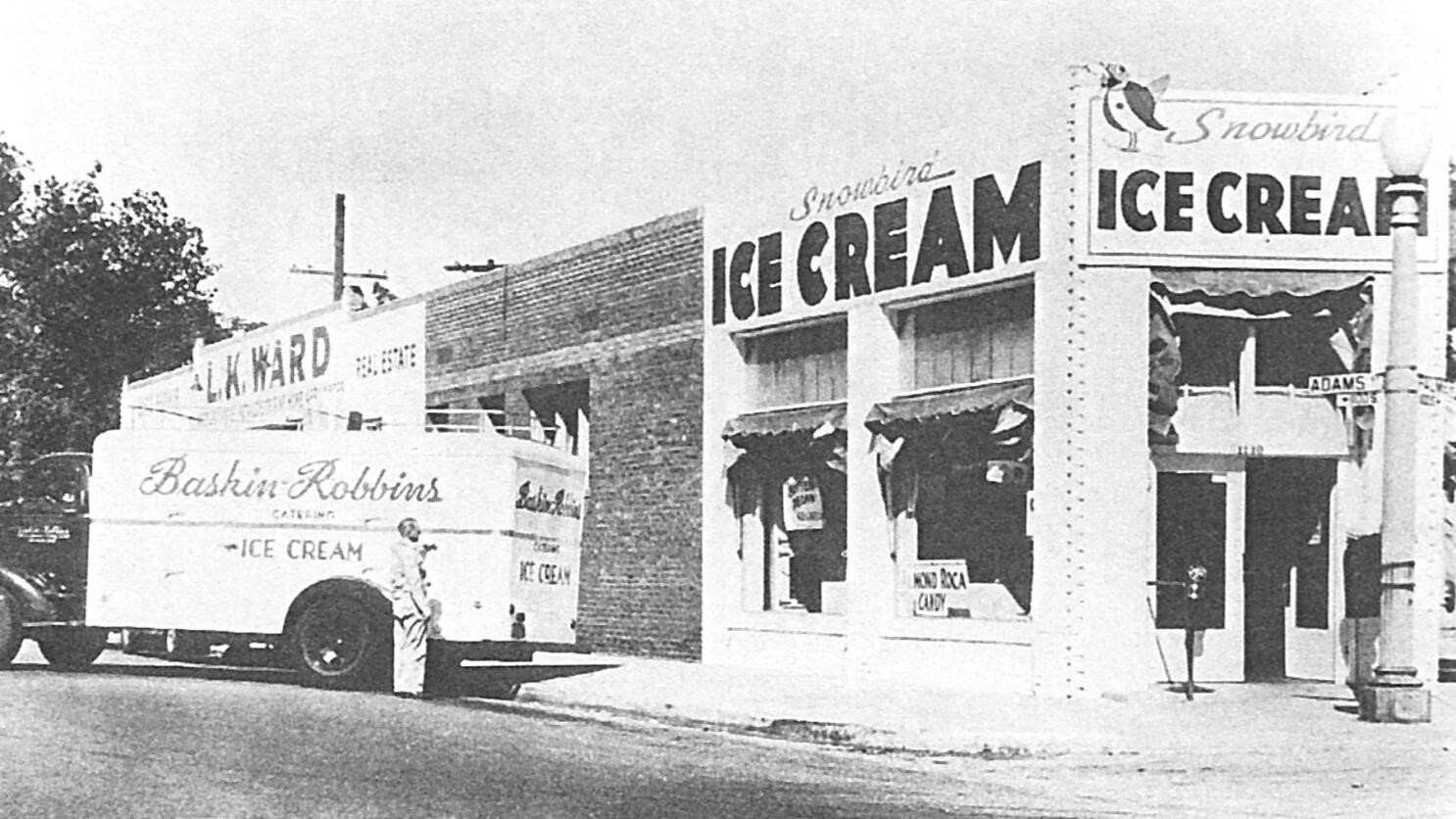 |
|
| (1948)* - Baskin-Robbins originally Snowbird Ice Cream, 1130 South Adams Street, Glendale. The building on the corner of Adams Street and Palmer Ave still exists. Click HERE for contemporary view. |
Historical Notes Baskin-Robbins originated as separate ice cream ventures by Burt Baskin and his borther-in-law Irv Robbins: Burton's Ice Cream Shop and Snowbird Ice Cream, respectively. Snowbird, offering 21 flavors, merged with Burton's in 1953, expanding to 31 flavors. By 1948, they had six stores and began franchising. The first franchise was in Glendale in the store seen above. In 1953, the company adopted the 31 flavors theme and a circus-inspired design. The company name evolved from Huntington Ice Cream Company to Baskin-Robbins. The founders owned the company until its acquisition by United Brands in 1967. The brand went international in the 1970s and introduced ice cream cakes to the public. |
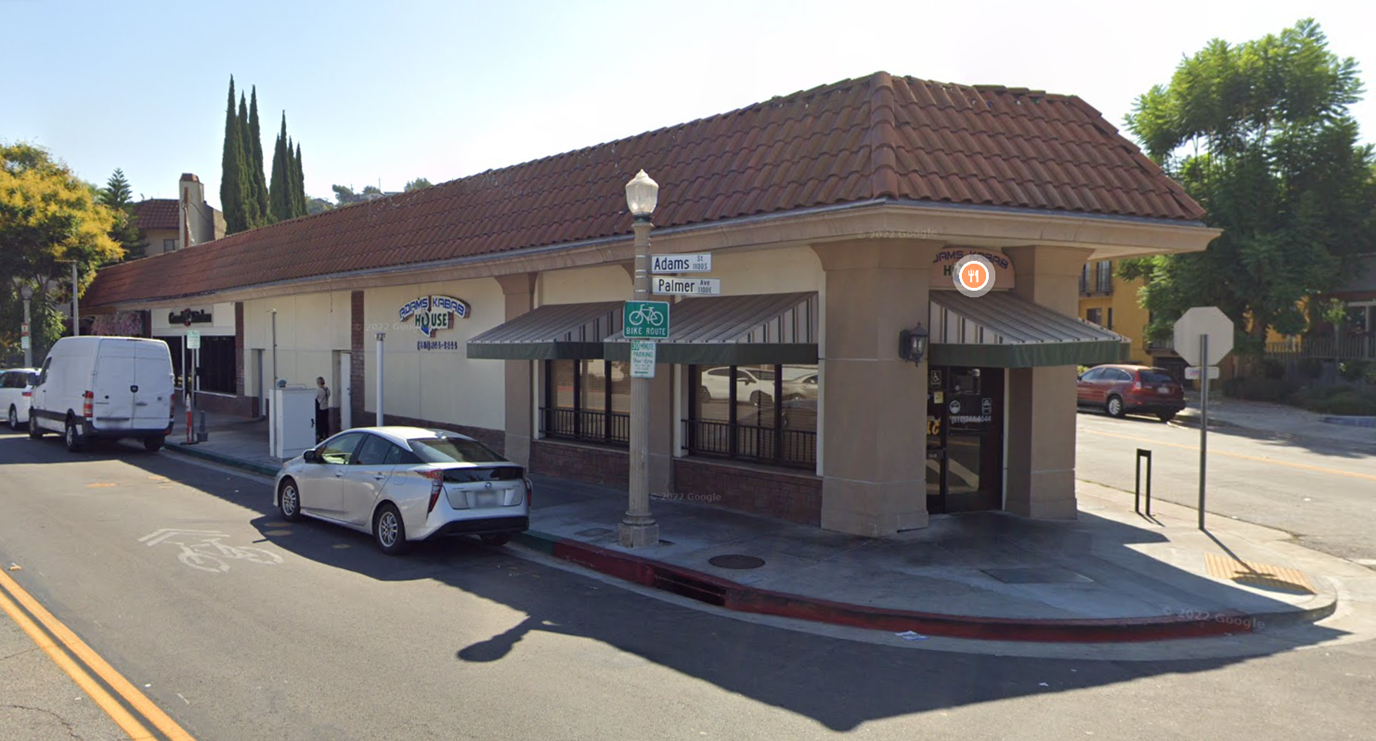 |
|
| (2022)* - Looking west toward the building on the corner of Adams Street and Palmer Avenue in Glendale. Once occupied by Snowboard Ice Cream and later the first Baskin-Robbins franchise, it is now home to the Adams Kabob House Restaurant |
Historical Notes The first franchise was established on May 20, 1948, in Glendale (in the building seen above), and by 1953, the company adopted the Baskin-Robbins name and introduced the iconic "31 flavors" concept. Known for its innovative approach, Baskin-Robbins has introduced over 1,300 flavors since 1945 and created themed flavors for special events. |
Then and Now
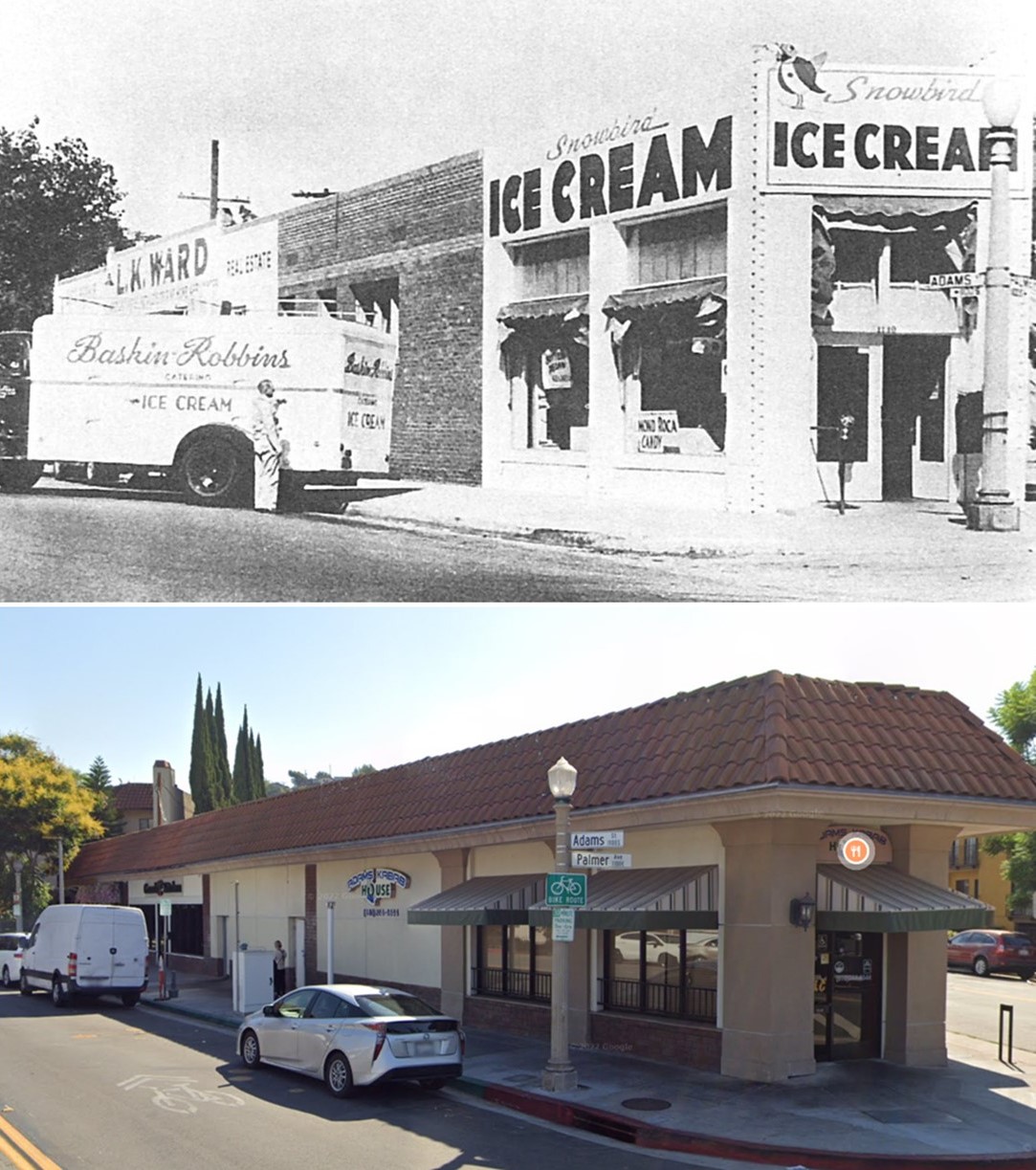 |
|
| (1948 vs 2022)* - Looking west toward the building on the corner of Adams Street and Palmer Avenue in Glendale. Once occupied by Snowboard Ice Cream which later became the first Baskin-Robbins franchise, it is now home to the Adams Kabob House Restaurant |
Historical Notes Baskin-Robbins went through several ownership changes, including acquisitions by United Fruit, J. Lyons and Co., and Allied Domecq. In 2006, private equity firms purchased Baskin-Robbins, and Dunkin' Brands became independent in 2012, later acquired by Inspire Brands in 2020. Today, Baskin-Robbins has over 8,000 locations worldwide, has introduced vegan and non-dairy flavors, and launched a new logo and tagline, "Seize the Yay," in 2022. The company's success is attributed to its commitment to flavor innovation, quality, and adaptability to changing consumer preferences. |
* * * * * |
Vogue Theatre
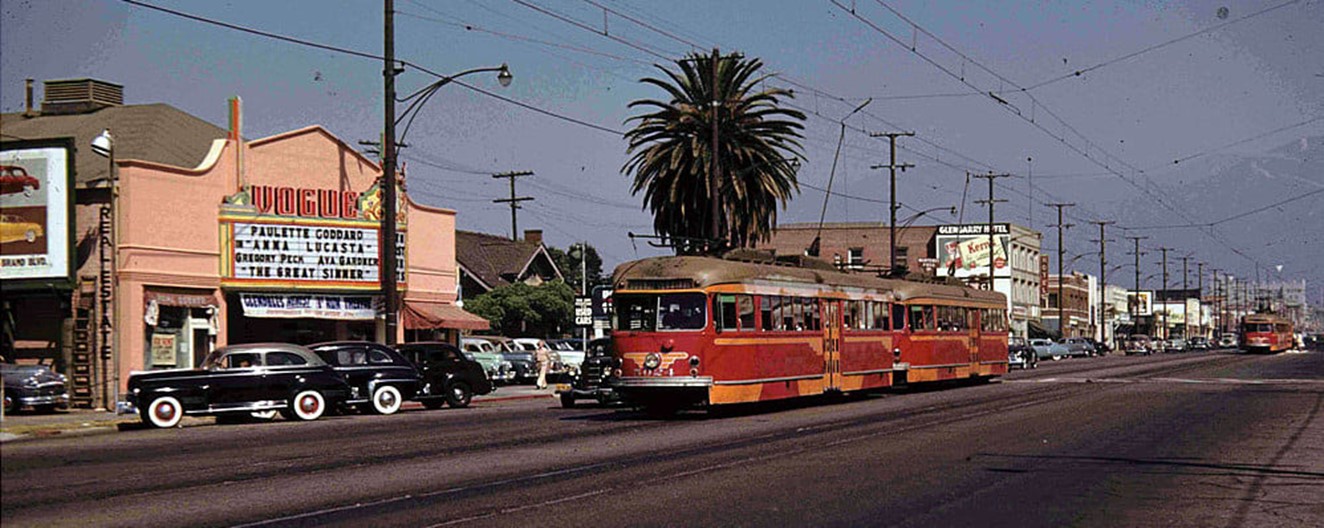 |
|
| (1949)* - Two coupled Pacific Electric streetcars pass the Vogue Theatre at 735 S. Brand Boulevard. |
Historical Notes The Vogue Theatre was a short-lived movie theater in Glendale, operating from 1941 to approximately 1955. Located at 735 S. Brand Boulevard, it was designed by architect Paul Hartman and opened on November 11, 1941, with a seating capacity of 735. Situated on the west side of Brand Boulevard, just north of Windsor Road, the theater was operated by Grover Smith, who also managed the nearby Cosmo Theatre. The Vogue's final known newspaper listing appeared on April 20, 1955, featuring Kiss Me Kate and Valley of the Kings. After its closure, the building underwent significant renovations and repurposing. Today, it houses part of a Nissan car dealership, with its original architectural features largely obscured by extensive modifications. Two Pacific Electric streetcars coupled together in early Southern California were commonly referred to as a "two-car train" or a "double-header." This coupling allowed for increased passenger capacity on popular routes, and each car would have its own motorman and conductor to handle the additional load and ticketing efficiently. |
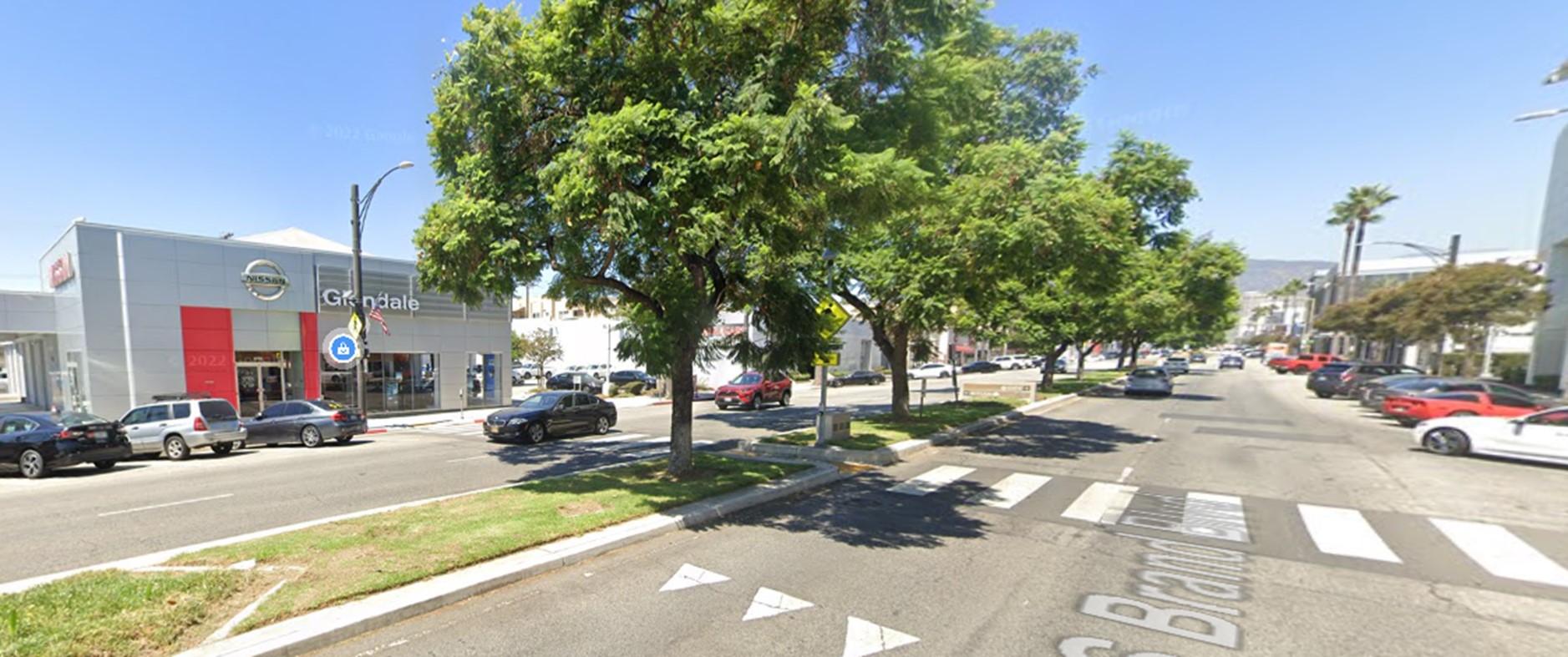 |
|
| (2022)* - Looking toward the Glendale Nissan showroom, formerly the site of the Vogue Theatre. |
Historical Notes Today, the former site of the Vogue Theatre at 735 S. Brand Boulevard in Glendale, is occupied by a Nissan car dealership. The building, once a vibrant movie theater, has been extensively modified, with the front now serving as a showroom for Glendale Nissan. The former auditorium area is likely used for support services or office space, as evidenced by new door configurations along the building's sides. While the original building’s shell may remain, the iconic marquee is gone, and the structure’s original architectural features are largely unrecognizable. Interestingly, an adjacent auto body shop at 737 Brand Boulevard, built in 1941, aligns with the theater's construction date. |
 |
|
| (1949 vs 2022)* - Looking toward the Vogue Theatre at 735 S. Brand Boulevard, now the site of the Glendale Nissan showroom |
* * * * * |
Towers Motors
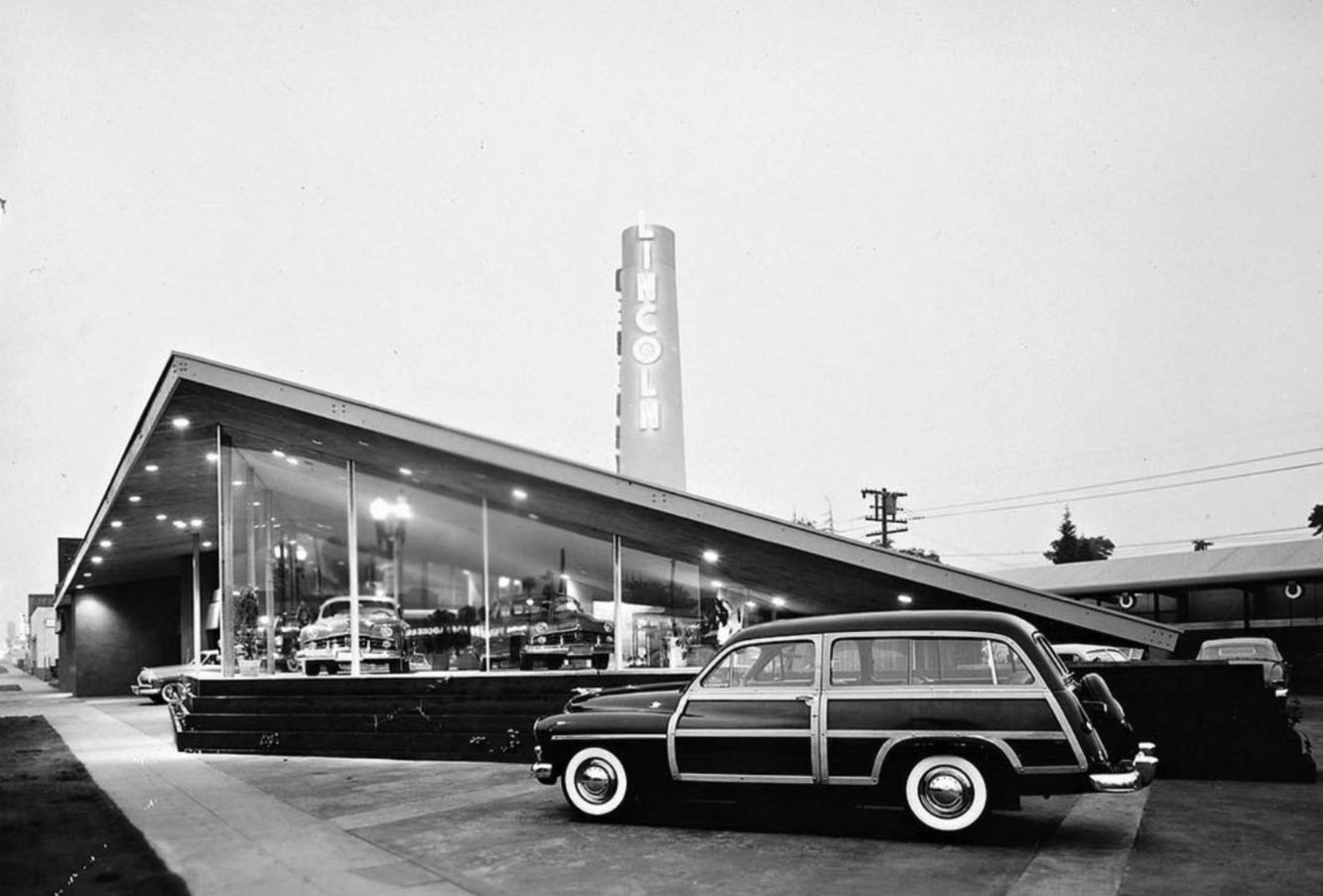 |
|
| (1949)* – View showing Towers Motors, a Lincoln Mercury dealership located on Colorado Street in Glendale. |
Historical Notes The Googie-style building located at 600 E. Colorado Street was designed by John Lautner. This beautiful building no longer stands. The price for a brand new 1949 Mercury woody wagon (as seen above) was a whopping $2,500.00. |
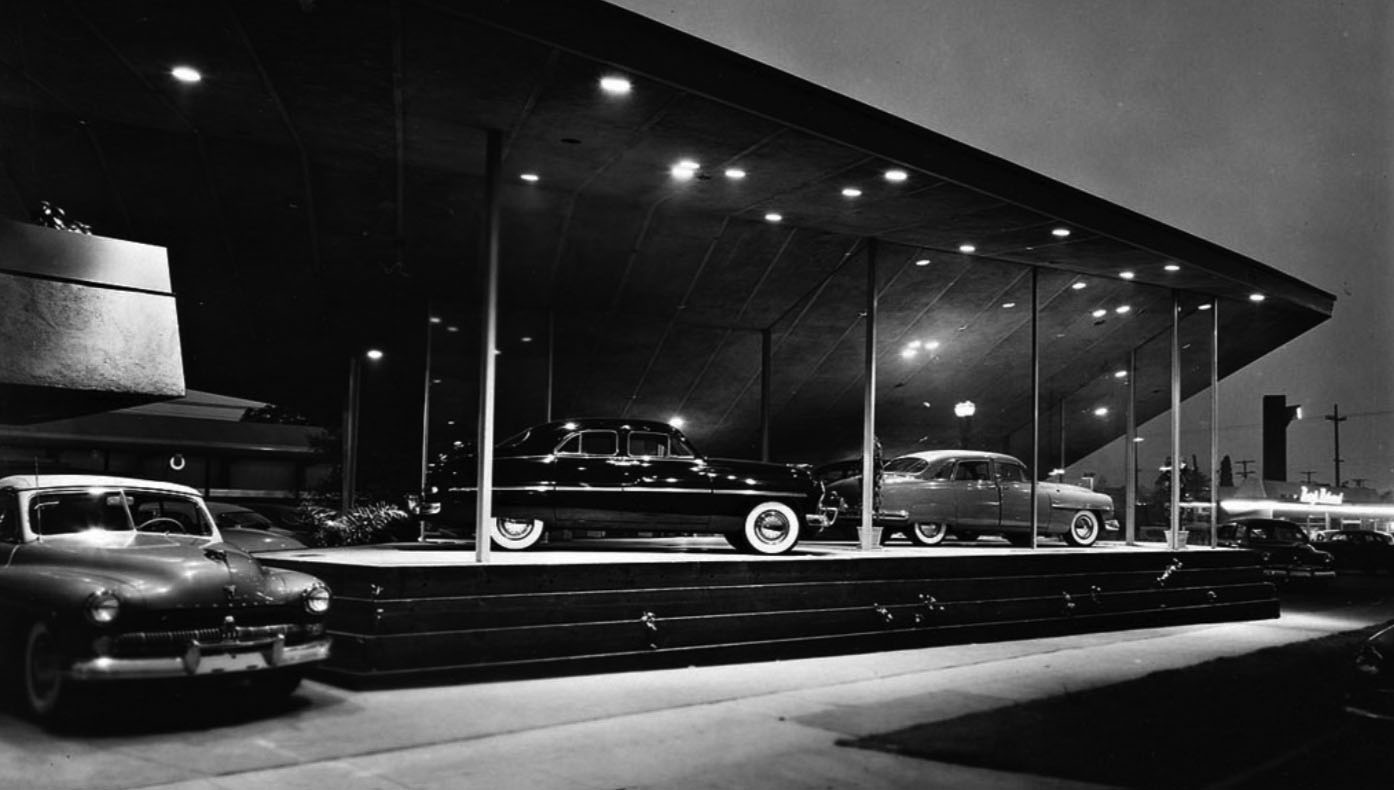 |
|
| (1949)* – Exterior night view showing the beautiful Towers Motors showroom, 600 E. Colorado Street, Glendale. Photo by Julius Shulman |
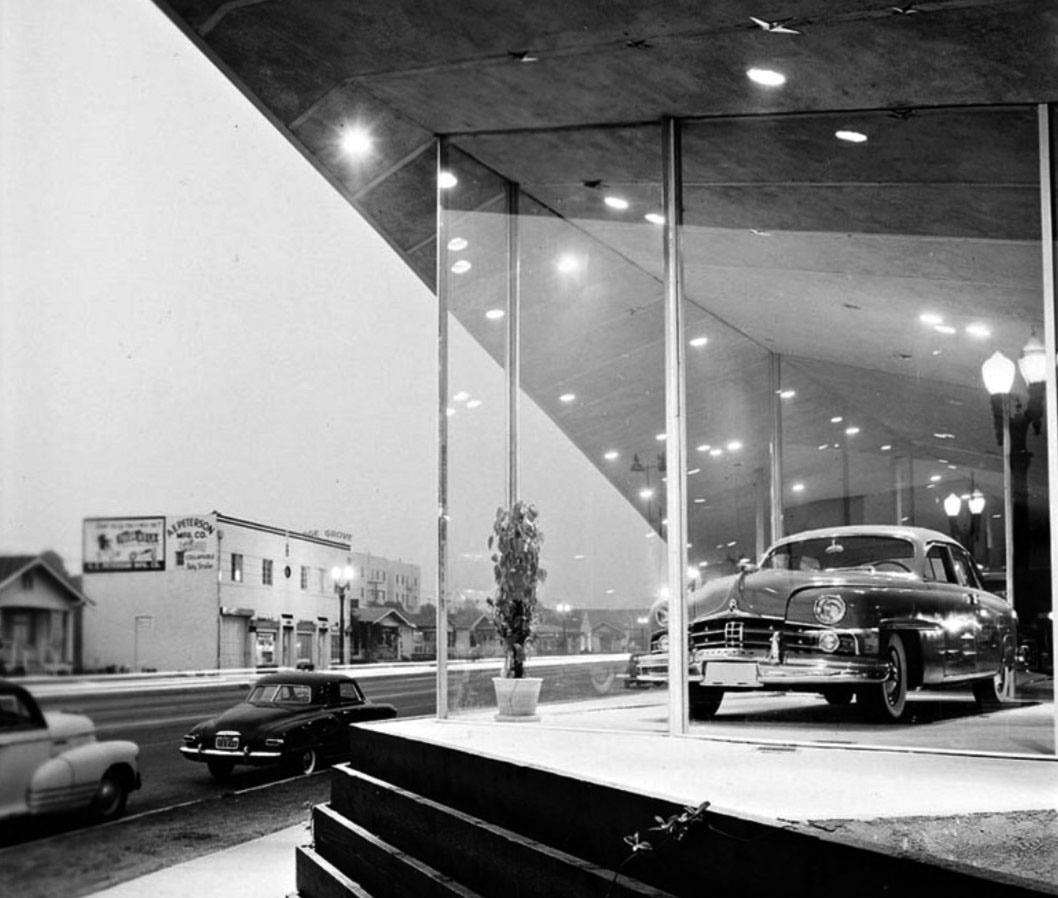 |
|
| (1949)* – Close-up view, looking southwest, showing the Towers Motors showroom with Colorado Street seen in the background. |
* * * * * |
Bob's Pantry (Original Bob's Big Boy)
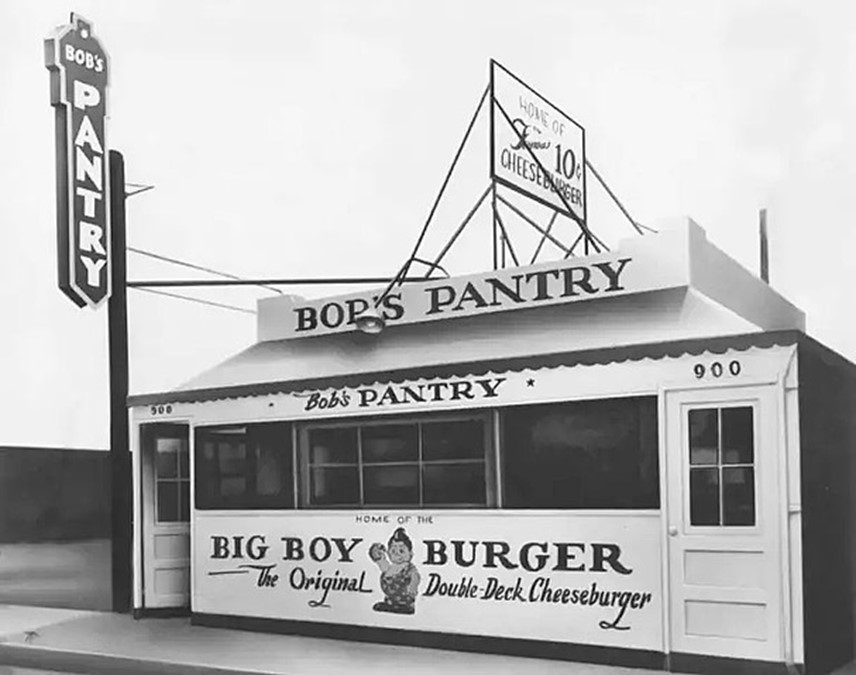 |
|
| (ca. 1936)* - Bob’s Pantry, located at 900 E. Colorado Street in Glendale. This site would later become the first location of Bob's Big Boy Drive-in. |
Historical Notes Bob's Big Boy, originally called Bob’s Pantry, was a 10-stool hamburger stand at 900 E Colorado St in Glendale. It was opened for $350 by 23-year-old former busboy Bob Wian, who raised the money by selling his car. |
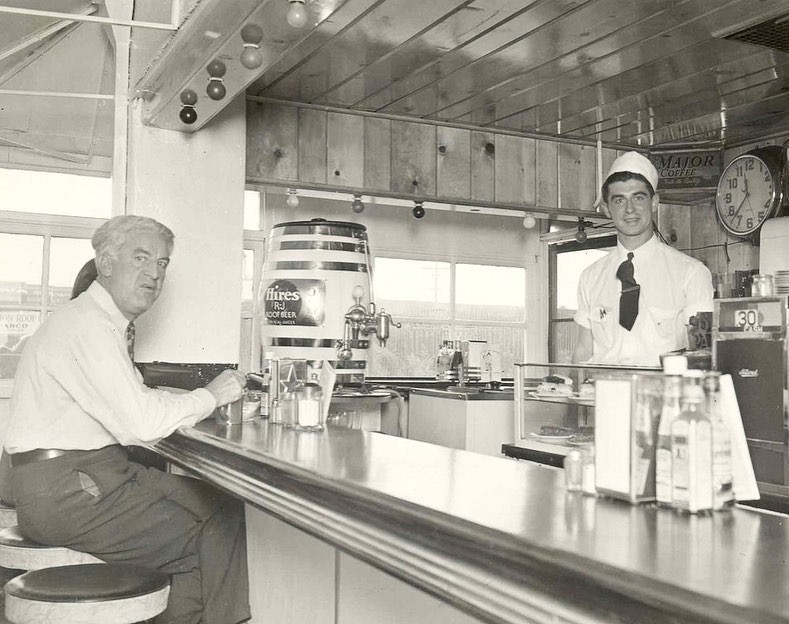 |
|
| (1930s)* - An interior view of Bob’s Pantry at 900 E. Colorado Street in Glendale, featuring a young Bob Wian behind the counter. |
Historical Notes In the early months of 1937, about six months into operation, one of Bob Wian's friends walked into the joint and reportedly asked for a different kind of hamburger. Jokingly, Wian added a second patty with a bun in between, inventing the double-decker burger, which to his surprise, suddenly took off. According to legend, Wian named the sandwich the Big Boy Burger after six-year-old customer Richard Woodruff, who used to come in on his own and stay at the counter eating multiple burgers until his grandmother would come in and drag him out. Woodruff also became the restaurant's original mascot after another regular customer, Warner Bros. animation artist Ben Washam, doodled the kid's caricature on a napkin one day while eating lunch. Wian saw it and asked to buy it, but Washam gave it to him for free. |
Bob's Big Boy (900 E. Colorado Street)
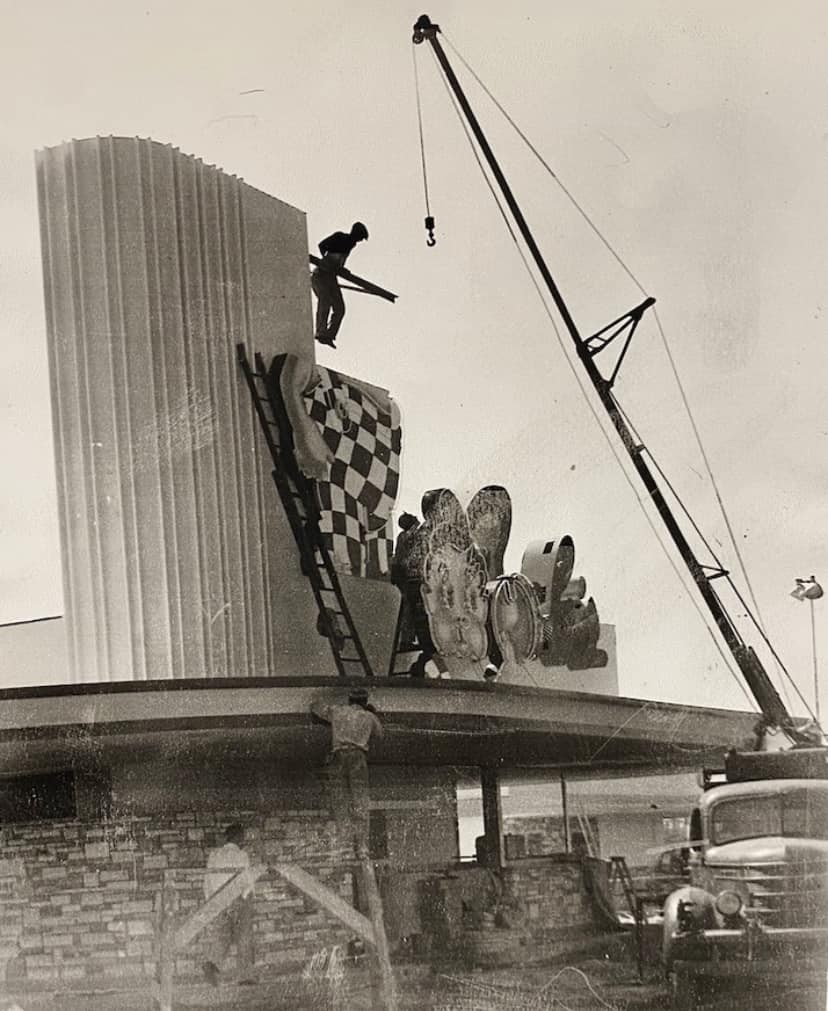 |
|
| (1940s)* - A man is dangling on a beam, waiting for the 'Big Boy' mascot sign to be raised and set at the new Bob’s Big Boy Drive-In located at 900 E. Colorado Street in Glendale. Bruce B. Hermann Collection |
Historical Notes The original Bob's Big Boy, initially called Bob's Pantry, was founded by Bob Wian in 1936 at 900 E Colorado St, Glendale. This location started as a 10-stool hamburger stand and quickly grew into a full-service drive-in restaurant, becoming a local landmark with its eye-catching neon lights in the 1940s. |
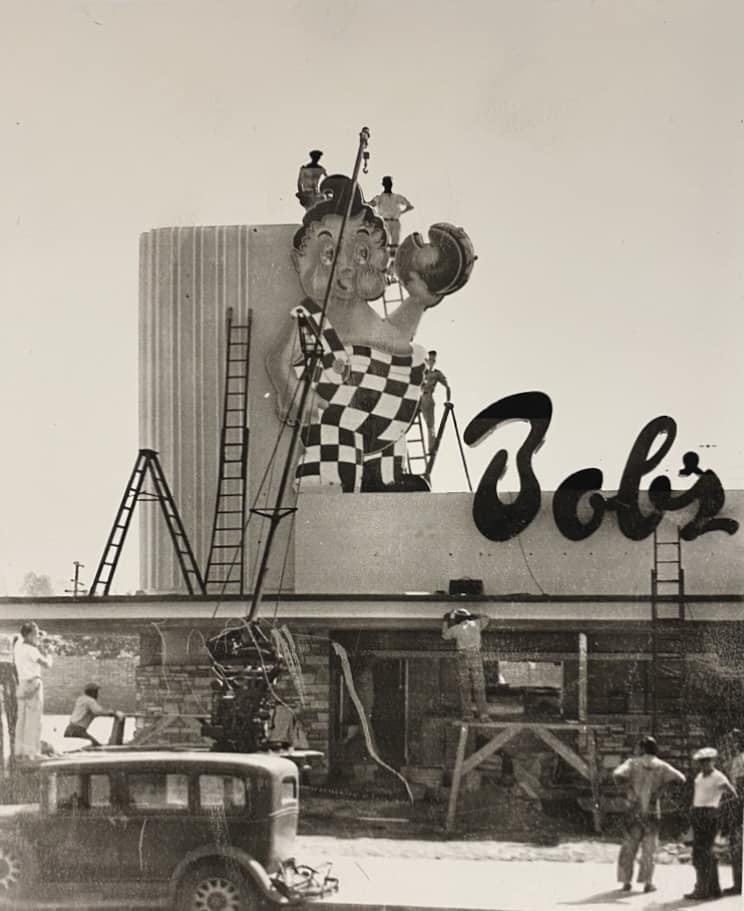 |
|
| (1940s)* - Workmen with wooden ladders and a vintage crane are pictured here, having just hoisted and secured the giant pieces of the Big Boy sign at the newly constructed Bob’s Big Boy Drive-in. Bruce B. Hermann Collection |
Historical Notes The chain is best known for its trademark chubby boy in red-and-white checkered overalls holding a Big Boy sandwich (double-decker cheeseburger). The inspiration for Big Boy's name, as well as the model for its mascot, was Richard Woodruff (1936–1986), of Glendale, California. When he was six years old, he walked into the diner Bob's Pantry as Bob Wian was attempting to name his new hamburger. Wian said, "Hello, Big Boy" to Woodruff, and the name stuck. |
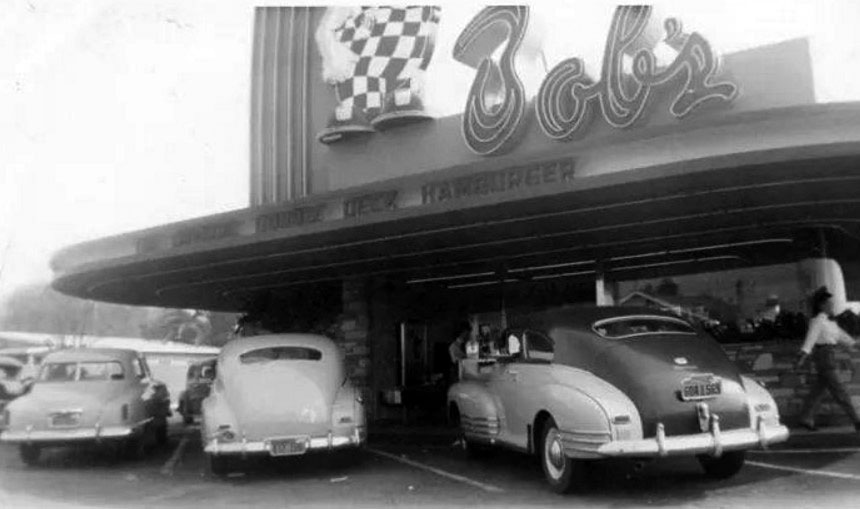 |
|
| (ca. 1949)* – View showing Bob’s Big Boy Drive-in restaurant located at 900 E. Colorado in Glendale. |
Historical Notes The Glendale location, like other Bob's Big Boy restaurants, became a cultural icon over the years. It served as a popular hangout spot for families, teenagers, and car enthusiasts, contributing to the local community's social fabric. |
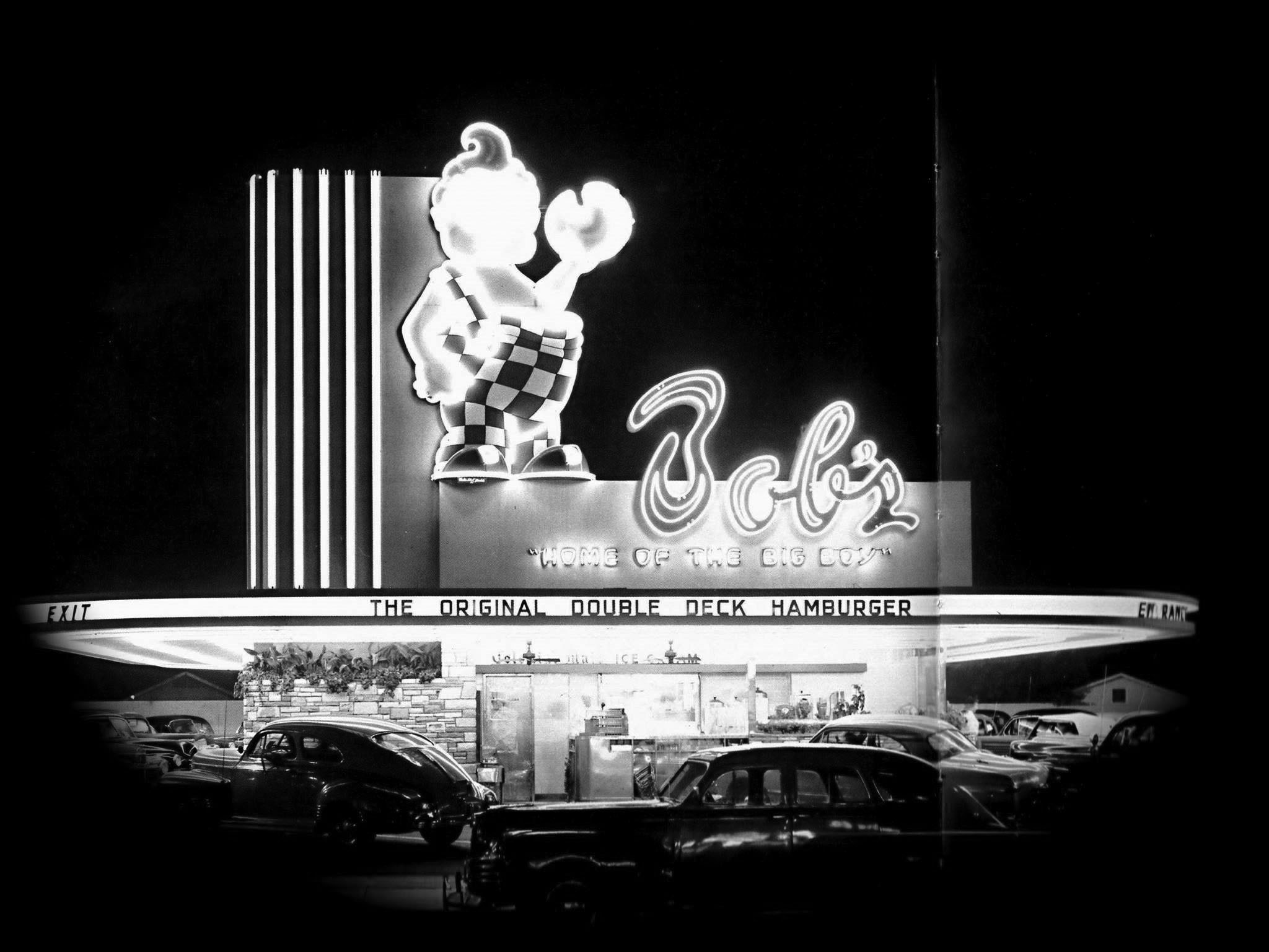 |
|
| (ca. 1949)* – Night view showing a very crowded Bob’s Big Boy Drive-in Restaurant at 900 E Colorado in Glendale. |
Historical Notes The architect behind the design of the original Bob's Big Boy was Wayne McAllister. McAllister was a renowned architect who played a significant role in shaping the iconic look of Bob's Big Boy restaurants. |
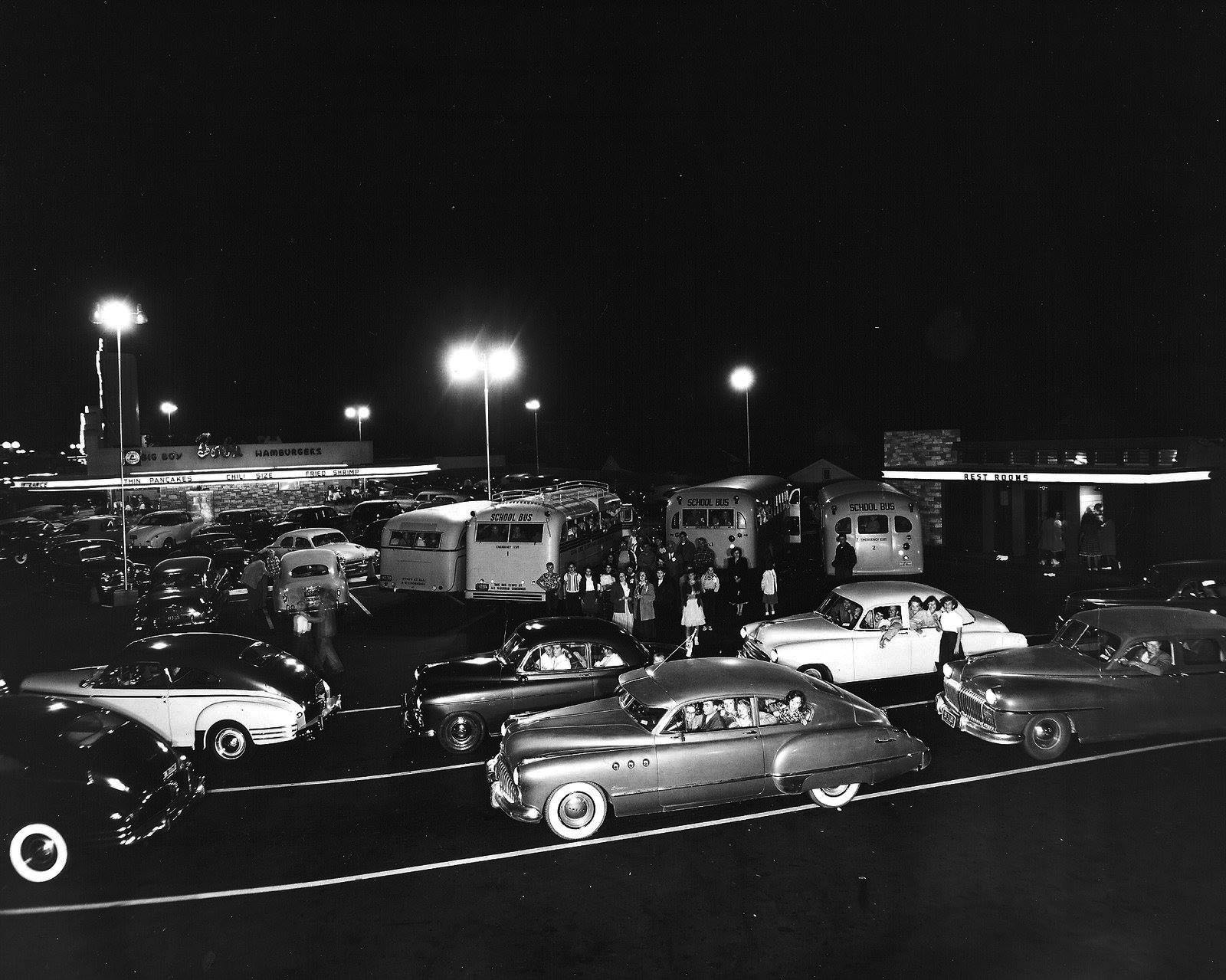 |
|
| (ca. 1950)* - Proof positive that Bob's was the place to be in the early 1950's! This picture shows the mob, and line of cars waiting to get into the "twin drive in and coffee shop" at 900 E. Colorado, Glendale. |
Historical Notes Bob’s Big Boy became a cultural icon for Glendale teenagers in the 1940s up until the 1970s. After the widely popular Glendale and Hoover High School football games, lines of cars filled with local students would eat at Bob’s Big Boy on Colorado Street. The original location at 900 E Colorado St was eventually demolished, and what stands there now is a typical Californian mini mall. Other Bob's Big Boy locations in Glendale, such as those at 3212 La Crescenta Ave and 115 W Broadway, have also been transformed and no longer serve as Bob's Big Boy restaurants. In 1967, Bob Wian sold Bob's Big Boy to Marriott Corporation for $7 million. At that time, the chain had already expanded significantly, and Marriott continued to grow it, reaching a peak of about 1,200 locations. However, by the late 1980s, Marriott sold the Big Boy trademark to Elias Brothers, who then faced financial difficulties, leading to a bankruptcy filing in 2000. Today, the Big Boy chain operates about 70 locations in the United States, with five of those in Southern California: Burbank/Toluca Lake at 4211 W. Riverside Drive, Burbank |
Bob's Big Boy (Broadway Ave)
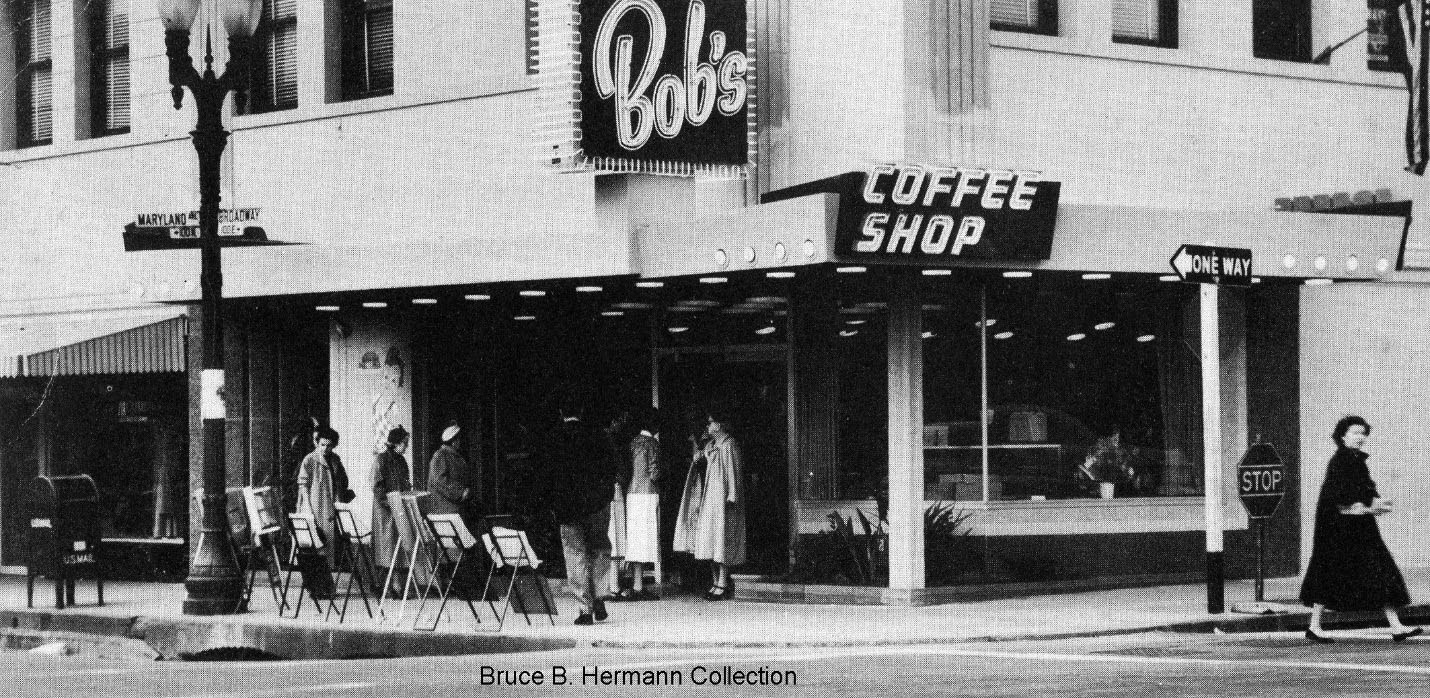 |
|
| (1950s)* - Bob's number four location at the northwest corner of Broadway and Maryland in Glendale. Photo courtesy of Bruce B. Hermann |
Historical Notes Opened May 17, 1948 rebuilt and reopened December 1956 at 121 E. Broadway Ave. The building still stands, but many remodeling jobs over the years have left it unrecognizable. It now houses a Chinese restaurant. Click HERE for contemporary view. |
* * * * * |
Currie's Ice Cream
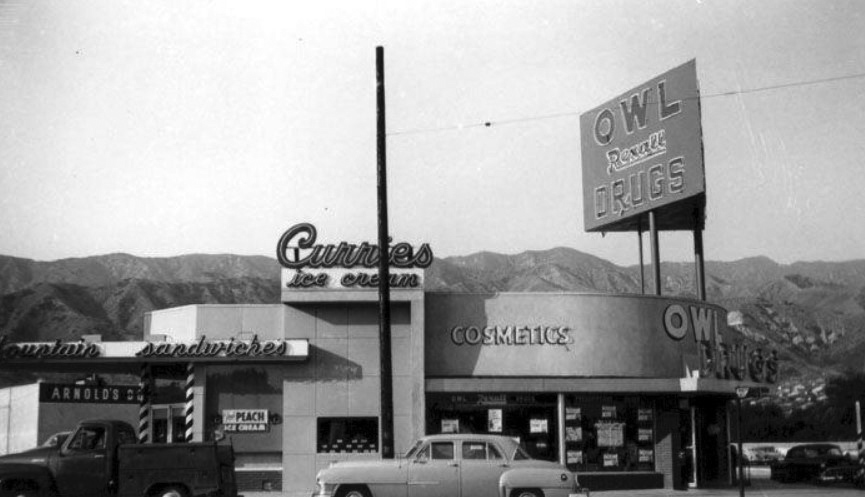 |
|
| (1960)* - View showing Currie’s Ice Cream and an Owl Drugs store located at the northwest corner of Glenoaks Boulevard and Irving Avenue, Grandview Neighborhood of Glendale. |
Historical Notes The above building is still there. Click HERE for contemporary view. |
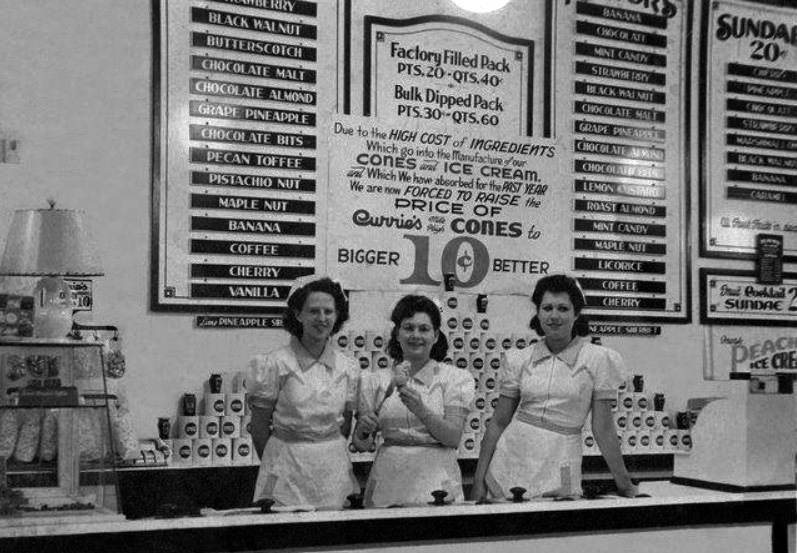 |
|
| (n.d.)* - Interior view of Currie’s. 40 cents for a quart of ice cream and they're apologizing for having to raise the prices. Yikes! |
Historical Notes The Currie's Ice Cream chain was started in 1927 by three brothers named Kuhns. After WWII they sold it to the Good Humor Company who later sold it to Lipton in the 1960s. In 1964 the chain opened its 87th store, in North Hollywood. Although Currie’s anticipated launching units in every community in Southern California, only three outlets were listed in the 1967 Los Angeles phone book and the chain had disappeared by the 1980s.* |
Candlelite Inn
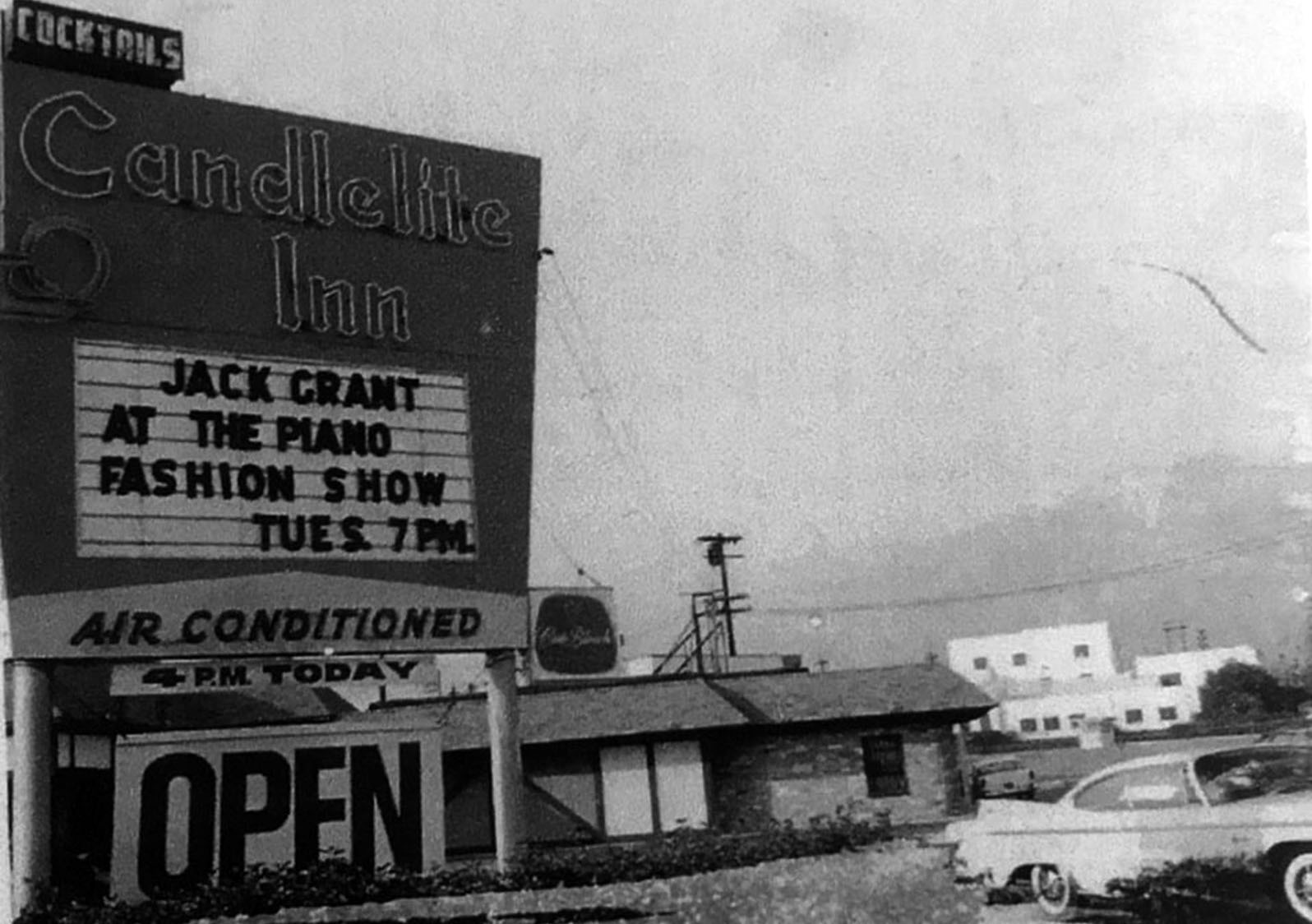 |
|
| (ca. 1963)* - Candlelite Inn located at 6100 San Fernando Road, NW corner of Grandview and San Fernando Rd. |
* * * * * |
Great White Hut
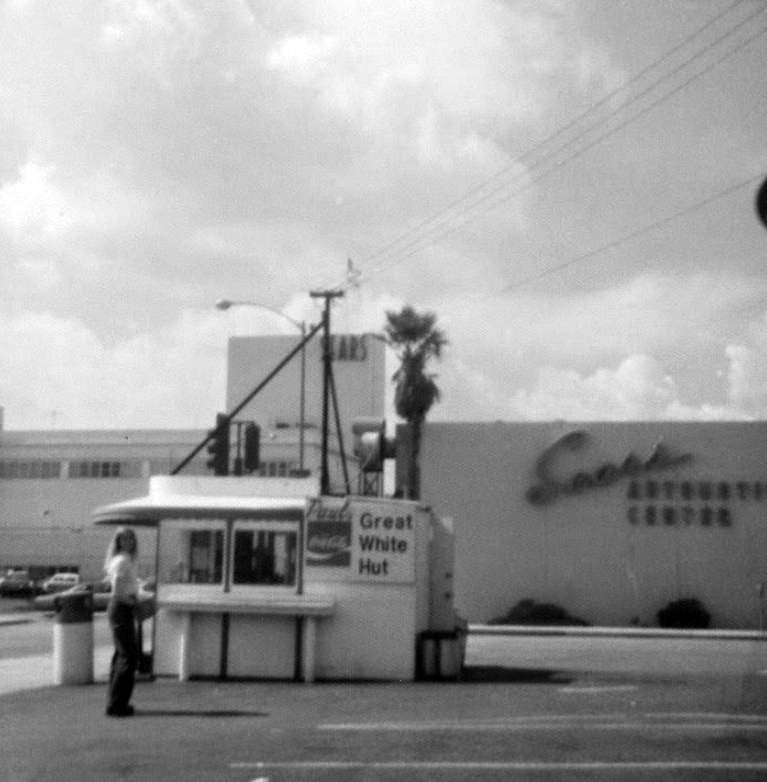 |
|
| (1970s)* – A young woman standing near the Great White Hut looks toward the camera with Sears Building seen in the background. Address: 121 W. California Avenue, Glendale. |
Historical Notes Since 1947, The Great White Hut has been located on the corner of Orange and California in Glendale. Staying open until 3am, it really becomes a great white beacon of hope after the bars let out and you realize IN N OUT has long since closed. For such a tiny spot, its menu is surprisingly large. |
 |
|
| (2017)* – Close-up side view of The Great White Hut as it appears today. Sign on top reads NOW OPEN LATE! Friday & Saturday: 8AM – 3AM |
Historical Notes The Great White Hut is a tiny little building in the corner of a parking lot, white walls with bright blue trim, surrounded on three sides with a black-and-white checker-board tile counter. Stools with blue posts and red seats, shaded by a blue-and-white awning. |
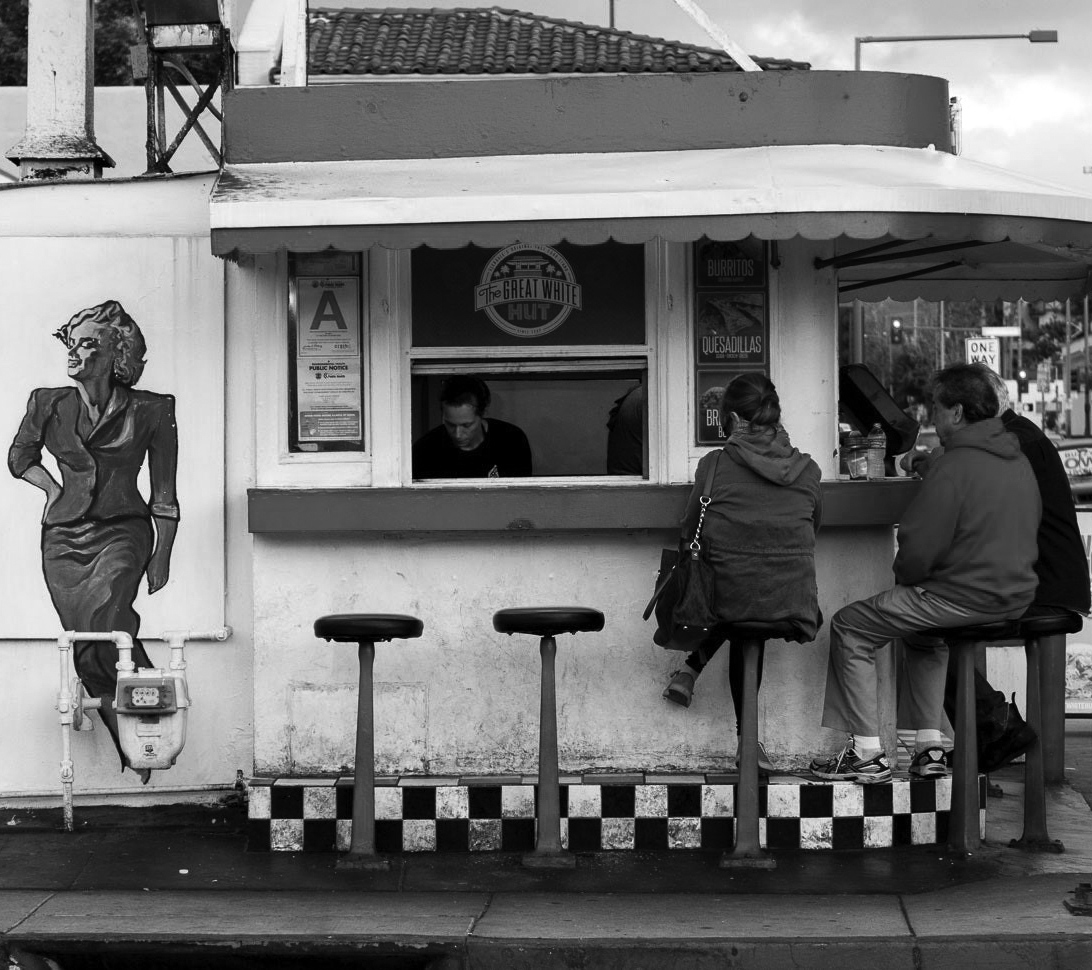 |
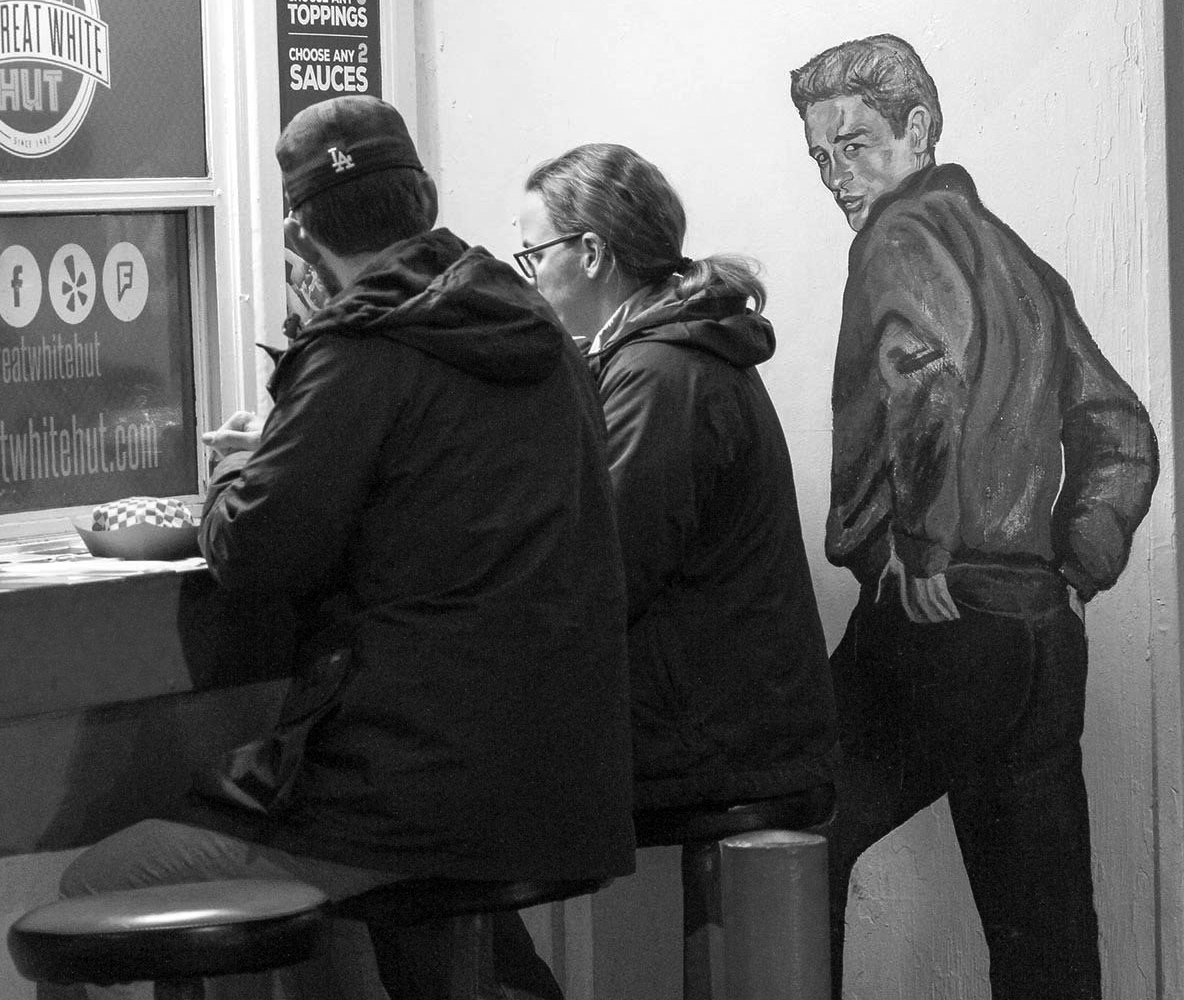 |
|
| (ca. 2019)* - Great White Hut with life-size murals of Marilyn Monroe and James Dean |
Historical Notes Painted on one side of the Hut is a life-sized portrait of James Dean, and on the other side is a portrait of Marilyn Monroe. Click HERE to see Contemporary Google View. |
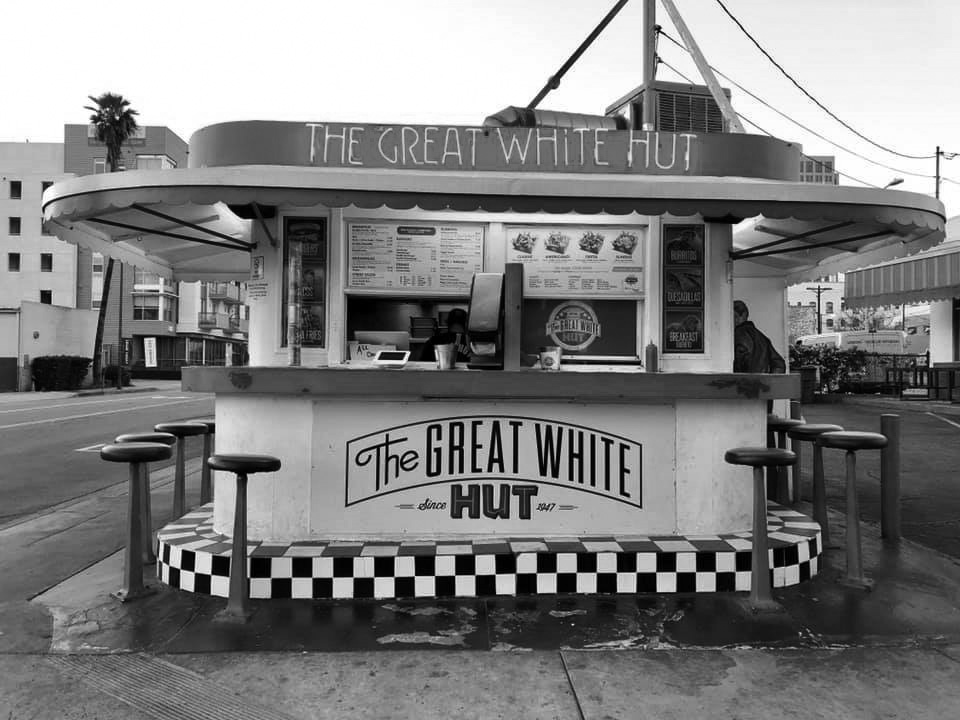 |
|
| (2020)* – The Great White Hut, outsie seating lunch counter since 1947. Photo by Gerson Medina |
Henry's Restaurant
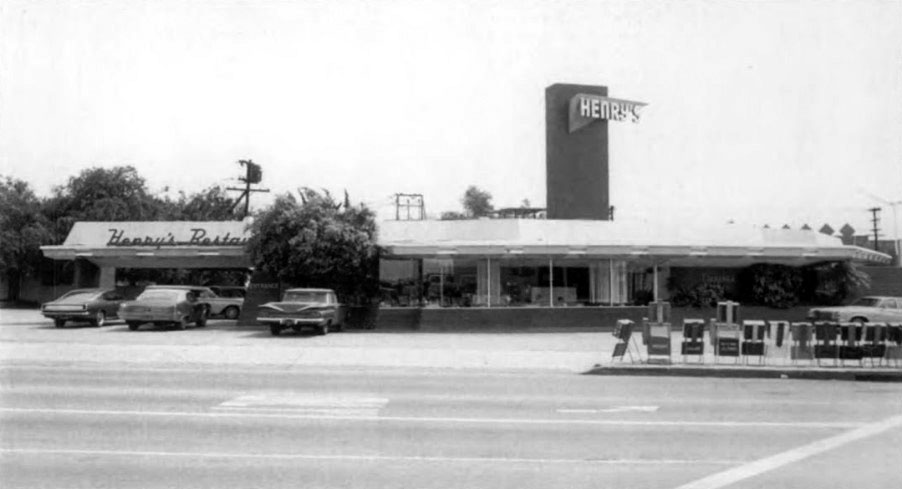 |
|
| (1977)*^* – View showing Henry’s Restaurant located on the SE corner of Colorado Street and Glendale Avenue. |
Historical Notes Henry's was known for its "Chicken in the Rough" meal. Also for its Fried Chicken Livers and Gizzards. Click HERE to see menu. |
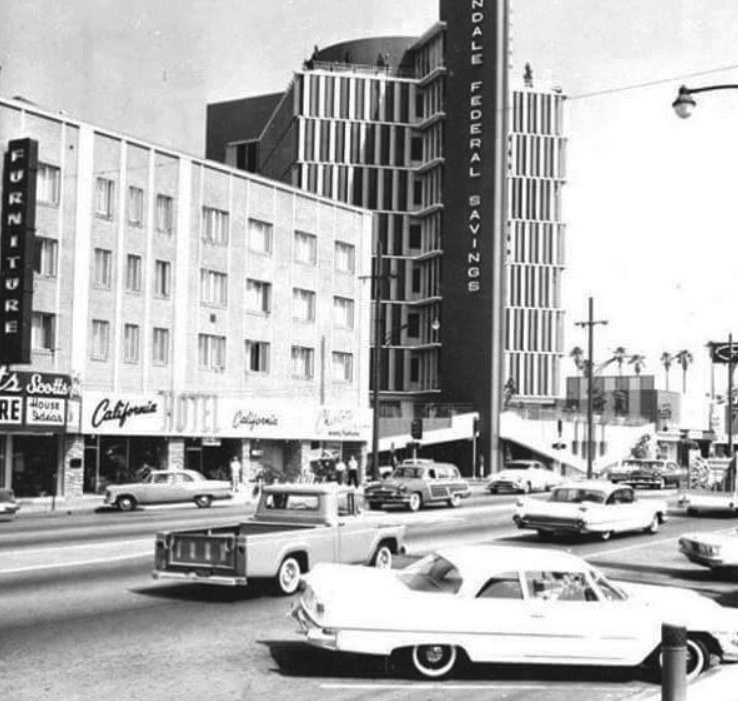 |
|
| (ca. 1959)^.^ – View looking northwest on Brand Boulevard toward Lexington Drive showing the newly built Glendale Federal Savings Building on the NW corner. Scott’s Furniture and the California Hotel can be seen at left. Photo courtesy of Alan Simon |
Historical Notes The Glendale Federal Savings Building was completed in 1959. Scott's Furniture (seen on the left) is in the space where the California Theatre was once located (1928-1957). |
Then and Now
 |
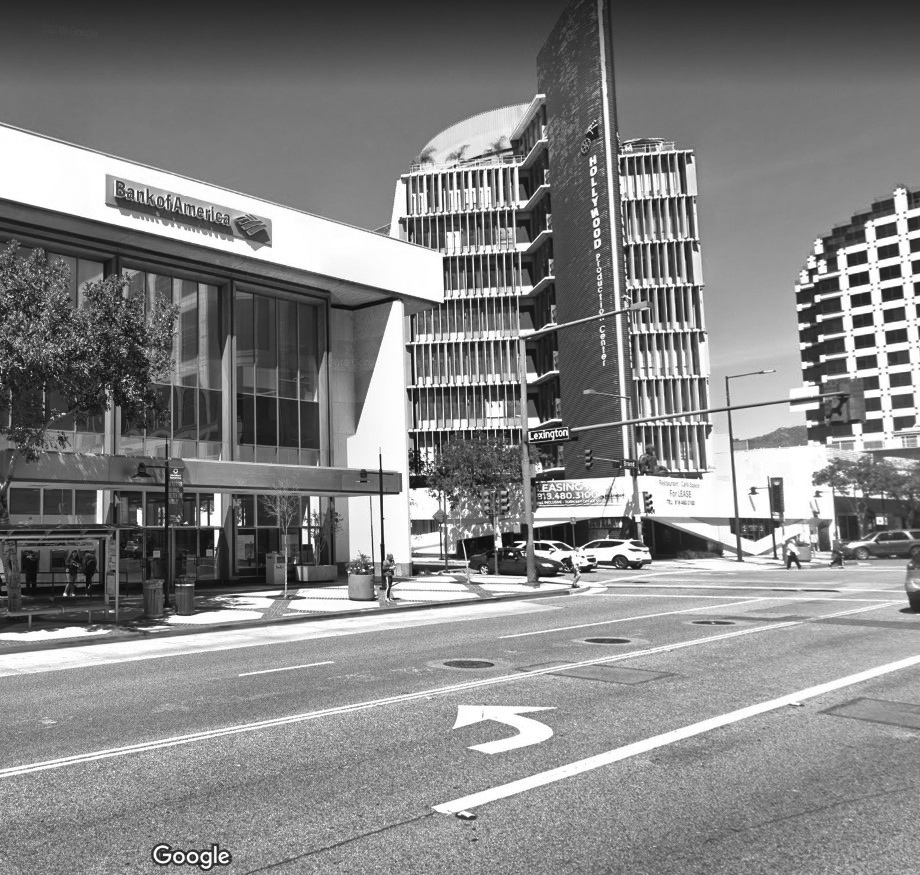 |
|
| (ca. 1959)^.^ | (2019)* |
Glendale Federal Savings Building
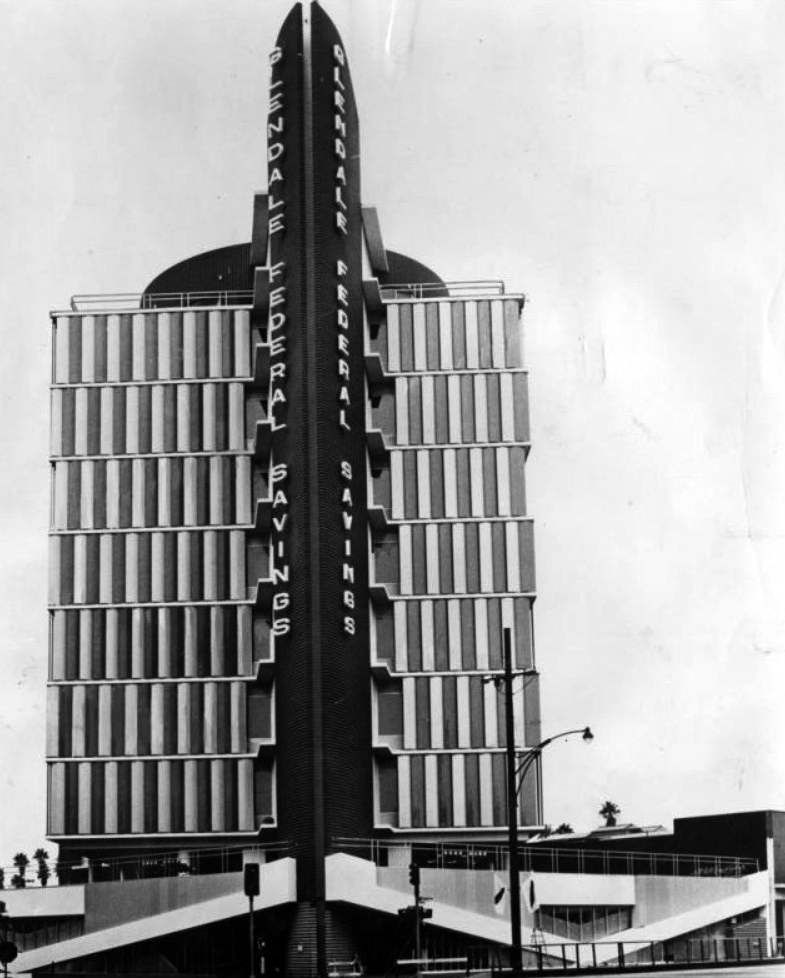 |
|
| (1959)^ - View showing the Glendale Federal Building shortly after it opened, located on the NW corner of Brand and Lexington. Valley Times Collection |
Historical Notes As head designer for the Bank Building and Equipment Corporation of America, Peruvian-born architect W. A. Sarmiento designed hundreds of Modern-style bank buildings all over the country. One of the most renowned and best-loved is right here, in Glendale: the Glendale Federal Savings and Loan Building on Brand Boulevard. Glendale Federal founder and president J. E. Hoeft wanted an ambitious design for his bank’s new headquarters, something not only representative of West Coast Modernism, but of his burgeoning hometown. He offered a prime site at the corner of Lexington and Brand, and Sarmiento delivered a dynamic design that would prove to be an icon of Southern California Modernism. Completed in 1959, the Glendale Federal Savings Building features a vertical, dramatically angled red stair/elevator tower fronting the main volume, which is a rectangular ten story high-rise.* |
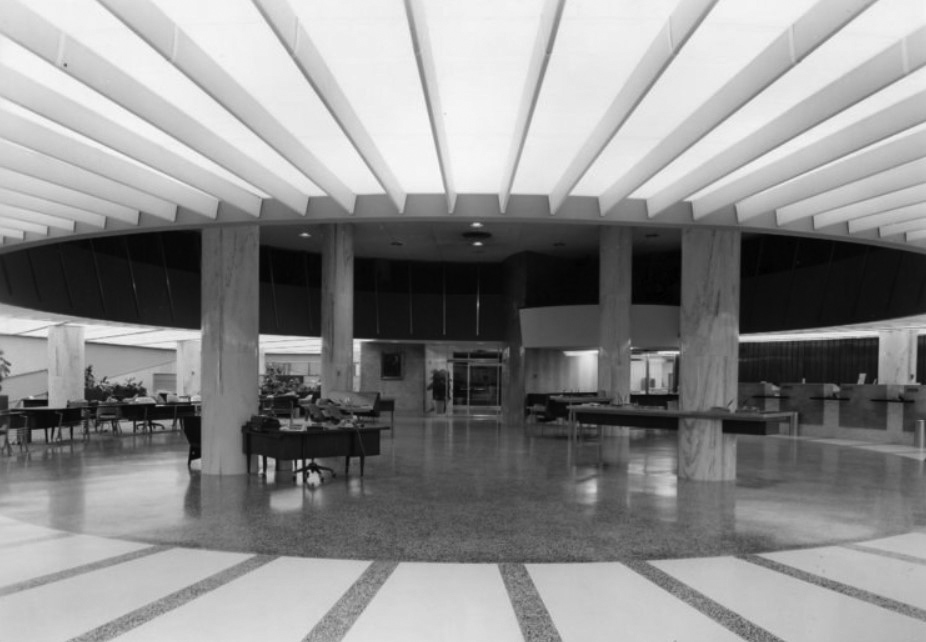 |
|
| (ca. 1960)^.^ - Interior view of the space-age Glendale Federal Savings. |
Historical Notes The tower is actually lifted above the building’s first floor, allowing the mezzanine level to be lit with natural sunlight.* |
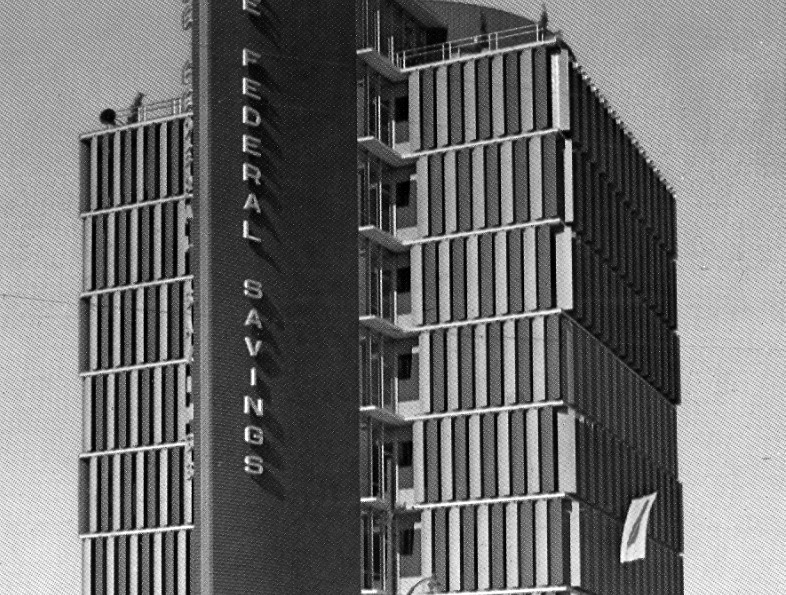 |
|
| (ca. 1960)** – Close-up view of the Glendale Federal Savings Building, 401 N. Brand Boulevard. Photo courtesy of the James Marston Fitch Charitable Foundation |
Historical Notes Architect Maxwell A. Starkman produced a design for an addition in 1962 that doubled the size of the office building and harmonized with Sarmiento's original design. On the building’s fire brick red corner tower, a vertical sign proudly displayed its name for all to see as this was the city’s tallest building for many years. The corner tower functions as fire escape and elevator tower. The main cube structure is framed by concrete and glass with windows framed in aluminum, forming a grid of blue and white colors during the day, and glowing light with the louvers open at night. |
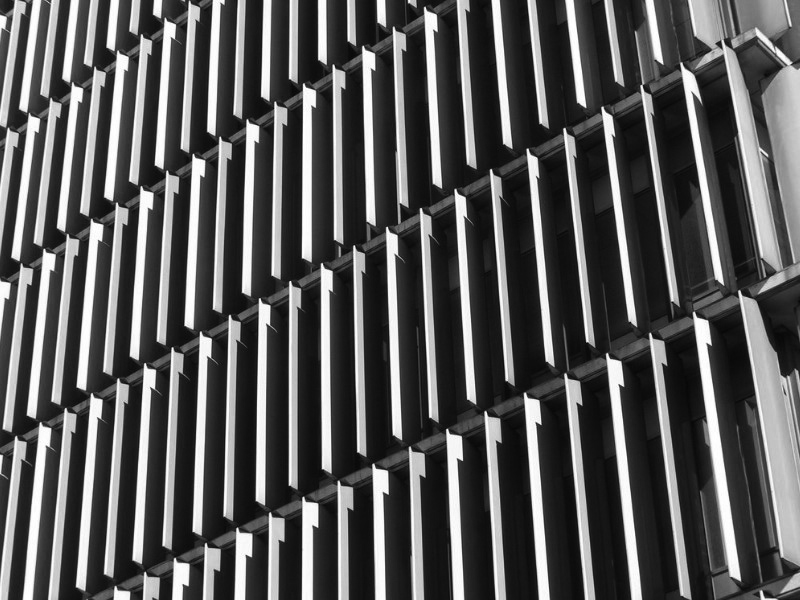 |
|
| (2009)** - Detail view showing the vertical louvers of the Glendale Federal Savings Building. Photo courtesy of the James Marston Fitch Charitable Foundation |
Historical Notes The building’s many windows are shaded by distinctive blue enameled steel louvers which use solar power to pivot throughout the day. |
 |
|
| (2019)^.^ – View showing the Glendale Federal Savings Building (now Hollywood Production Center) located at 401 N. Brand Blvd. Note how the building is set at a 45 degree angle to the city grid. |
Historical Notes Set at a 45 degree angle to the city grid, Hoeft gave Sarmiento the perfect site to create a bold architectural statement that for decades has been known as the “tower” of Glendale, featured on postcards, and described by Los Angeles architectural historian Robert Winter as “pure 1950s razzle dazzle.” ** |
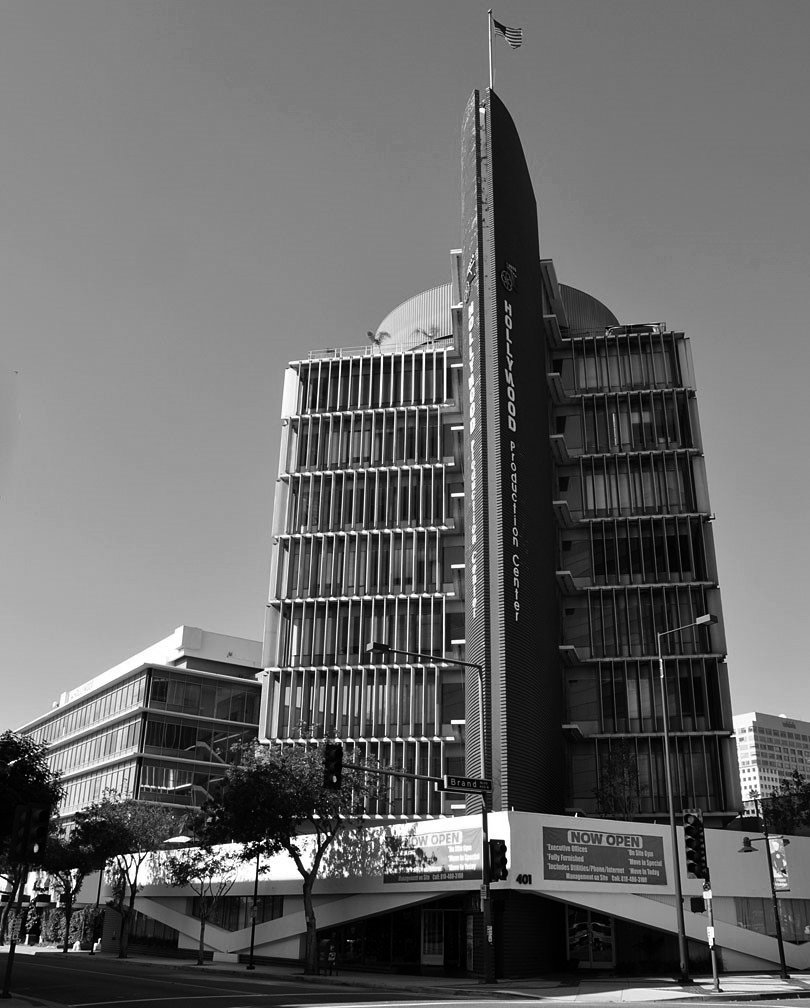 |
|
| (2019)^^ - Close-up view of the Glendale Federal Building on the NW corner of Brand and Lexington. The building now houses the Hollywood Production Center. Photo courtesy of Roadside Arcthitecture |
Historical Notes Glendale Federal Savings and Loan was bought out by Cal Fed in 1998 and the company moved its headquarters up the street. The building was subsequently sold to Nicholson Vertex Partners, who indicated their intent to remodel the building and to remove its character defining architectural features. In late 2000, the Glendale Historical Society, Los Angeles Conservancy, and concerned preservationists united to wage a preservation campaign that resulted in the building’s listing on the California survey of historic landmarks. With that listing, any permit to remodel required an environmental impact analysis. ** |
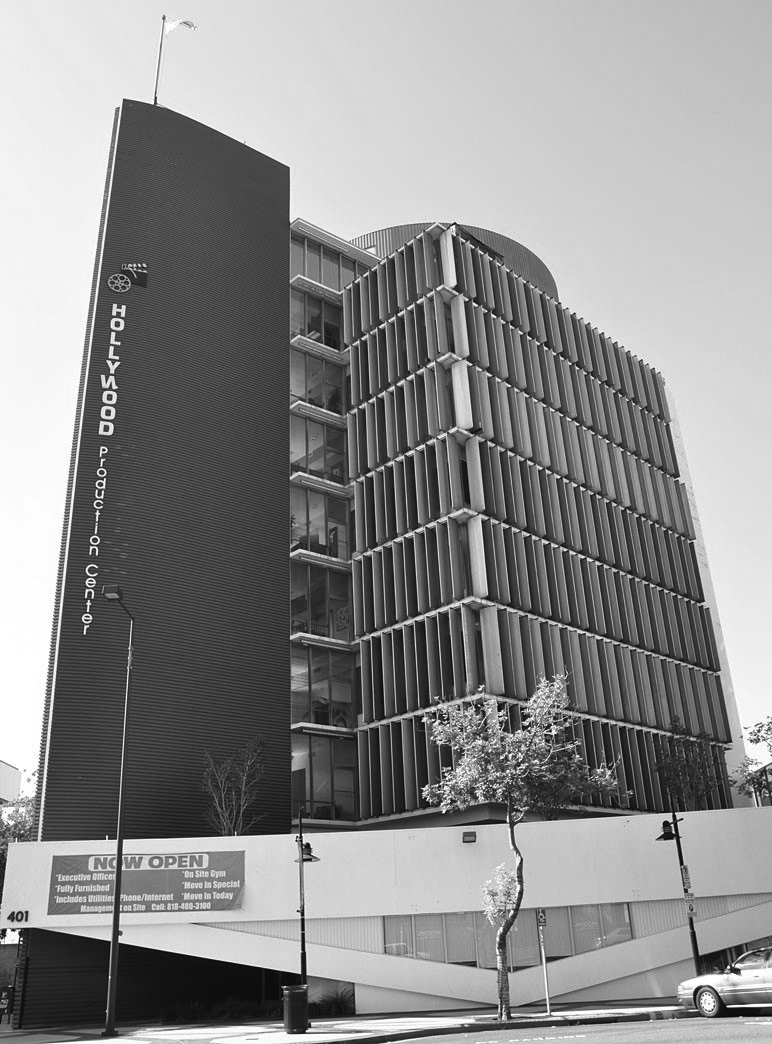 |
|
| (2019)^^ – View looking west at the Glendale Federal Savings Building, 401 N. Brand Boulevard. Photo courtesy of Roadside Arcthitecture |
Historical Notes Largely retaining its architectural integrity, Glendale Federal Savings is the embodiment of distinguished mid-century modern architecture with enduring significance by retaining its central form and character. Viewed from any elevation, Glendale Federal Savings became the symbol of the new downtown through its design, color, size, and dynamic presence, which is unlike any other architecture in the region.** The building now houses the Hollywood Production Center. |
Glendale Police Headquarters
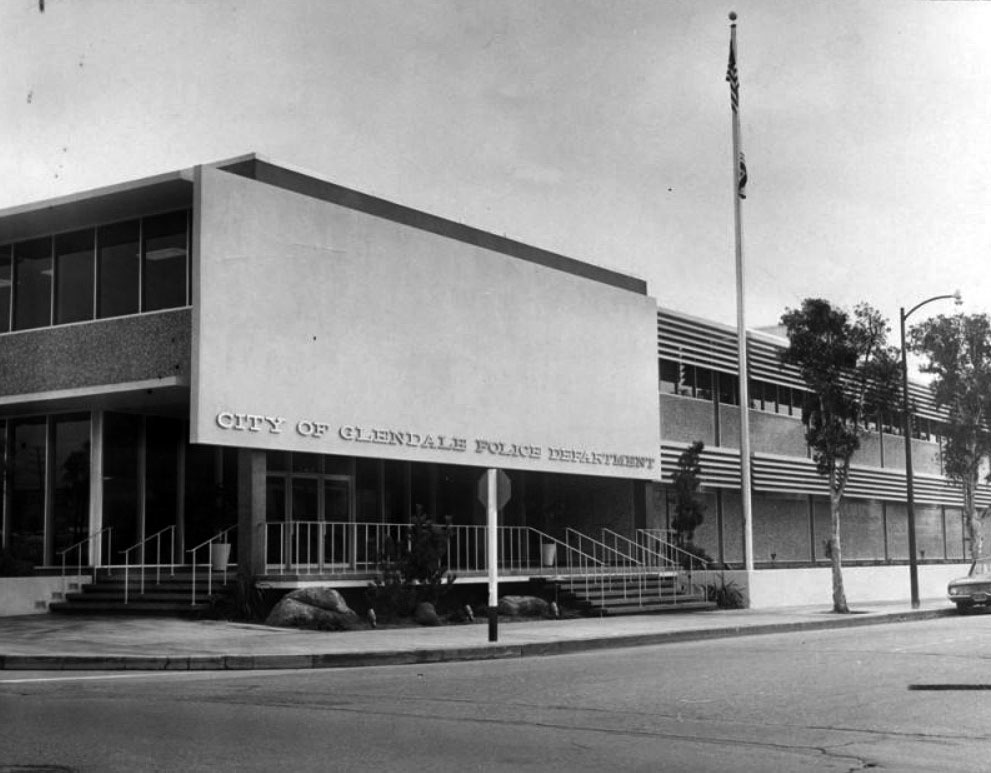 |
|
| (1960)^ - Photograph caption reads, "Spanking new headquarters for Glendale Police Force is 1,000,000, two-story building at Wilson Avenue and Isabel Street. Glendale's 160-man force will now be under one roof in new building. Formerly, part of police department was in old police building at 111 N. Howard St. and part in utility building." Valley Times photo date: November 8, 1960. Click HERE for contemporary view. |
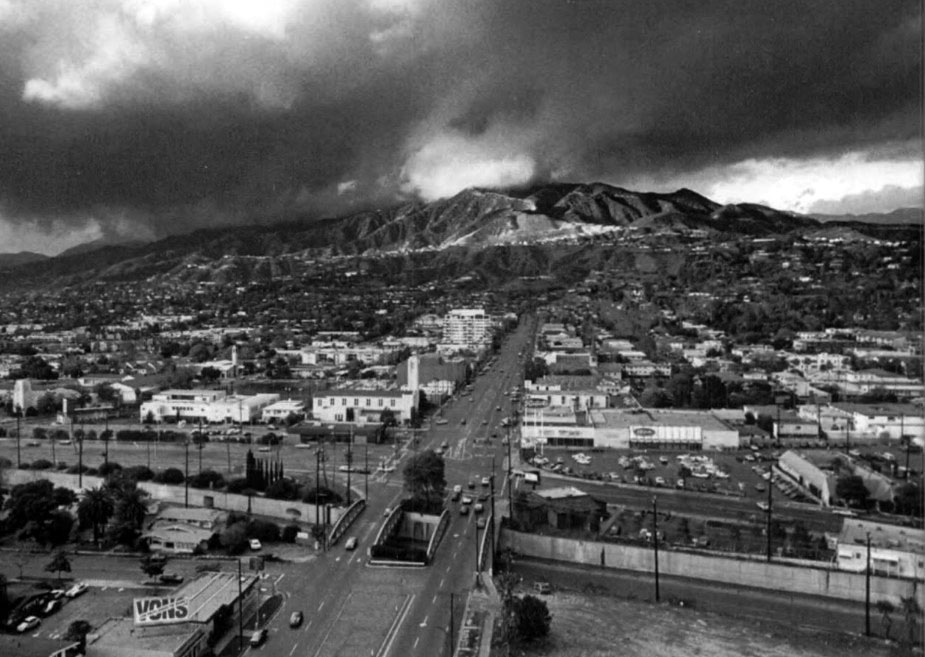 |
|
| (1982)*^* – View showing north Brand Boulevard at the Verdugo wash with the Incarnation Church at left and the Ralph’s grocery store at right. |
* * * * * |
Glendale Fashion Center
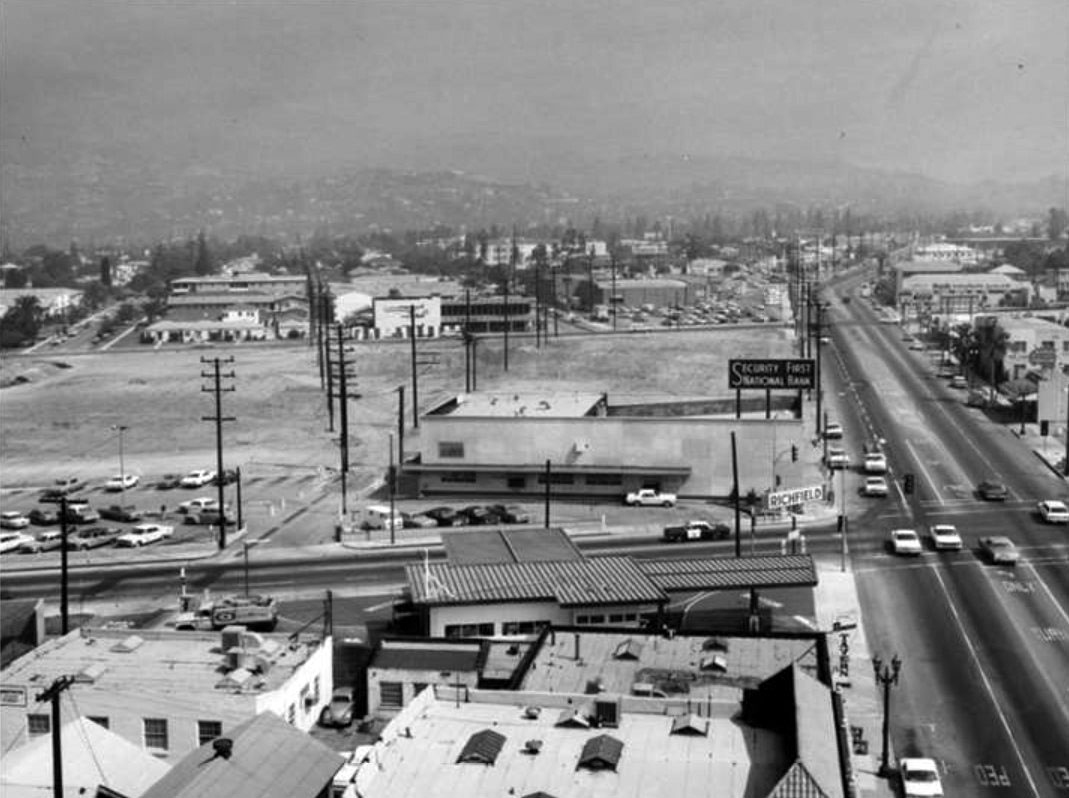 |
|
| (1966)##^ – View showing the intersection of Glendale and Wilson avenues, with Secutiry First National Bank and Richfield gas station on the NW and SW corners, respectively. This land was cleared for the Glendale Fashion Center. Click HERE for contemporary view. |
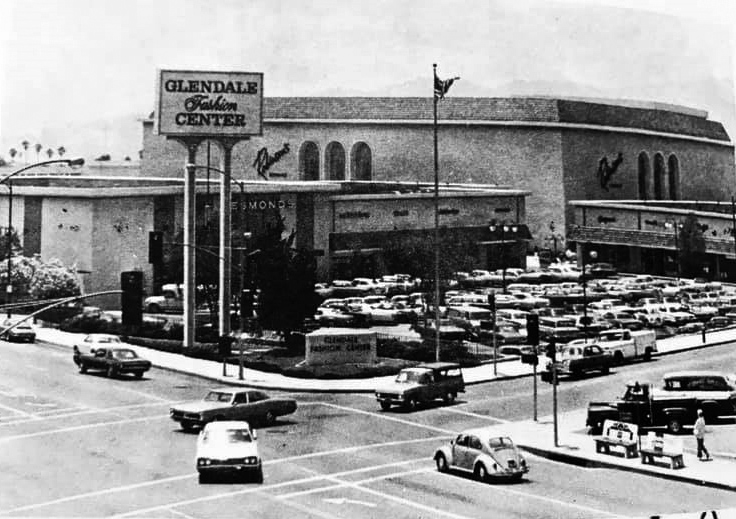 |
|
| (1974)^.^ - View looking SW showing the Glendale Fashion Center at Glendale Ave and California St. The anchor store was Robinson's, seen in the background. Desmond’s is at center-left. Photo courtesy of Art Jacobs |
Historical Notes Today Glendale Fashion Center is anchored by Ross, TJ Maxx, Nordstrom Rack, Staples, and Petco. Click HERE for contemporary view. |
Glendale Galleria
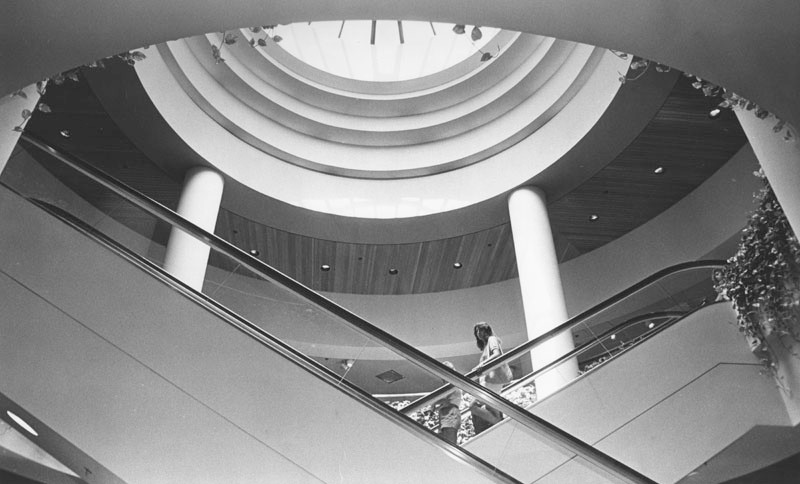 |
|
| (1984)^ - Photograph caption dated August 12, 1984 reads, "A skylight and plants brighten the Nordstrom store at Glendale Galleria shopping mall." Photo by Lisa Hatalsky |
Historical Notes Developed by Glendale Associates, a partnership between J.S. Griffiths Co, Broadway Hale Stores and M.J. Brock & Sons, the Glendale Galleria opened on October 14, 1976. The architect was Jon Jerde, who credited his design to a Ray Bradbury essay on reviving retail districts. The mall began with four anchor stores: Buffum's and The Broadway, which opened in August 1976; Ohrbach's, which opened in October, 1976; and JCPenney, which opened in November of that year. The Galleria's first expansion, Galleria II, was completed in 1983. It expanded a wing of the mall and added another anchor store, Nordstrom. The first Panda Express restaurant opened in Galleria II in the same year, on level 3 near Bloomingdale's.*^ |
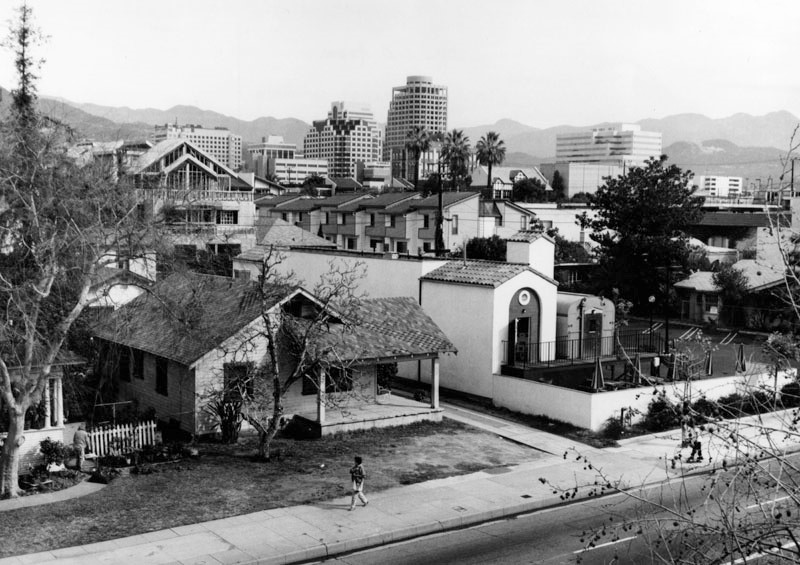 |
|
| (1990)^ - Panoramic view of Glendale, looking northeast from the Glendale Galleria parking structure. Photo by William Reagh |
* * * * * |
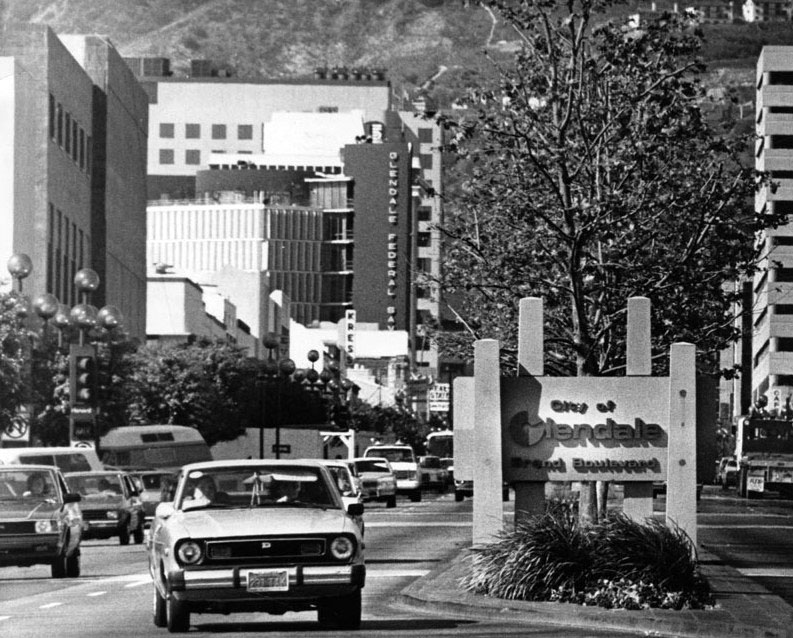 |
|
| (1980s)*# - Sign reads: City of Glendale - Brand Boulevard. Photo Credit: City of Glendale |
Then and Now
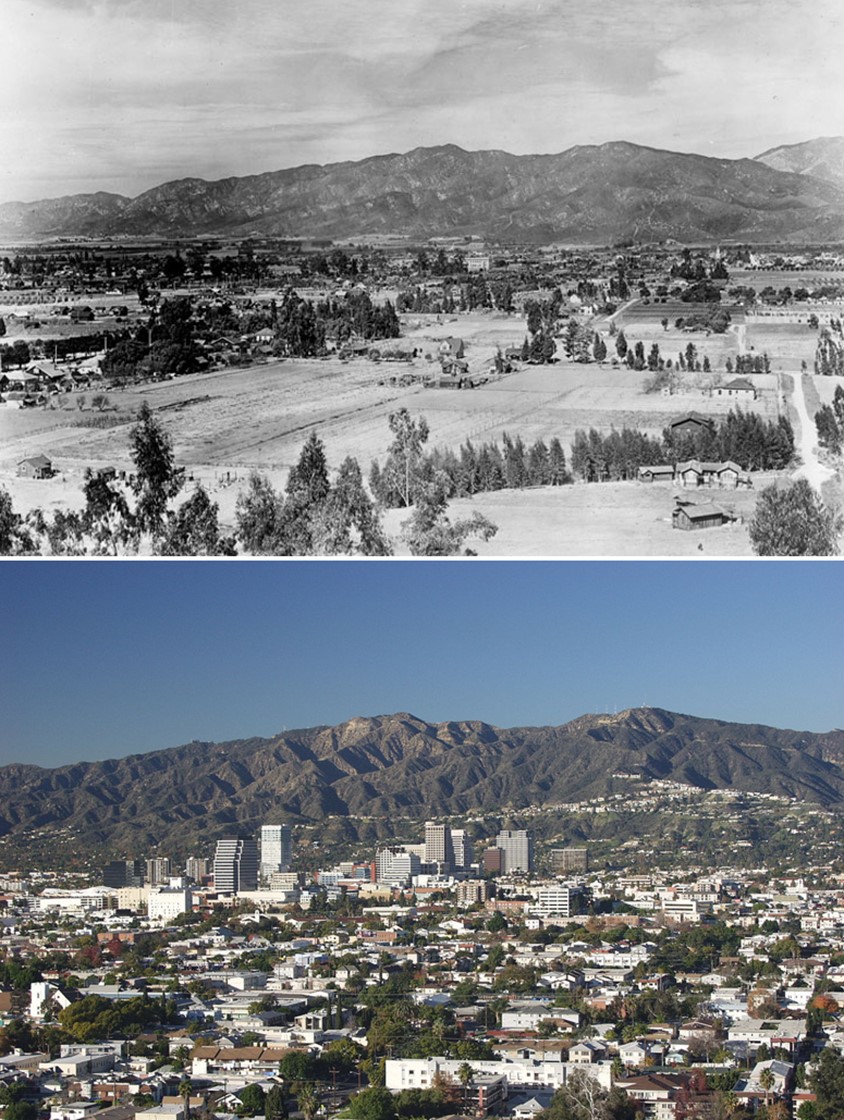 |
|
| (1910 vs 2009)* - Then and Now - Glendale as seen from current location of Forest Lawn Memorial Park. Contemporary photo by Gary B. Edstrom / Wikipedia |
Historical Notes When incorporated in 1906, Glendale consisted of only 1,486 acres. By 1920, the City had grown through nine annexations to over 7,000 acres. From 1920 to 1930, ten annexations brought the total area to 12,294 acres. |
.jpg) |
|
| (2017)*# – Panoramic view of the City of Glendale as seen from the Verdugo Moutains. Photo courtesy of the City of Glendale |
Historical Notes As of 2014, Glendale had a population was 200,167, making it the third largest city in Los Angeles County and the 23rd-largest city in California. Glendale has one of the largest communities of Armenian descent in the United States. In 2013, Glendale was named LA's Neighborhood of the Year by the readers and editors of Curbed.com. Forest Lawn Memorial Park Cemetery contains the remains of many noted celebrities and local residents. Grand Central Airport was the departure point for the first commercial west-to-east transcontinental flight flown by Charles Lindbergh.*^ |
* * * * * |
Please Support Our CauseWater and Power Associates, Inc. is a non-profit, public service organization dedicated to preserving historical records and photos. Your generosity allows us to continue to disseminate knowledge of the rich and diverse multicultural history of the greater Los Angeles area; to serve as a resource of historical information; and to assist in the preservation of the city's historic records.
|
More Historical Early Views
Newest Additions
Early LA Buildings and City Views
History of Water and Electricity in Los Angeles
* * * * * |
References anc Credits
* DWP - LA Public Library Image Archive
^ LA Public Library Image Archive
*^ Wikipedia
^* Glendale High School Home Page
*# Abandoned & Little-Known Airfields – Paul Freeman
#* Flickr.com: Glendale Public Library
#^ Pacific Electric Railway Historical Society
#+ Los Angeles River Flood of 1938
++ Early Glendale (Images of America)
#**Huntington Digital Library Archive
**^Facebook.com: Bob's Big Boy
*^^LA Times: Webb's Department Store
+++Facebook: Vintage Glendale "The Jewel City"
^*^Nuestra Señora la Reina de los Ángeles: losangelespast.com
^^*Cinema Treasures: Palace Grand Theatre
***PhantomLosAngeles.blogspot.com: Glendale Southern Pacific Railroad
^x*Facebook.com: So. Calif. Historic Arrchitecture
^*#California State Library Image Archive
^##Metropolitan Transportation Library and Archive
+##Airport Journals: Grand Central Aiport
#^*Flickr.com: Michael Ryerson
##^CSUN Oviatt Library Digital Archives
##*OAC - Online Archive of California
^##^Glendale Historical Society
#+#+Glendale News-Press: Tropic
#*#^Brand Park and Studios: glendale.ca.us
***^CSUN Oviatt Library Digital Archives
#+++Facebook.com: West San Fernando Valley Then And Now
##^*Facebook.com: Classic Hollywood-Los Angeles-SFV
< Back
Menu
- Home
- Mission
- Museum
- Major Efforts
- Recent Newsletters
- Historical Op Ed Pieces
- Board Officers and Directors
- Mulholland/McCarthy Service Awards
- Positions on Owens Valley and the City of Los Angeles Issues
- Legislative Positions on
Water Issues
- Legislative Positions on
Energy Issues
- Membership
- Contact Us
- Search Index